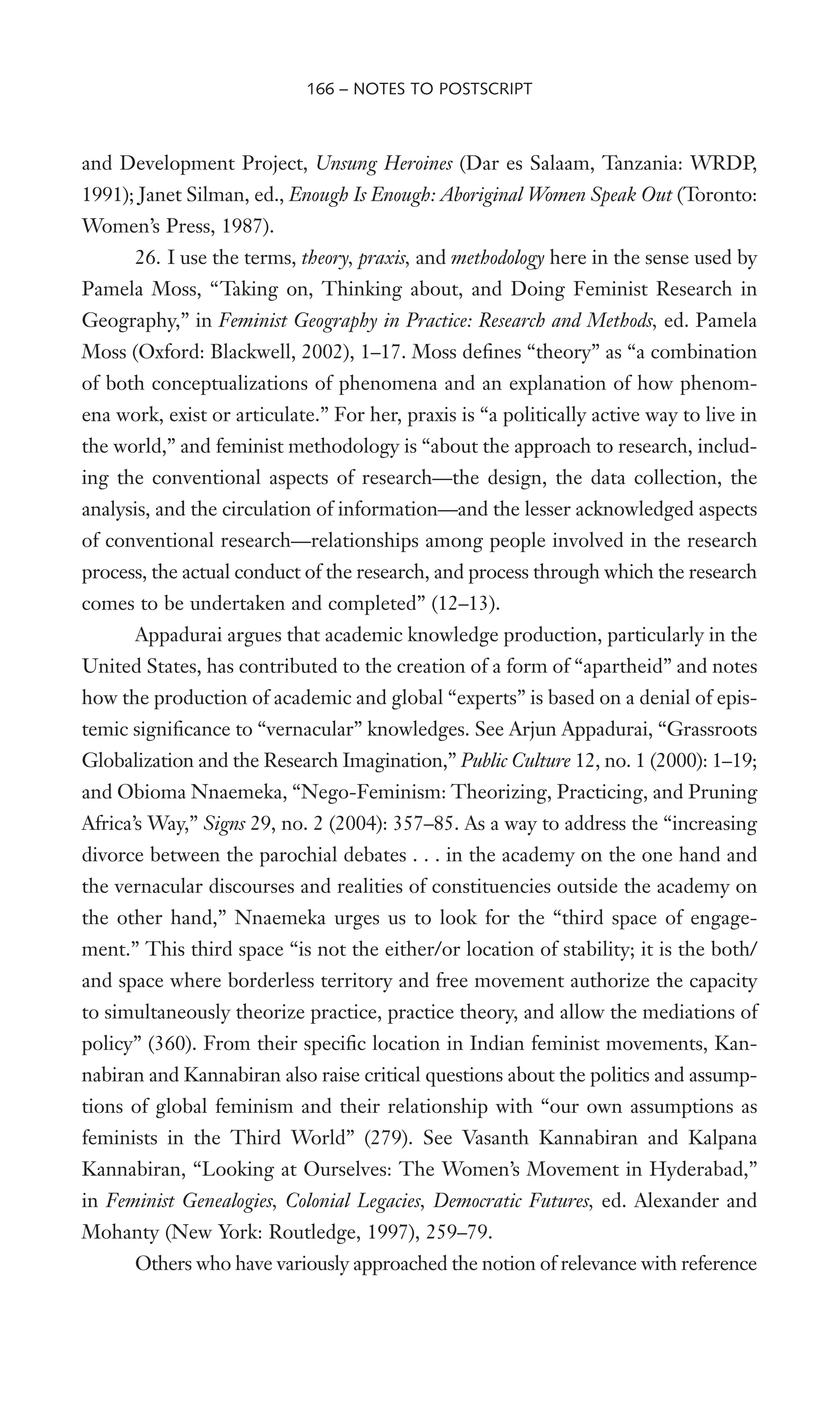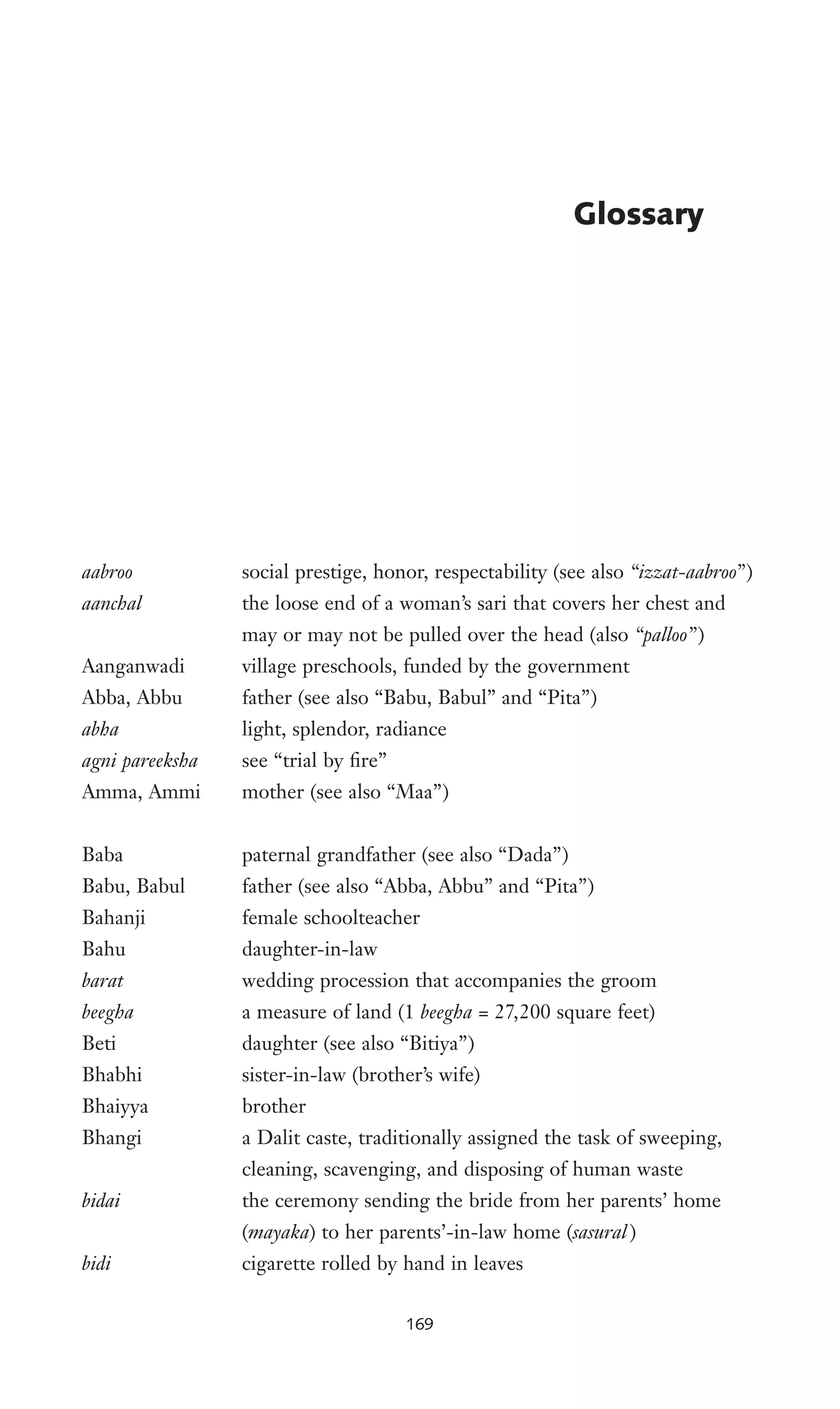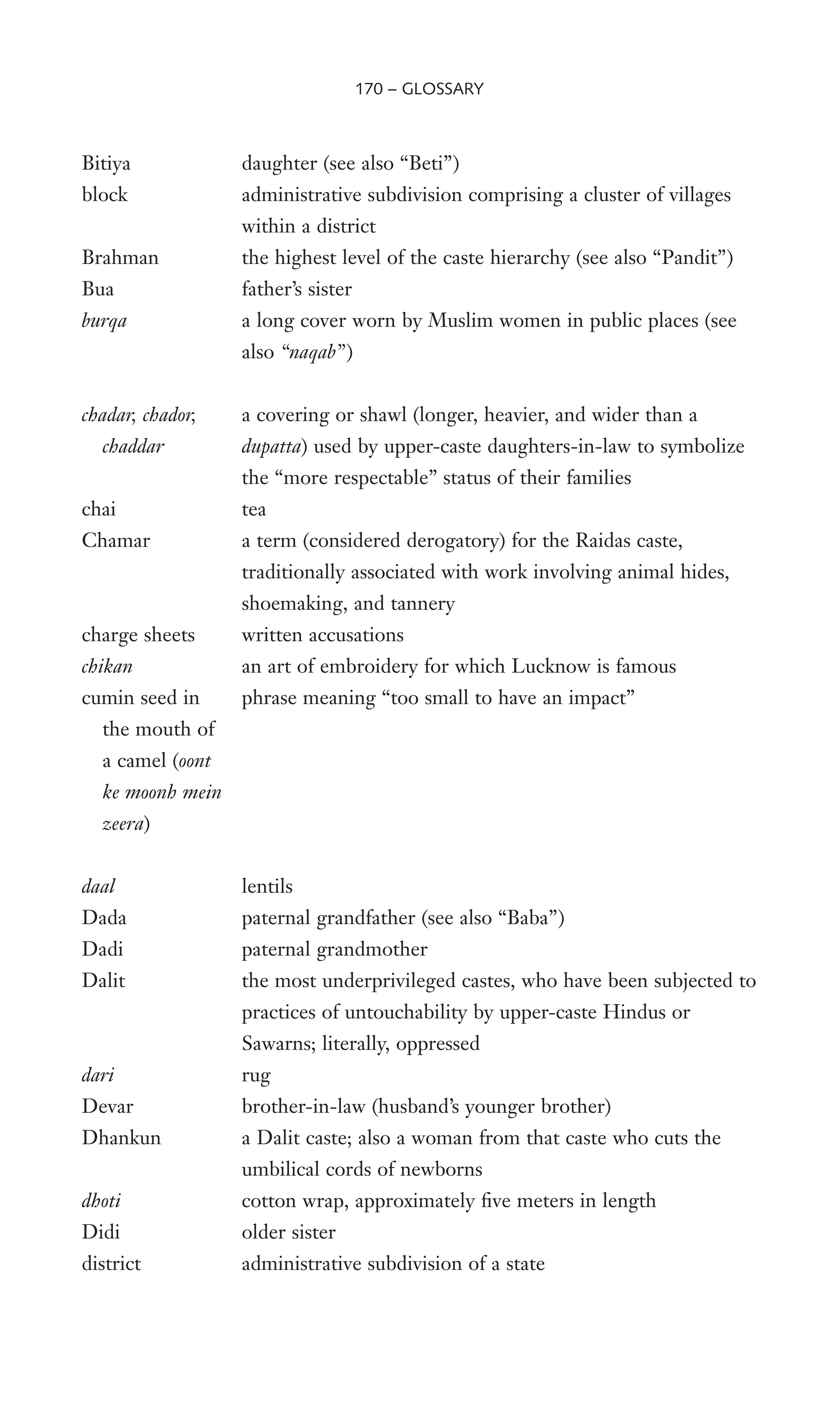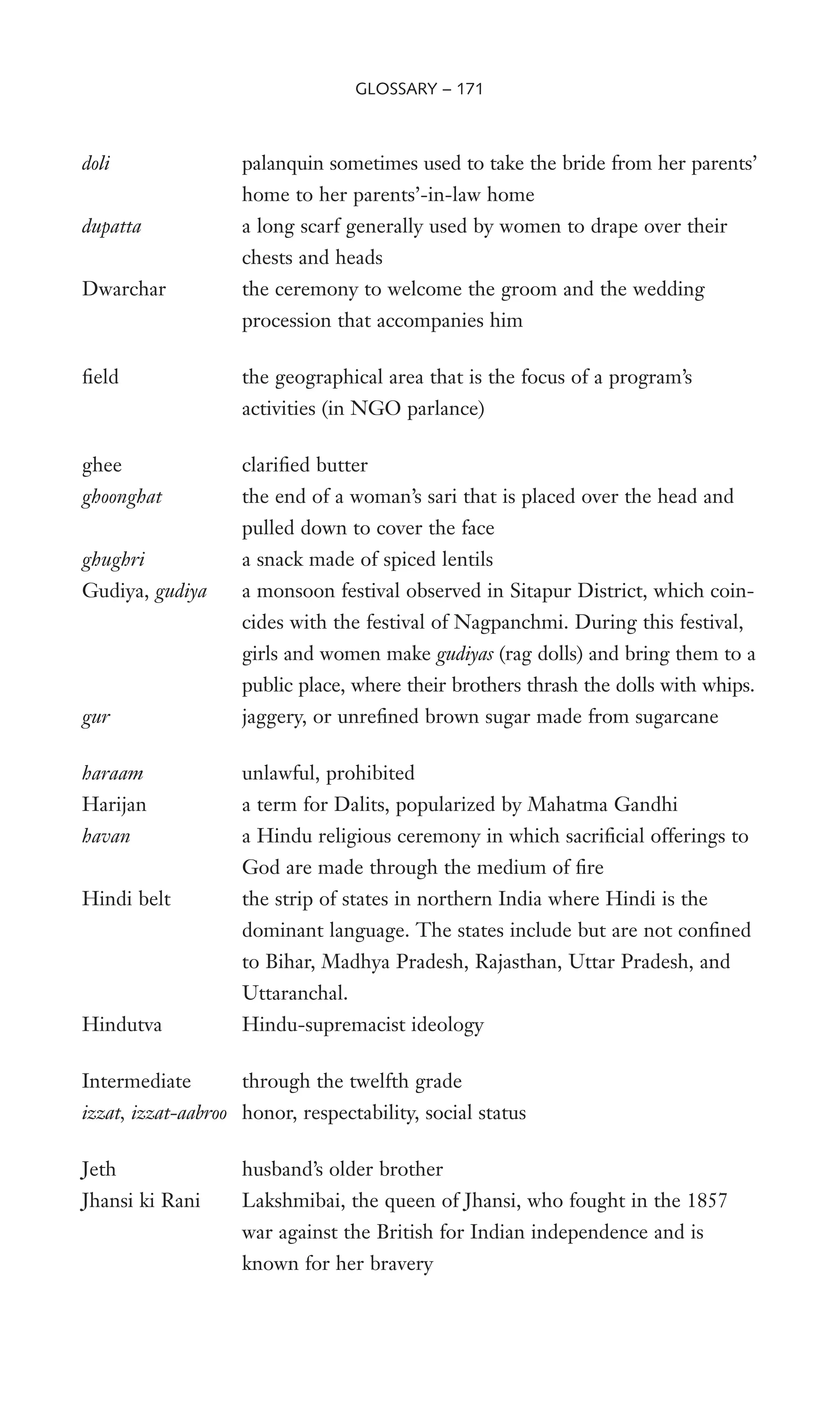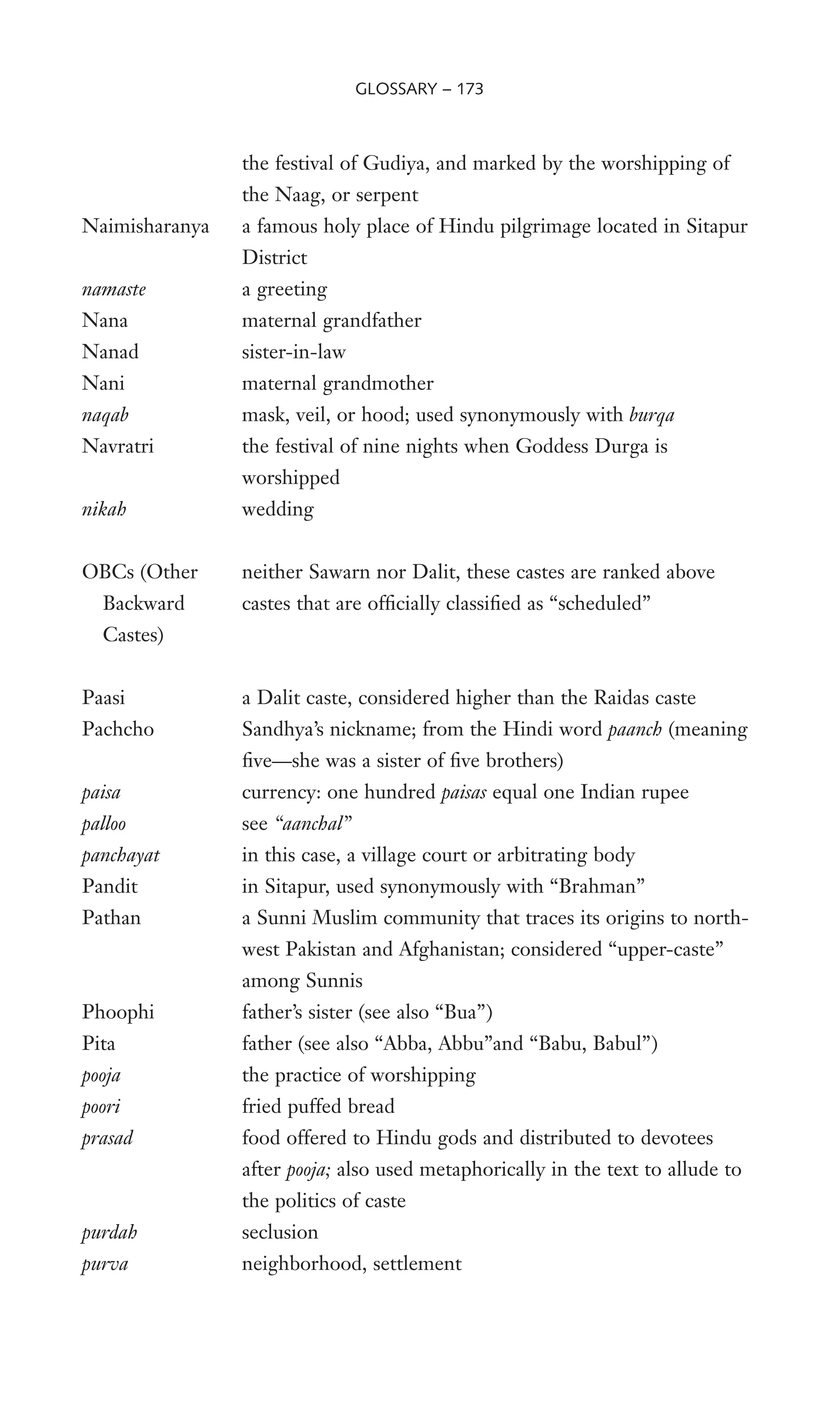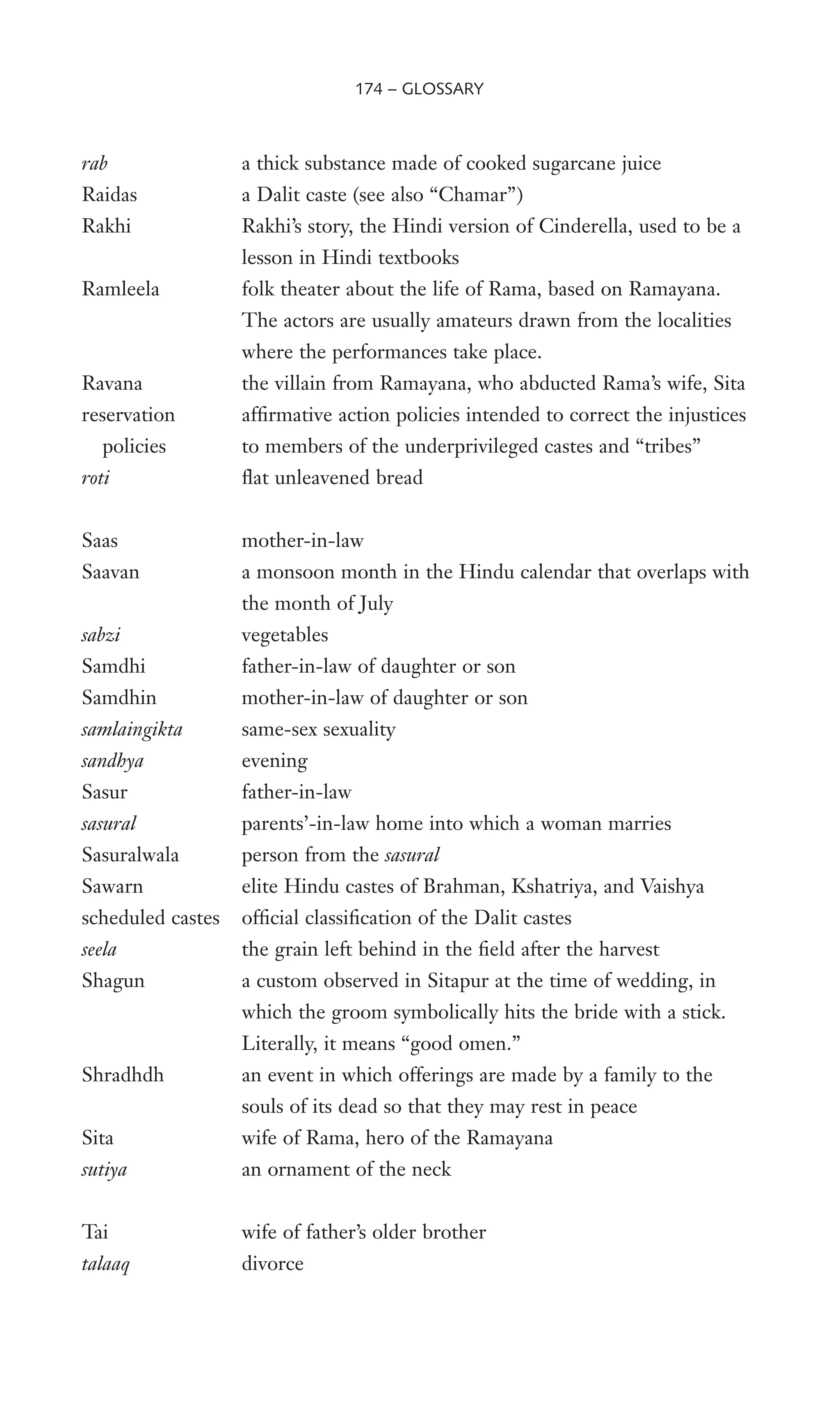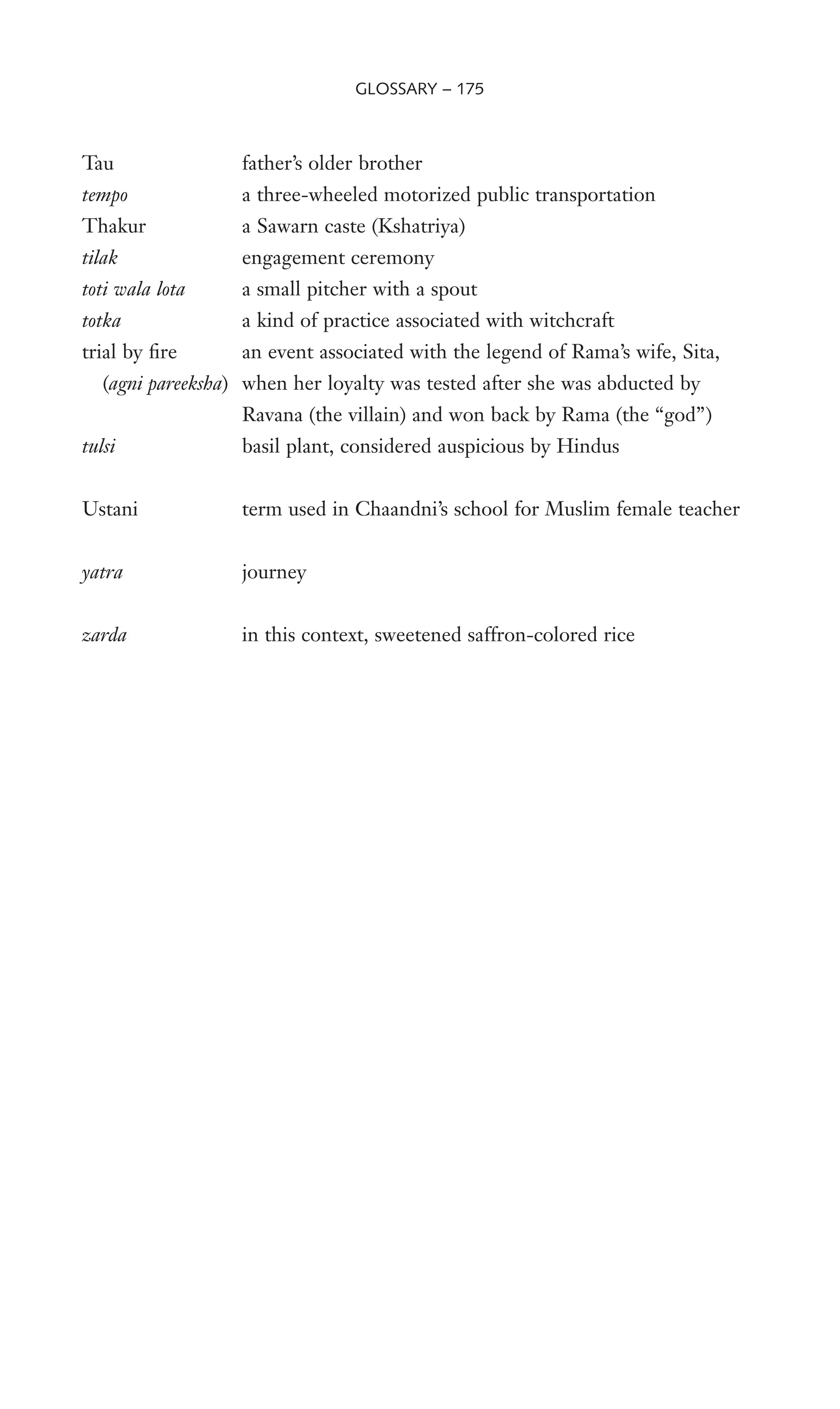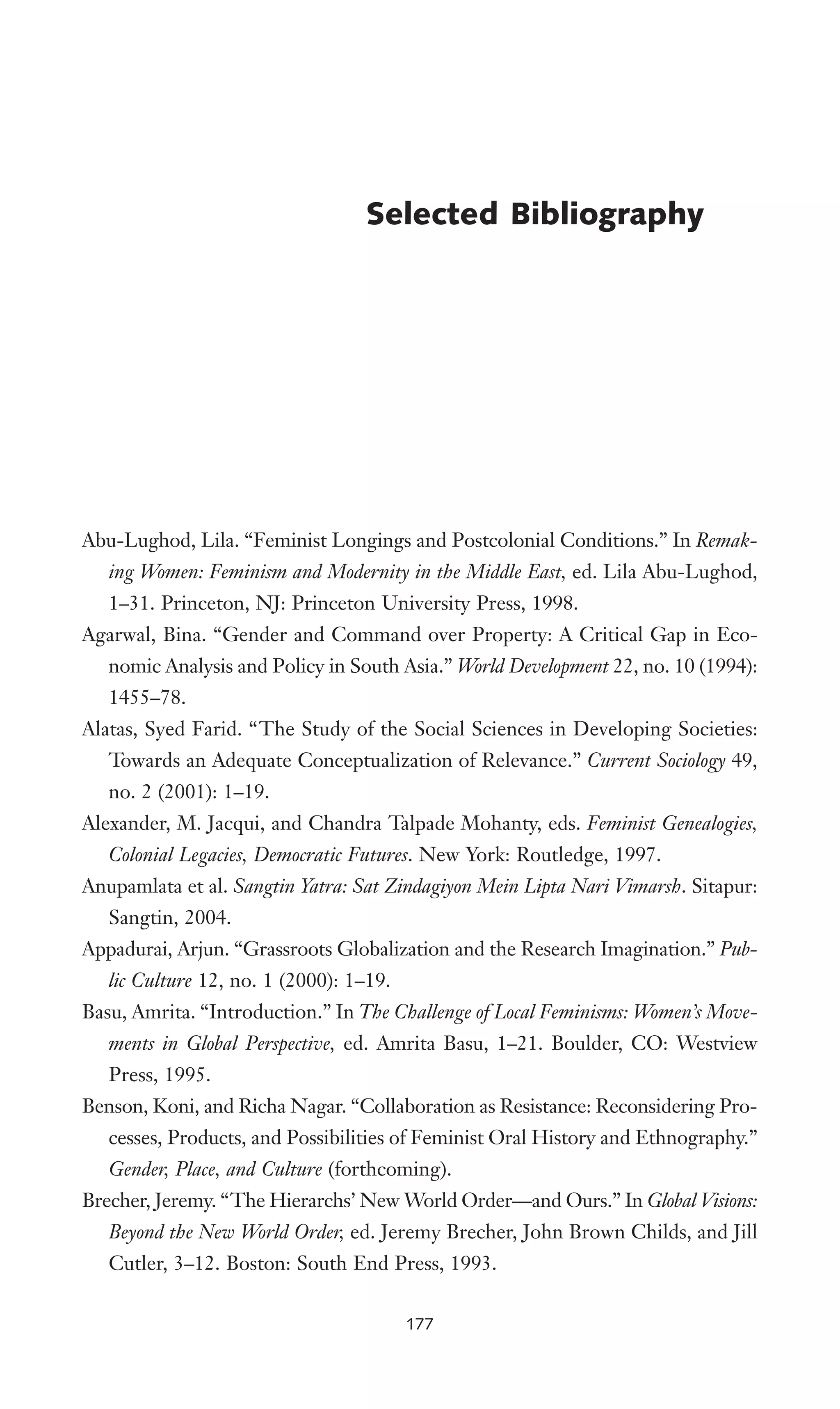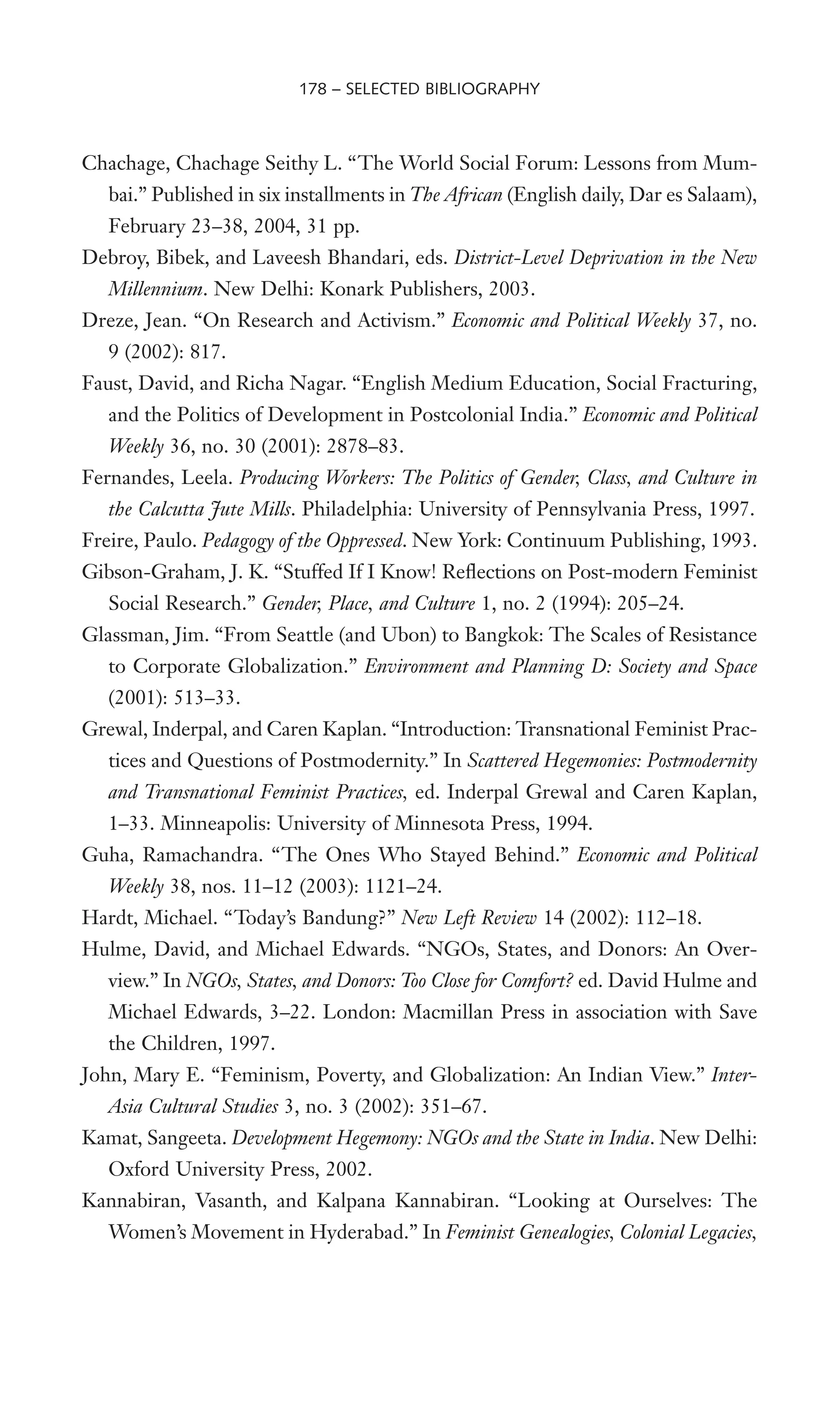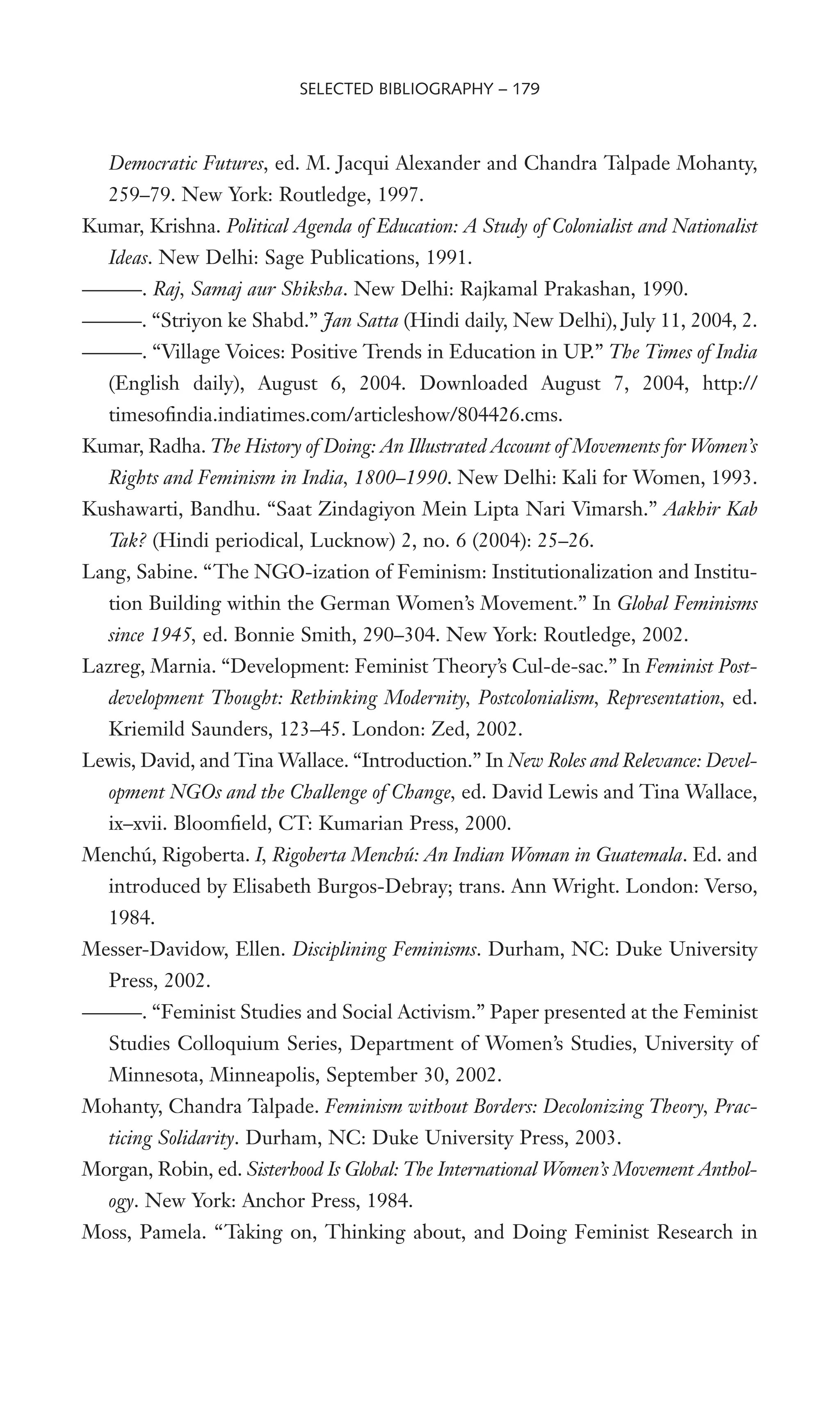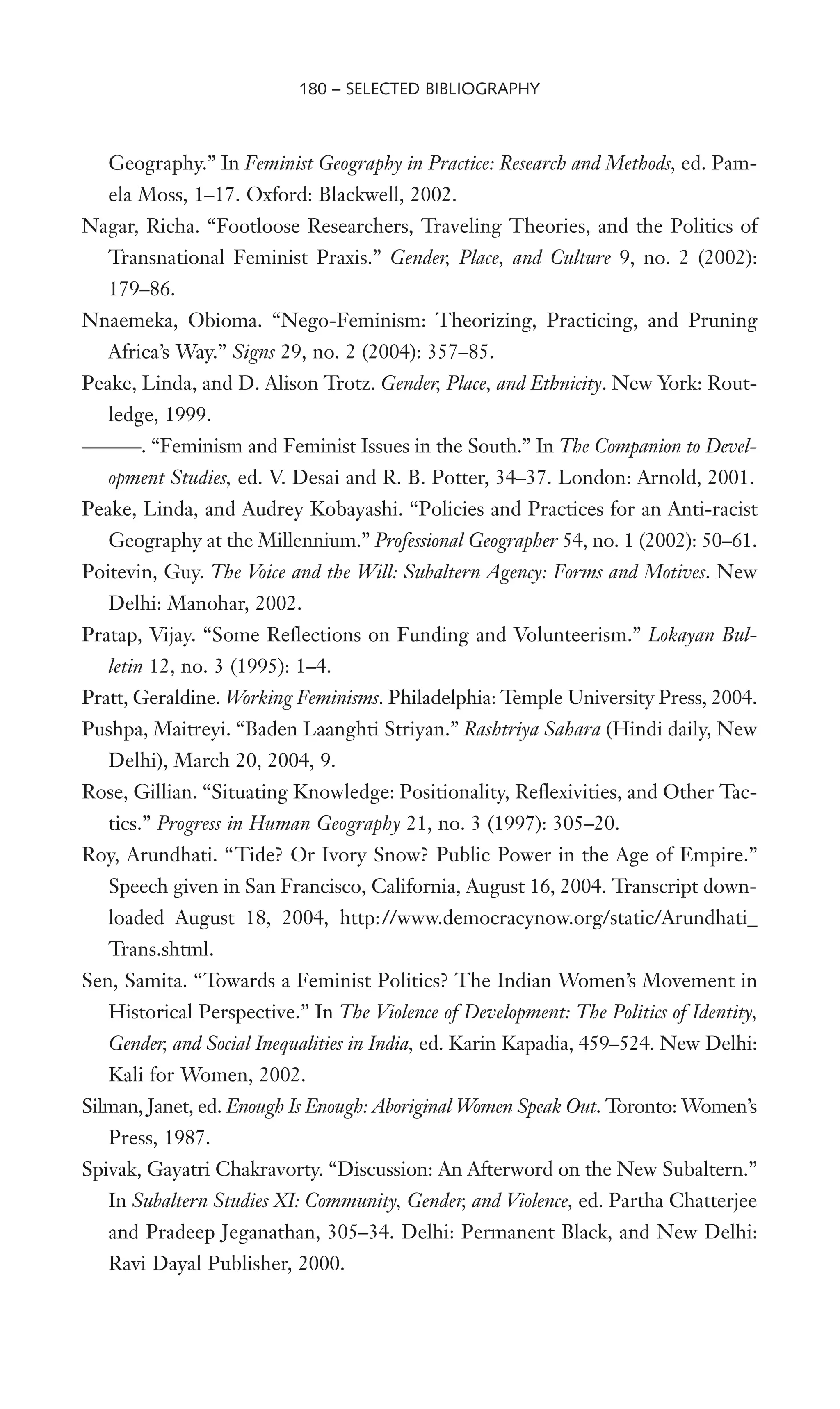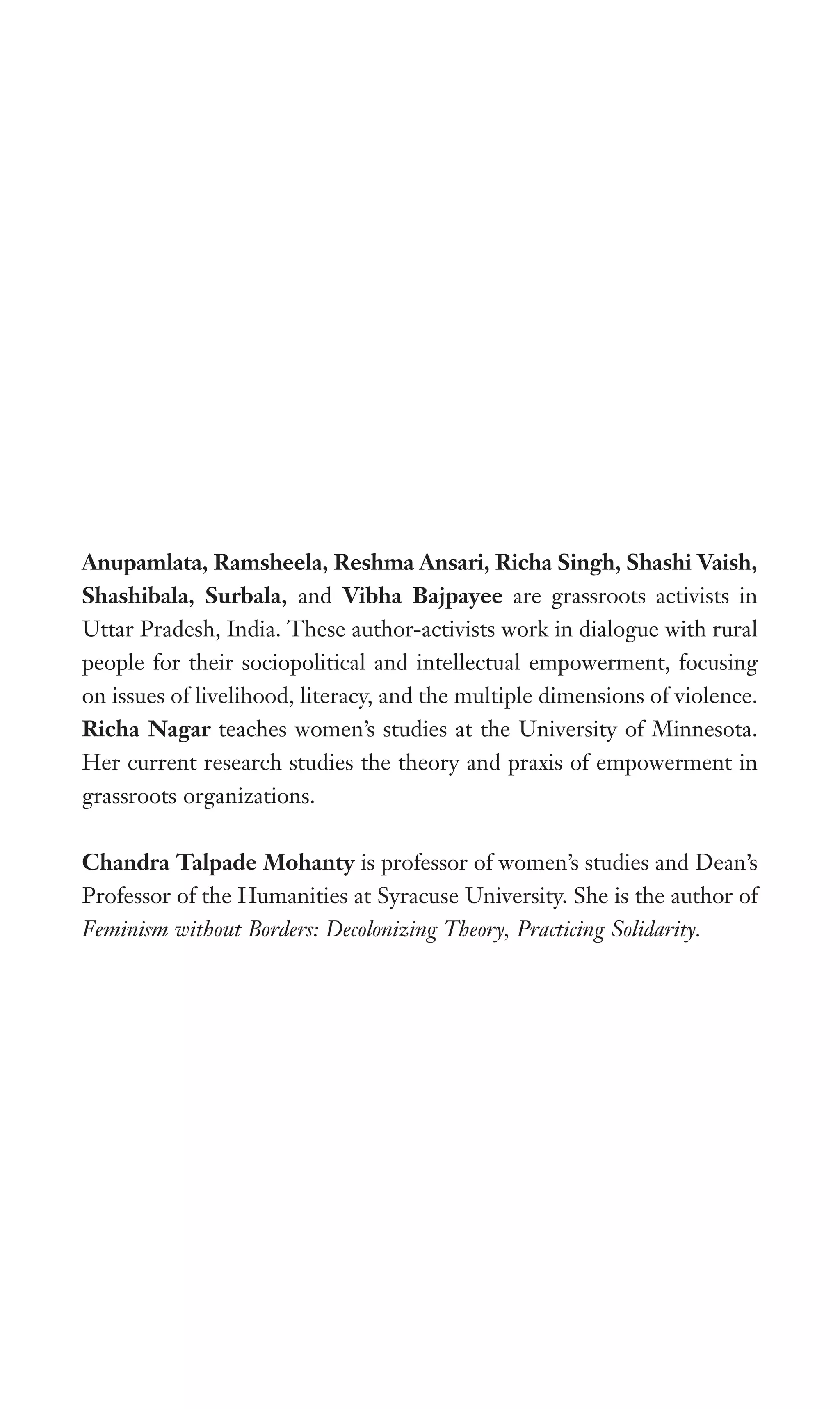This document is an introduction to the book "Playing with Fire: Feminist Thought and Activism through Seven Lives in India" by the Sangtin Writers Collective. It describes the Collective coming together through a shared journey of personal and political struggles to build solidarity across differences as rural women activists in Uttar Pradesh, India. The introduction notes their negotiation between donor-driven NGO politics and inherited inequalities, and their critique of the "NGOization" of women's empowerment. It also highlights the Collective's unique collaborative methodology of autobiographical writing and analysis to demystify power and build collective transformation and solidarity.
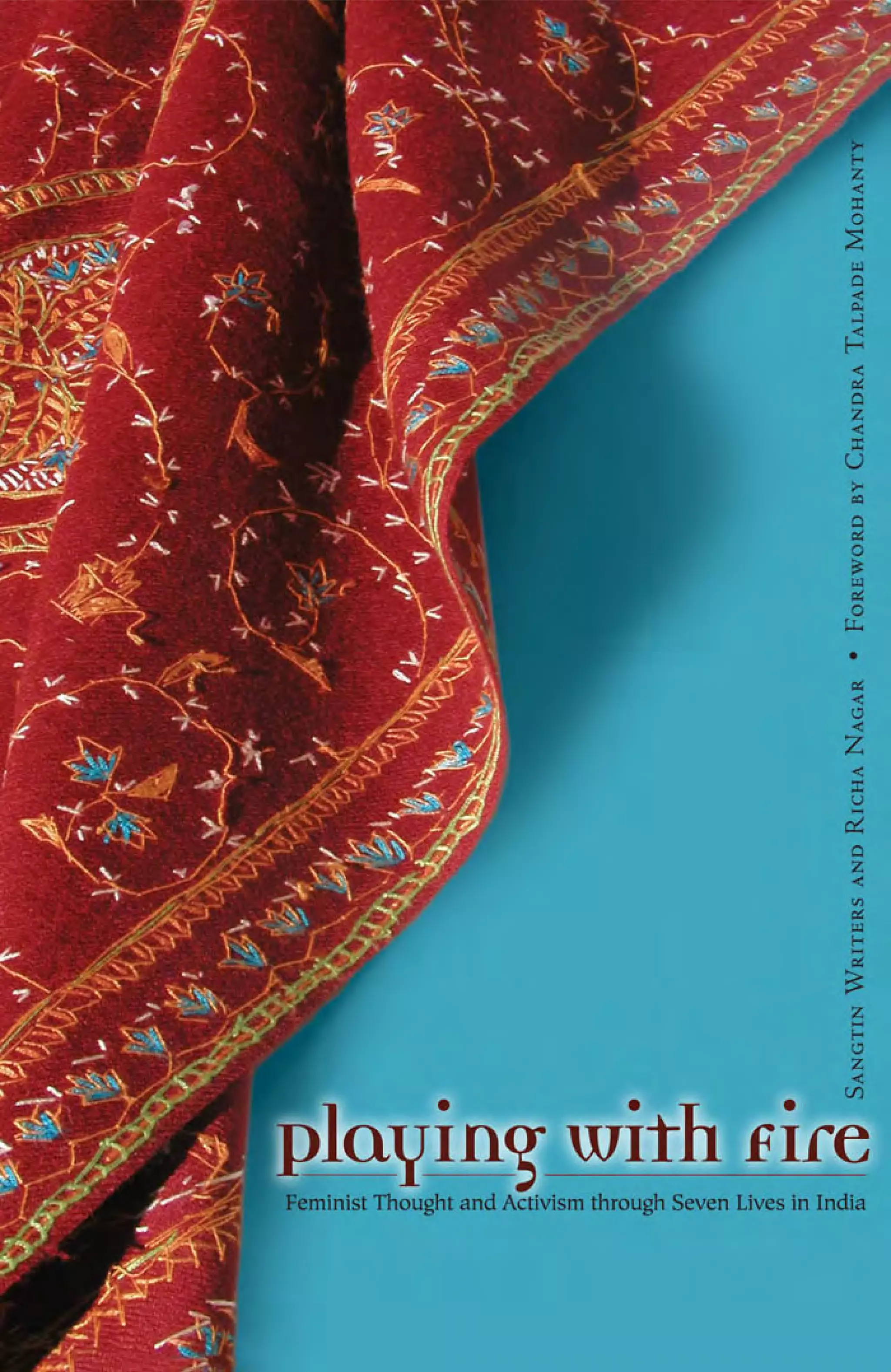


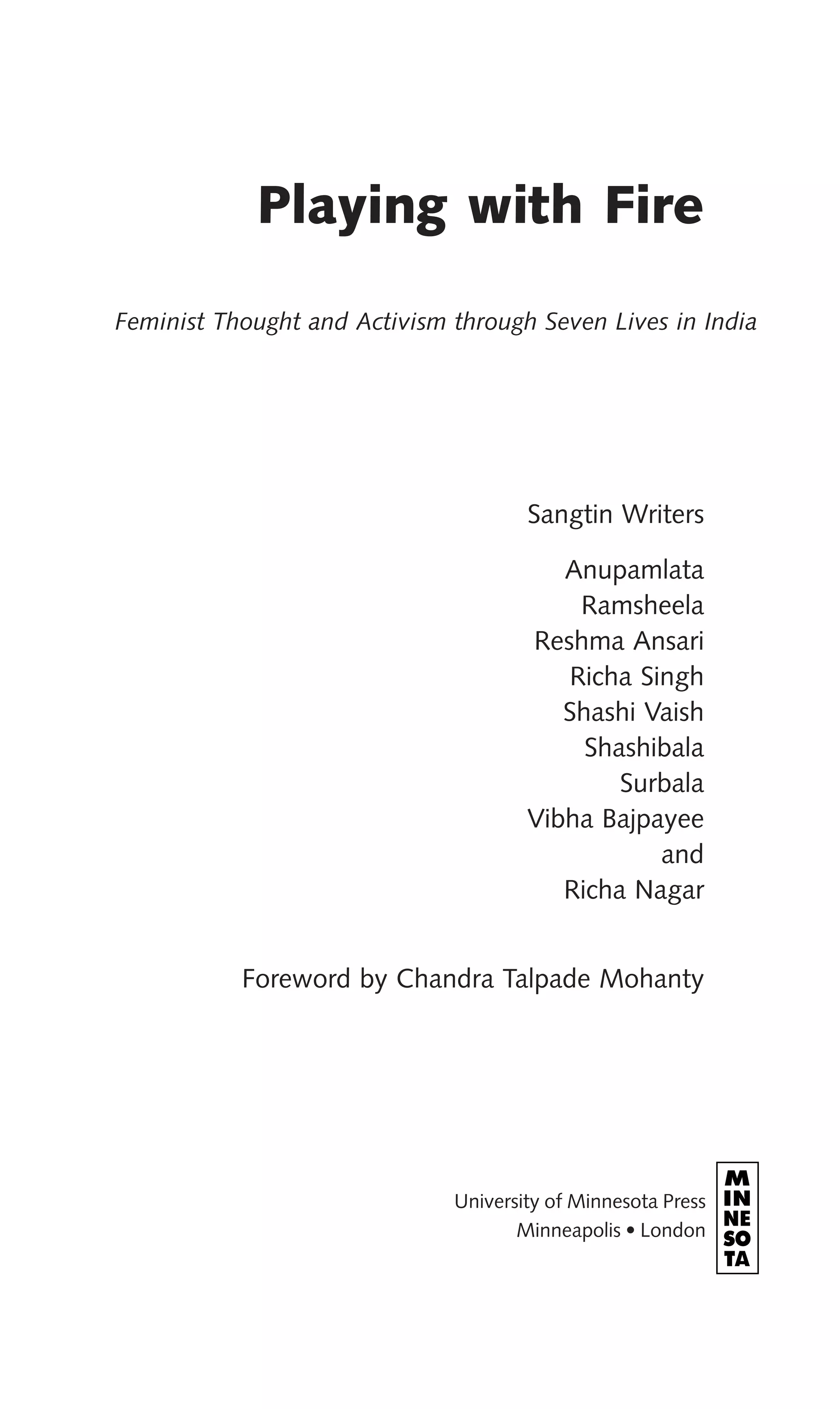
![The authors’ royalties from this book will be donated to the organization Sangtin. None of these will
be kept by any members of the Sangtin Collective.
Copyright 2006 by the Regents of the University of Minnesota
All rights reserved. No part of this publication may be reproduced, stored in a retrieval system,
or transmitted, in any form or by any means, electronic, mechanical, photocopying, recording, or
otherwise, without the prior written permission of the publisher.
Published by the University of Minnesota Press
111 Third Avenue South, Suite 290
Minneapolis, MN 55401-2520
http://www.upress.umn.edu
Library of Congress Cataloging-in-Publication Data
Sangtin Writers and Nagar, Richa.
Playing with fire : feminist thought and activism through seven lives in India / Sangtin Writers,
Anupamlata . . . [et al.] ; Richa Nagar ; foreword by Chandra Talpade Mohanty.
p. cm.
Includes bibliographical references.
ISBN-13: 978-0-8166-4769-9 (hc : alk. paper)
ISBN-10: 0-8166-4769-0 (hc : alk. paper)
ISBN-13: 978-0-8166-4770-5 (pb : alk. paper)
ISBN-10: 0-8166-4770-4 (pb : alk. paper)
1. Women’s rights—India—Uttar Pradesh. 2. Marginality, Social—India—Uttar Pradesh. 3. Sangtin
(Organization) I. Sangtin Collective, Sangtin Yatra (Organization) II. Title.
HQ1236.5.I4N34 2006
305.420954'2—dc22
2006005608
Printed in the United States of America on acid-free paper
The University of Minnesota is an equal-opportunity educator and employer.
12 11 10 09 08 07 06 10 9 8 7 6 5 4 3 2 1](https://image.slidesharecdn.com/playing-20with-20fire-20book-140402052849-phpapp01/75/Playing-with-fire-book-5-2048.jpg)


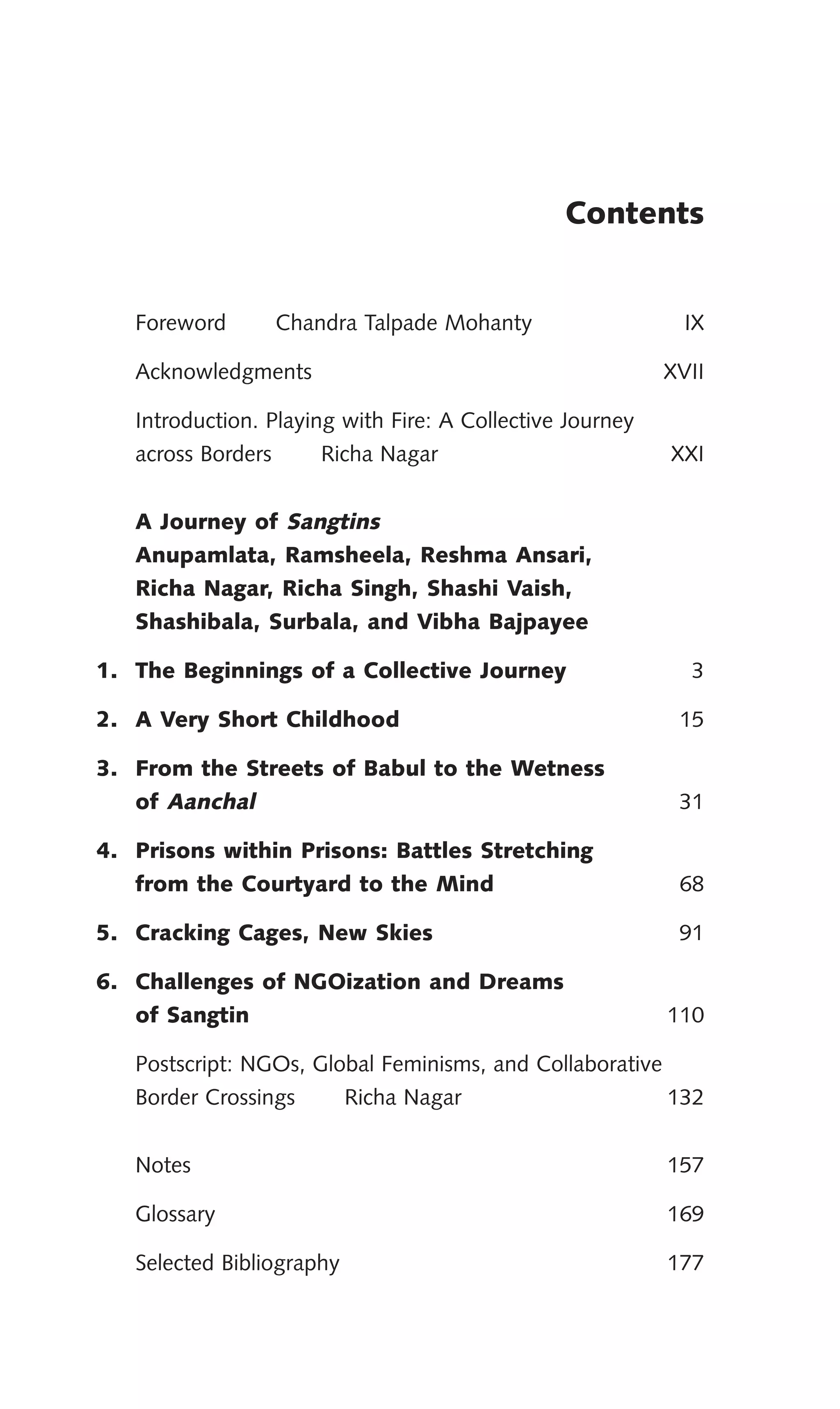

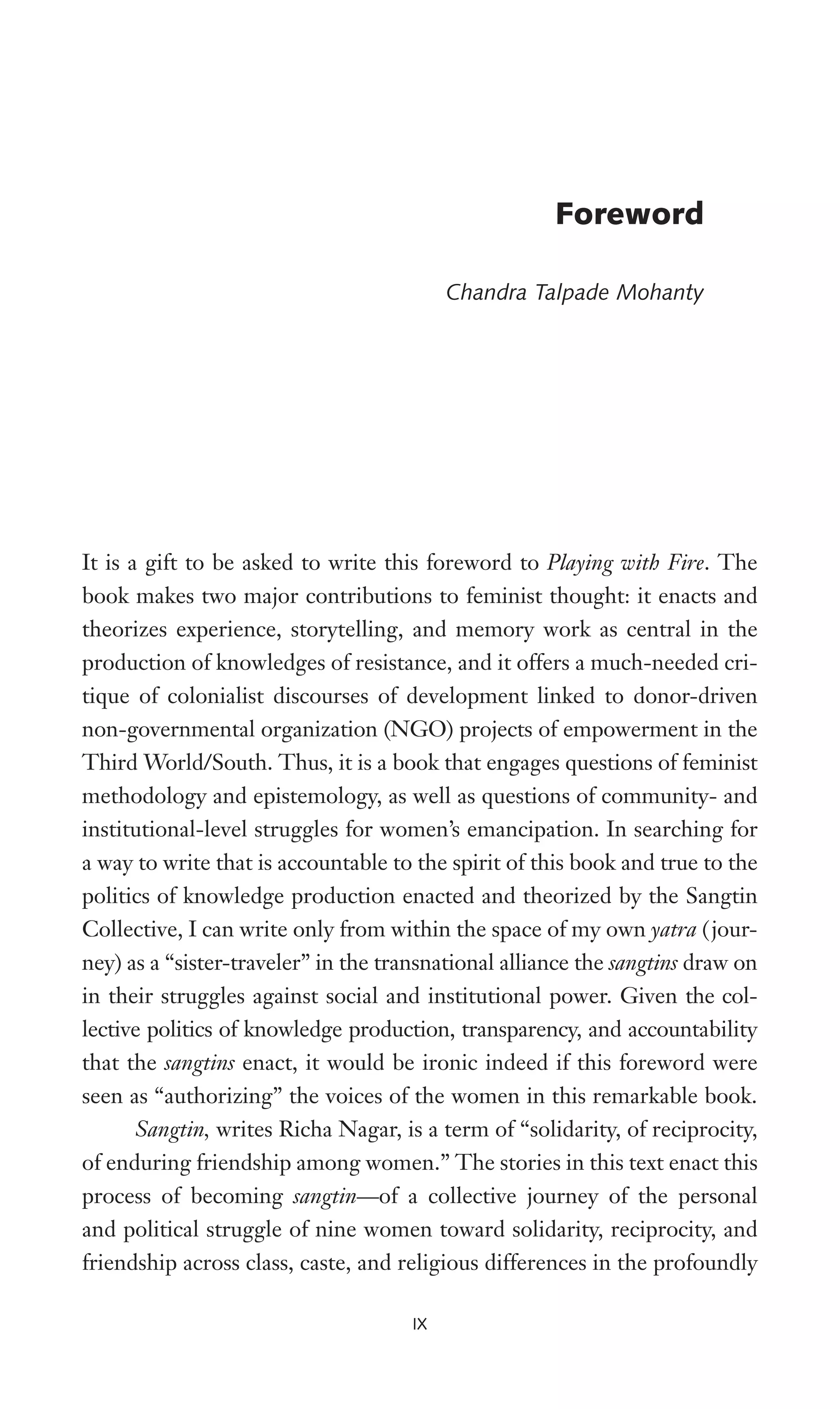


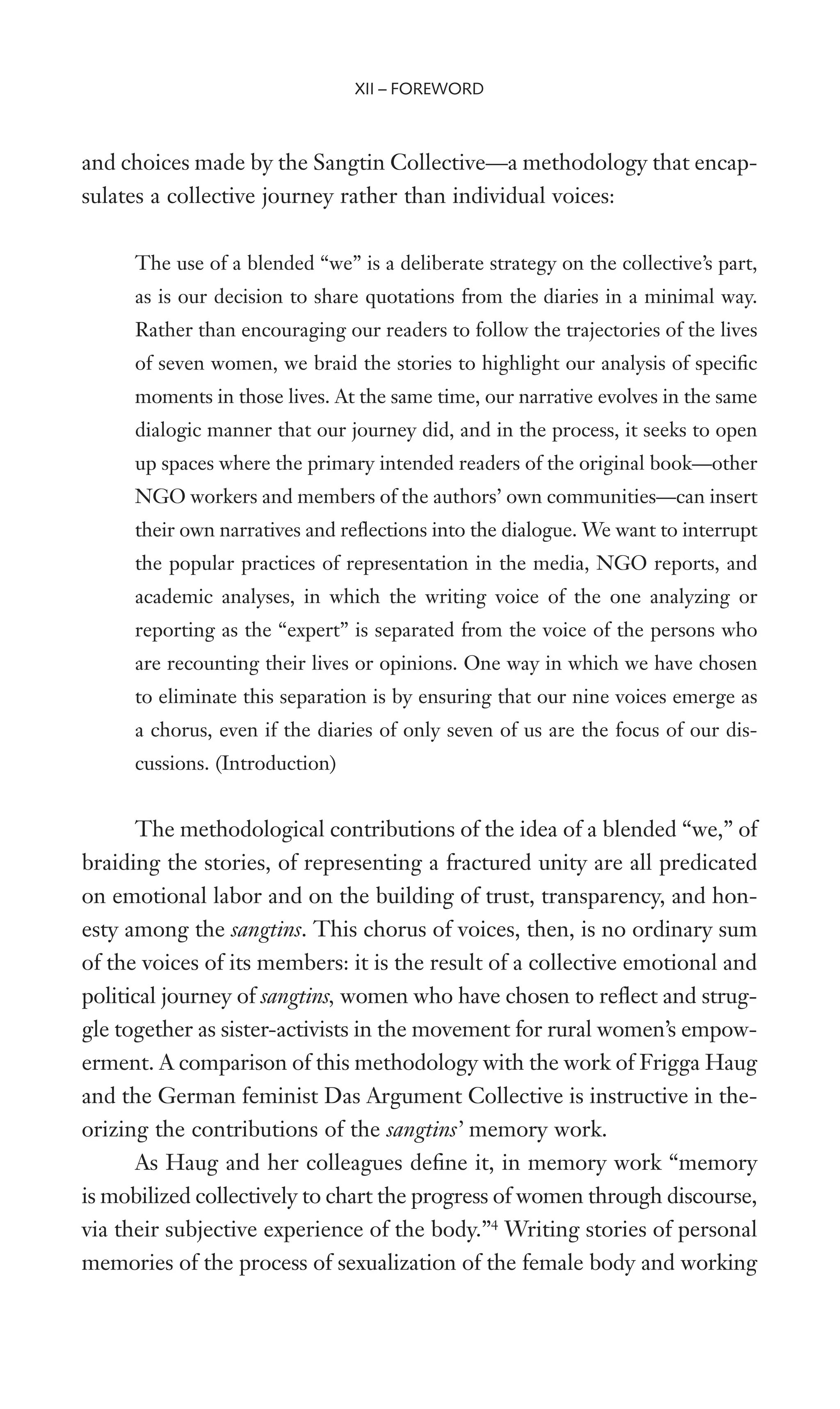
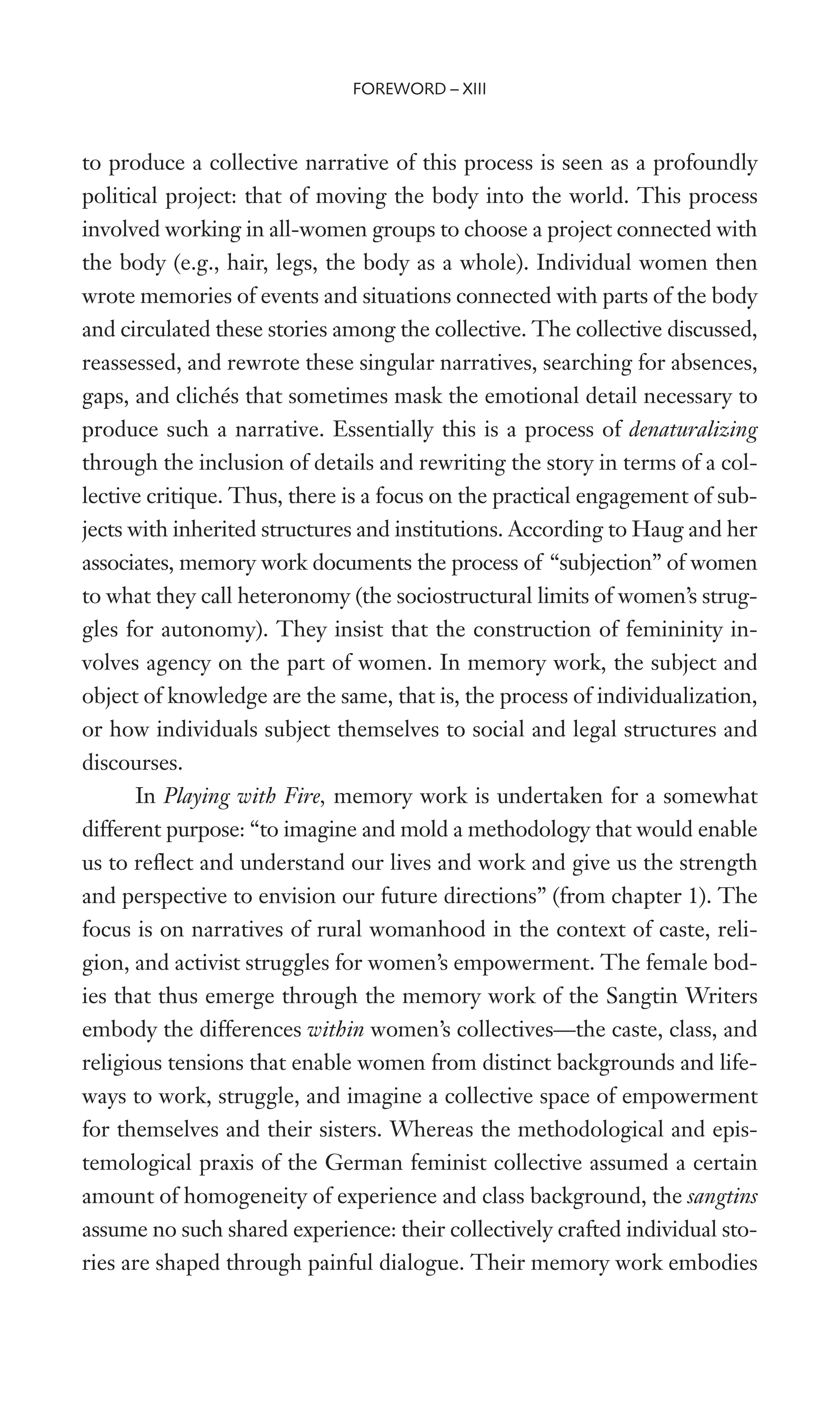
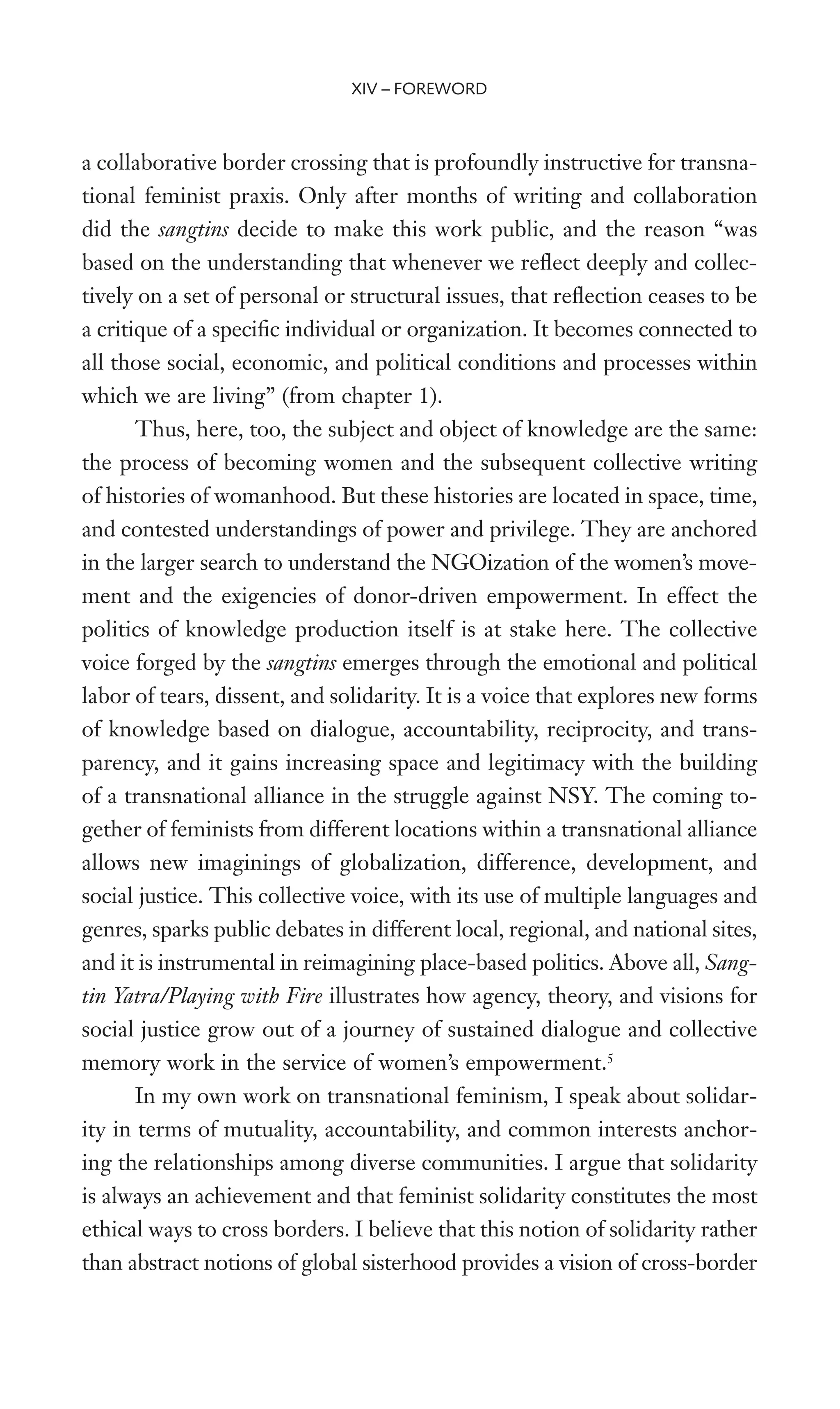
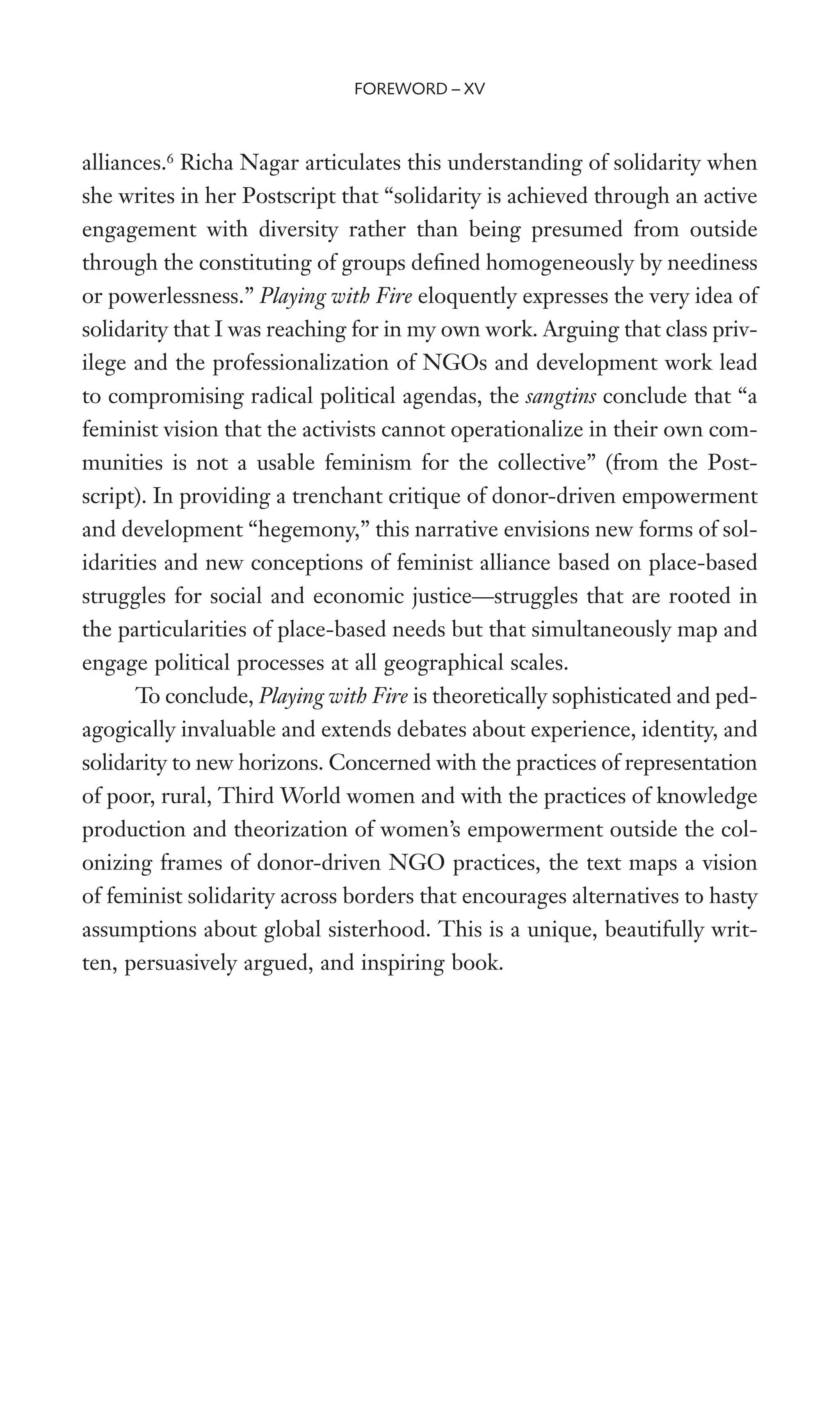

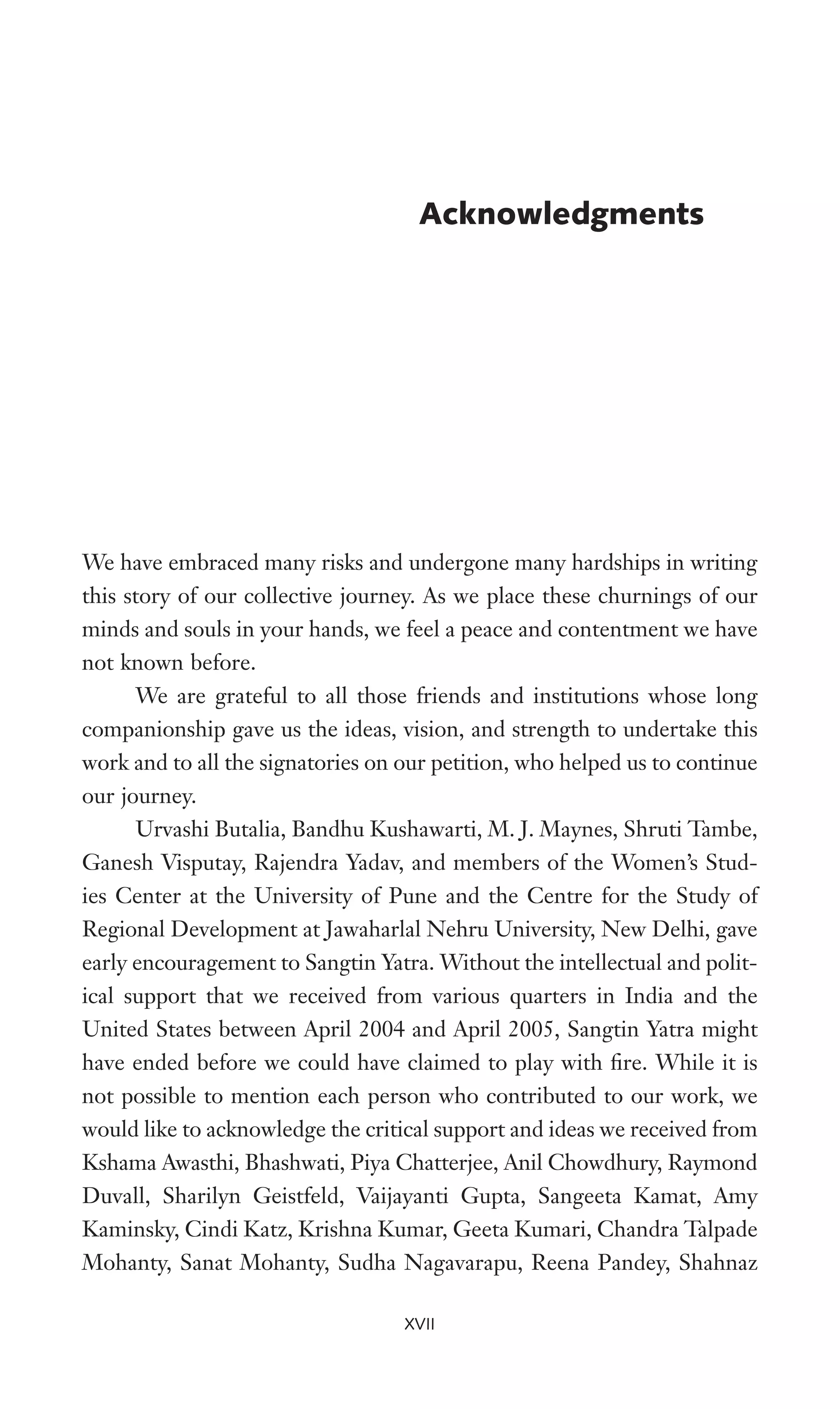
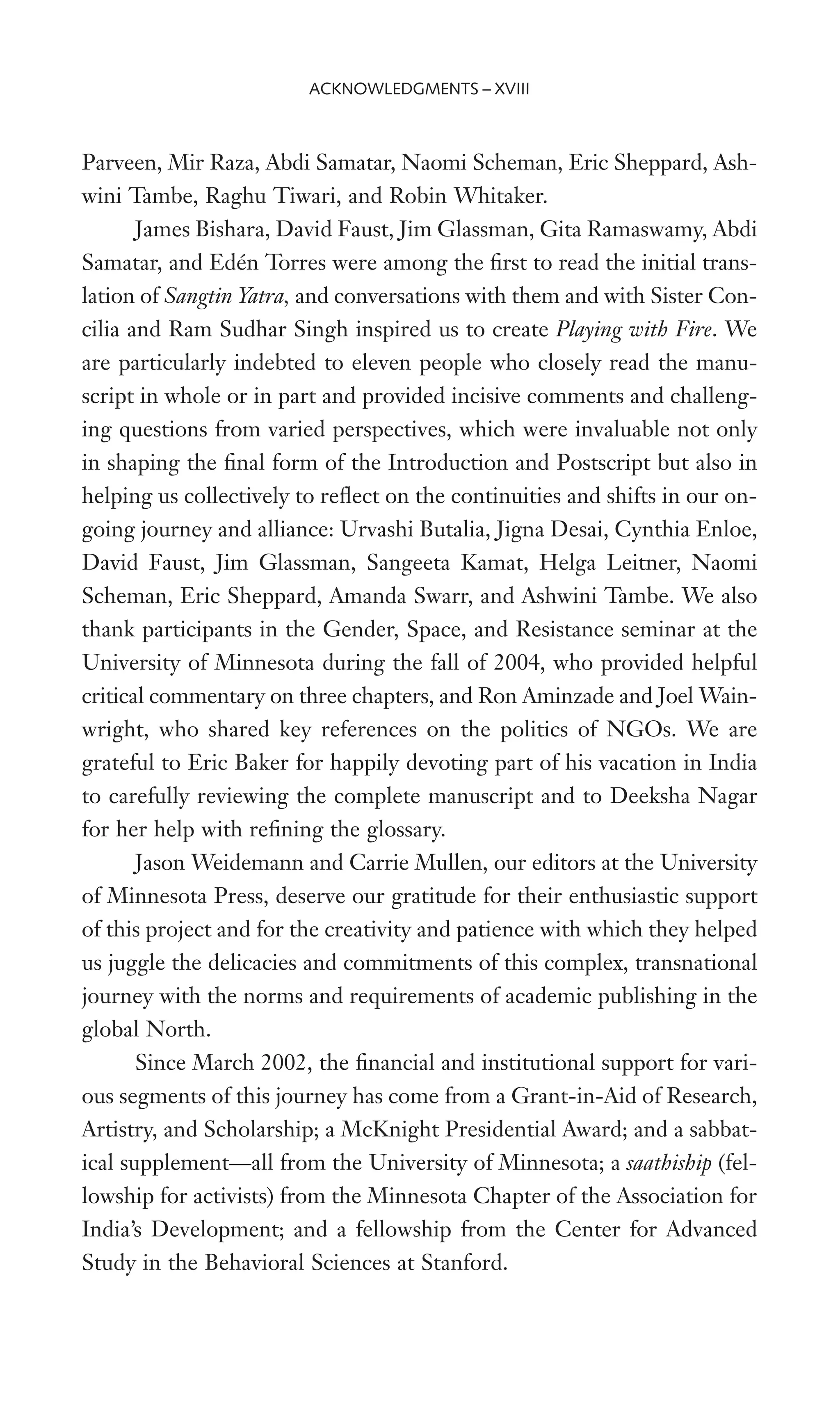
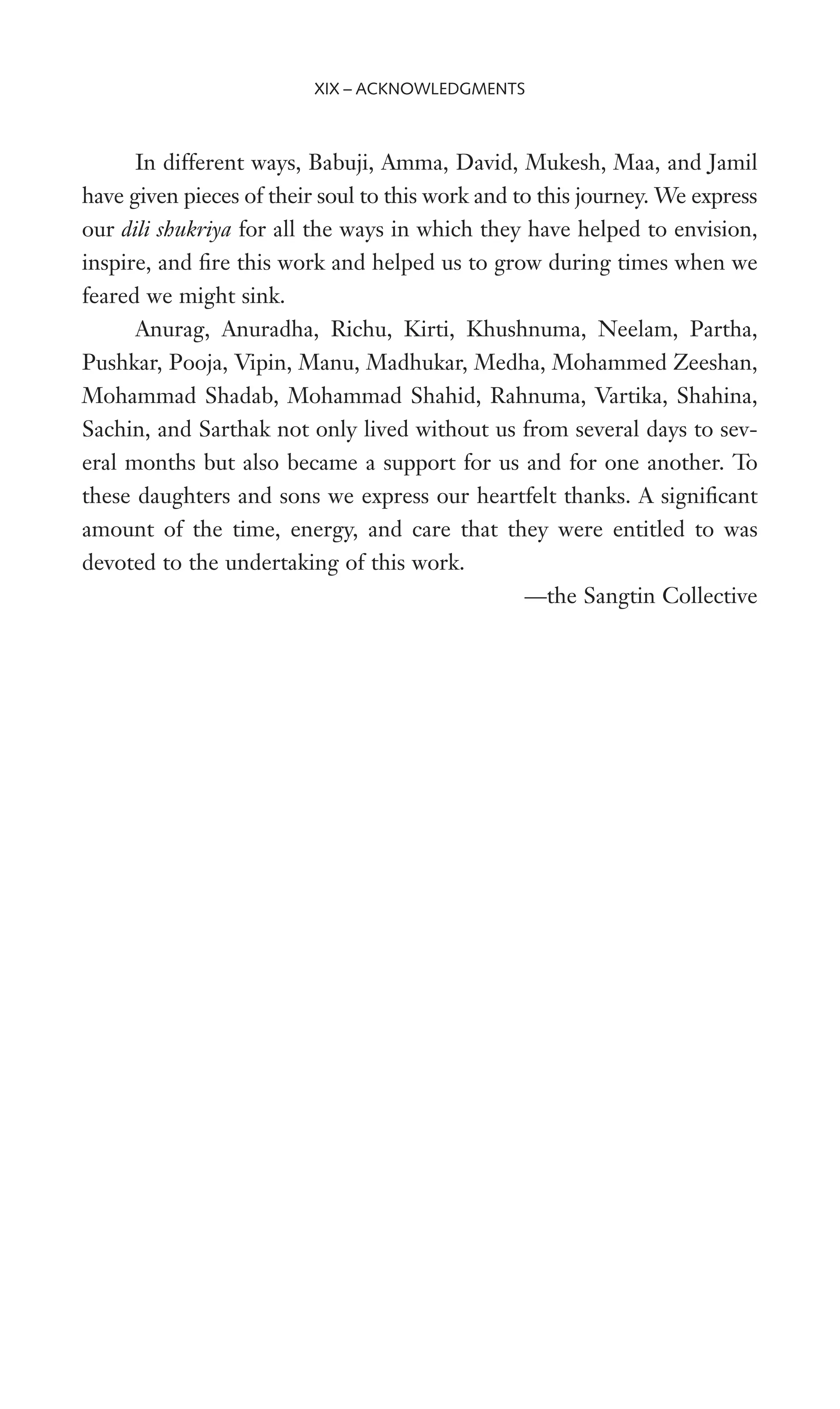

![How does one tell the story of a journey undertaken by nine women? And
how does one try to capture the meanings of such a journey when it is
continuously evolving and unfolding, sometimes in the face of intense
backlash? Playing with Fire seeks to tell that story as a chorus in which
nine travelers from varied sociopolitical locations self-reXexively merge
their voices to seek answers to a set of shared concerns. Although these
travelers inhabit different and unequal worlds in many ways, we are bound
together by a shared intellectual and political agenda—and by a passion
to envision and rebuild our interconnected worlds, even if such a project
involves playing with Wre.
Playing with Fire is set primarily in Uttar Pradesh, the most popu-
lous state of India, one that has been inXuential in the country’s political
I N T R O D U C T I O N
Playing with Fire
A Collective Journey across Borders
Richa Nagar
If we have learned anything about anthropology’s encounter with
colonialism, the question is not really whether anthropologists can
represent people better, but whether we can be accountable to people’s
own struggles for self-representation and self-determination.
—Kamala Visweswaran, Fictions of Feminist Ethnography
[Conscientización] is a consciousness of [our] own political positions in
the world and what that means in terms of Wnding ways to create
change. . . . [A] critical look at one’s own suffering and the ability to
feel empathy may be required for making this transition from one
identity to another.
—Edén E. Torres, Chicana without Apology
XXI](https://image.slidesharecdn.com/playing-20with-20fire-20book-140402052849-phpapp01/75/Playing-with-fire-book-22-2048.jpg)
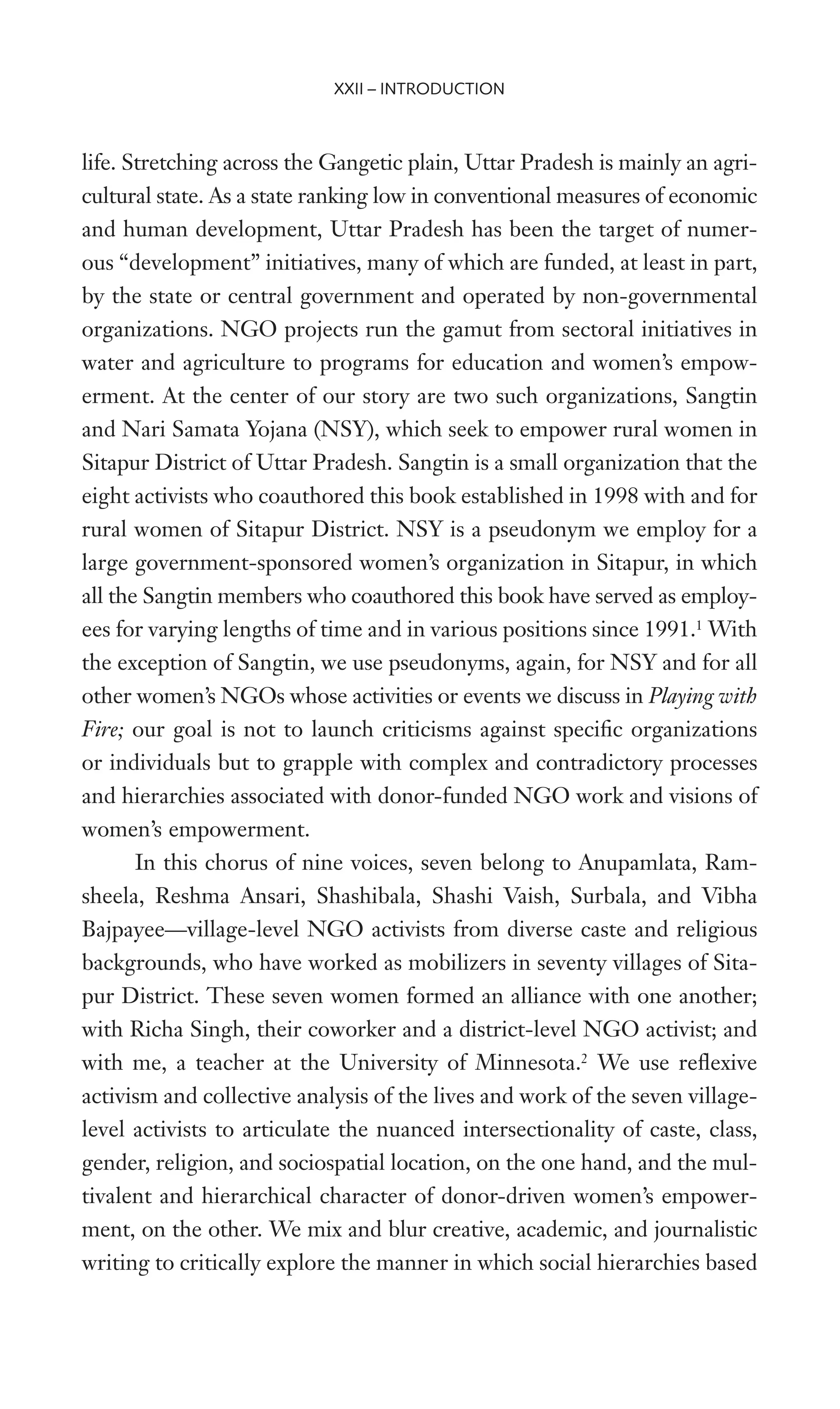
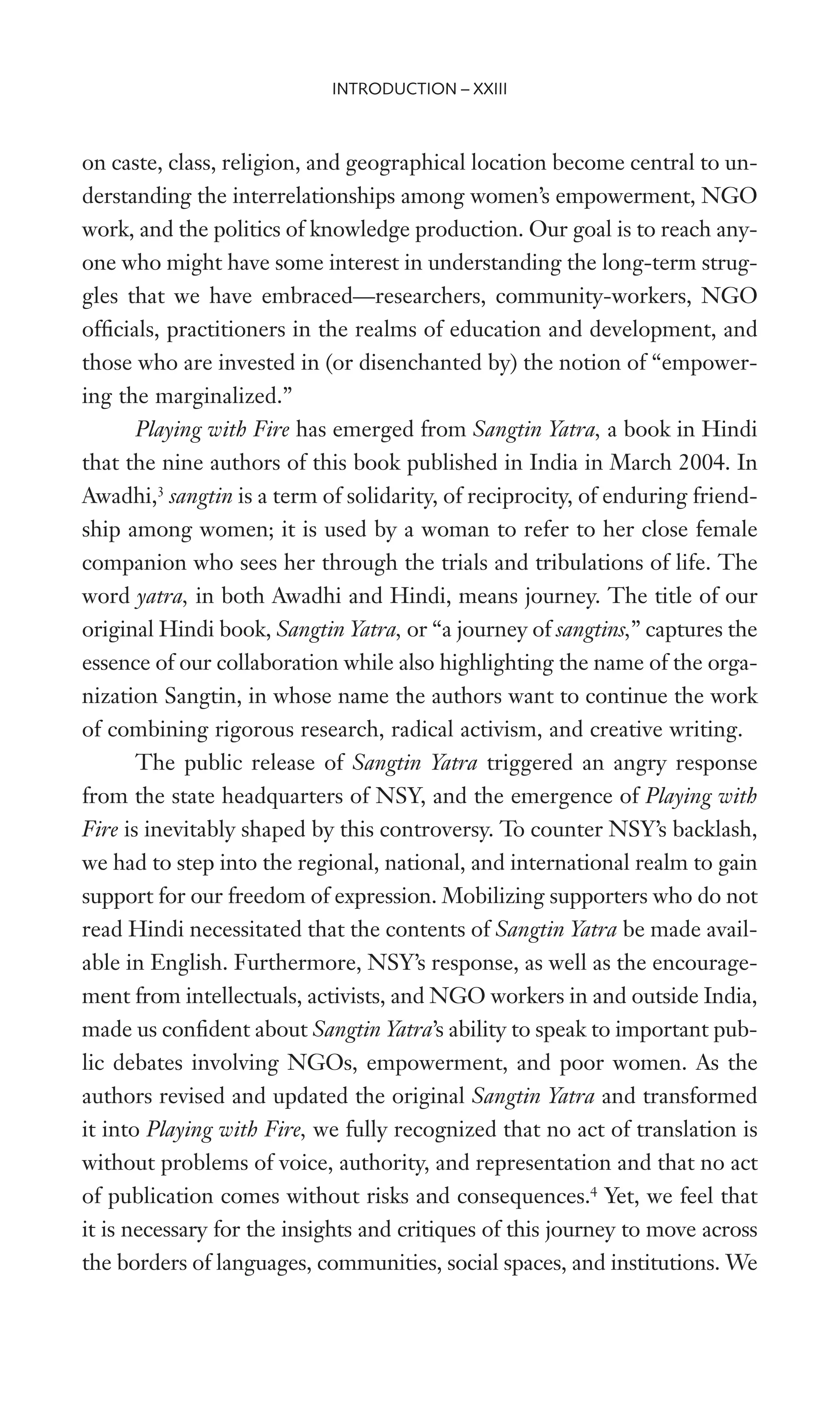
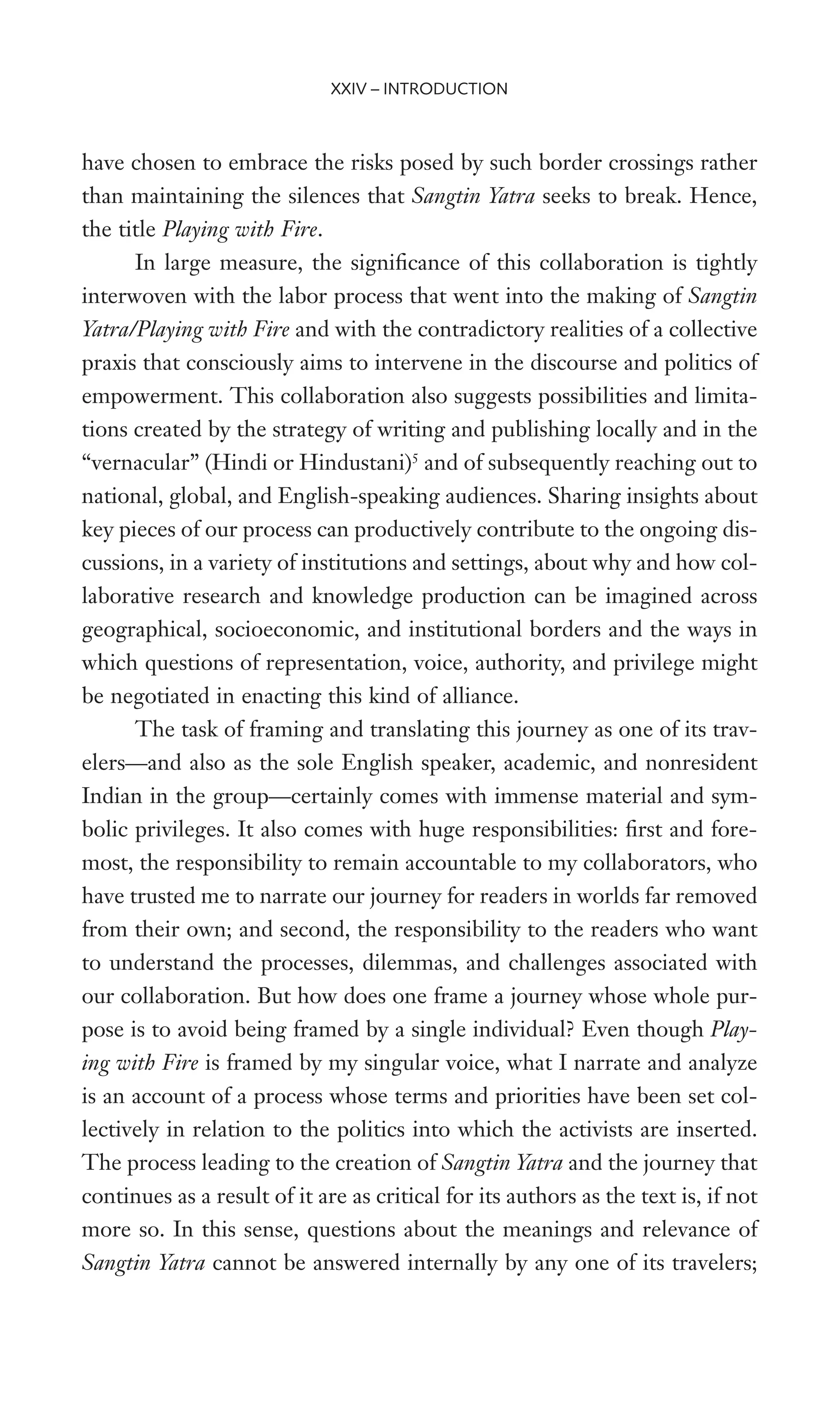
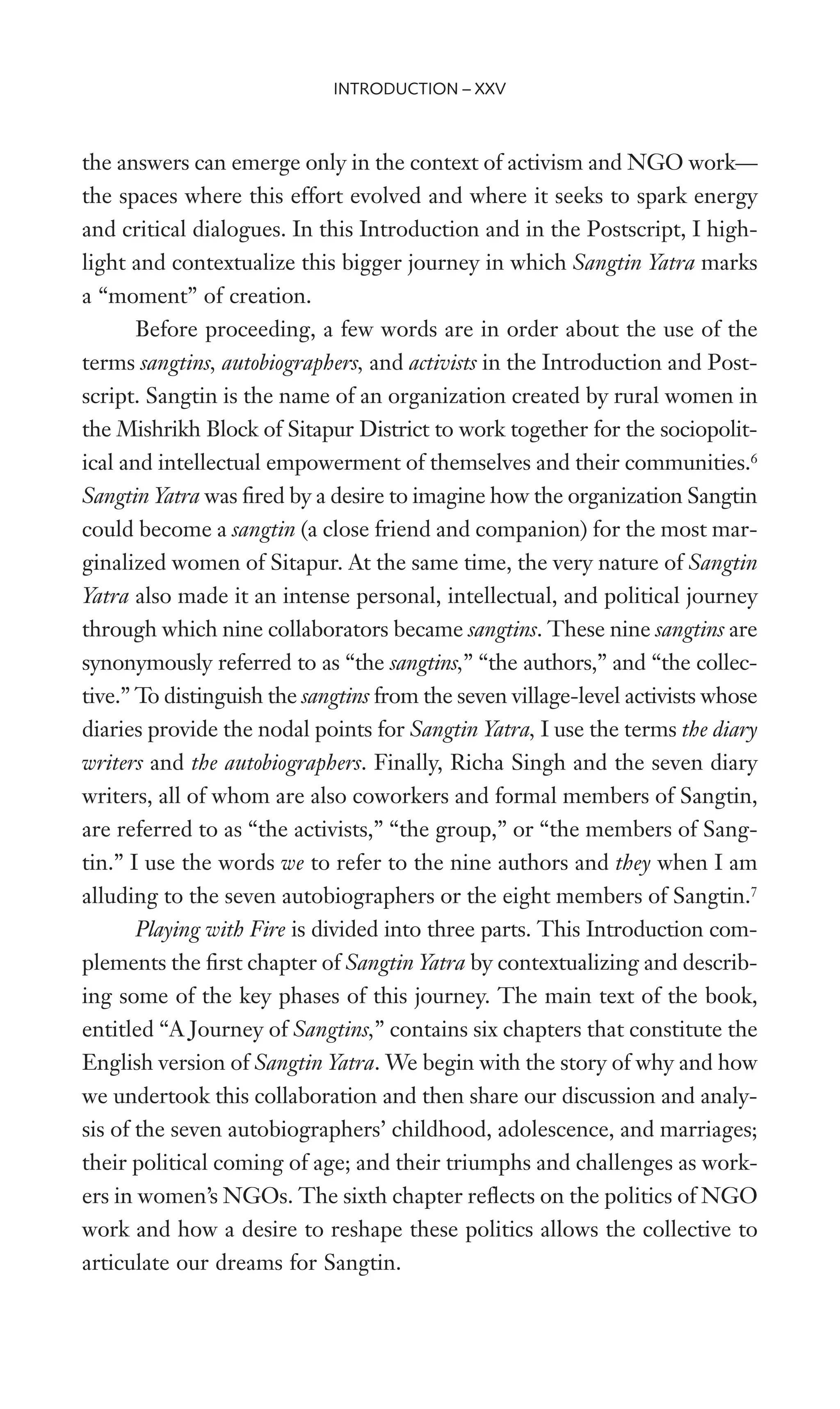
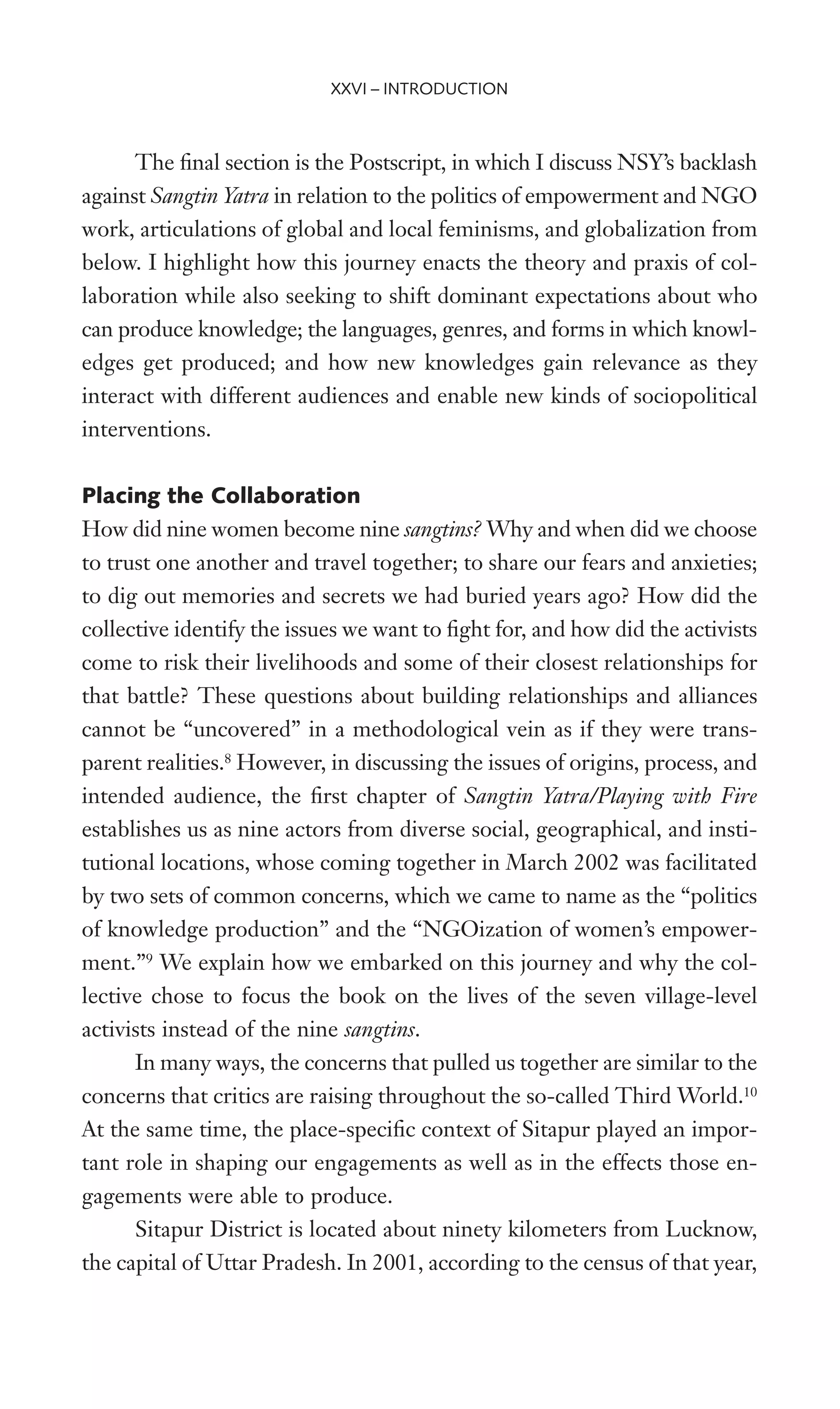
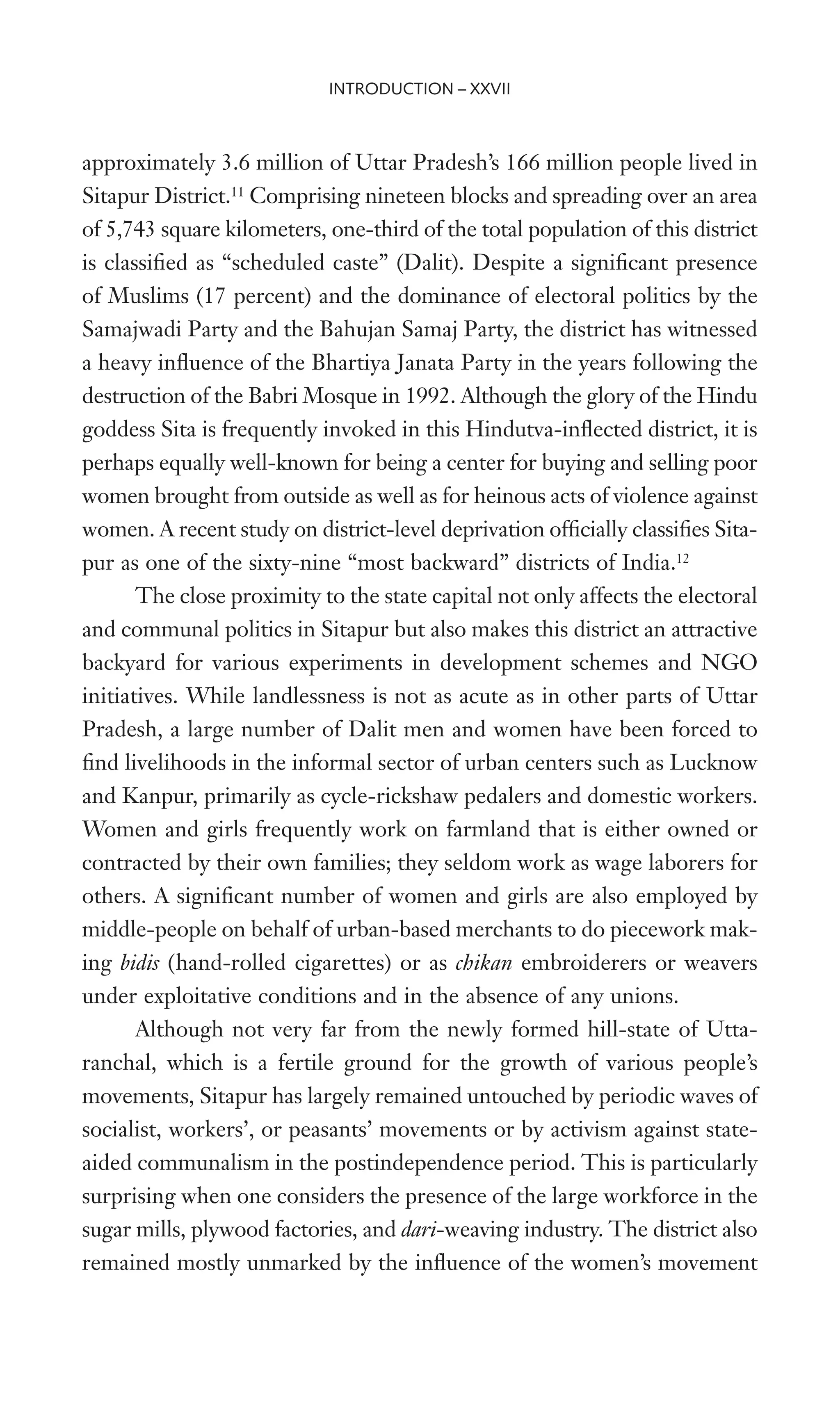
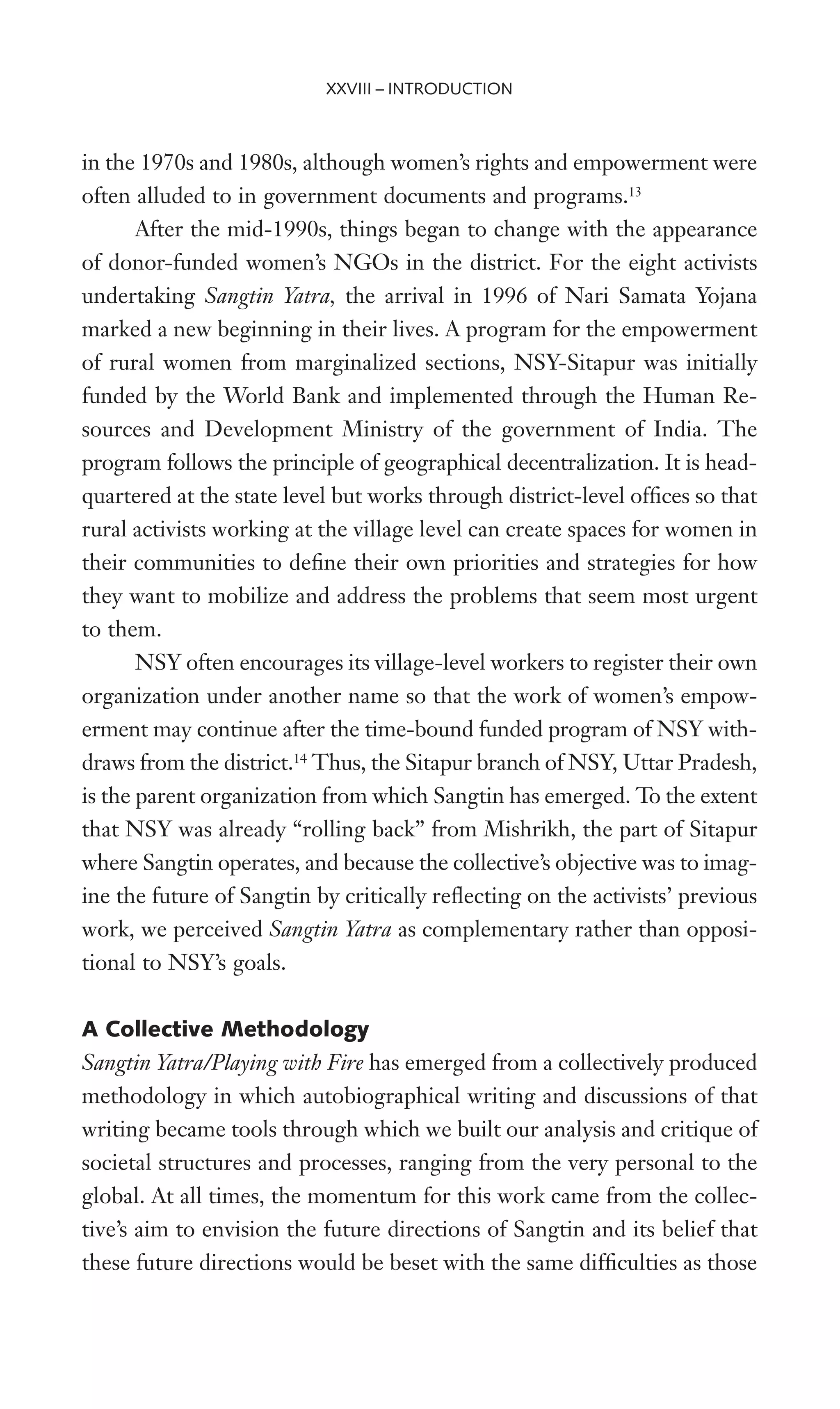
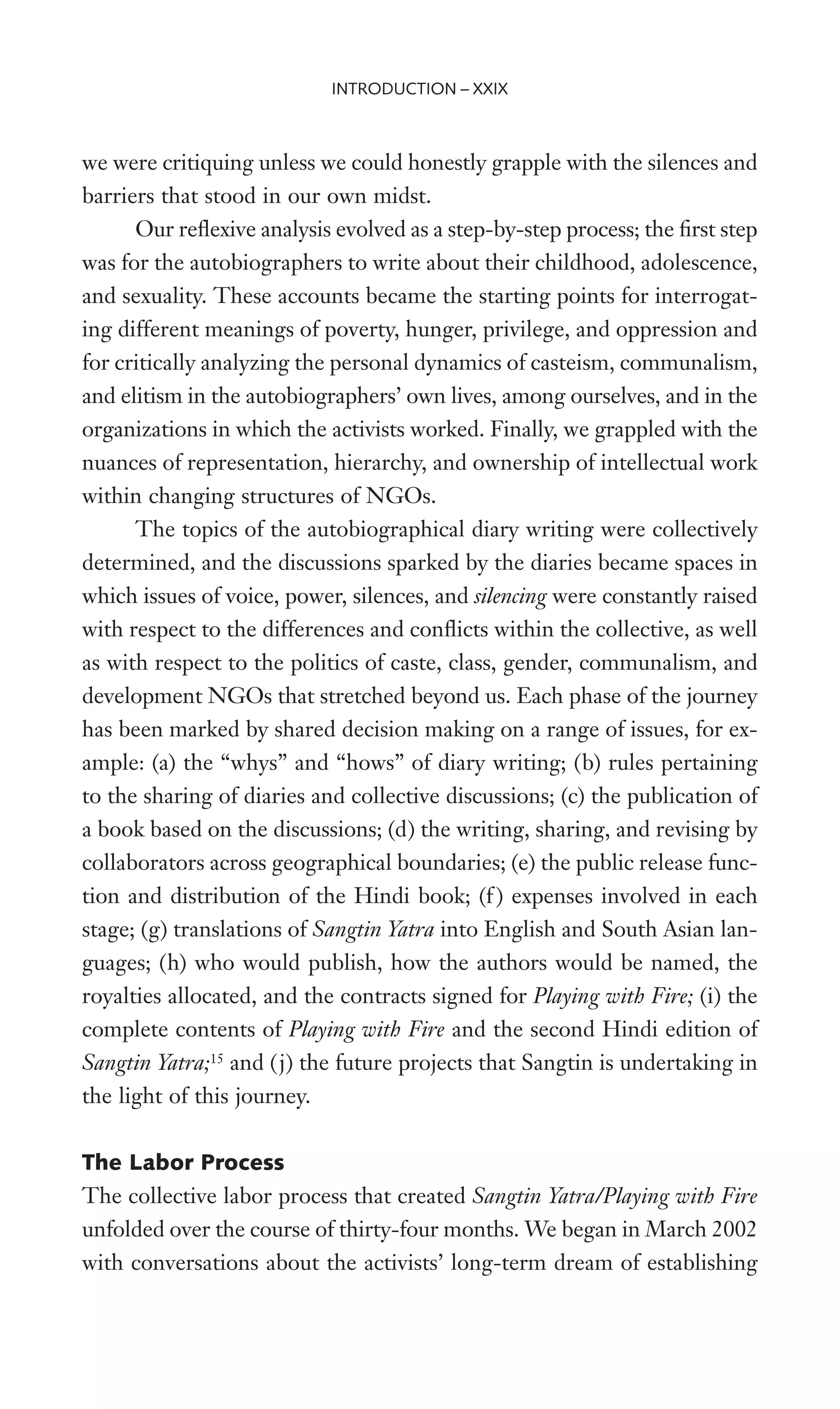
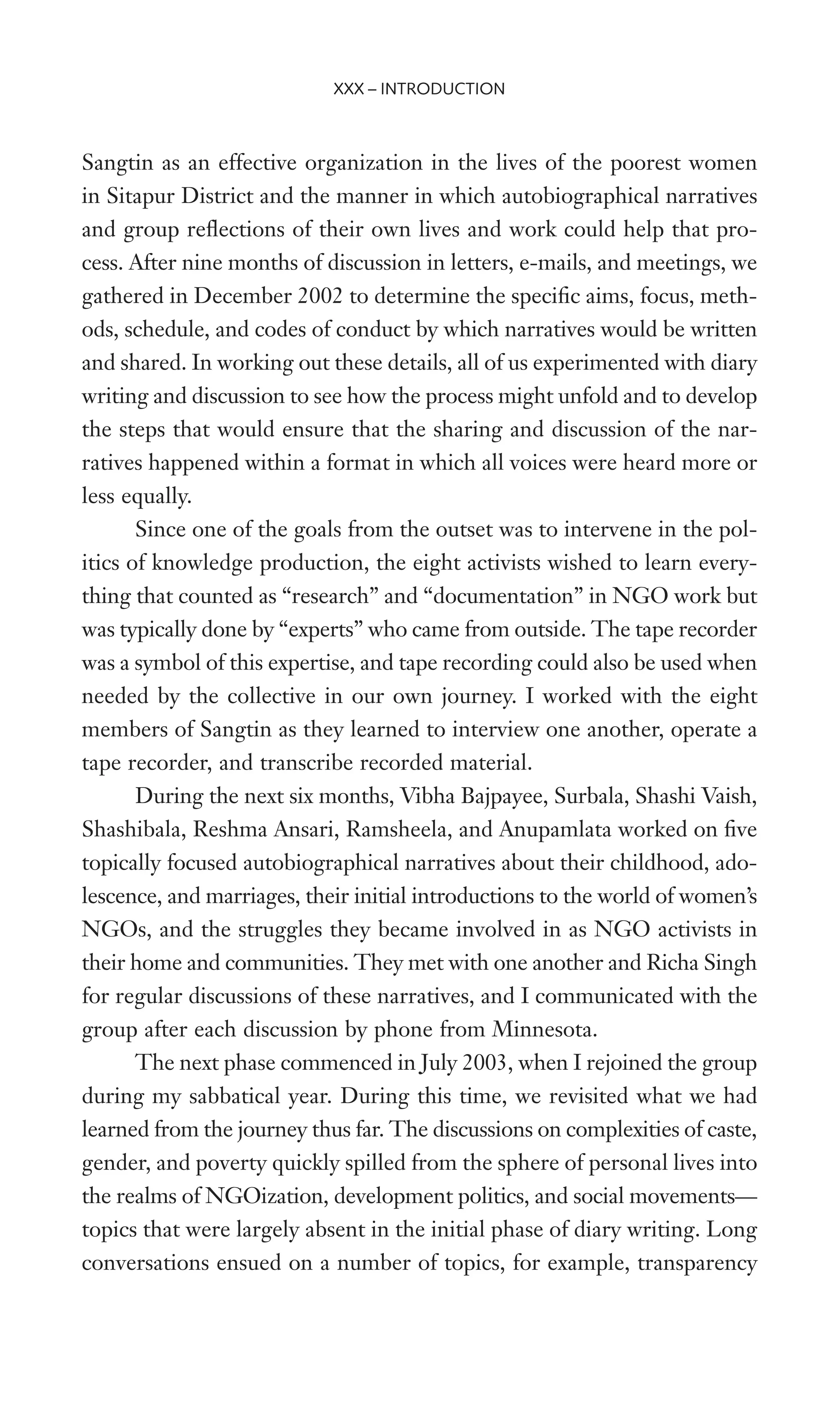
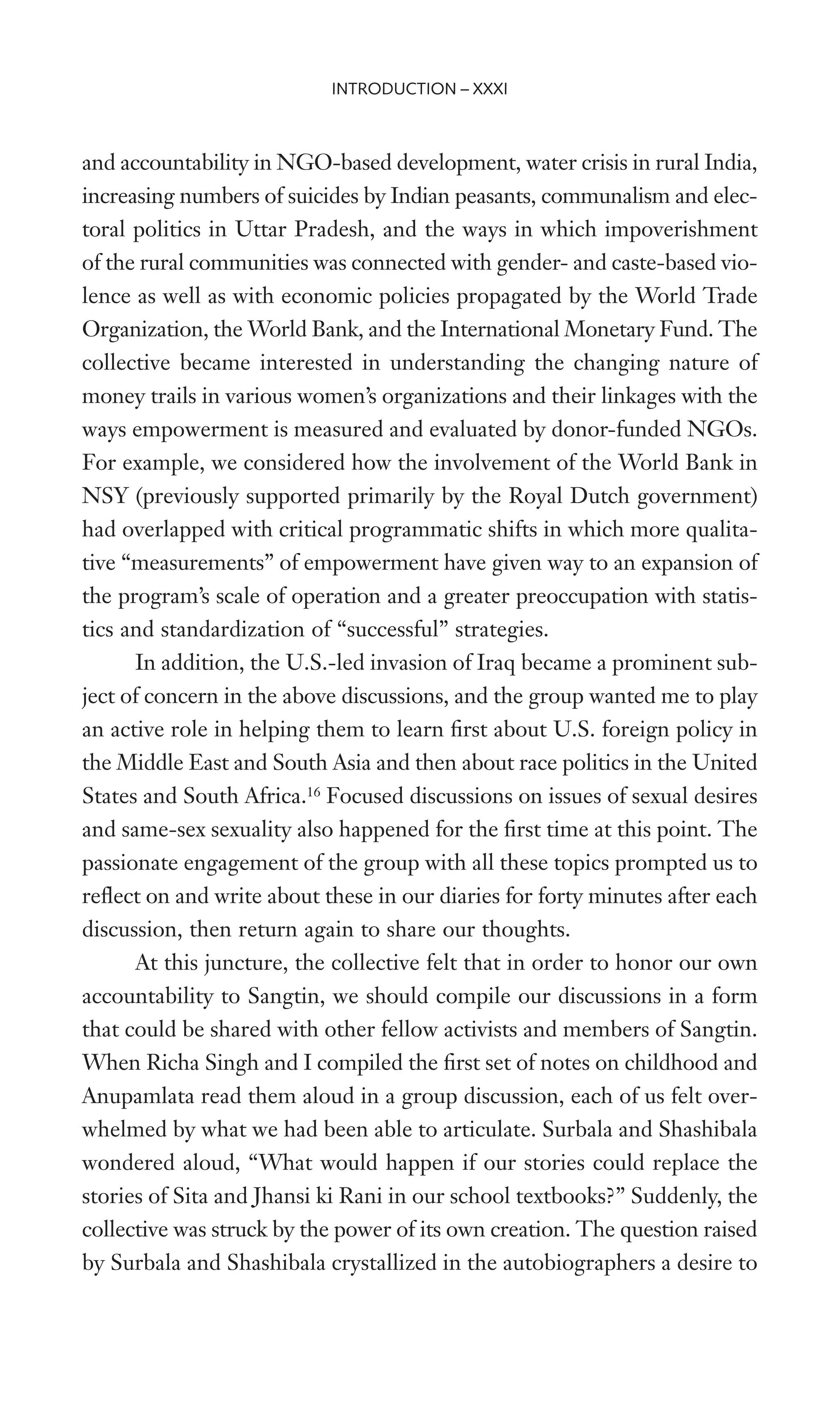
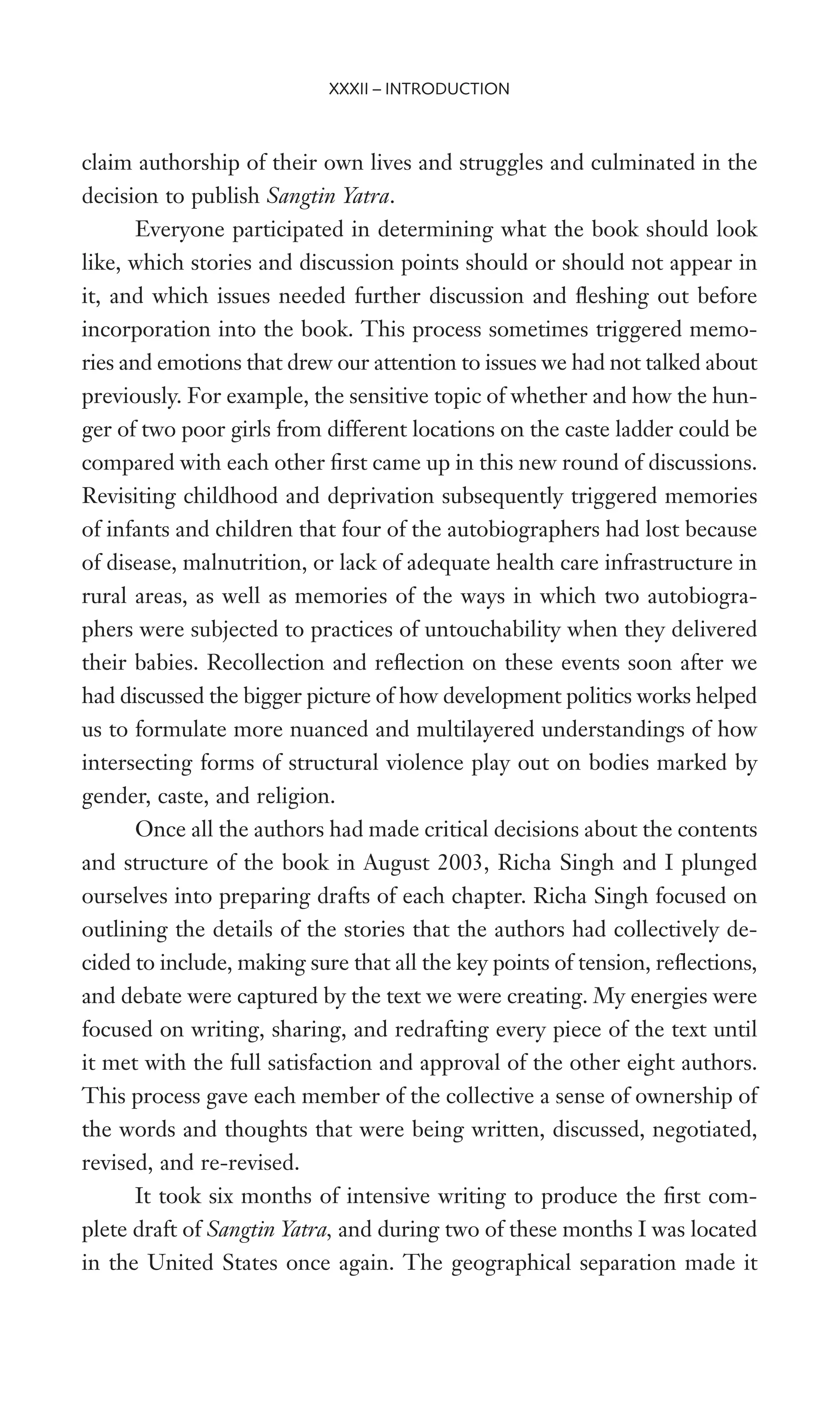


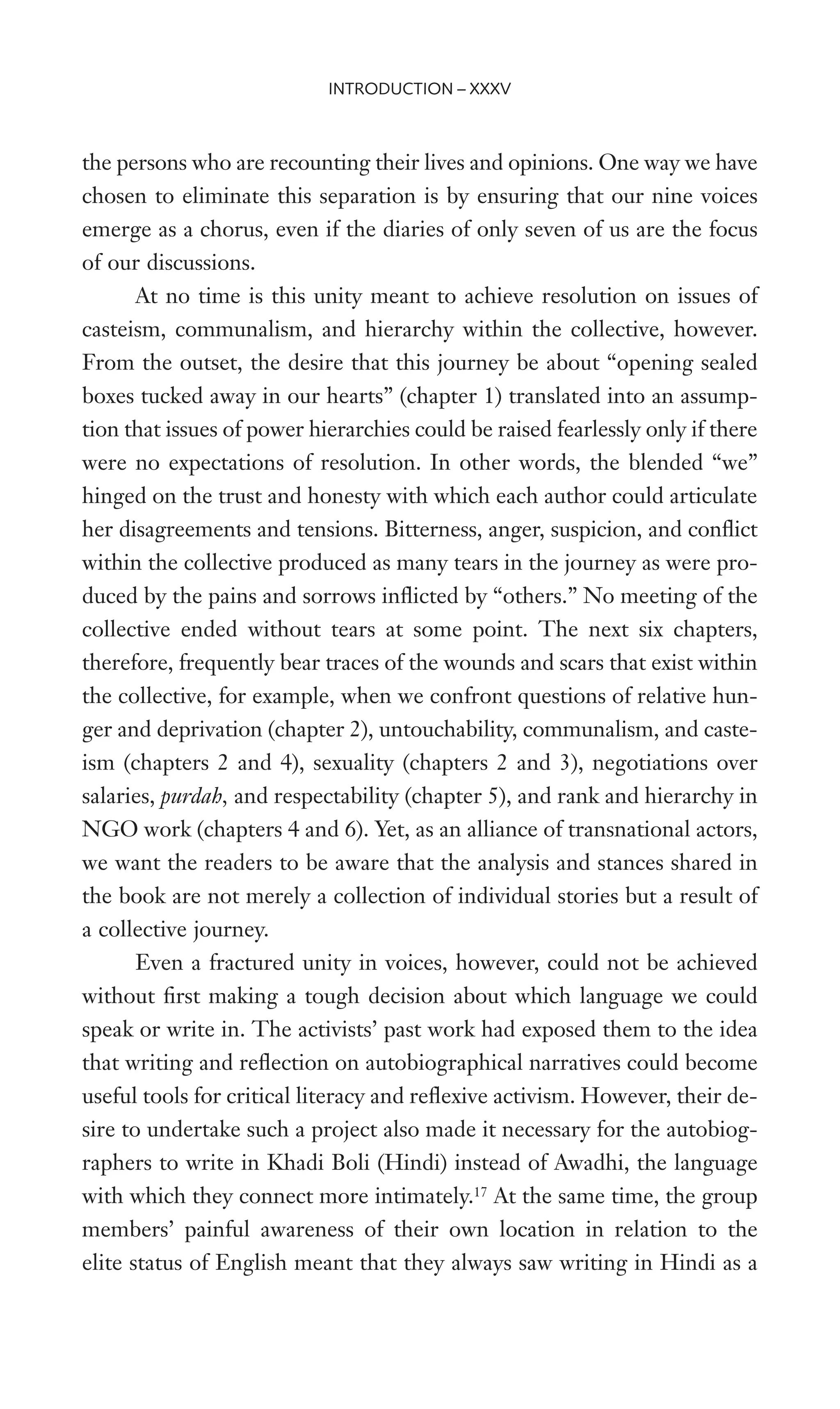
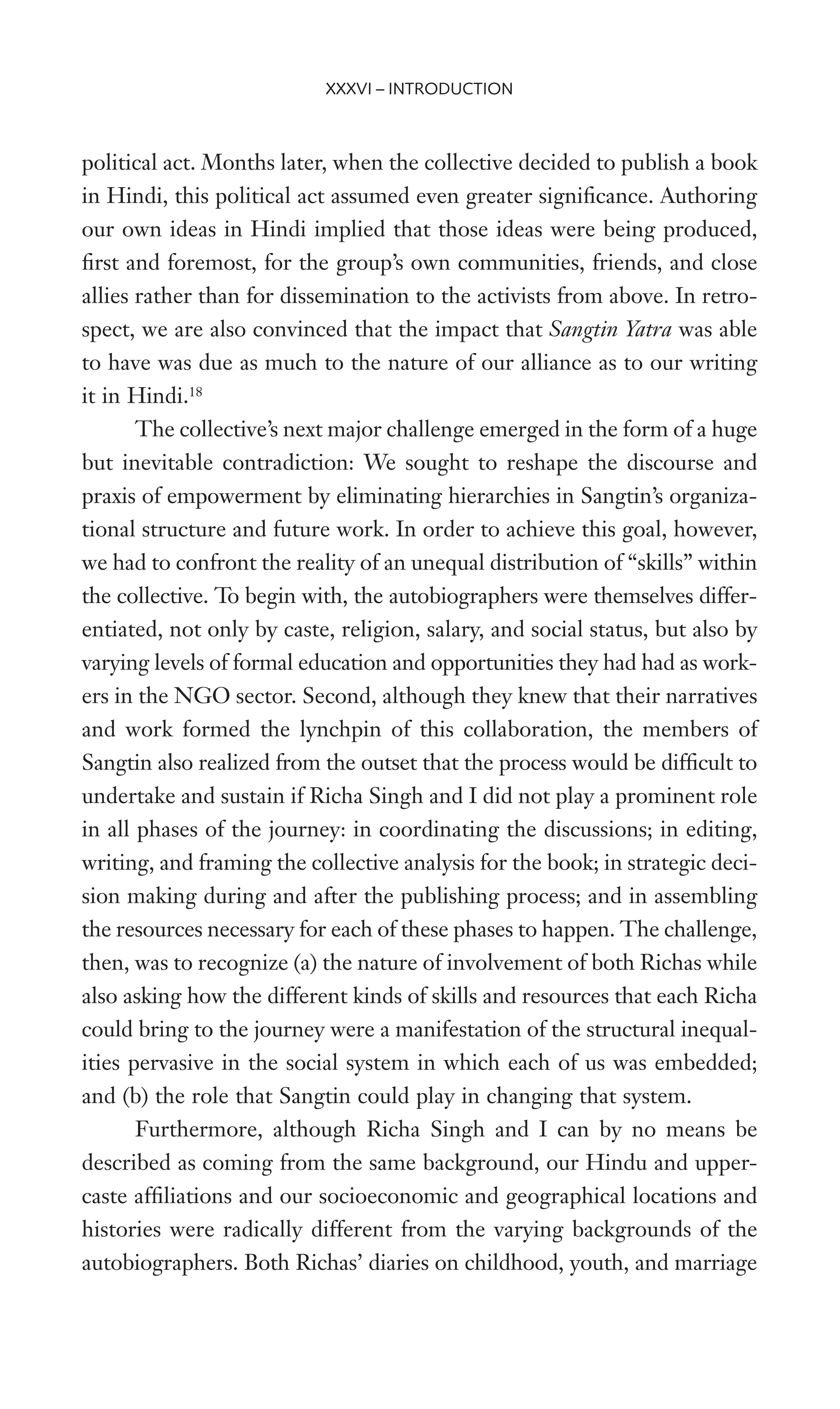
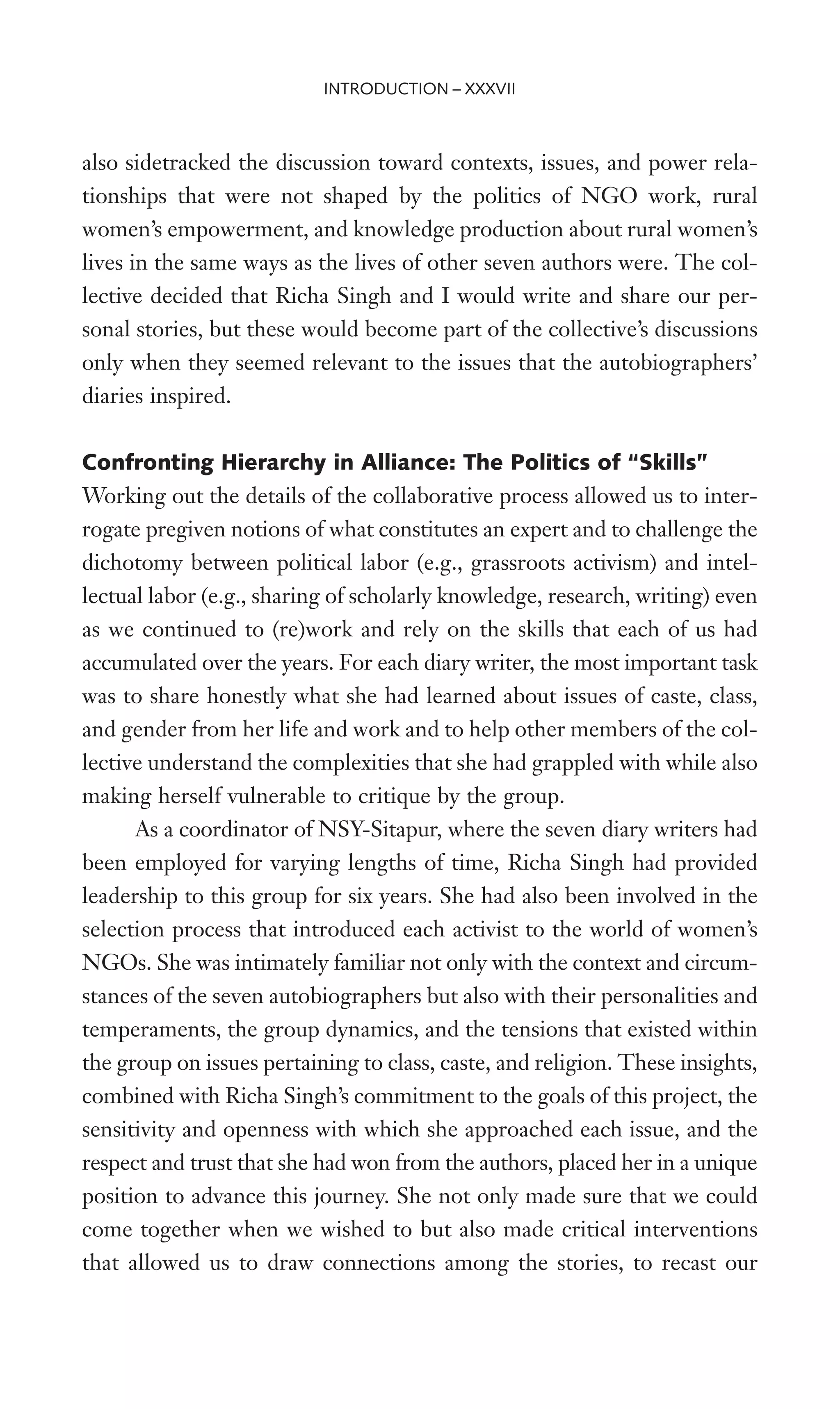
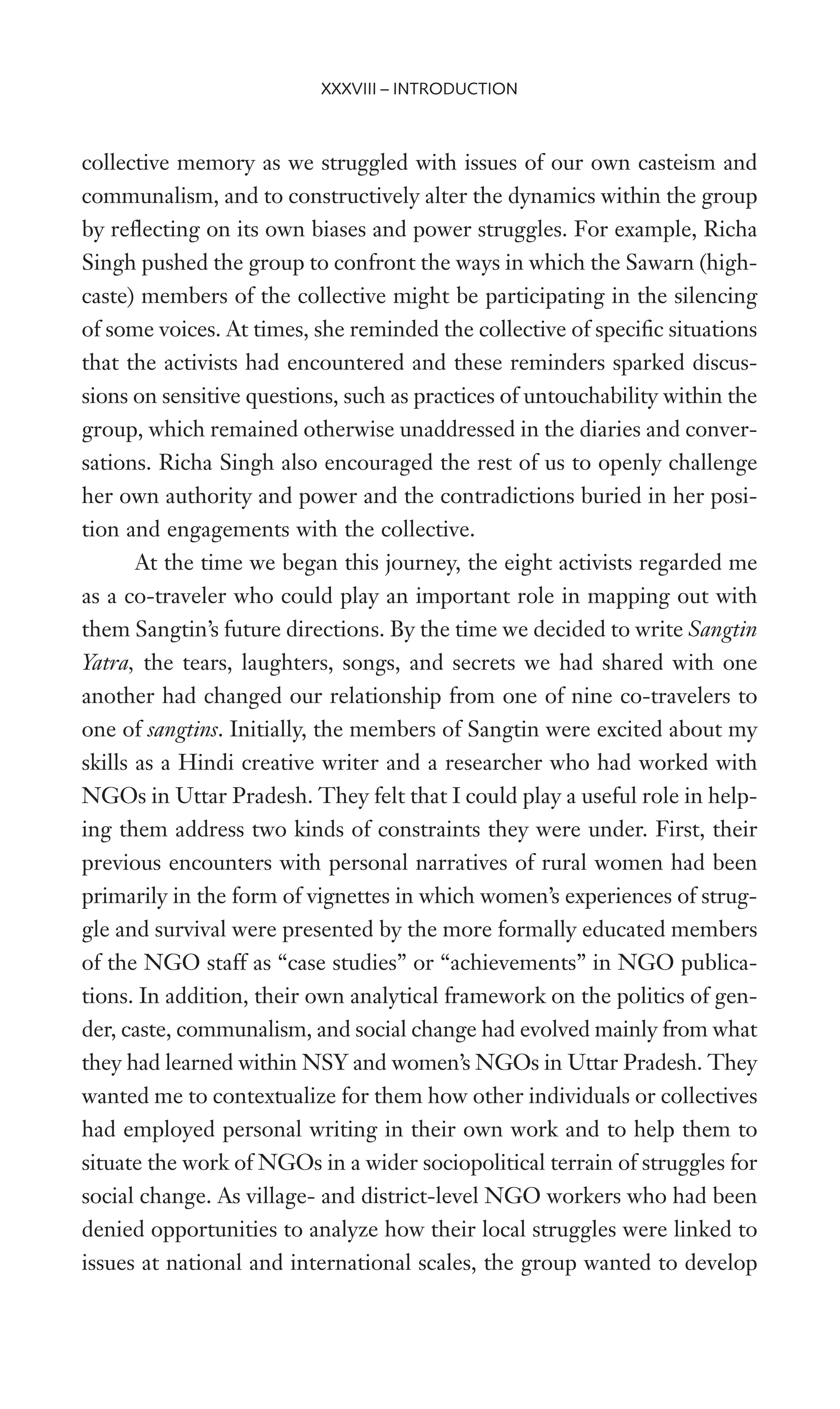
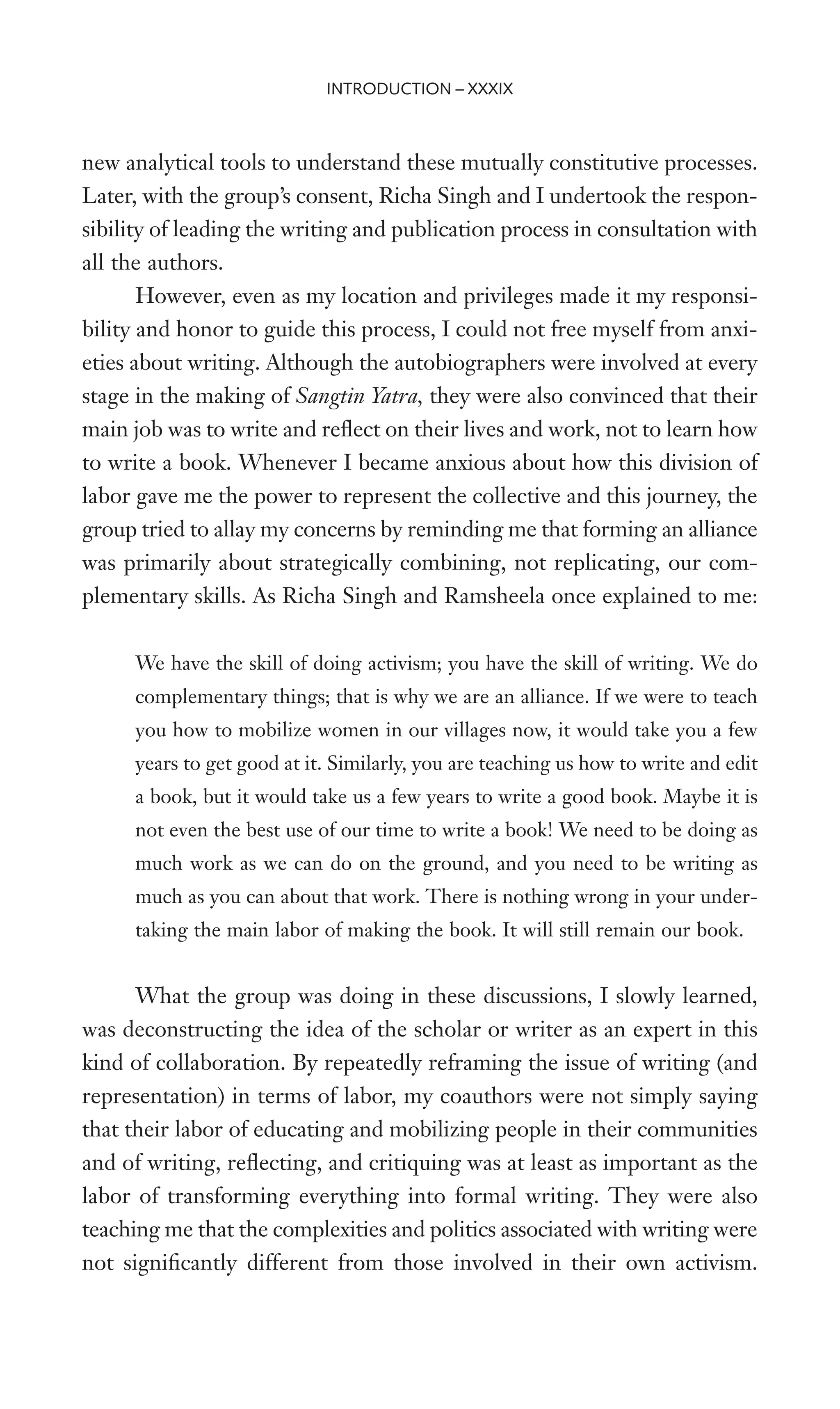
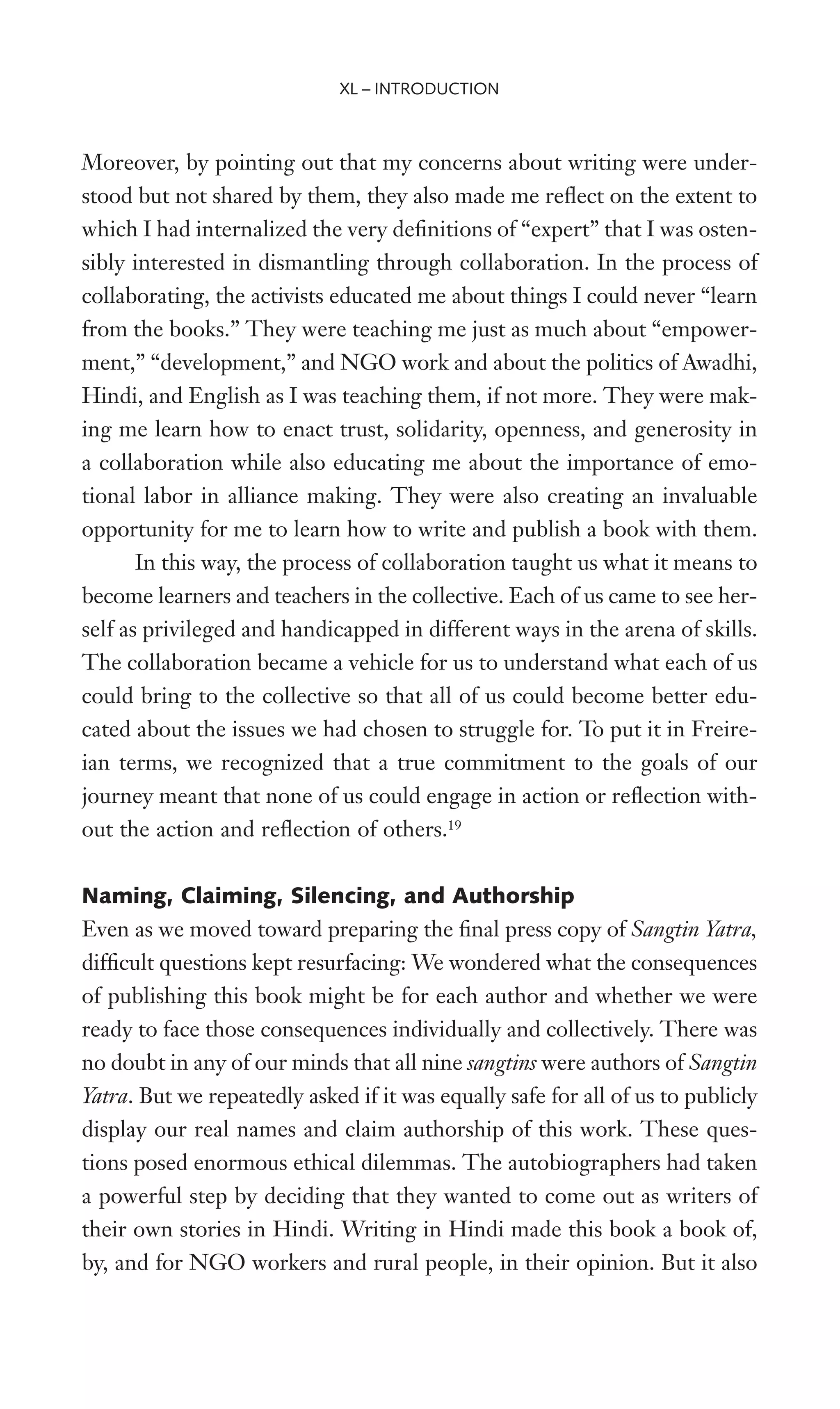
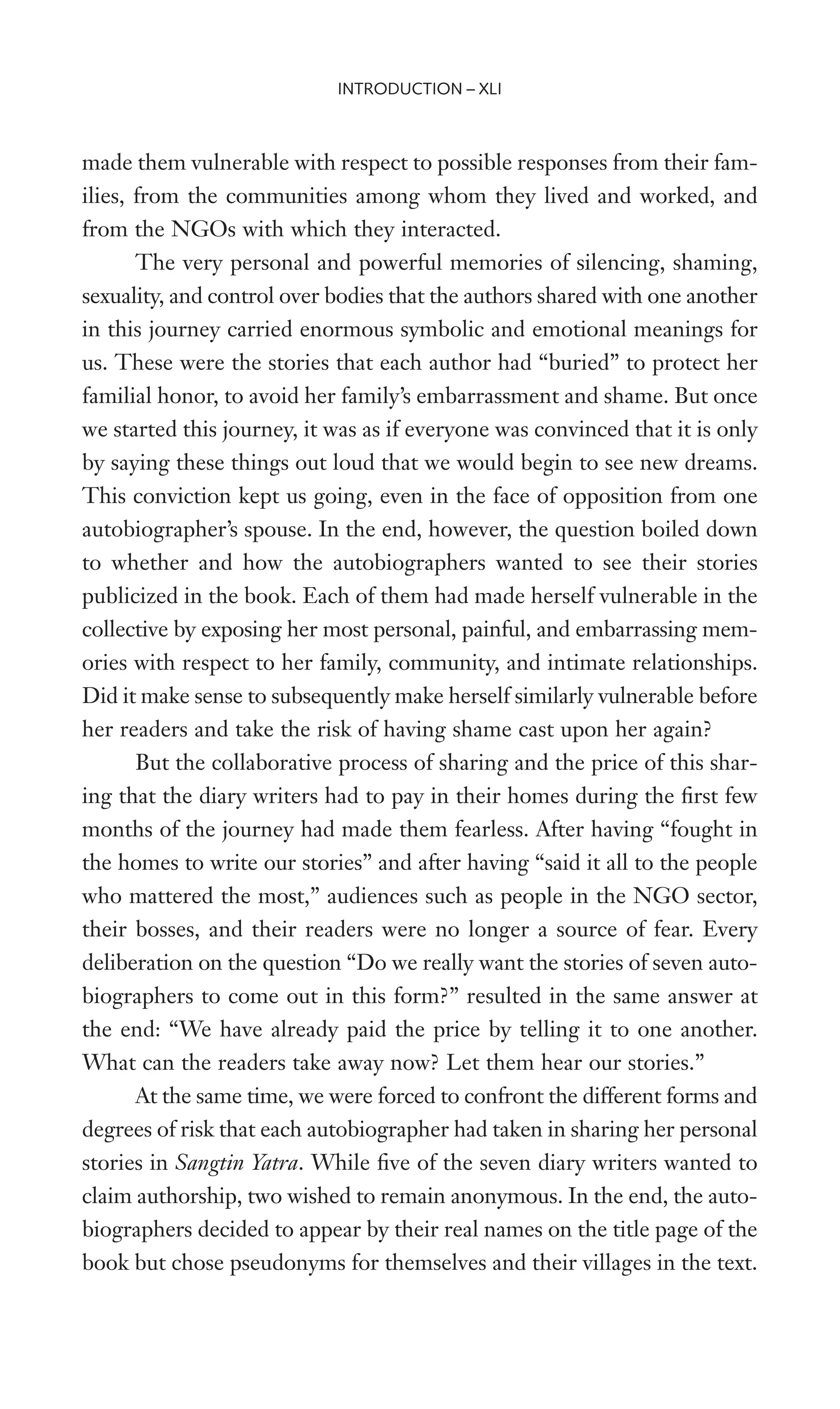
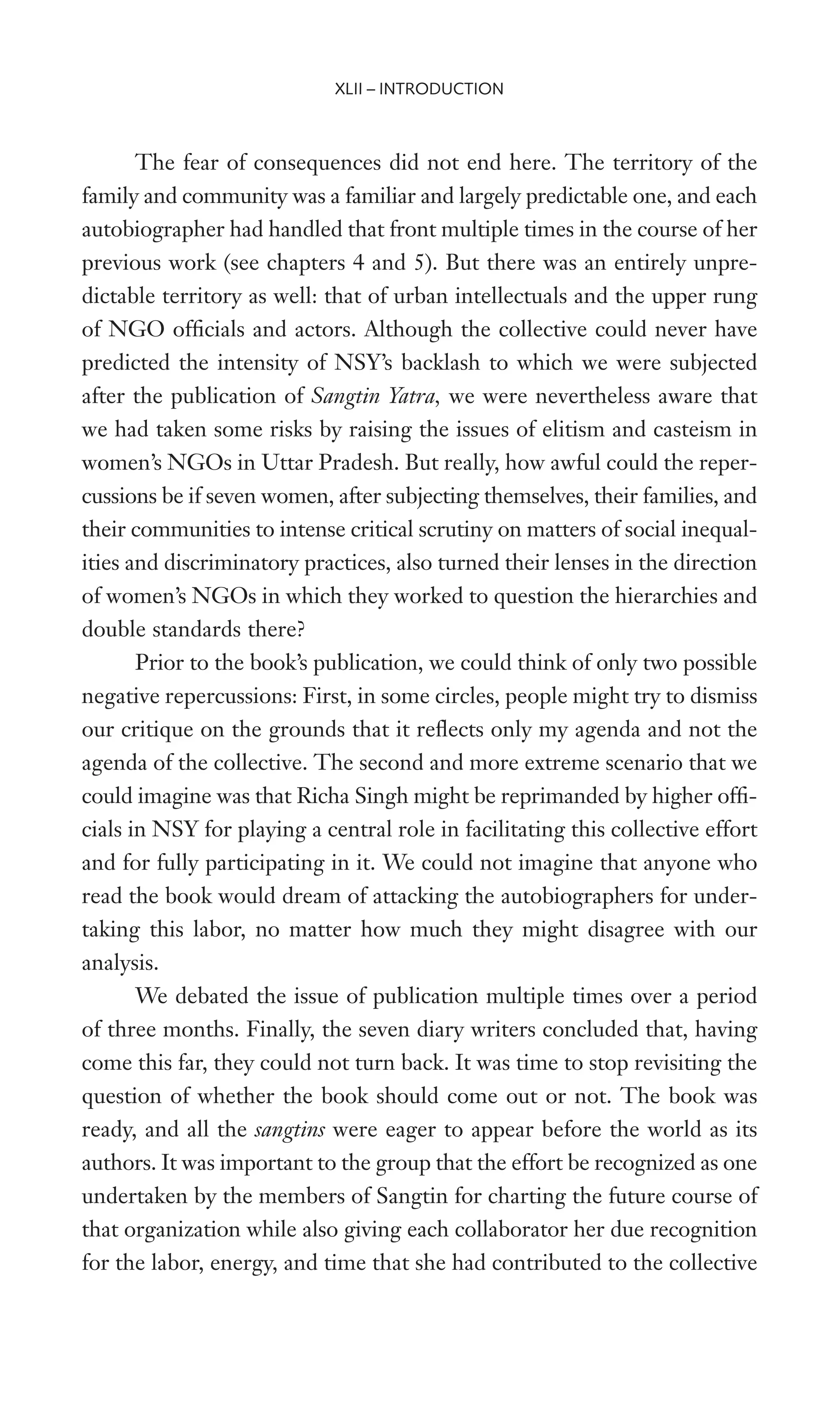
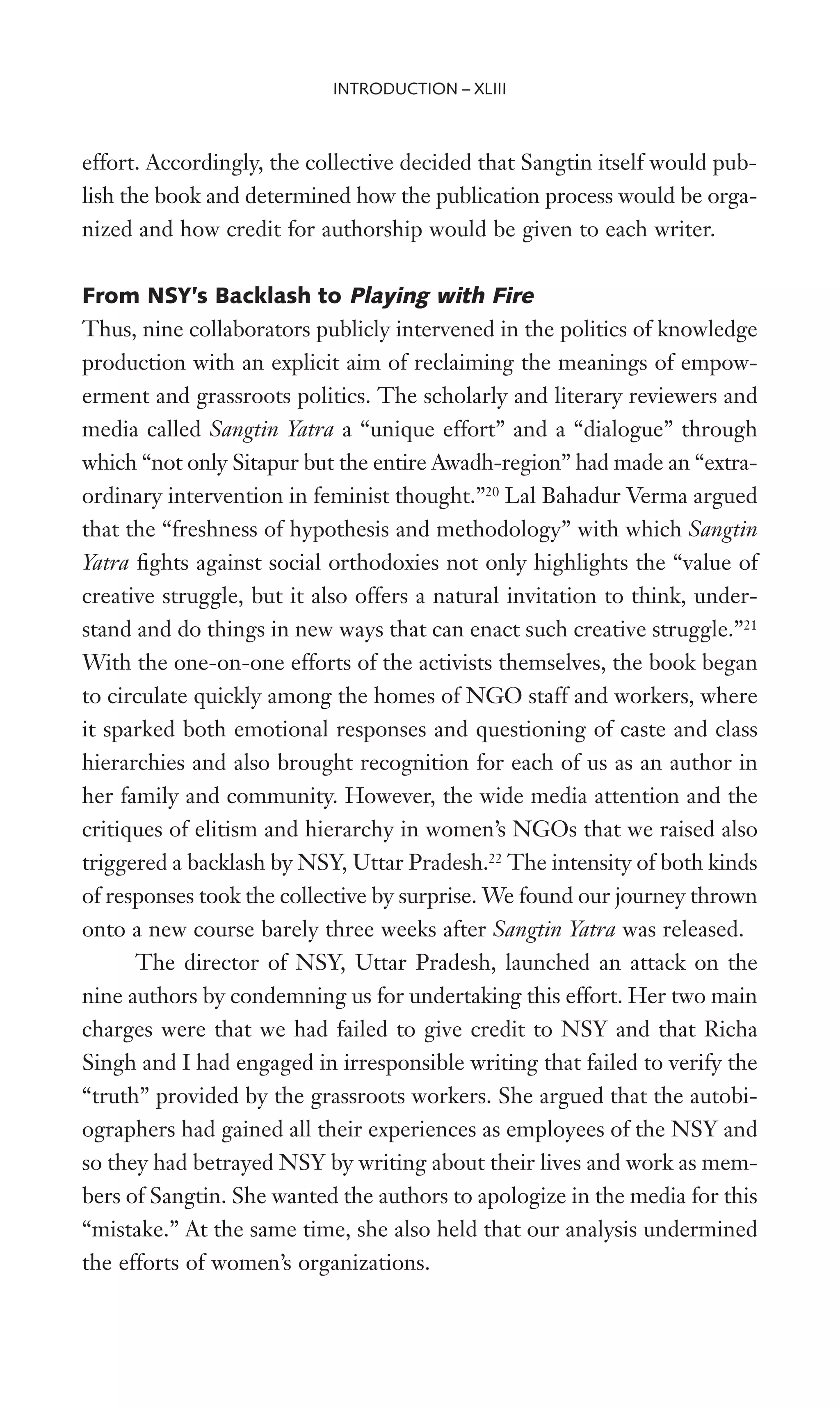
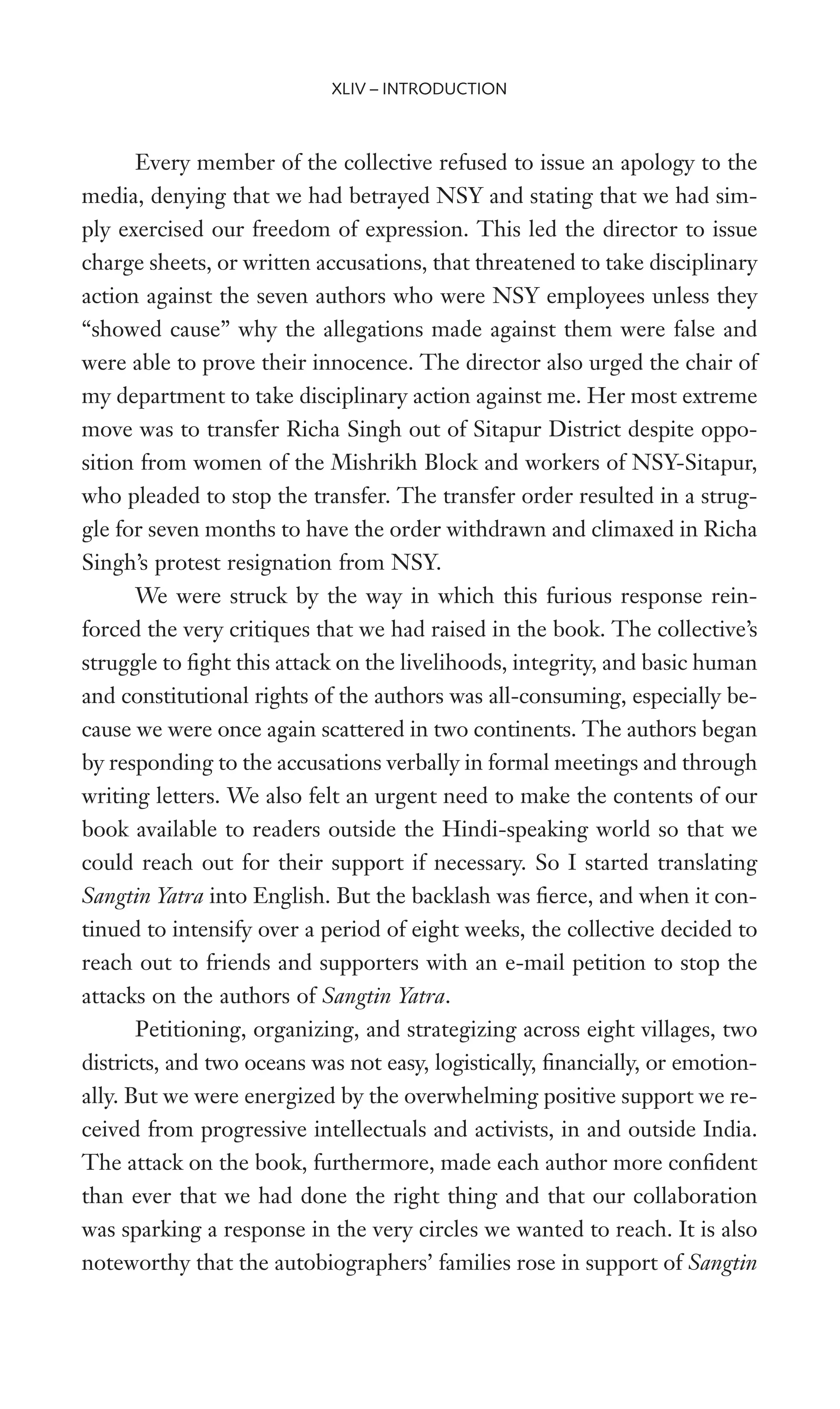
![Yatra. When one prominent “feminist” NGO trainer accused the collec-
tive of stripping the autobiographers naked before the public, we were
pained by the deep contradiction buried in her accusation. We asked why
the autobiographers had always been encouraged to interrogate patriarchy
by revealing in organizational meetings their personal stories and intimate
experiences but then the same stories amounted to stripping oneself naked
when they chose to break the silences on the politics of NGO work. When
these discussions reached the homes of the authors, it was the so-called
patriarchal husbands and families of the autobiographers who declared:
“Don’t even think of apologizing or explaining anything to your employ-
ers. If they make more accusations, we will answer them.”
It was this kind of broad public support gained by Sangtin Yatra that
led Richa Singh to resign from NSY with an open protest against the
actions of the director of NSY, Uttar Pradesh, and how those actions
mocked the very idea of empowerment. In her ofWcial notice of resigna-
tion, Richa Singh wrote:
After the publication of Sangtin Yatra by Sangtin, you subjected me to a
punitive action by transferring me out of Sitapur. . . . Sangtin Yatra seeks
to advance feminist thought, but you labeled our collective writing as a
gruesome criminal act . . . , and repeatedly tortured me for supporting this
work. . . . [Your] decisions . . . have clearly shown me how even in a pro-
gram such as [NSY] that works to empower women, a worker can be sub-
jected to social, economic and mental torture if her voice is different from
the voice of the higher ofWcials. . . . This is not empowerment, but a vulgar
joke in the name of rural women’s empowerment. . . . [It was in NSY] where
I learned to Wght for my rights and entitlements, and where I was given
the role of teaching others how to Wght the same battle; in that same [NSY],
I . . . cannot live in this relationship of servitude. In opposition . . . to the
decisions you have taken in regard to Sangtin Yatra, I submit this notice
[of resignation].23
Despite the strain and difWculties posed by it, NSY’s backlash has
been helpful for our future work. We never expected Sangtin Yatra to
INTRODUCTION – XLV](https://image.slidesharecdn.com/playing-20with-20fire-20book-140402052849-phpapp01/75/Playing-with-fire-book-46-2048.jpg)
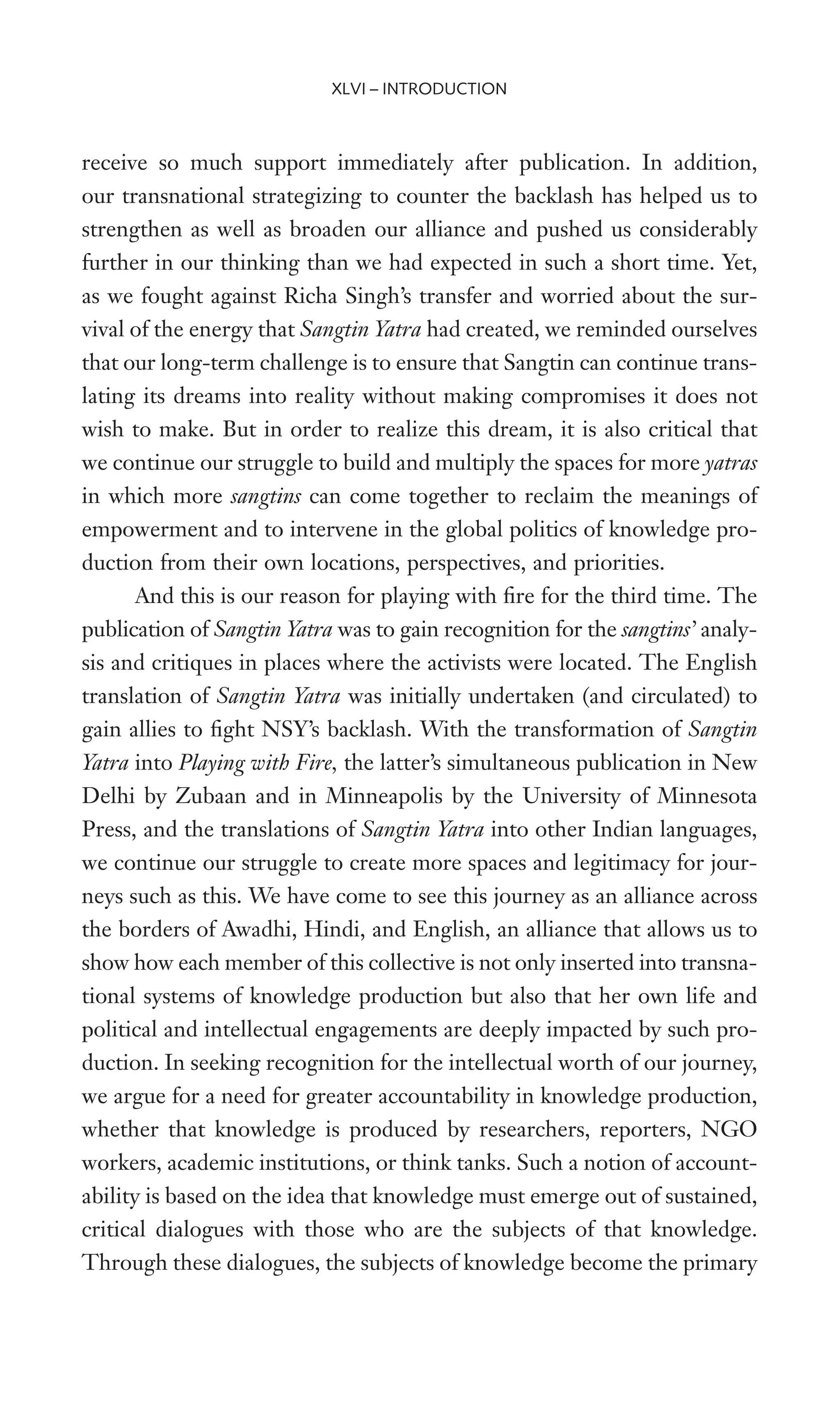
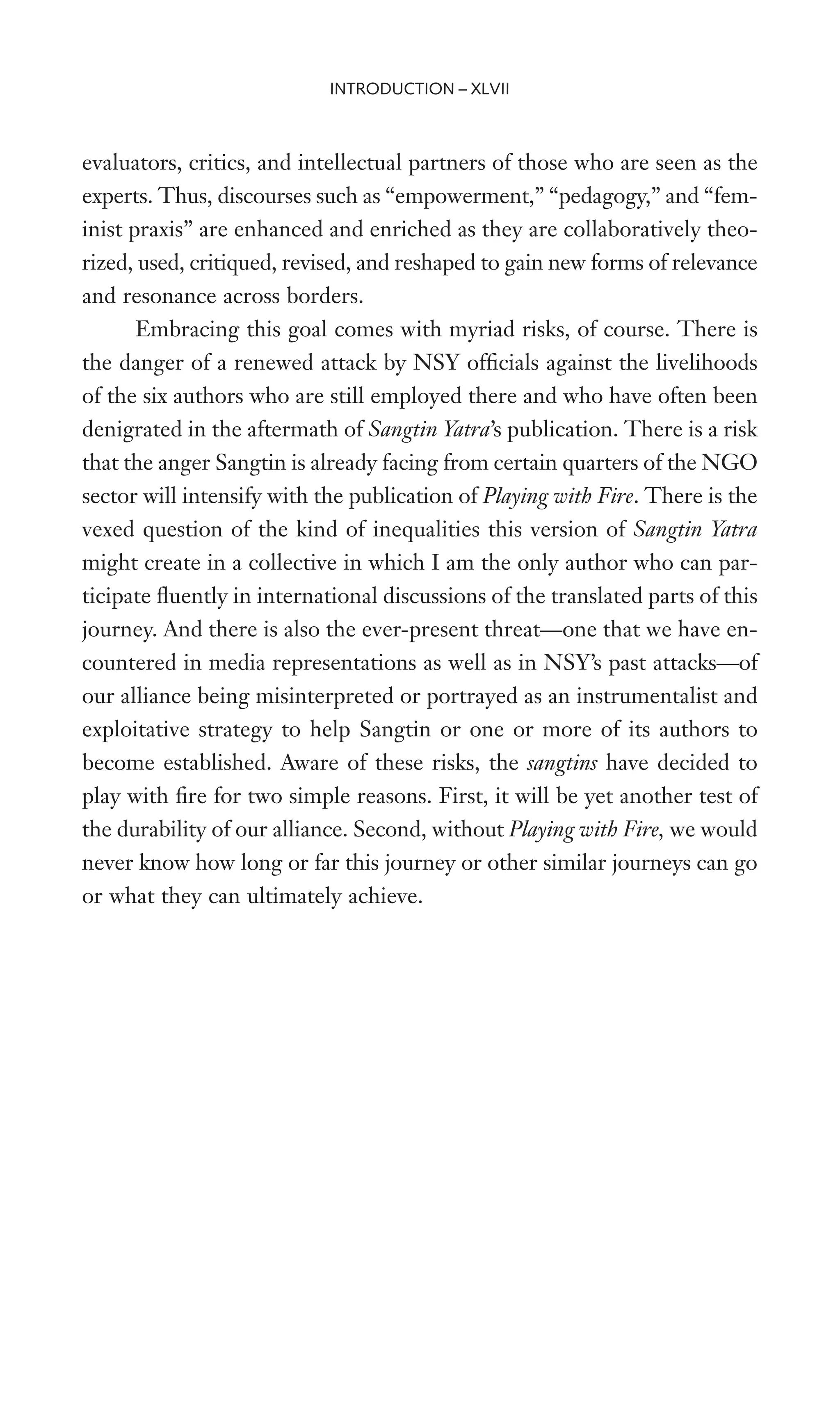

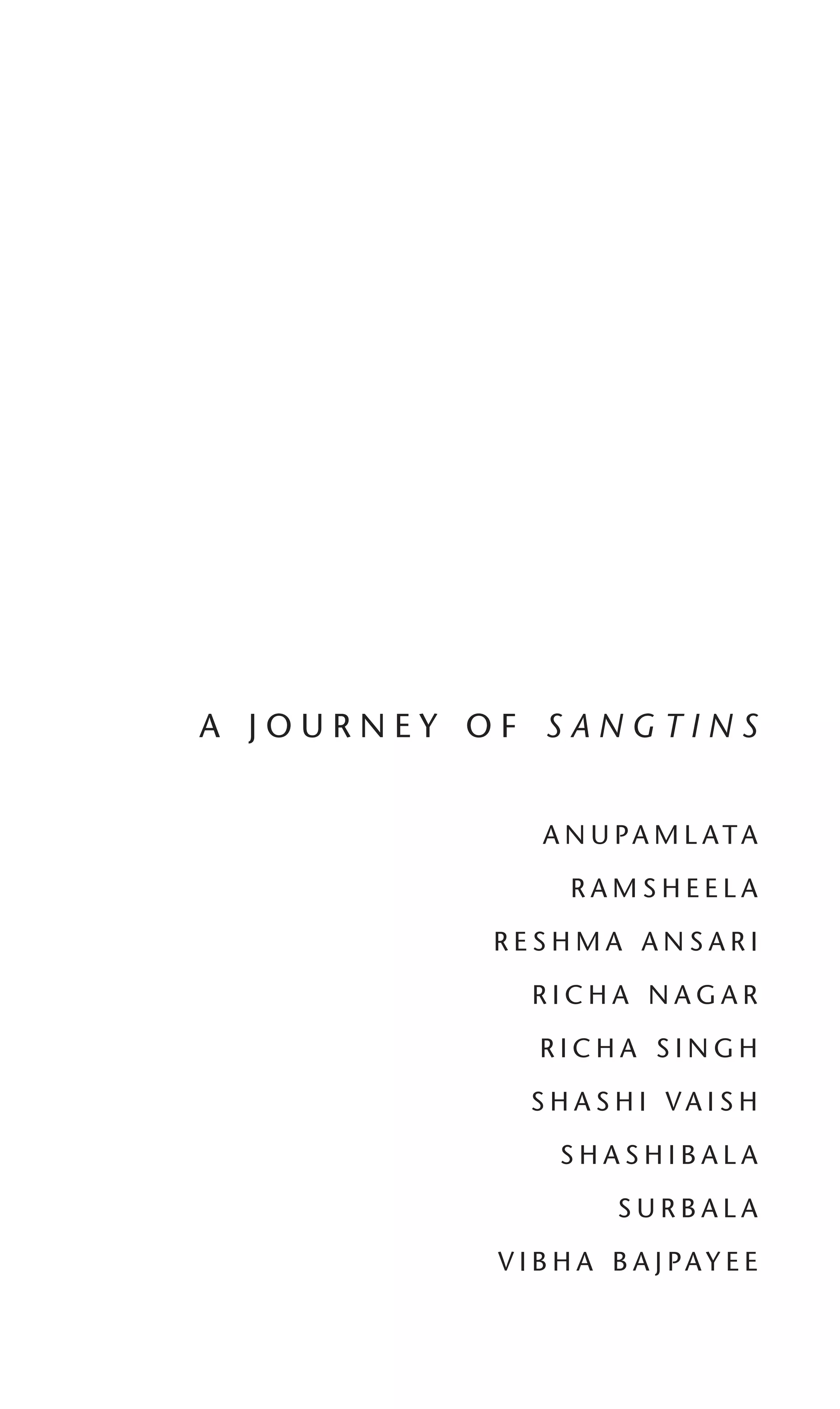

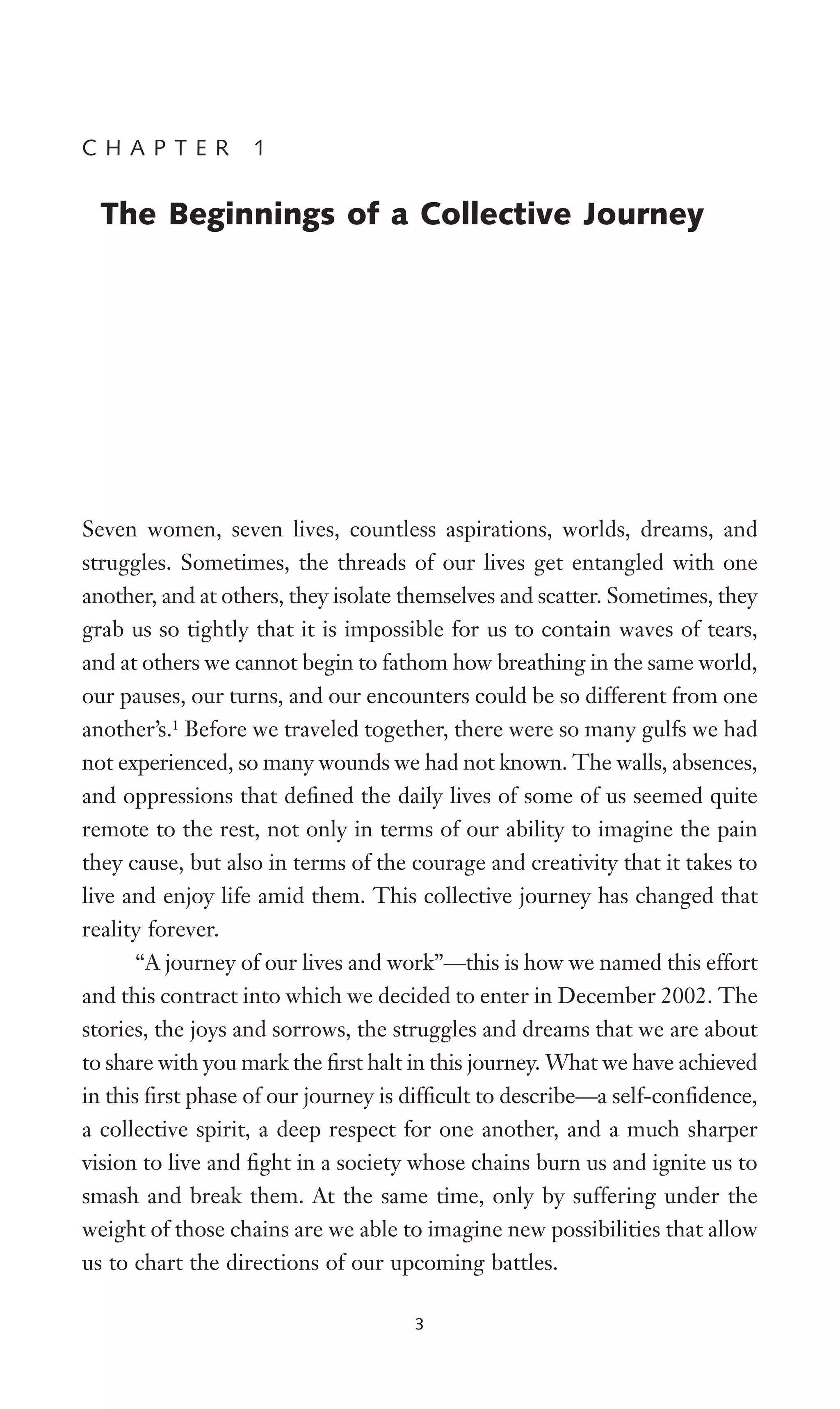
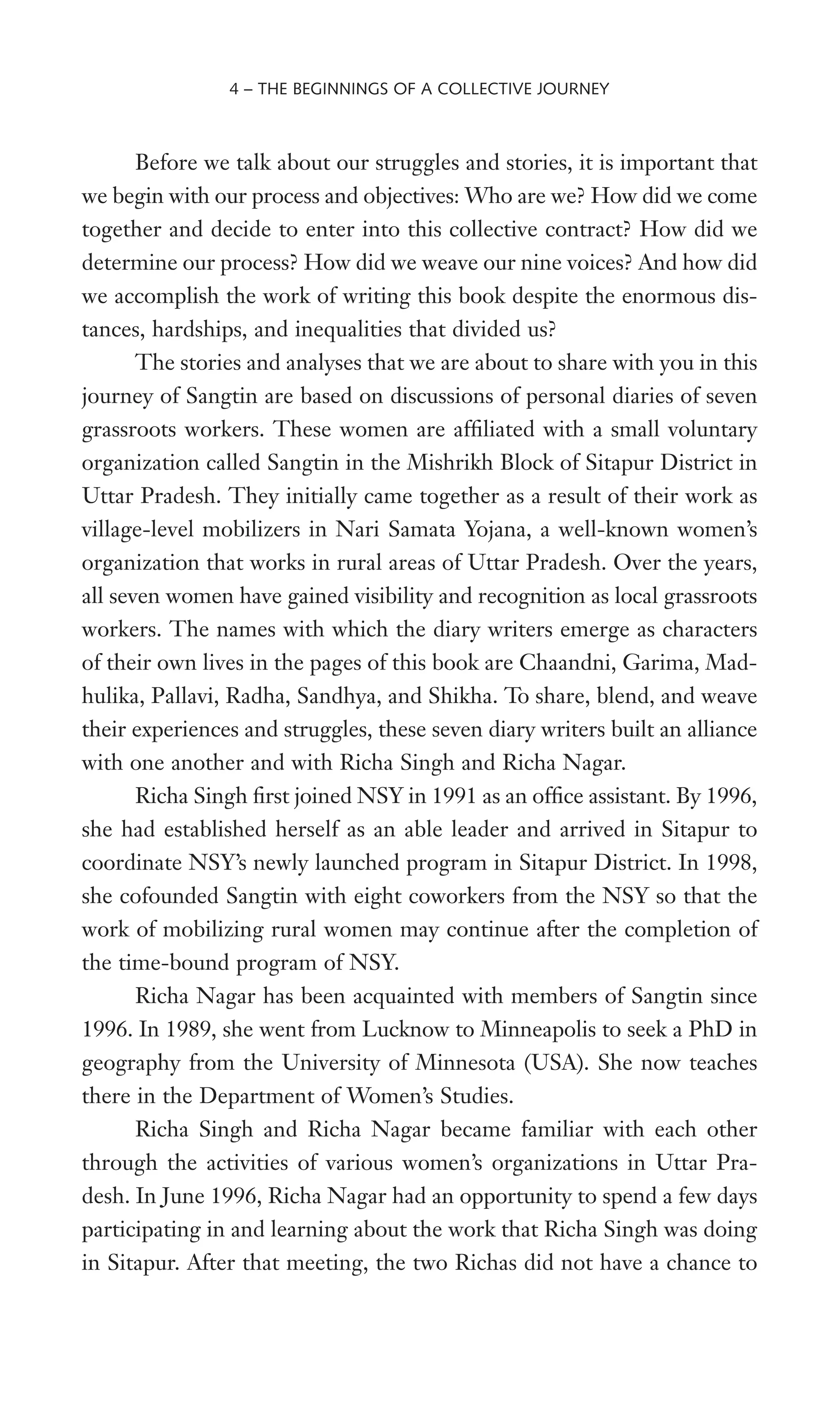

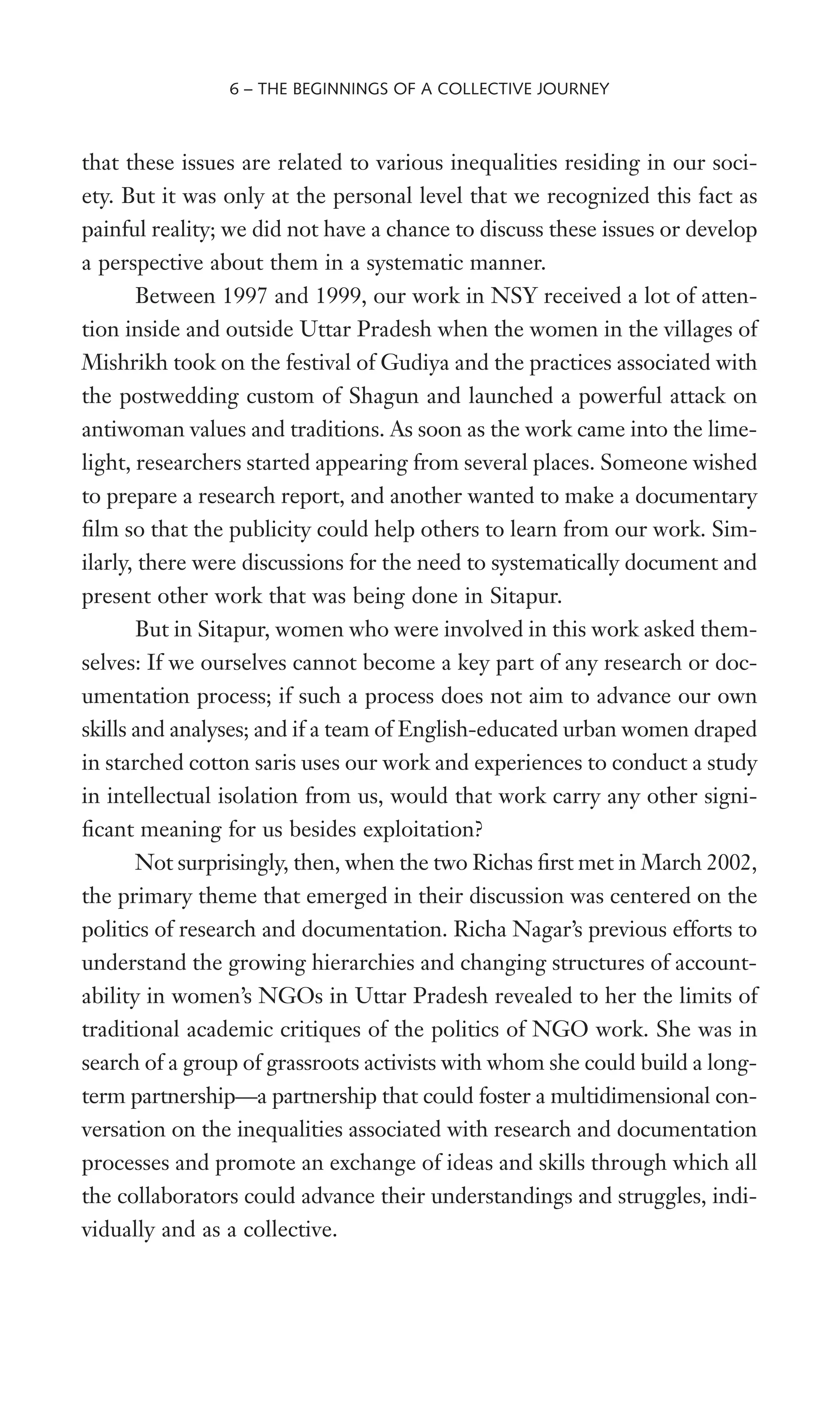
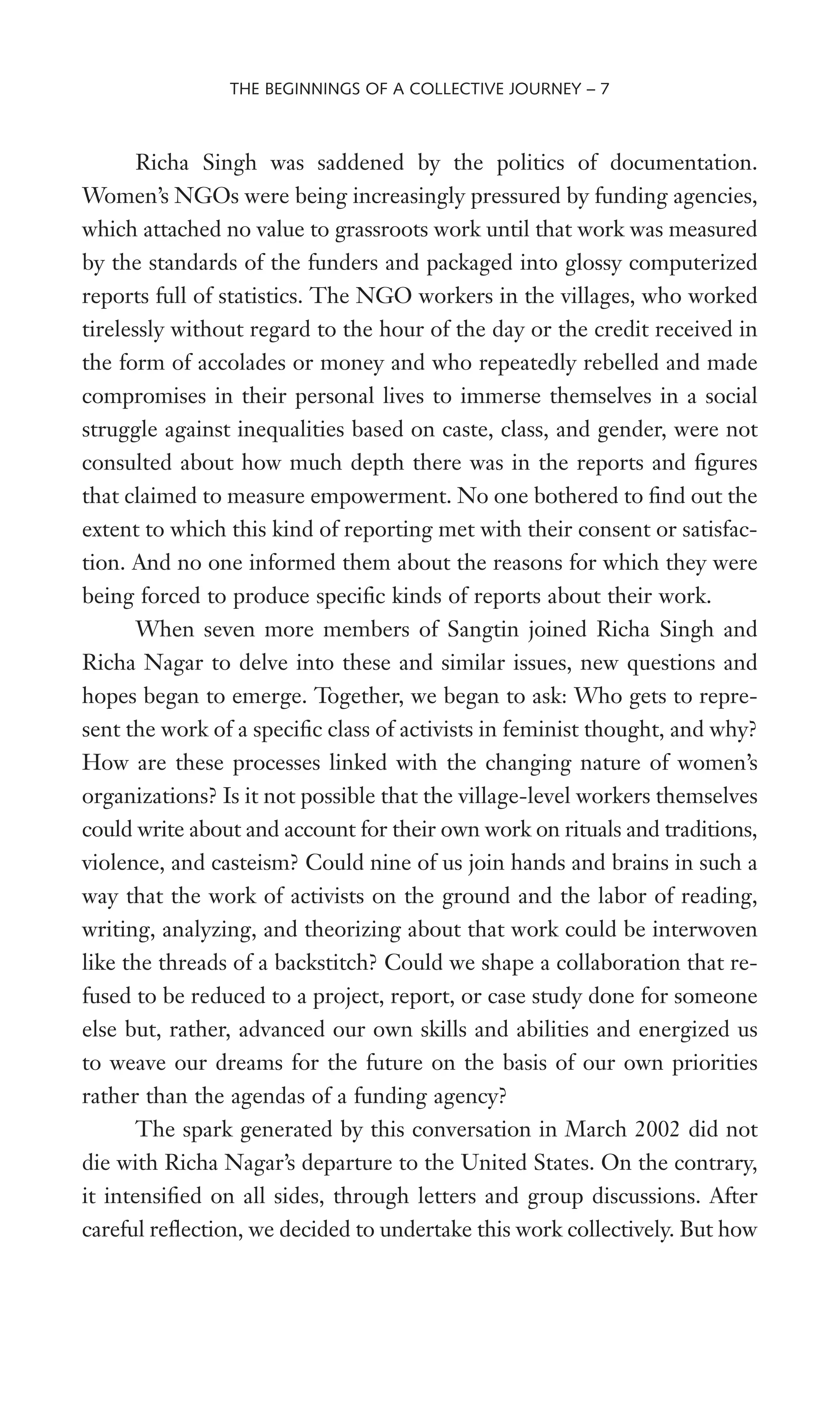

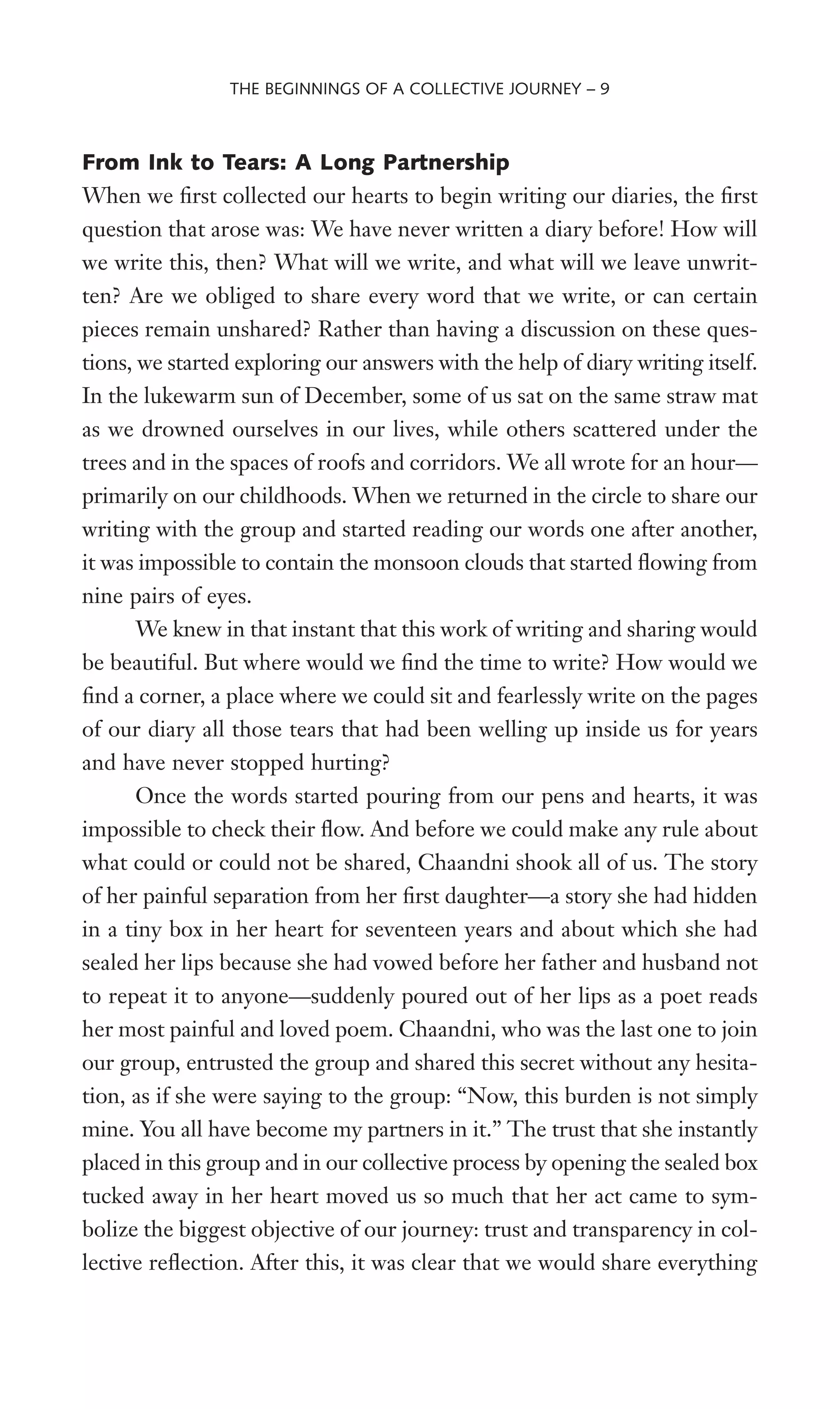
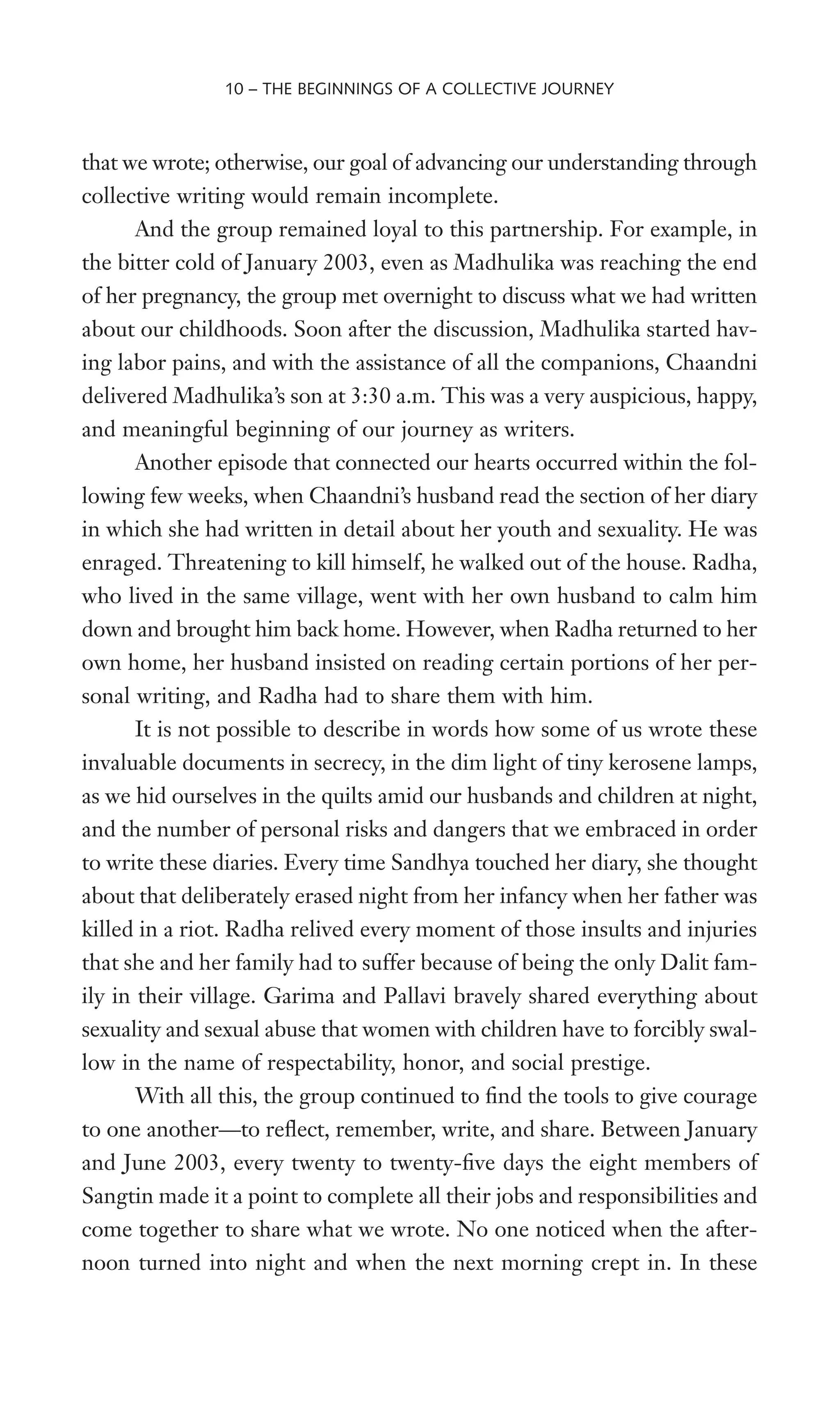
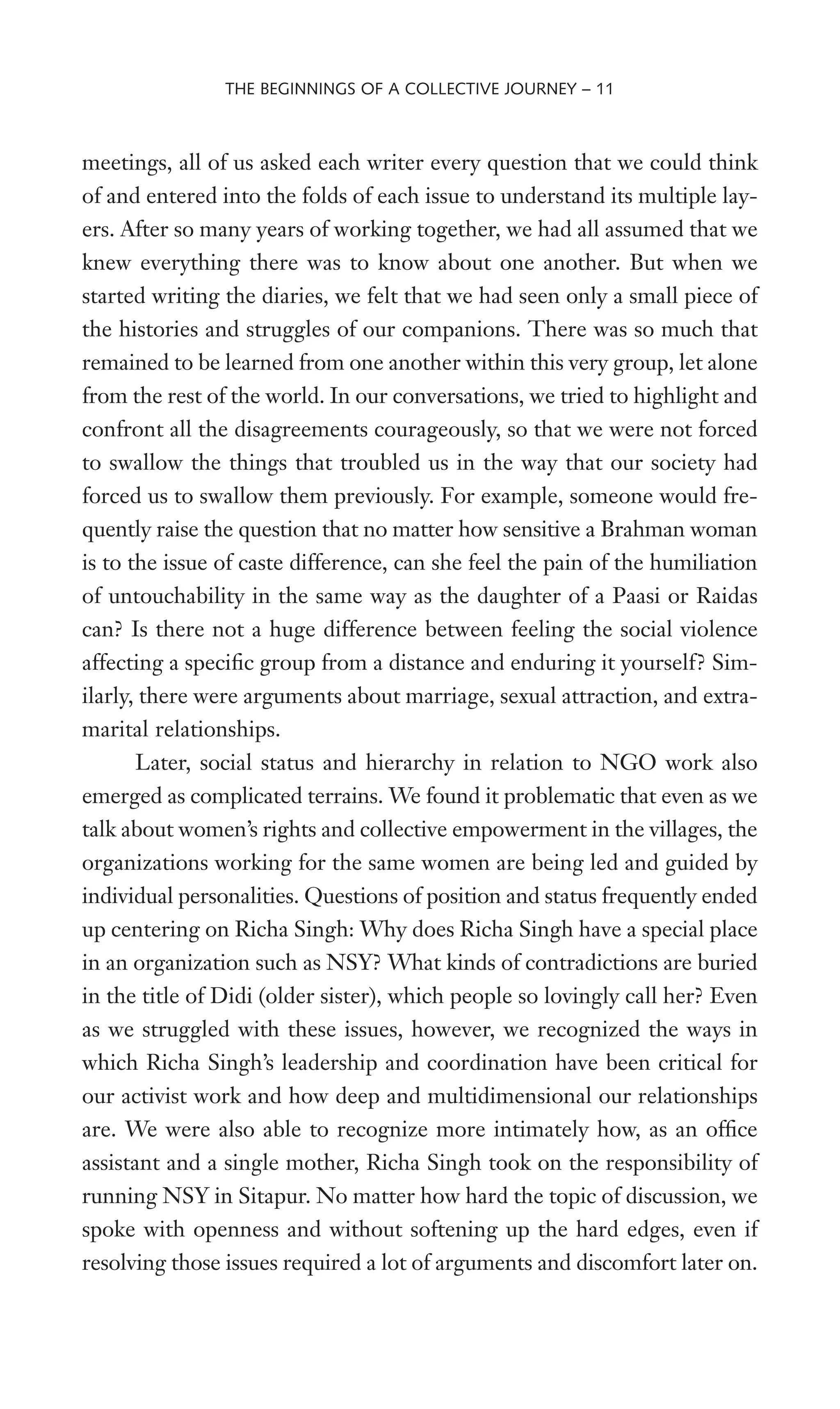
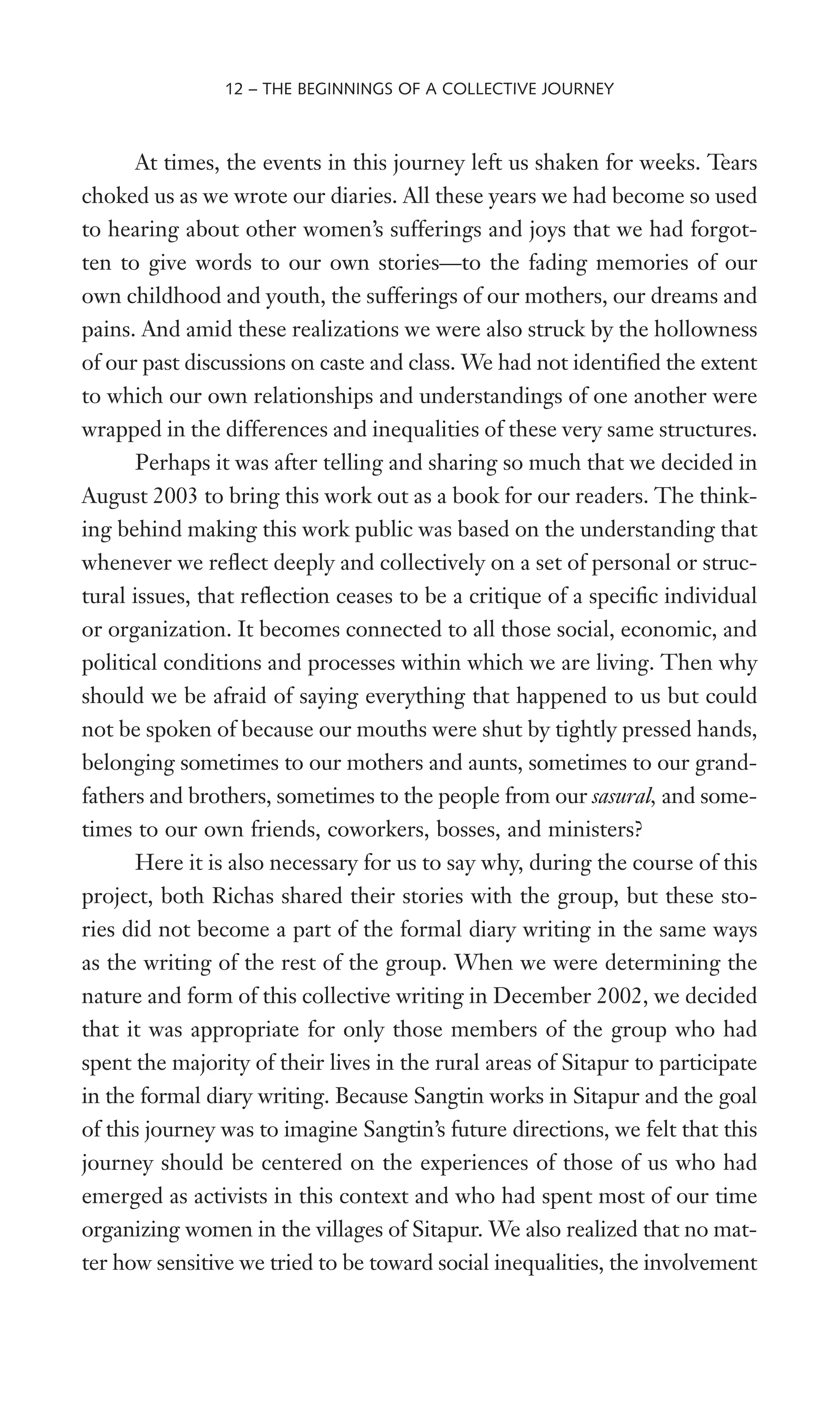
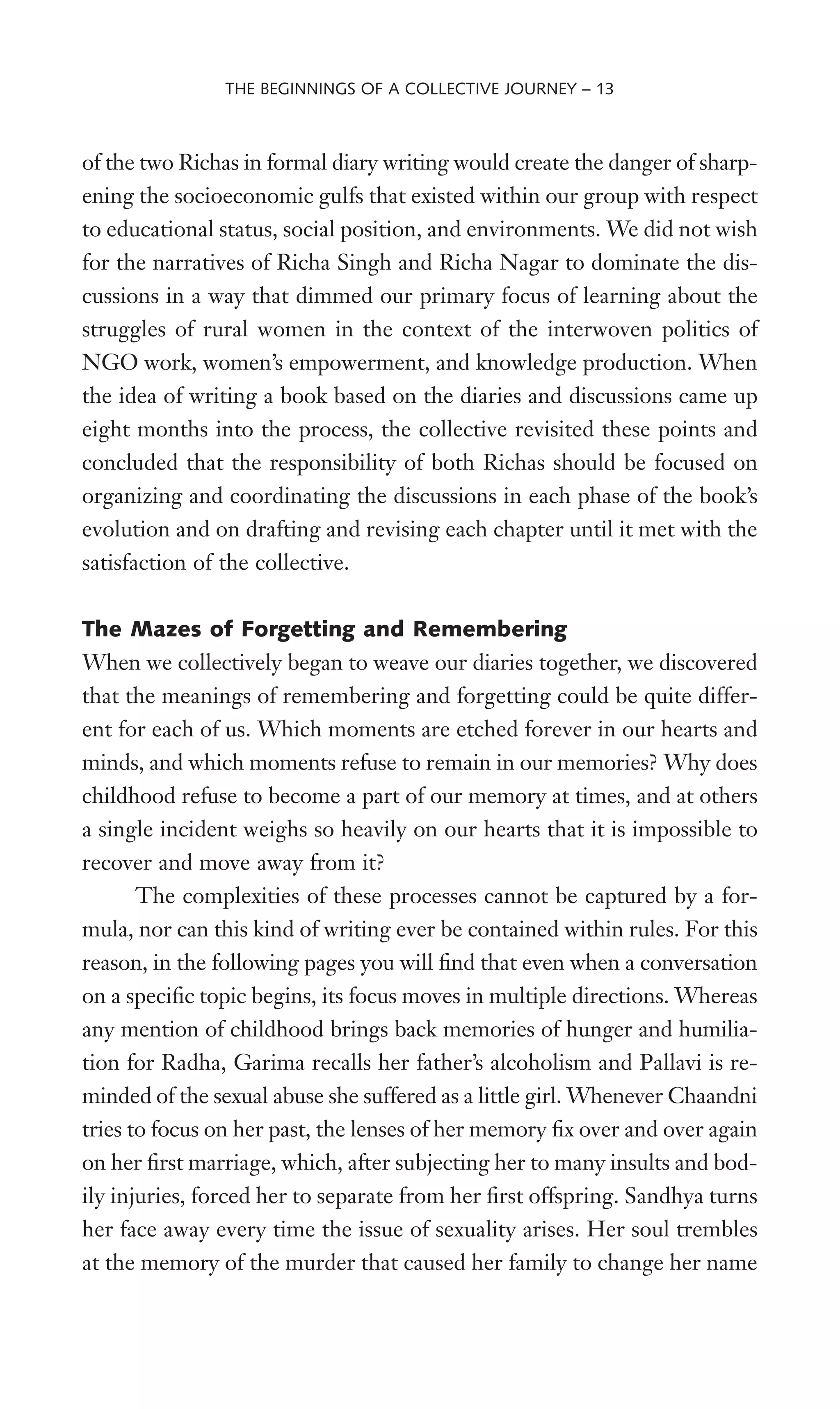

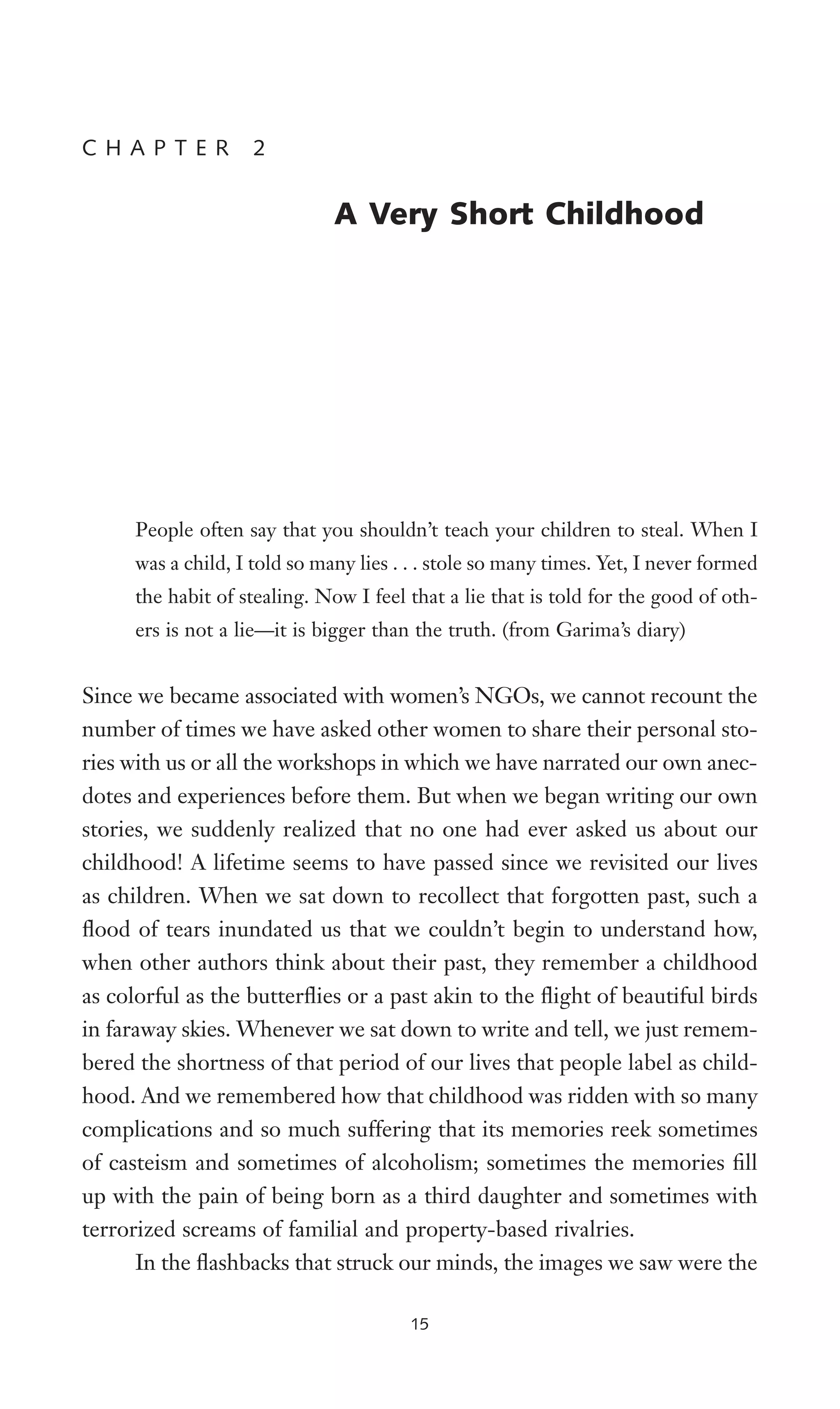
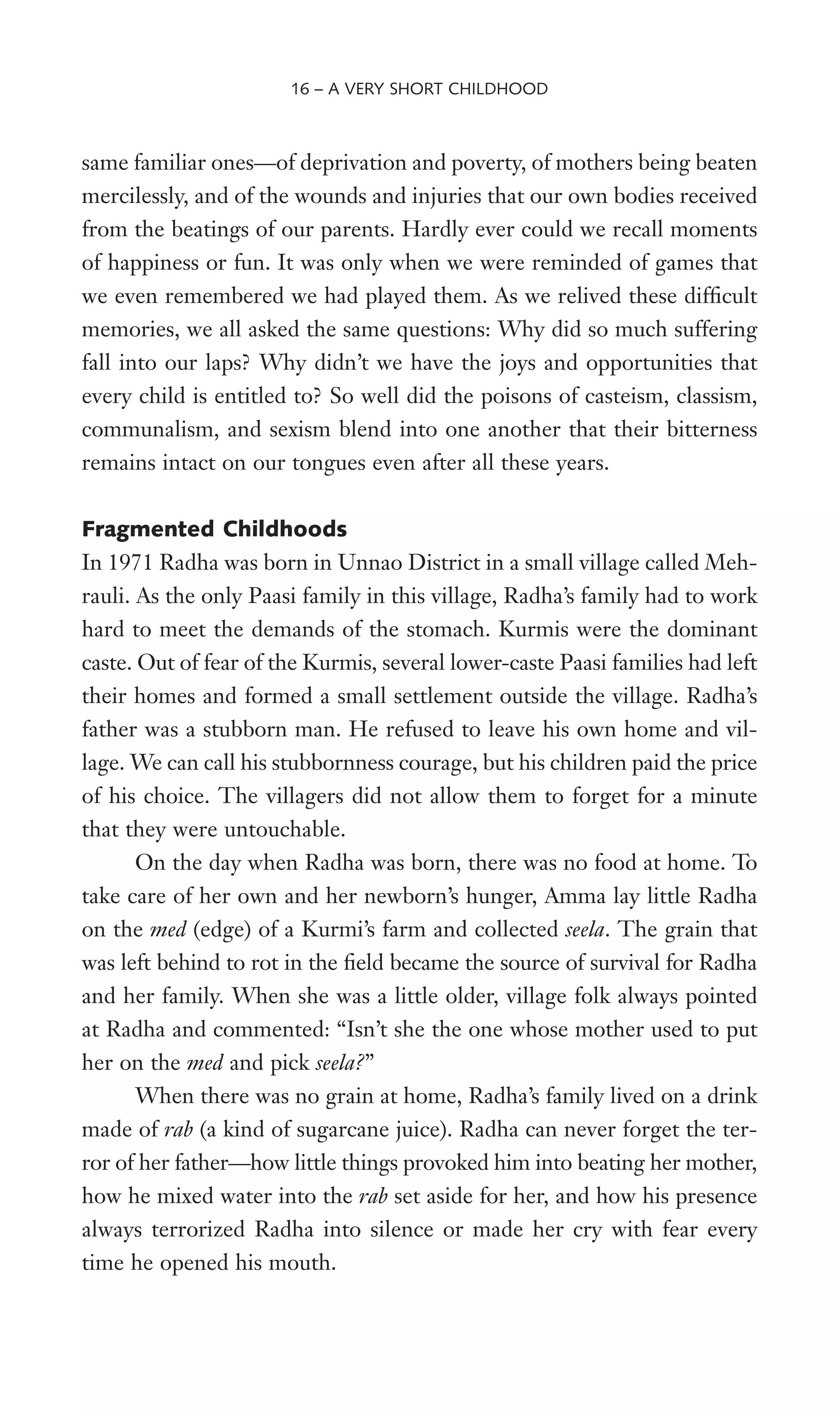
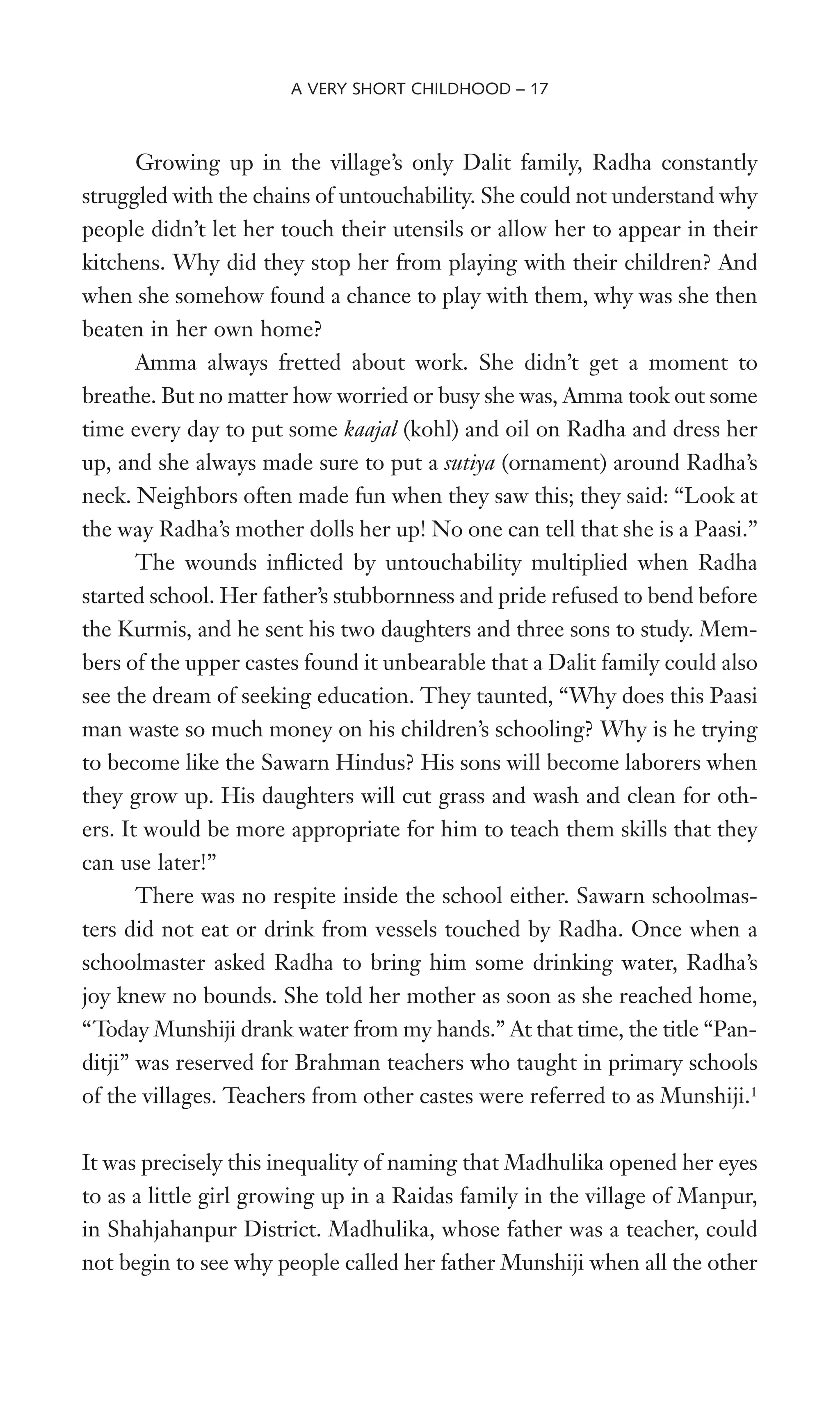

![life in the form of a painful humiliation, it mostly remained a hollow word
for Madhulika. She heard about the politics of “high born” and “low
born,” but the painful manner in which values associated with high and
low are stuffed inside every pore of a Dalit family remained largely unfa-
miliar to Madhulika.
When we weave the strands of Sandhya’s and Garima’s lives into the same
thread, we realize how deep and complicated this web of caste system is,
as well as the process of internalizing it from the innocence of early child-
hood—sometimes in the name of purity and at others in the name of self-
restraint, fasts, and religious rituals.
“So much was there and everything vanished.” This is the grief
that repeatedly haunts Sandhya’s heart. Sandhya was born in 1968 in the
Brahman-dominated village of Sujanpur in Unnao District. The day of
her birth was the last day of the Navratri festival, and a havan was taking
place to mark the auspicious occasion. The birth of a girl ruined the
ceremony for some. “She has made the home impure.” When Baba
(Sandhya’s paternal grandfather) tried to stop the havan with this decla-
ration, her father, who was a doctor in a government hospital, opposed.
He said, “This is a happy occasion. The havan must go on.”
This daughter who had come after Wve sons was named Abha by her
father—the abha, or radiance, of her Wve brothers! And the old grandma
from the neighborhood lovingly called her Pachcho! But within six months,
Abha’s father was killed by people from his own village during a riot.
After her father’s murder, Baba announced: “Now there is only
darkness. She can no longer be called Abha. Her name will be Sandhya
[evening].”
Encapsulated in her new name, the grief over her father’s loss be-
came a raw wound for Sandhya. Baba always regarded Sandhya as the
cause of his son’s death. Raised on the fear and hatred of her father’s killers
within the four walls of her home, Sandhya’s growing up largely went
unnoticed by her extended family.
Educating Wve sons and a daughter was a massive challenge for
Sandhya’s mother. Surrounded by economic hardships and burdened by
A VERY SHORT CHILDHOOD – 19](https://image.slidesharecdn.com/playing-20with-20fire-20book-140402052849-phpapp01/75/Playing-with-fire-book-68-2048.jpg)
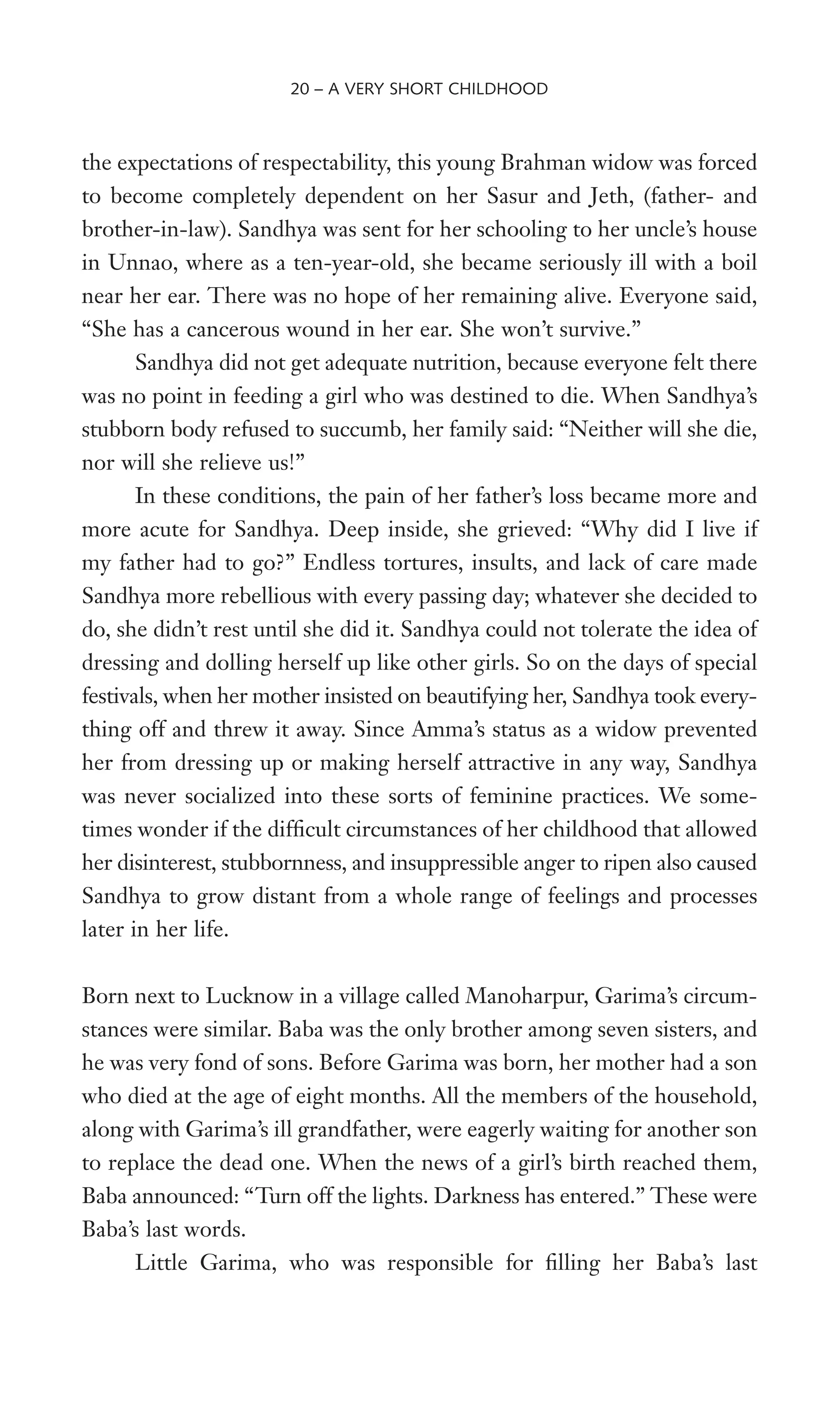
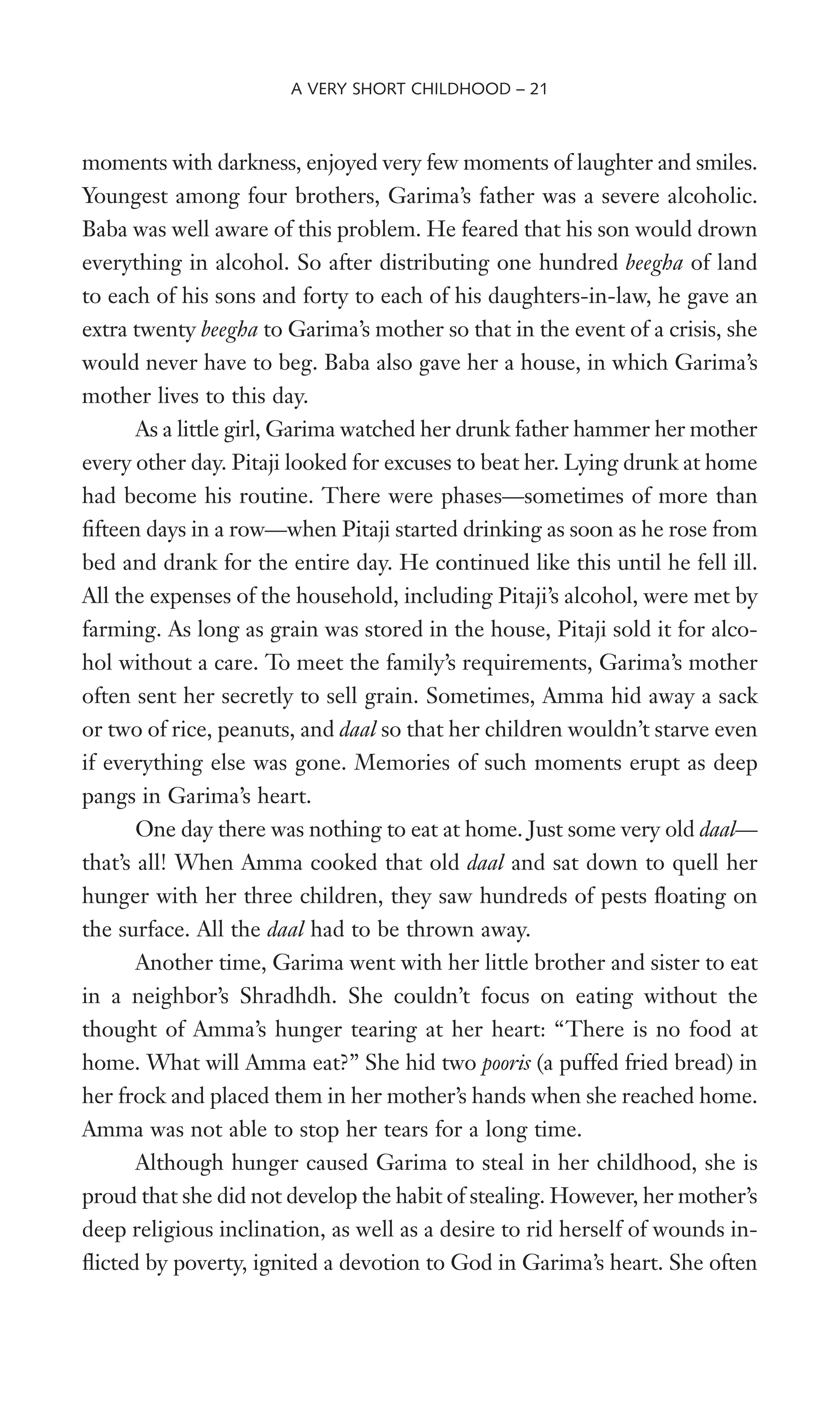
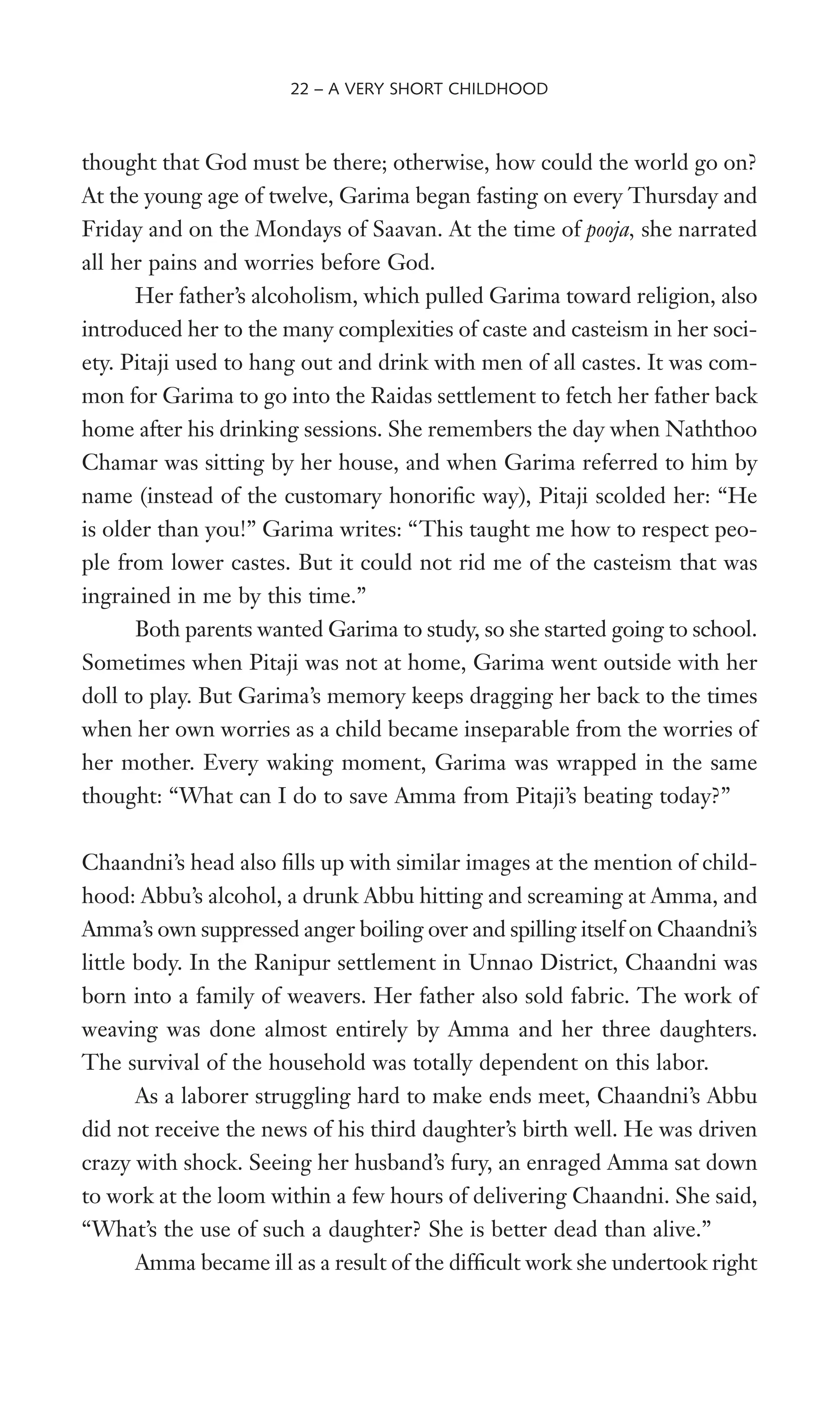
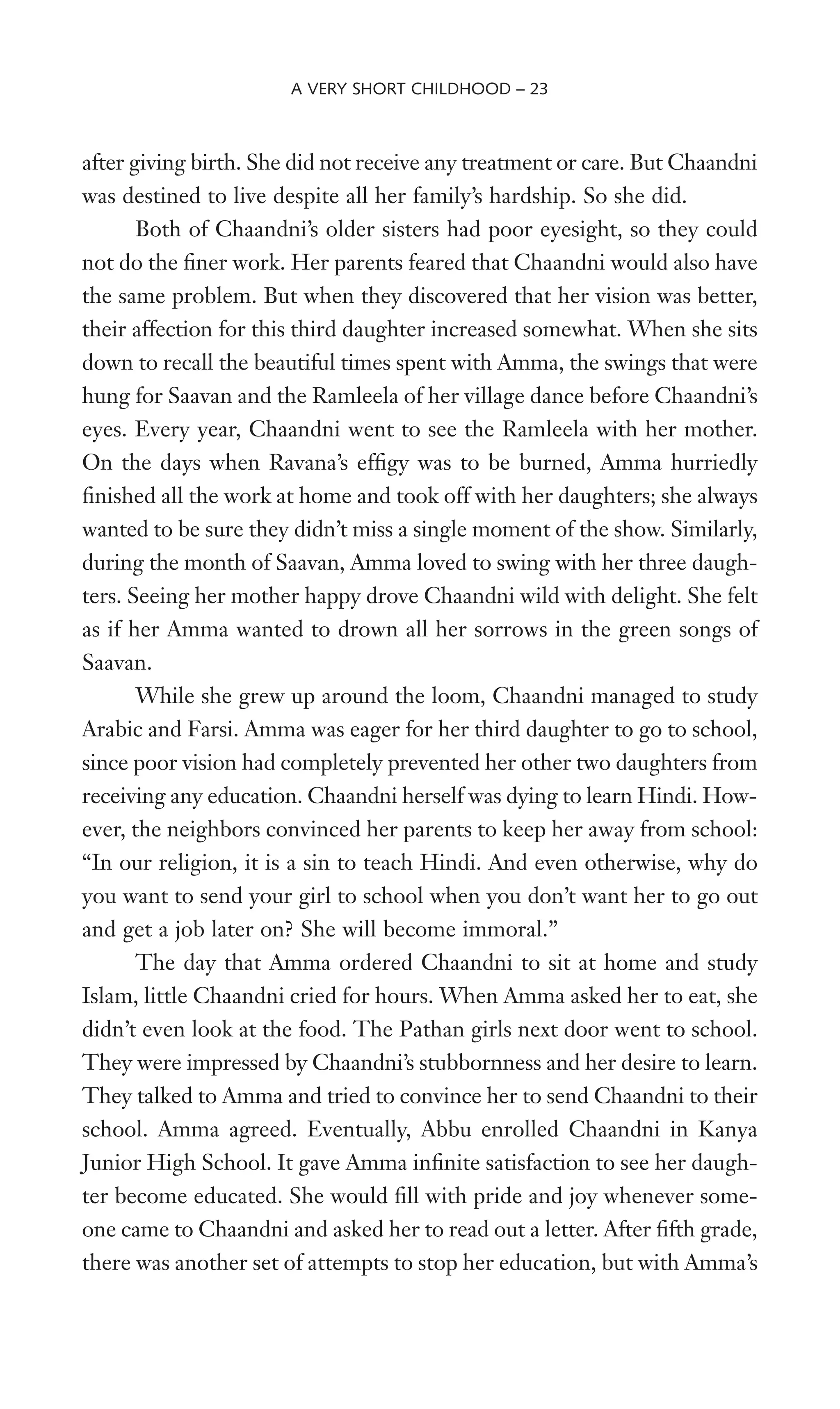
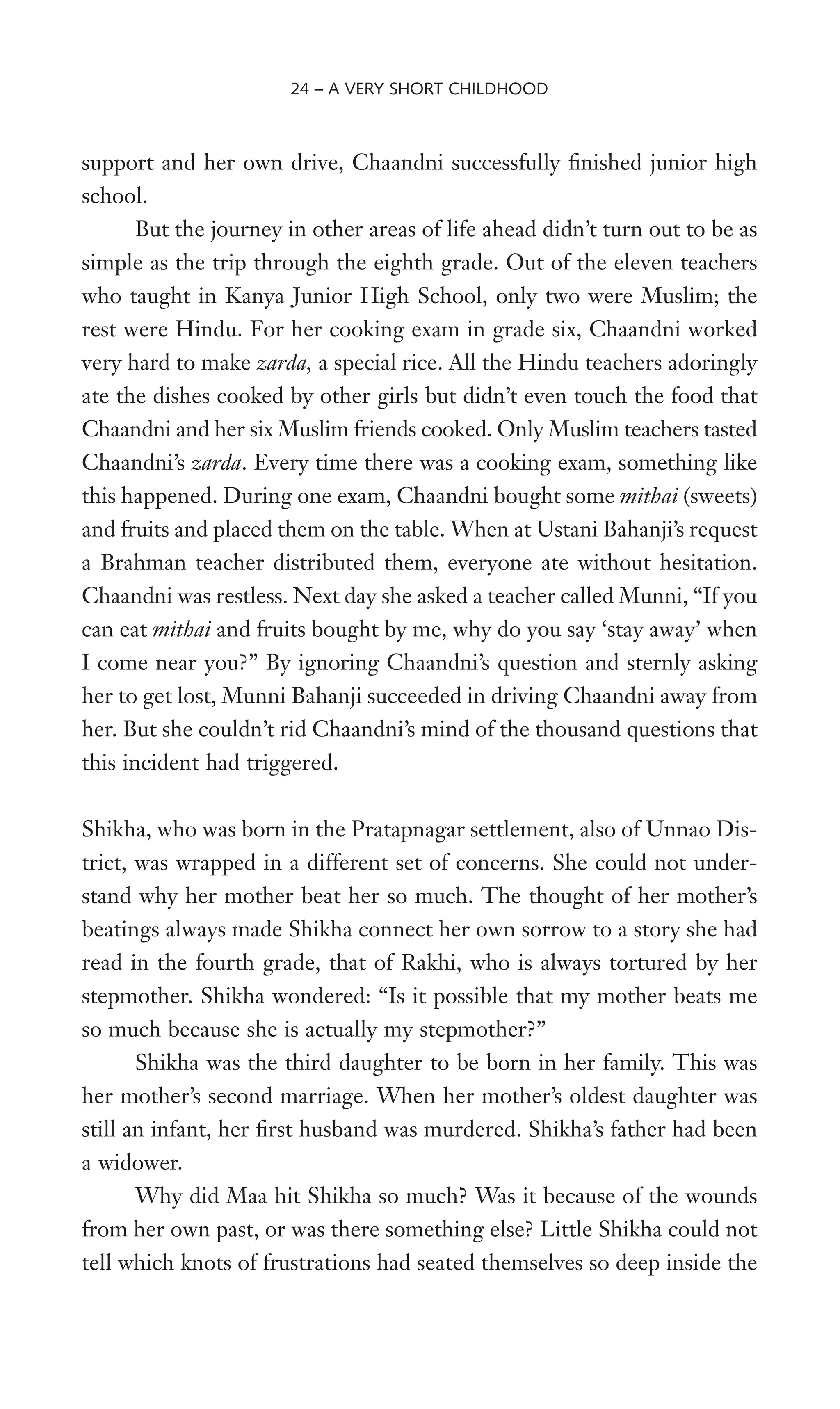
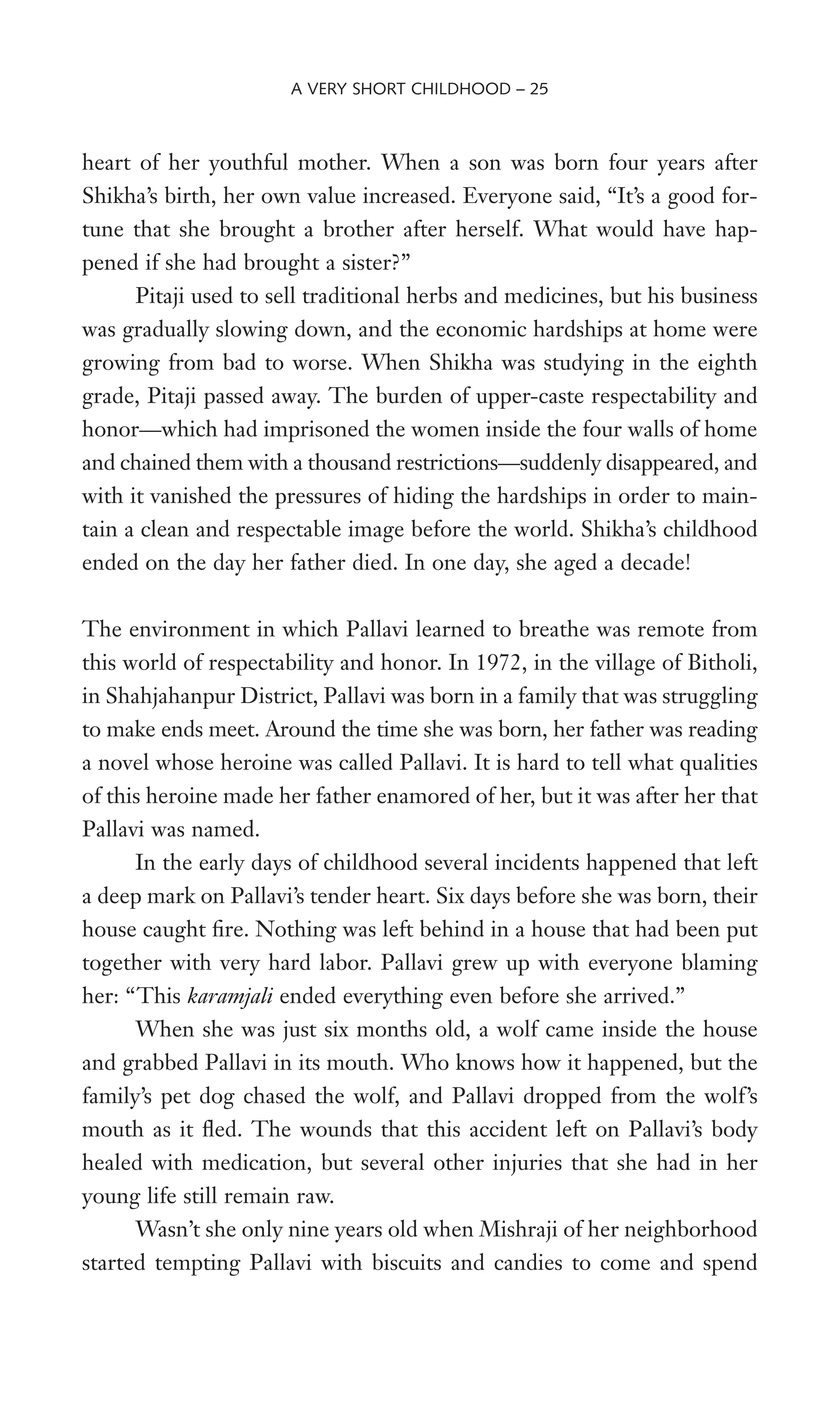
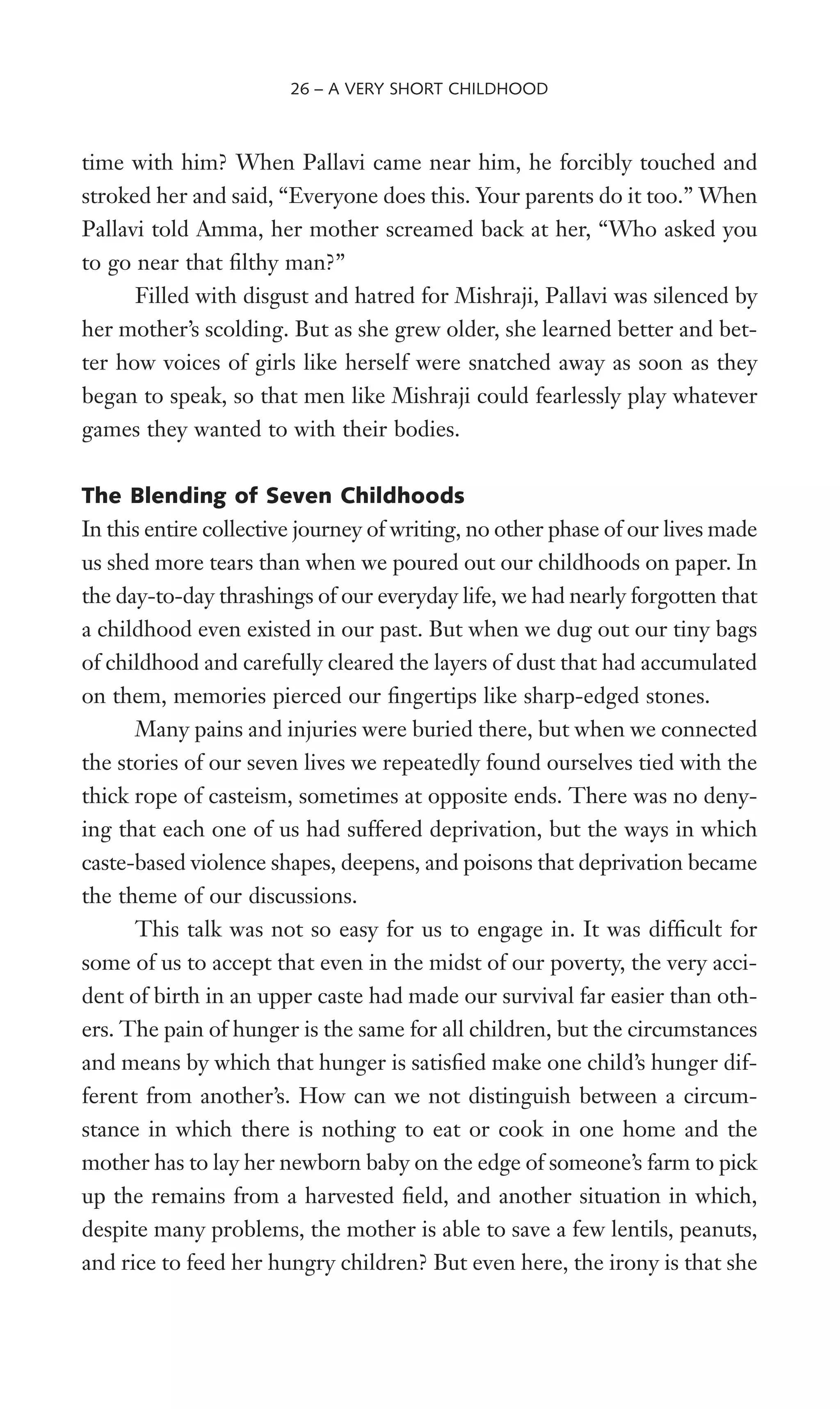
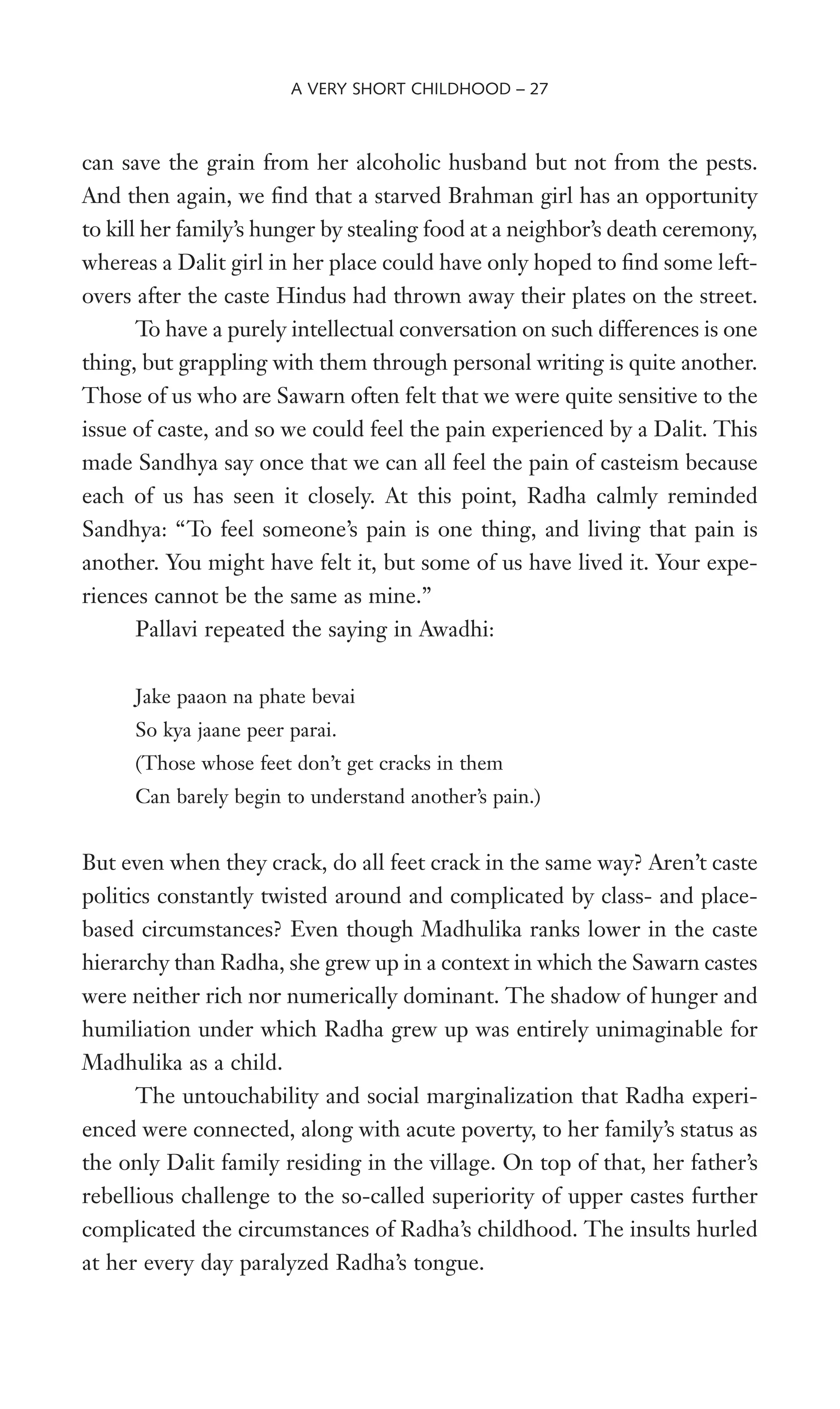
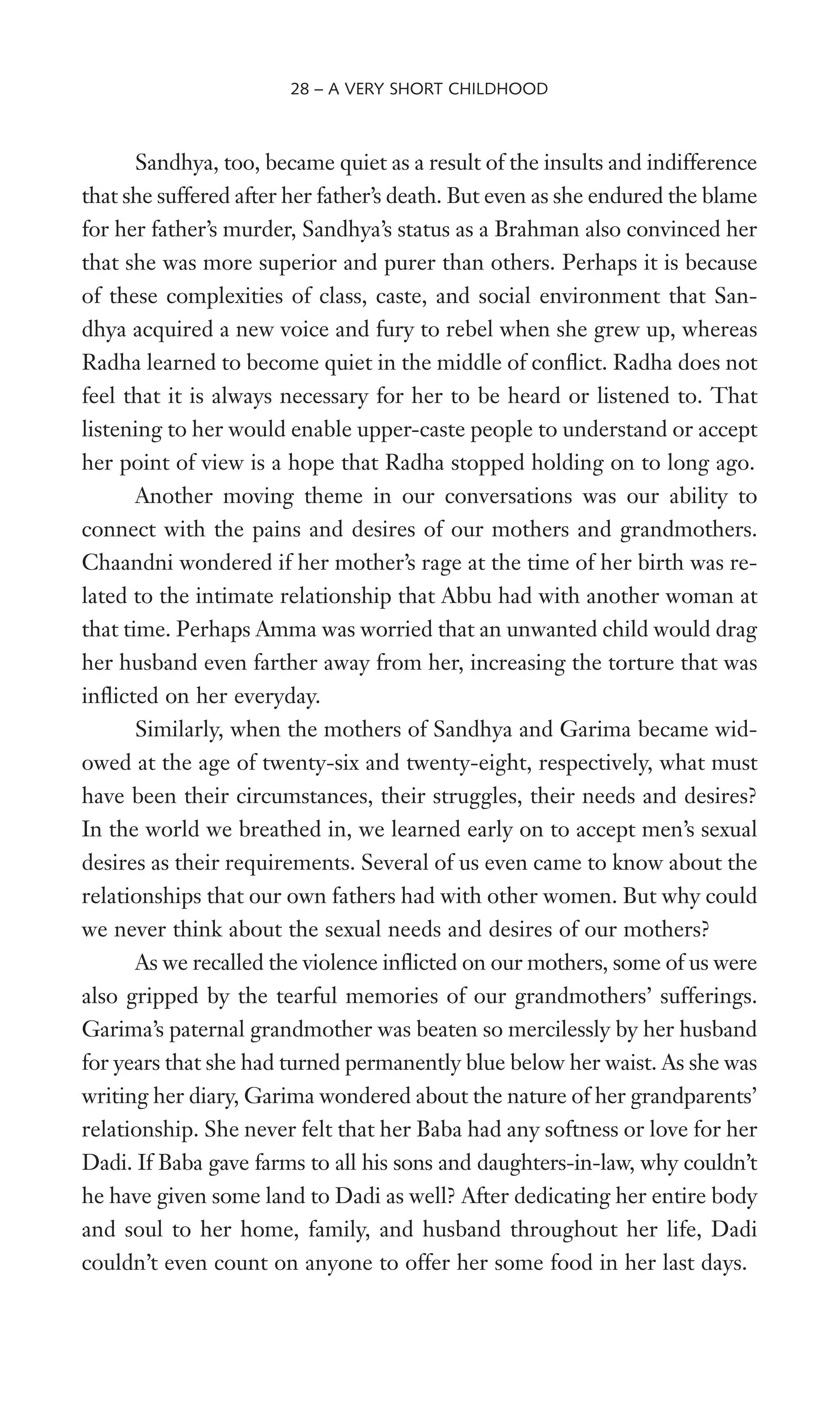
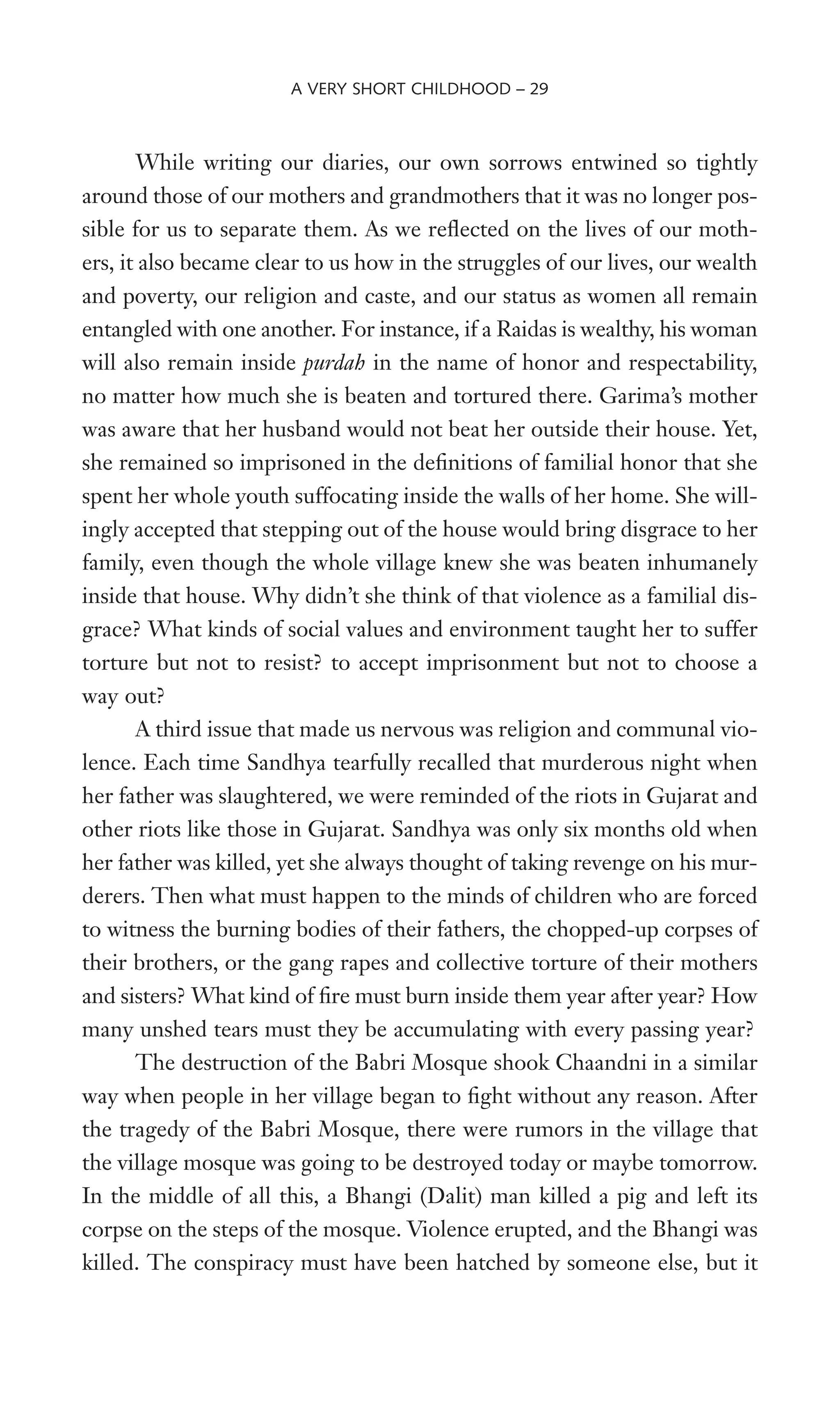

![I was nice and plump to look at. I used to think that if I were a boy, I would
have found myself a job. My dream was to have a [salaried] job. Two of my
sisters had been married off. They were tormented in their sasurals—they
wouldn’t get a piece of clothing even in three, four years. I often wondered
that my father was a schoolmaster; then why did he marry off his daughters
like this? I just prayed that whomever I got to marry would have a regular
job and lots of money. I dreamed of living with my husband in the city. I
didn’t want to live like my sisters . . . and I never wanted to visit my mayaka
without my husband beside me. (from Madhulika’s diary)
Ever since our work has connected us to women’s lives, it has almost be-
come a daily routine for us to confront incidents of domestic and social
violence. From the time we Wrst become aware of our youth until all our
hair turns gray, it seems that all poor women go through the same kind
of pain. First, we all become burdens in our mayakas (natal homes); then,
we suffer humiliations in our sasurals, get beaten, stay hungry; and our
bodies become someone else’s property. So thoroughly do we get wrapped
in these sorrows that sometimes it is hard for us to turn back and reXect
on the dreams that we once saw and nurtured so keenly, so fervently. It
is true that many of our dreams were never realized or were crushed, but
as we write and share our stories today, we realize that the dreams we see
at each turn of our lives teach us a great deal about possibilities, absences,
struggles, and challenges.
C H A P T E R 3
From the Streets of Babul to the
Wetness of Aanchal
31](https://image.slidesharecdn.com/playing-20with-20fire-20book-140402052849-phpapp01/75/Playing-with-fire-book-80-2048.jpg)
![So stealthily did the pains and joys of our childhood turn into pangs
and dreams of adolescence that we were caught unaware. But when we
sat down to remember, we recalled how the changes in our own bodies
Wlled us with the excitement and fear of adventure and discovery. On top
of that were all those desires and dreams that started swelling within us
like waves as we reached adolescence and simply refused to be tamed.
With these came the ever-increasing strictness with which our elders
controlled and monitored us, the never-ending remarks and interference
of the entire world, the teasing by young men, and the suffocation of new
rules and regulations that were imposed on us every day. Madhulika and
Pallavi vividly recall the day when their fathers commented angrily to
their mothers, “Tell her to cover herself with a dupatta [long scarf] when
she moves around!”
Later, a relative threatened Madhulika, “If you don’t learn how to
cook properly, we won’t come to save you even if they kill you in your
sasural.”
Once after cooking the day’s meal, Pallavi left for school and for-
got to insist that her mother should eat. Amma didn’t eat anything for
hours and later admonished Pallavi: “How will you survive in your sasural
if you behave like this? What is your standing, after all? You will be burned
alive if you don’t do better than this.”
The more we liked to doll ourselves up in those days, the more
it made our elders nervous. We couldn’t Wgure out how our very same
Ammas, who fed their own desires by doing us up when we were little,
now ganged up with everyone to prevent us from dressing up and looking
pretty. Pallavi writes: “Amma often bought me bangles when I was small,
but by the time I was ten or twelve her interference started. Whenever
I insisted that I wanted new bangles, Amma and Babu repeated the same
lines: ‘Now you are grown up. Wear new bangles when you go to your
own home [sasural].’”
Perhaps they were both concerned about what people would say if
they saw their adolescent daughter all done up. And who would pay the
price if she became the object of someone’s desire?
Similarly, Radha remembers the day when she Wrst painted her nails.
32 – FROM THE STREETS OF BABUL](https://image.slidesharecdn.com/playing-20with-20fire-20book-140402052849-phpapp01/75/Playing-with-fire-book-81-2048.jpg)
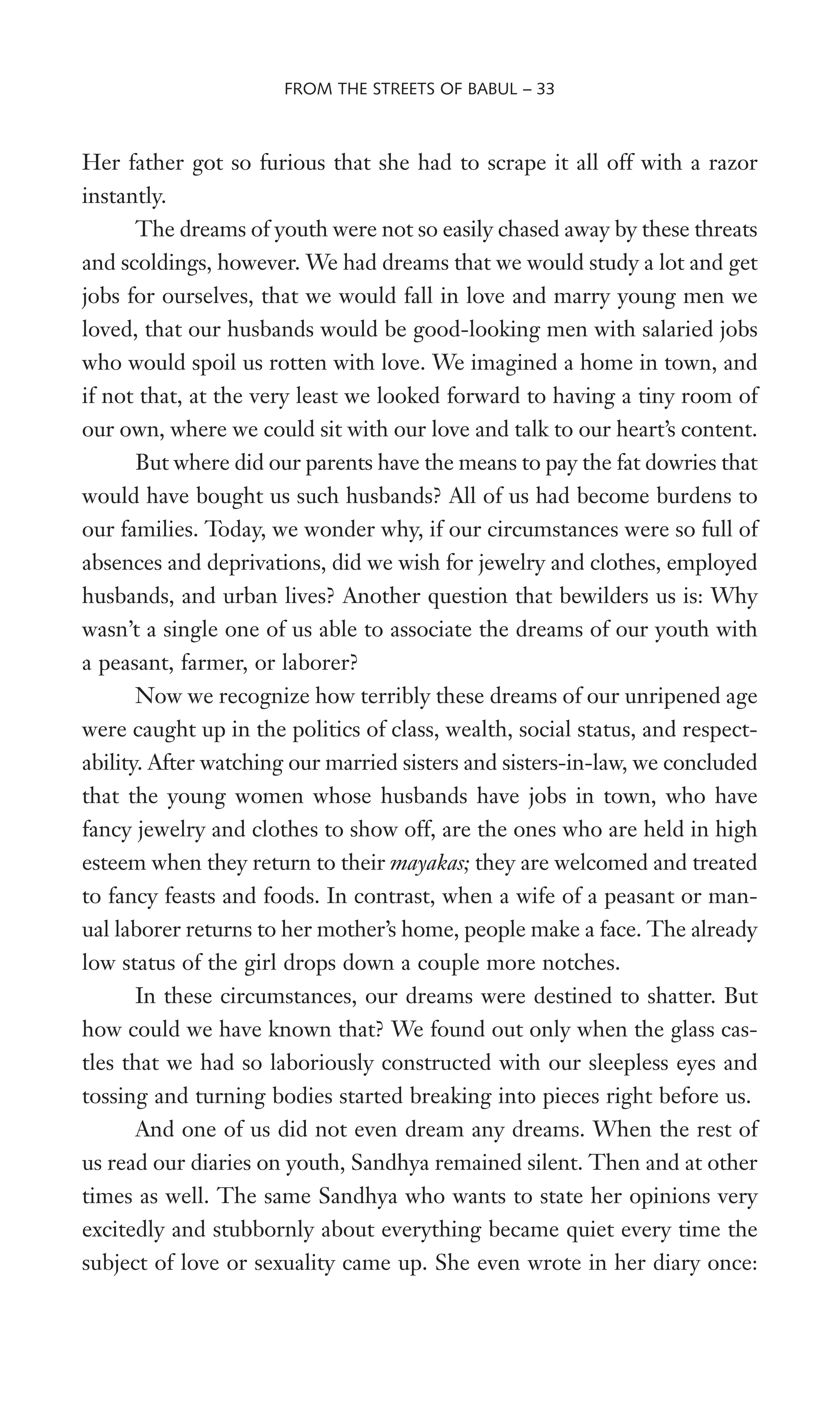
![“I feel suffocated every time there is a conversation on sexuality, intima-
cies between women and men or samlaingikta [same-sex sexuality]. I just
want them to shut their mouths up. . . . My husband also worries why I
am always avoiding these subjects.”
Why did Sandhya turn away from feelings that are often regarded
as natural processes of sexuality by the time she reached adolescence? It
is difWcult for Sandhya to Wgure out whether it was the overwhelming
and all-consuming shock of her father’s murder that was responsible for
this withdrawal or whether it was something else. The thing that she does
know with certainty is that she never dreamed a single dream of love,
romance, or marriage. Whenever the topic of weddings or marriage came
up, she just prayed that no man should ever agree to marry her. She was
convinced that if she could manage not to marry, her brothers would never
have to plead before anyone on her account.
If youth were associated just with our seen and unseen dreams and
the pain of their shattering and breaking, things might have been a bit
easier for us, but our agony was increased by all the horrors that stood
gaping before us at every turn. Every day new fears and panics were cre-
ated for us. Sometimes it was the fear of menstruation, and at others it
was the fear of familial disgrace that would come from not being married
before the onset of menstruation. Sometimes we dreaded looking beauti-
ful, and at others we were frightened of the consequences of falling in love
against social restrictions. Relatives from our caste and clan also missed
no opportunity to explain to us that it is our society’s business to place
countless question marks on the character of women, and the accused
woman has absolutely no right to contradict or interrogate those accu-
sations. With this, the world was also doing a good job of demonstrating
to us that a woman without a husband only gets a place on the margins
of our society, whether her husband has been snatched by death or she
herself has chosen to reject matrimony.
Whenever Madhulika sat down to write about the early days of her youth,
she always remembered how her Wrst consciousness of youth came only
with frights. When at the age of ten, she had to walk two kilometers from
34 – FROM THE STREETS OF BABUL](https://image.slidesharecdn.com/playing-20with-20fire-20book-140402052849-phpapp01/75/Playing-with-fire-book-83-2048.jpg)

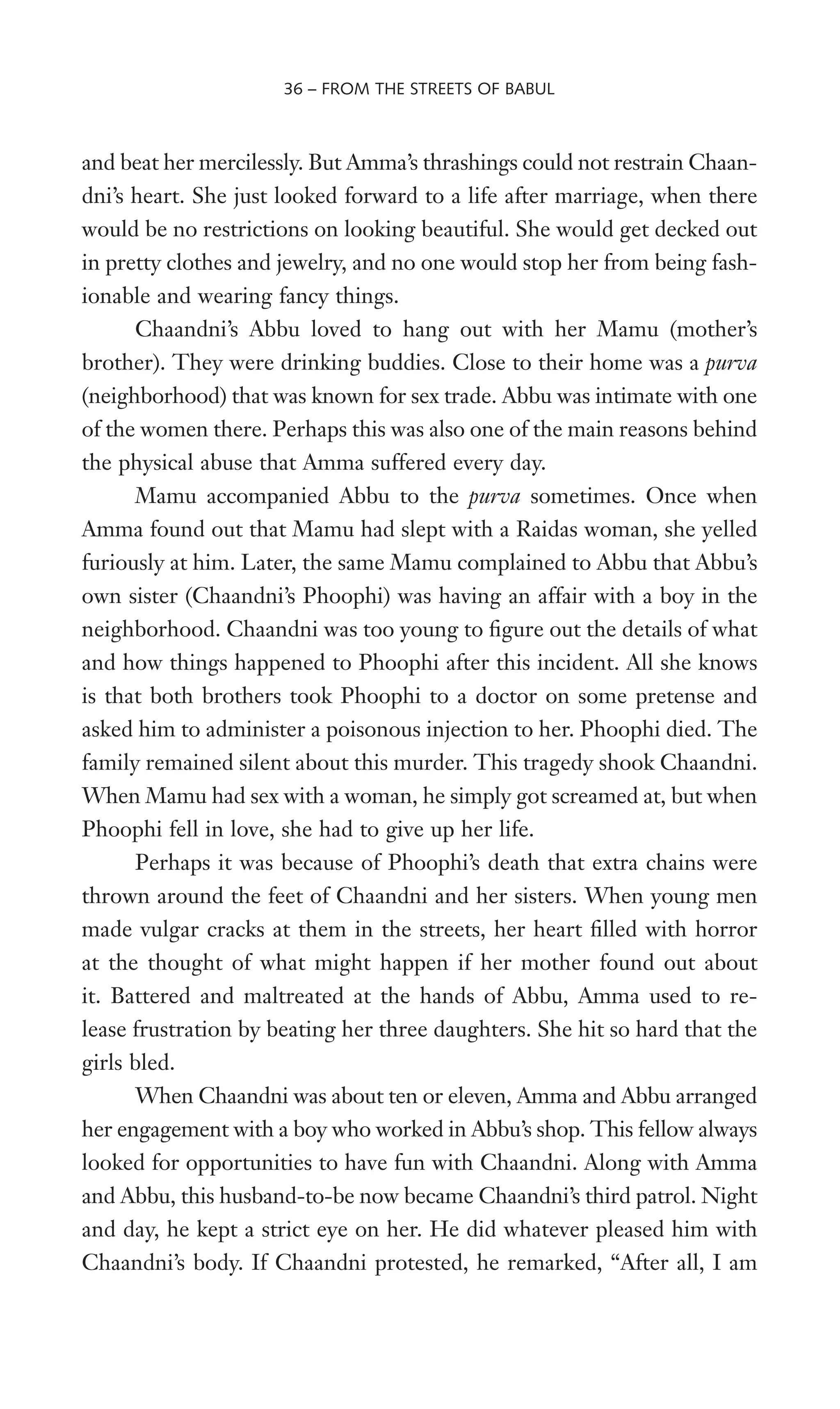
![the one who will marry you.” He did not care one whit what Chaandni
thought or wanted.
Like Chaandni, Garima’s heart also soared high. Her eyes were dreamy.
She loved to doll up. Garima’s widowed mother was always anxious about
her oldest daughter, who had come of age and was fast becoming a woman.
A village girl had fallen in love with one of Garima’s cousins. When there
was opposition to this relationship, the girl ate poison and died. A few
days later, her lover also committed suicide. This horriWed Garima’s
mother. With folded hands and bent knees, she begged Garima, “Beti, I
will worship your feet [marry you off] whenever you ask me to. Just don’t
bring any dishonor to the family.”
Garima could almost touch the fear that was making her mother’s
voice tremble. It gave her soaring heart a pause. She felt waves of desire
rising within her when she watched attractive boys, but she also learned
quickly to tame her feelings and bring them back to the ground. When
she was seventeen or eighteen, Garima became infatuated with a friend’s
brother. Even in the blistering heat of the summer, that boy used to wait
for Garima on the terrace every day. But before the romance could pro-
ceed any further, Garima’s mother discovered them, and Garima was
shipped off to her Nani’s (maternal grandmother’s) house in no time.
Suffocating under the restrictions of a widowed mother and of past wealth
and glory, Shikha found herself in somewhat similar circumstances. When-
ever she tried to form her adolescent dreams, her mother’s image appeared
before her eyes. She was forced to erase every dream from her heart’s
slate before she could even complete the sketch. When the conditions at
home deteriorated after her father’s death, Shikha became completely
silent. A quiet Shikha came to be known as a nice, gentle, and cultured
girl in her society.
But her heart was not so silent; Shikha desperately wished to marry
a good-looking, salaried man. She had a young male neighbor who had a
job. Whenever she saw him, her imagination took off: “I wish my mother
would Wx me up with this boy.” But it was not so easy to express these
FROM THE STREETS OF BABUL – 37](https://image.slidesharecdn.com/playing-20with-20fire-20book-140402052849-phpapp01/75/Playing-with-fire-book-86-2048.jpg)
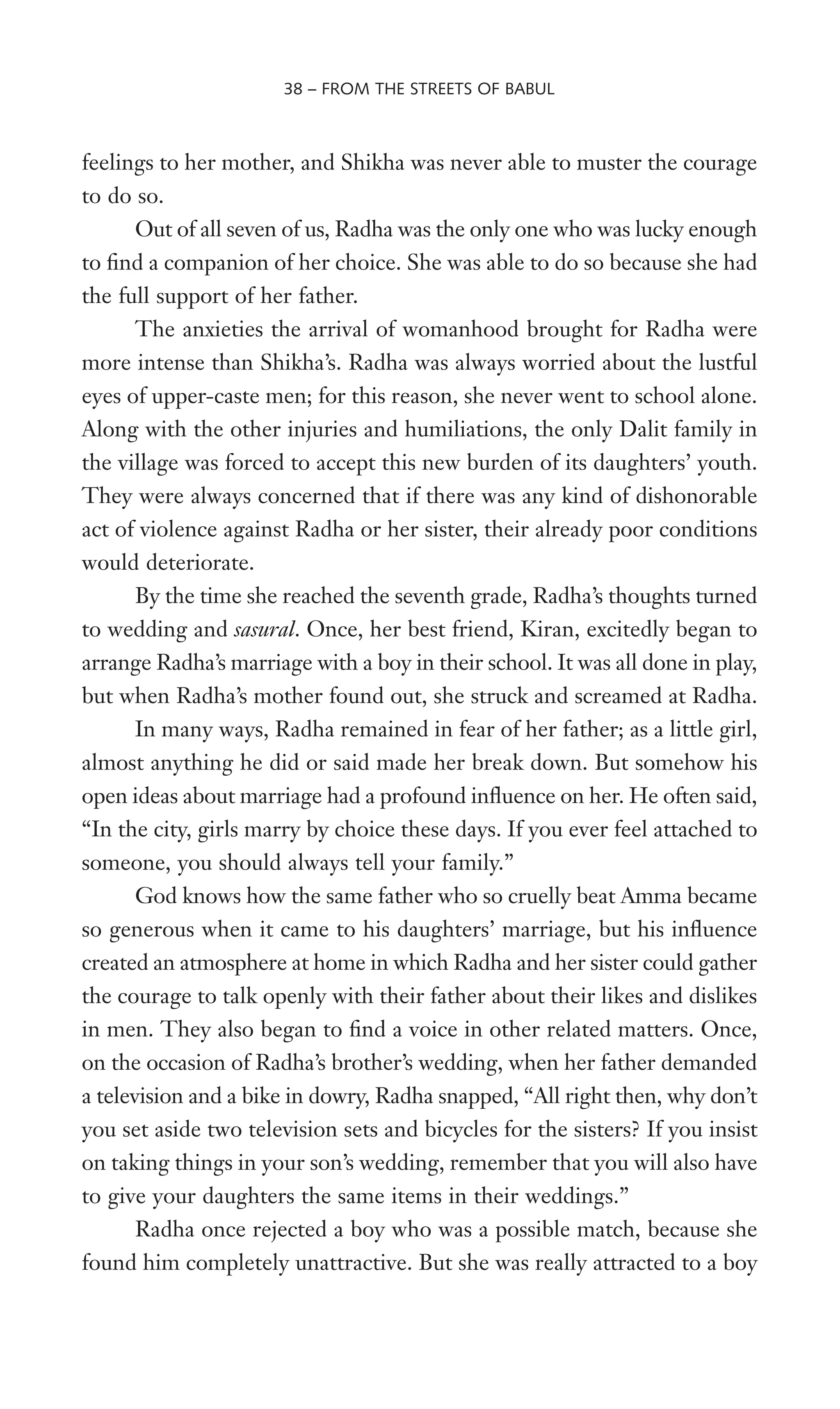
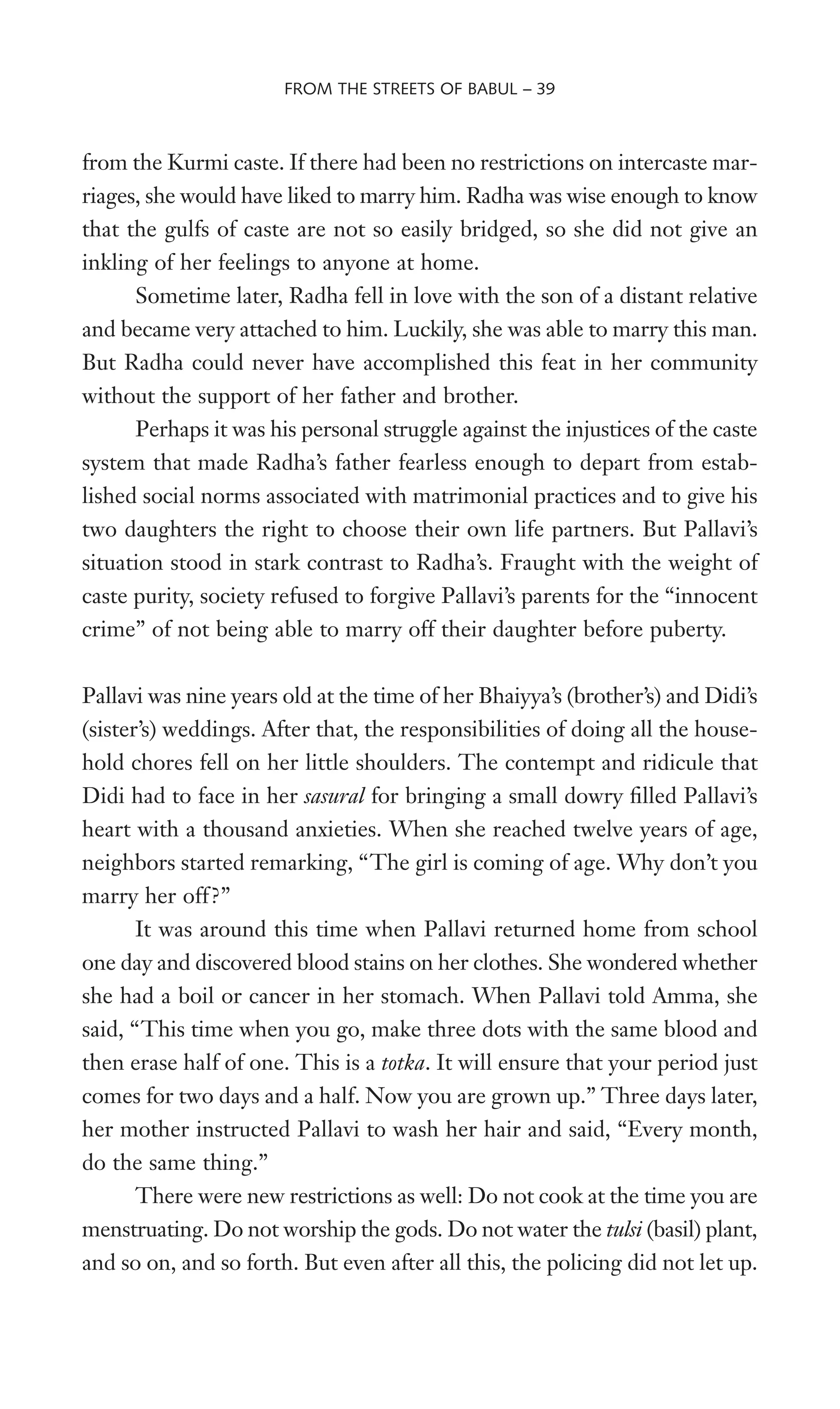
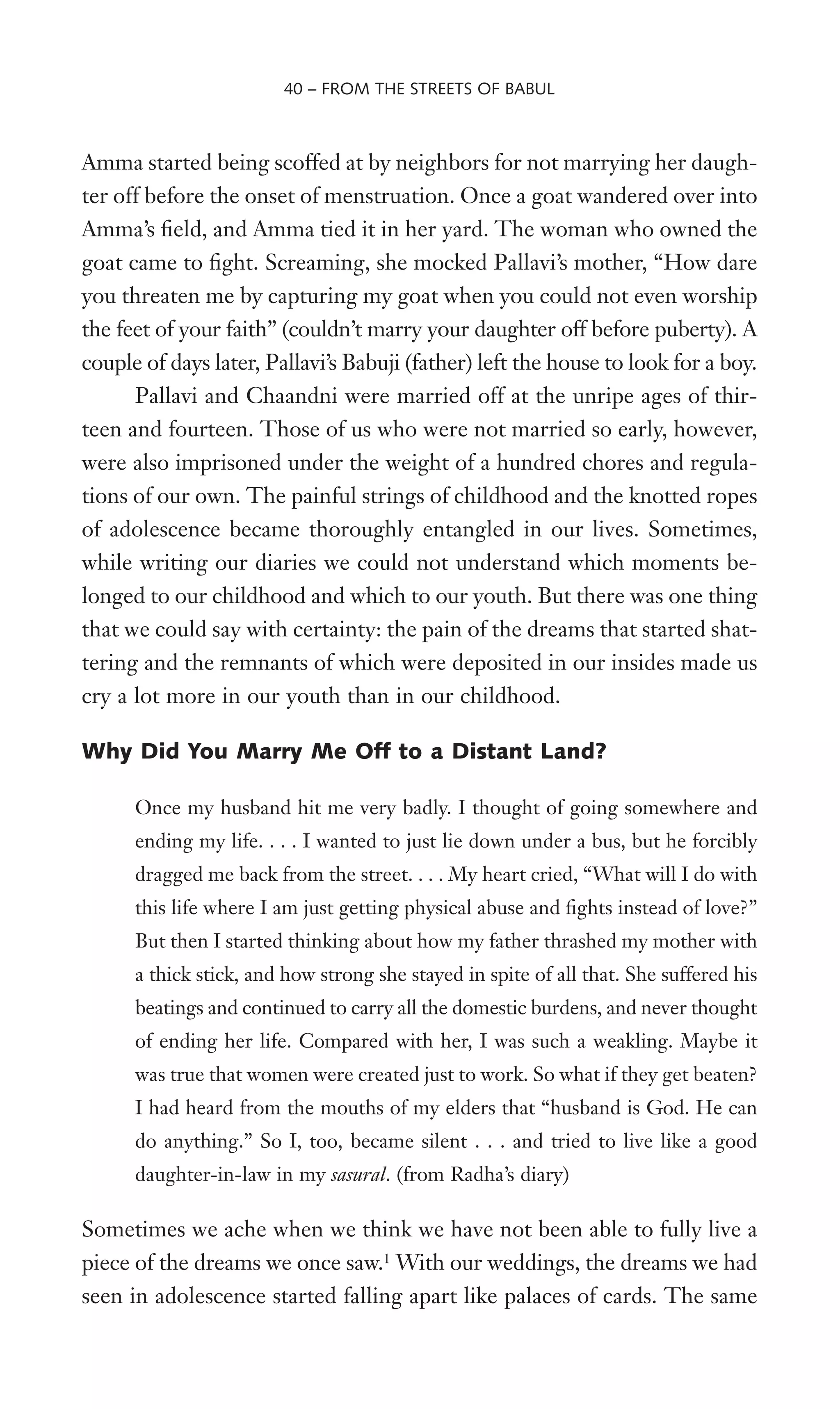

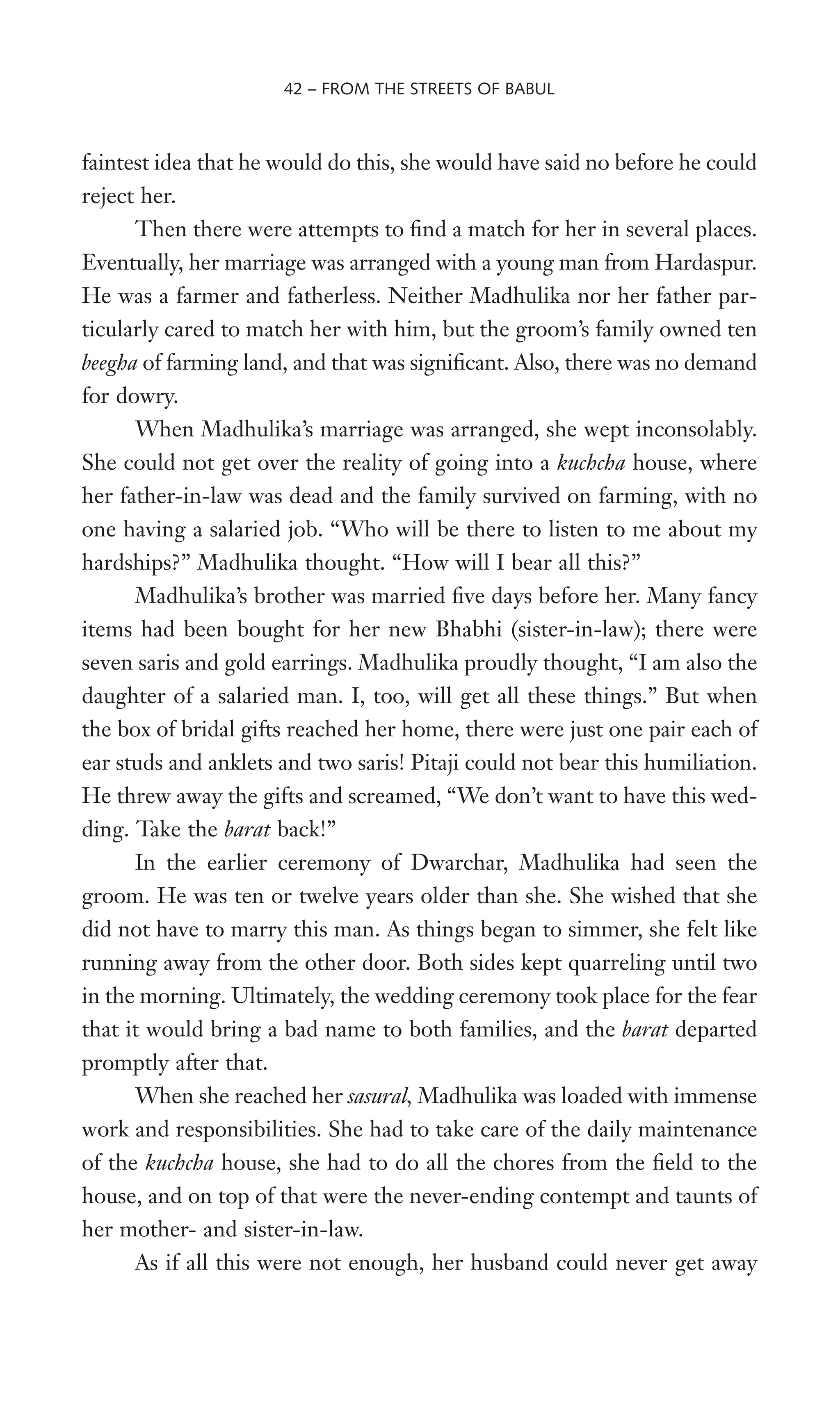

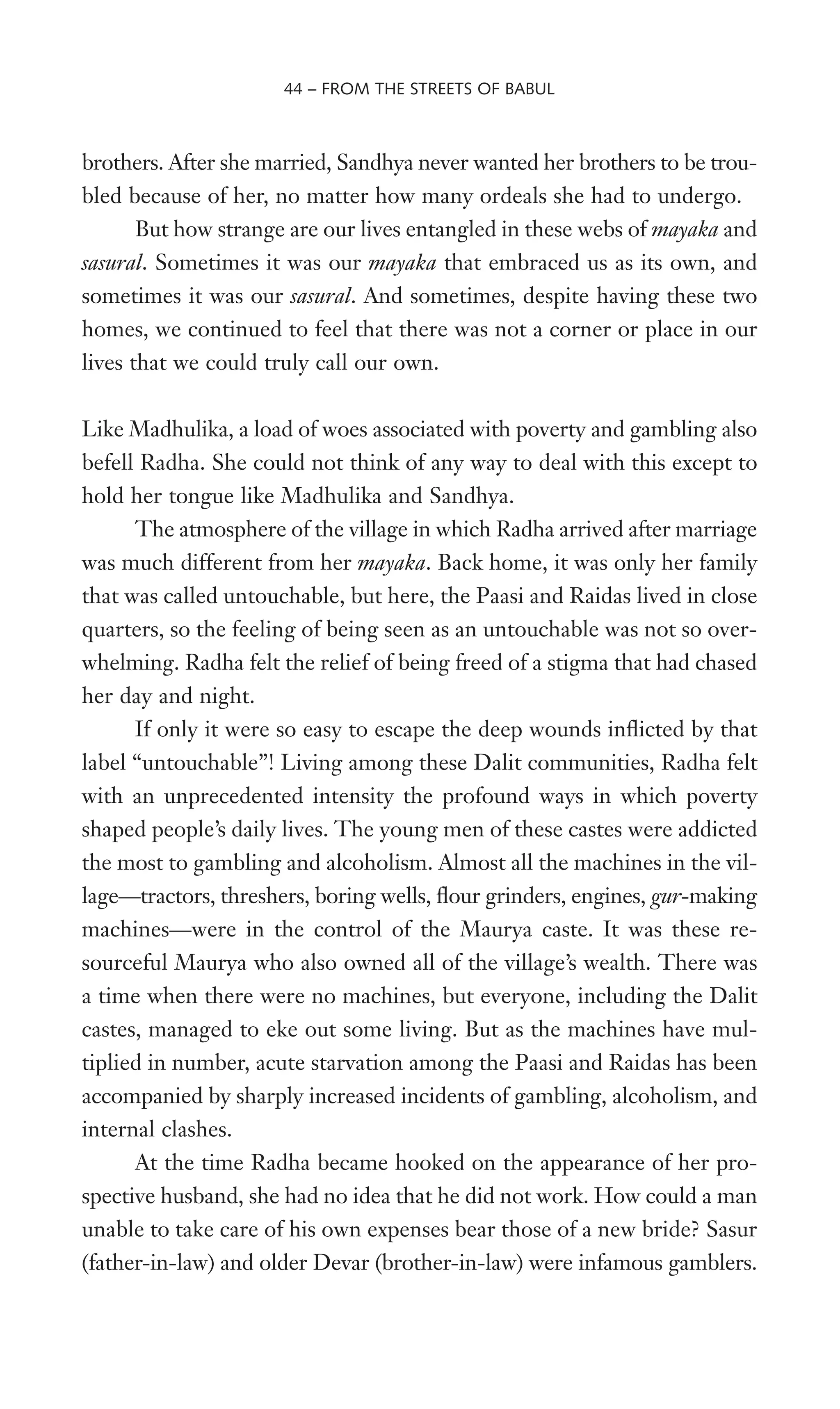
![The husband’s excuse for not working was that whatever he would earn
by working outside would be eaten up by his father’s and brother’s gam-
bling. Despite having Wfteen beegha of farmland, the family was so deeply
caught in the clutches of gambling that there were days when the hearth
stayed cold. All the farms were mortgaged so that gambling could go on.
A lot of things were also deliberately hidden from Radha in the
beginning. Radha’s Saas feared that if her new Bahu (daughter-in-law)
came to Wnd out about the real circumstances of her new home, she might
return to her mayaka. A rejection of the sasural by Radha would have
crushed her mother-in-law’s honor. But her Saas never paused to reXect
on why she made the maintenance of familial honor solely Radha’s respon-
sibility. Wasn’t the family dishonored daily before the village community
by her gambling husband and son?
Only six months into the marriage, some of the utensils given to
Radha in dowry were mortgaged. Radha found out about this when her
husband was about to reclaim the utensils. Saas began to Wght with her
son: “Why did you have to share this secret with Bahu. If she discloses
this in her mayaka, all my izzat [honor] will vanish.” Saas was ready to
strangle herself in fury.
Radha’s husband made her vow that she would not breathe a word
about this incident in her mayaka. Radha complied. But others always
advised her that the conditions of her sasural were far from okay. She
would never have any respite here. It would be better for her to leave this
home and return to her mayaka before it was too late.
Radha’s husband gave her plenty of love and affection, but he was
a very suspicious man, maybe because he himself used to have intimate
relationships with other women in the village. If Radha ever commented
jokingly on this, she was battered. But anytime she dared to talk to another
man, a big drama ensued. Radha often thought: “By what name should
I call this marriage? In reality I have given my husband and sasural the
complete rights of possession over my body.”
People often say that only wealthy bourgeoisie keep their women
imprisoned behind the purdah, because if a woman from a poor house-
hold were to sit in the purdah, there would be no bread to eat at home.
FROM THE STREETS OF BABUL – 45](https://image.slidesharecdn.com/playing-20with-20fire-20book-140402052849-phpapp01/75/Playing-with-fire-book-94-2048.jpg)
![But our experiences have taught us that this assumption is only partly
true. It is true that the feet of the daughters and daughters-in-law of the
so-called respectable families are chained in the name of maintaining
khandani izzat-aabroo. But there is also severe purdah in our Dalit and
poor homes, whether among the Hindus or the Muslims. That is why,
like Radha, Chaandni’s struggles were also intensiWed by the strict pur-
dah of her sasural.
Chaandni’s Wrst nikah, or wedding, took place at the age of thirteen. At
that time, she had not even started her menstrual cycle. Her Wrst husband
was the same young man who had once been madly in love with Chaan-
dni. Chaandni used to imagine a world after marriage in which there
would be only joys—fairs, socializing with relatives and friends, and who
knows what else! But what happens is always what Allah wishes.
In her sasural, too, handloom weaving was the chief source of live-
lihood—Wve to six dhotis (cotton wraps) had to be woven every day. Chaan-
dni knew that new brides had to cover their faces in the sasural. But she
could not digest the idea of hiding her face from her own relatives.
Saas used to order, “Cover yourself.” But the more she insisted, the
more Chaandni ignored her commands. What Chaandni had learned from
her mother according to Islam was that the purdah between a woman
and a man was one of the eye, not of the face.
Chaandni’s stubbornness angered her husband: “Do what Ammi
[Mother] asks you to do,” he would say.
Chaandni would reply, “Those who are mine are also yours. Why
should I hide my face from those who have seen me naked as a child?”
When she became obstinate on this issue in her sasural, the mat-
ters stretched beyond expectations. There was a clash between Amma
(Chaandni’s mother) and Saas.
Very soon, her husband also became violent. He wanted Chaan-
dni’s father to arrange a separate shop for his livelihood, but this was an
impossible demand for Chaandni’s poor Abbu to meet. He said, “I have
other daughters to attend to as well. What will I do for them?”
Abbu’s refusal resulted in intensifying Chaandni’s misery. She didn’t
46 – FROM THE STREETS OF BABUL](https://image.slidesharecdn.com/playing-20with-20fire-20book-140402052849-phpapp01/75/Playing-with-fire-book-95-2048.jpg)
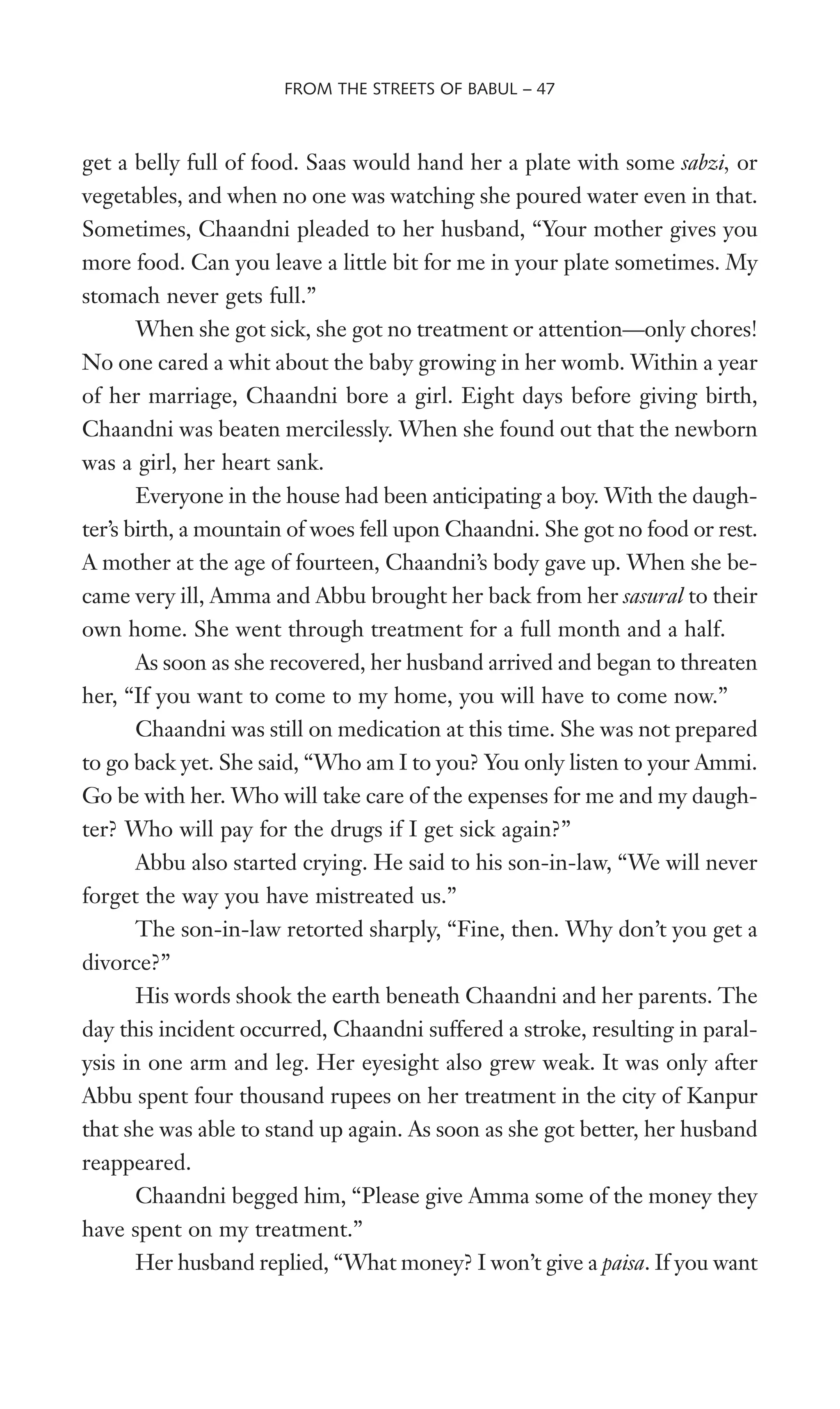
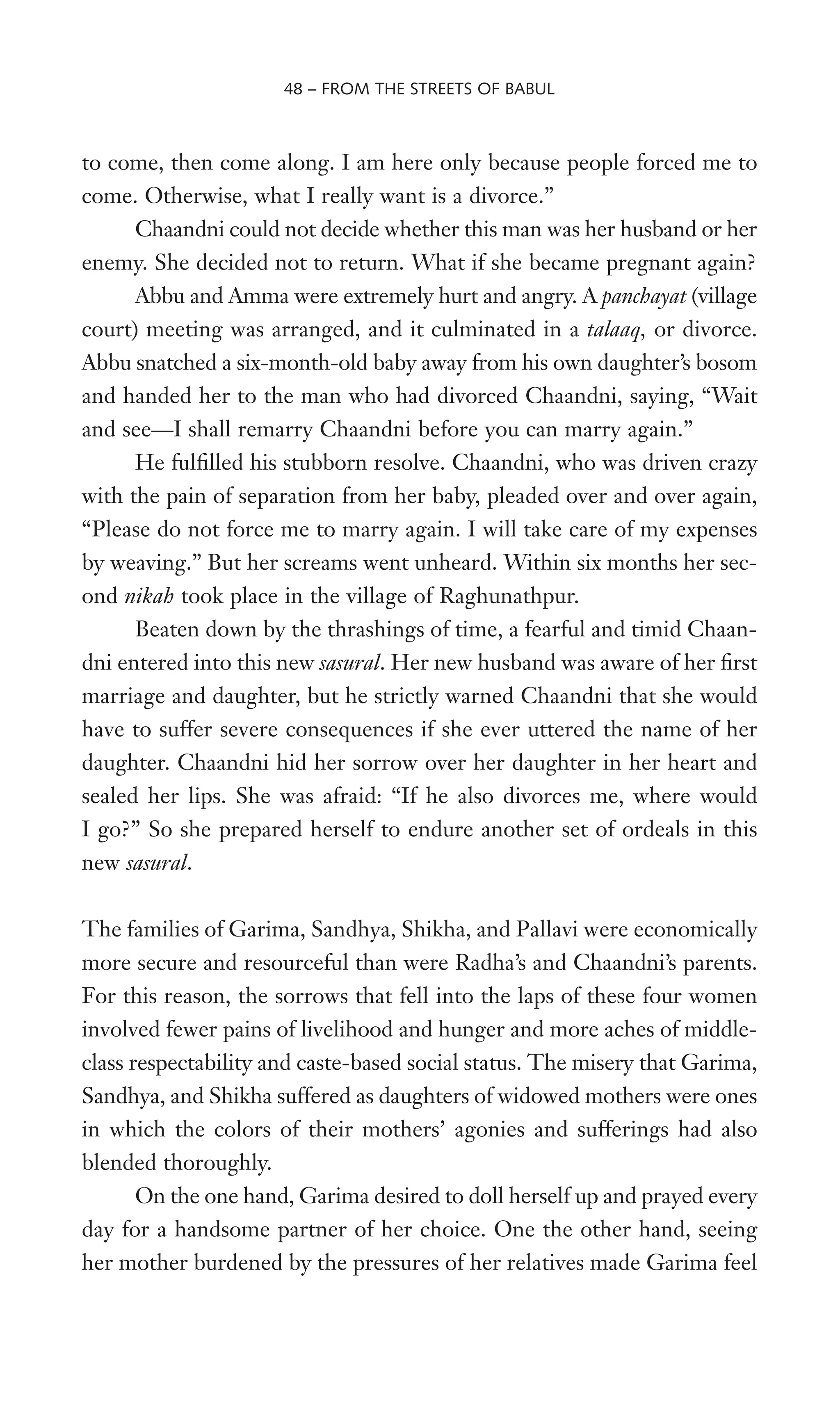
![that she had become an enormous burden for her family. Once Nani even
commented scathingly: “Mohan [Garima’s father] had his alcohol and
took off, but he left us to deal with all the hazards.” Because of her lack
of access to cash, Garima’s mother was not in a position to give a big
dowry. So Nana, Mausa, Maa, and even Garima herself always wished for
a match to be arranged soon so that all the worries would come to an end.
In the end, Mausa (husband of Maa’s sister) managed to arrange a
match without dowry; the boy used to work in the Sitapur eye hospital.
But four days before the tilak, or engagement ceremony, Garima’s relatives
discovered that the boy’s family were not kuleen (reputable) Brahmans. So
the wedding was called off. After this, Mausa Wxed Garima up with the
fourth son of one of his sisters who was married in the village of Sujanpur.
Nana consented to this match rather unenthusiastically because that fam-
ily was known for its quarrelsome behavior. Garima’s prospective sister-
in-law, in particular, was infamous for her Wghts. Masi (Maa’s sister) and
Mausa assured the family that the boy himself was very good-natured.
However, Garima knew, because of distant kinship with this family,
that people in her natal village of Manoharpur looked down on Sujan-
pur because of its acute poverty. She detested even the sound of the word
Sujanpur. She felt that her dreams had been crushed. She was reminded
of all those married girls who had to visit their mayaka to collect essential
items such as soap, toothpaste, and hair oil. They didn’t even get decent
clothes to wear. “I am also going to be like one of them,” Garima thought.
Everyone who heard about the engagement said the same thing,
“Oh my God! Sujanpur is full of hooligans. Why are you marrying off
your girl so far away? She won’t even get any bread to eat.”
The bride’s side promised ten beegha of land to the groom’s family,
and the match was settled. Grain had to be sold for the engagement cer-
emony. Garima’s family gave plenty of purchased goods in the tilak, but
the Saas was infuriated because there wasn’t enough cash, and she made
a point to harp on this for several years with taunts and anger.
All the rituals were carried out with great enthusiasm in Garima’s
own home, though, because this was the Wrst wedding. Her Maa’s tears,
however, started Xowing on the day that Garima became engaged. Maa
FROM THE STREETS OF BABUL – 49](https://image.slidesharecdn.com/playing-20with-20fire-20book-140402052849-phpapp01/75/Playing-with-fire-book-98-2048.jpg)

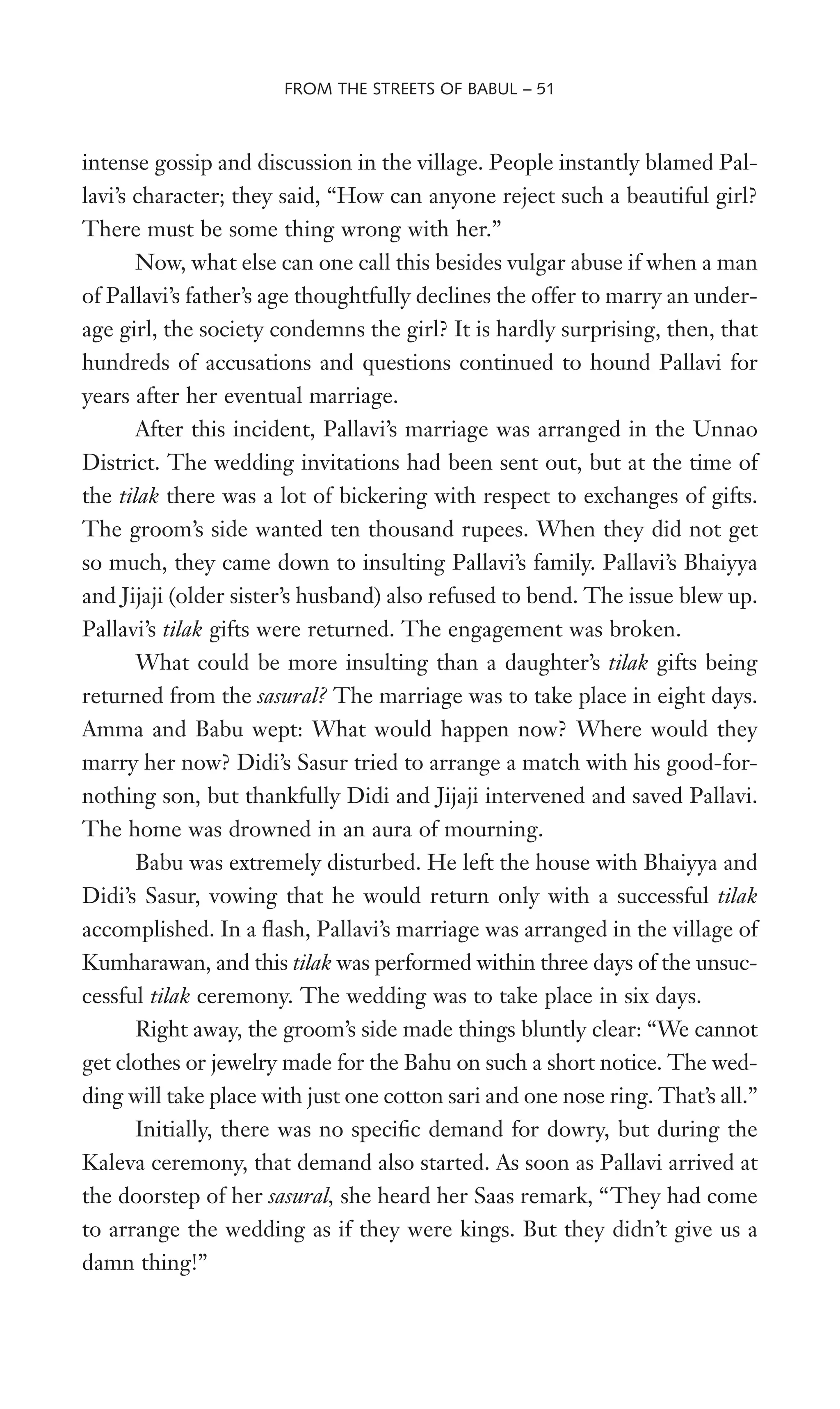
![Pallavi’s Saas took her straight to a storeroom in the house, half of
which was Wlled with cow dung cakes and the other half with hay. Pallavi
was instructed to sit on a dari (rug) on the hay. When she lifted her ghoon-
ghat, she saw trash and cobwebs everywhere. She had seen dreams of a
little room in her sasural in which she would sit and talk with her groom.
But here she was, in this little Wlthy storeroom. She was so repulsed by
this house that she could not eat or drink anything that day. She just lay
down on the hay and slept. At night, when her groom entered the room,
he Wrst asked her name. Then he immediately queried, “What about your
marriage in Jahanganj. Why did it not work out?”
Pallavi replied, “What do I know?”
Sleeping with a stranger on the Wrst night of marriage was very
difWcult for Pallavi. She wept thinking that this is what she would have
to undergo every day. The next day, she returned to her mayaka with her
husband for a total of one day and then came back to her sasural.
Pallavi had her period before marriage but none afterward. The
midwife announced that she was pregnant. Saas suspected that the preg-
nancy happened before marriage; that’s why the girl was married off in
such haste. Pallavi refused to provide any explanations. Two and a half
months went by. Then she returned to her mayaka.
Pallavi had difWculty appearing in her mayaka with an expanding
belly. After spending three months there, she wrote to her husband ask-
ing him to take her back home. But it was her Sasur who came to fetch
her. Amma served him daal, rice, roti (Xat unleavened bread), and sabzi.
Sasur ate everything there, but as soon as he arrived in the sasural, he
announced before half the village: “The Wrst thing those rascals fed me
was daal and rice. They are worthless. They should have at least fed poori
and sabzi to a guest on the Wrst day! It is a women’s kingdom there—there
is no purdah, no nothing. Samdhin [mother-in-law of his son] was star-
ing at me naked-faced, shamelessly asking me how I was doing!”
Even after suffering all this abuse, Pallavi eagerly awaited her re-
union with her husband. But something vicious must have happened while
she was gone, because her husband completely stopped coming near her.
He would not even ask how she was doing. When he came home for lunch,
52 – FROM THE STREETS OF BABUL](https://image.slidesharecdn.com/playing-20with-20fire-20book-140402052849-phpapp01/75/Playing-with-fire-book-101-2048.jpg)
![Pallavi had to remain in the ghoonghat because of family pressure. When
he came at other times, the young Nanads (sisters-in-law) did not leave
them alone. There was no place or opportunity for a conversation or inti-
macy of any kind.
Pallavi became restless. Then she had a brainstorm: “My husband
grinds the fodder every afternoon. If I start operating the machine, at
least I would be able to see him to my heart’s content. At least I would
be able to touch his hands.” But what happened was exactly the opposite.
Her husband instructed his brother to assist Pallavi with the fodder pro-
cessing, and he himself sat outside until the processor was turned off. Pal-
lavi cursed her parents as she ground the fodder: “Rather than subjecting
me to a life like this, it would have been better if they had fed me Sulfas
[chemical fertilizer]!”
When Pallavi could no longer bear this rejection, she forced her
husband to come to her. She conceived a second time and gave birth to
a daughter. The husband’s distant attitude continued until the birth of
their third child.
Today, Pallavi wonders why life played such a harsh joke on her. So
intense is this nameless pain that the society does not even allow a woman
to express it to anyone. After all, who would understand the emptiness
that ripped Pallavi’s insides for so many years? People would simply say
that if her husband didn’t love her, how could she have three children.
But is love merely about having sex? Doesn’t emotional or psychological
intimacy matter in a relationship between a woman and man? Pallavi
keeps searching for an answer to the question of why she remained so
unsatisWed for years, even after becoming a mother of three children.
Shikha’s mother also started worrying prematurely about shipping off
her daughter to her “own home.” It had been three years since Maa had
lost her husband, and Shikha was now completing her Wfteenth year. The
older sister mentioned a possible match in the village of Chandosi. When
her mother went to check him out, she found that he was the oldest
son in his family with four younger brothers and sisters. All the younger
siblings were between seven years and nine months in age. When she
FROM THE STREETS OF BABUL – 53](https://image.slidesharecdn.com/playing-20with-20fire-20book-140402052849-phpapp01/75/Playing-with-fire-book-102-2048.jpg)
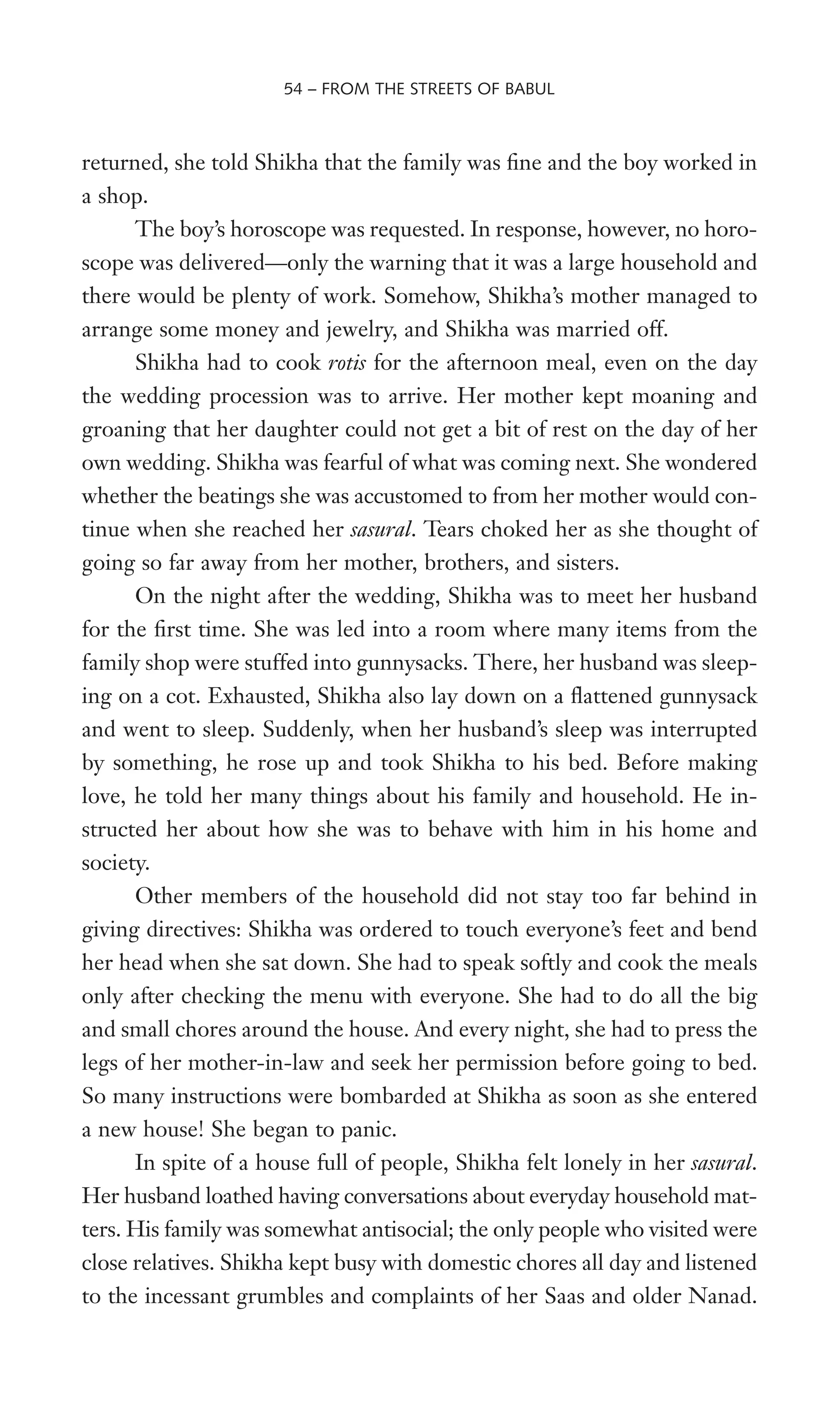

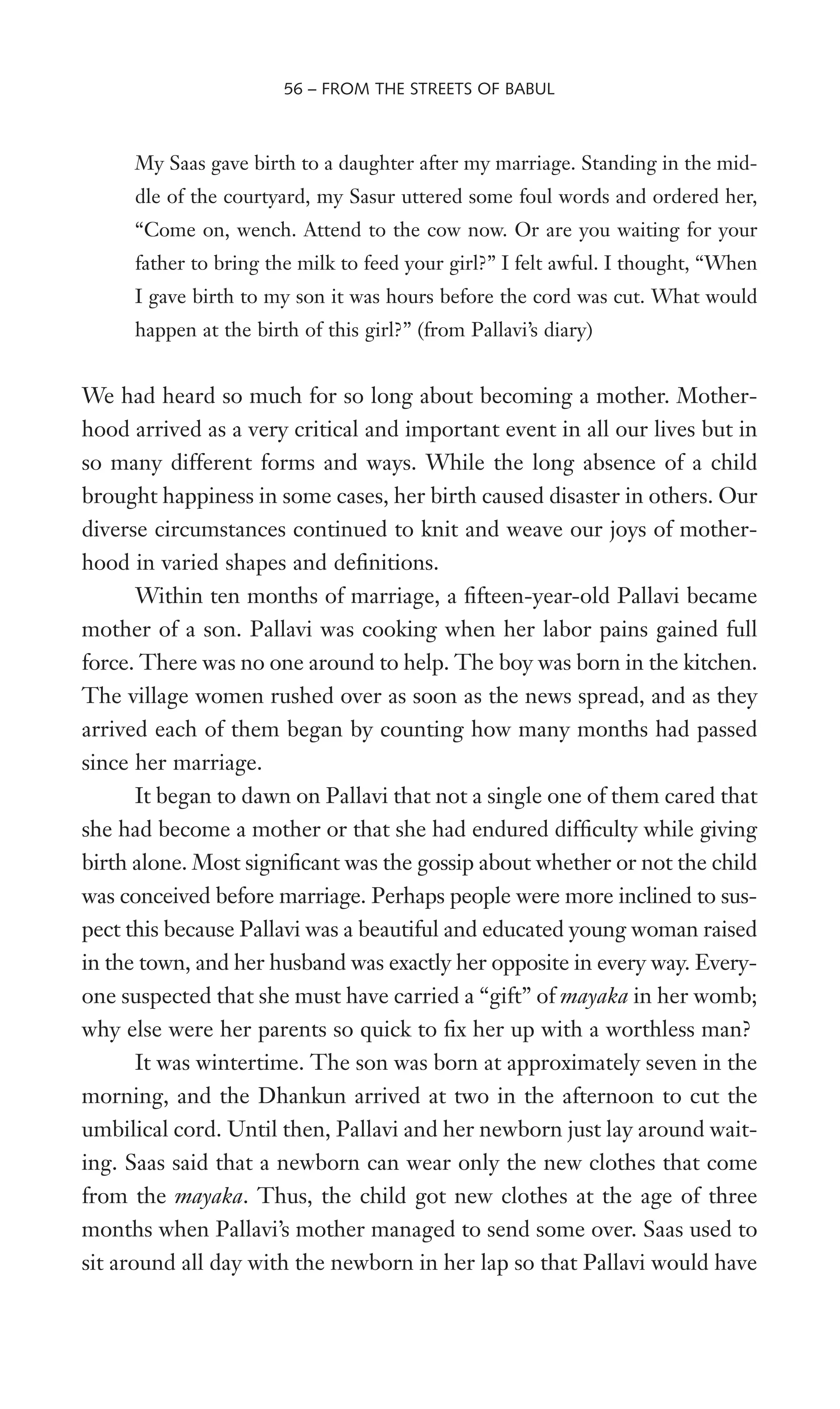
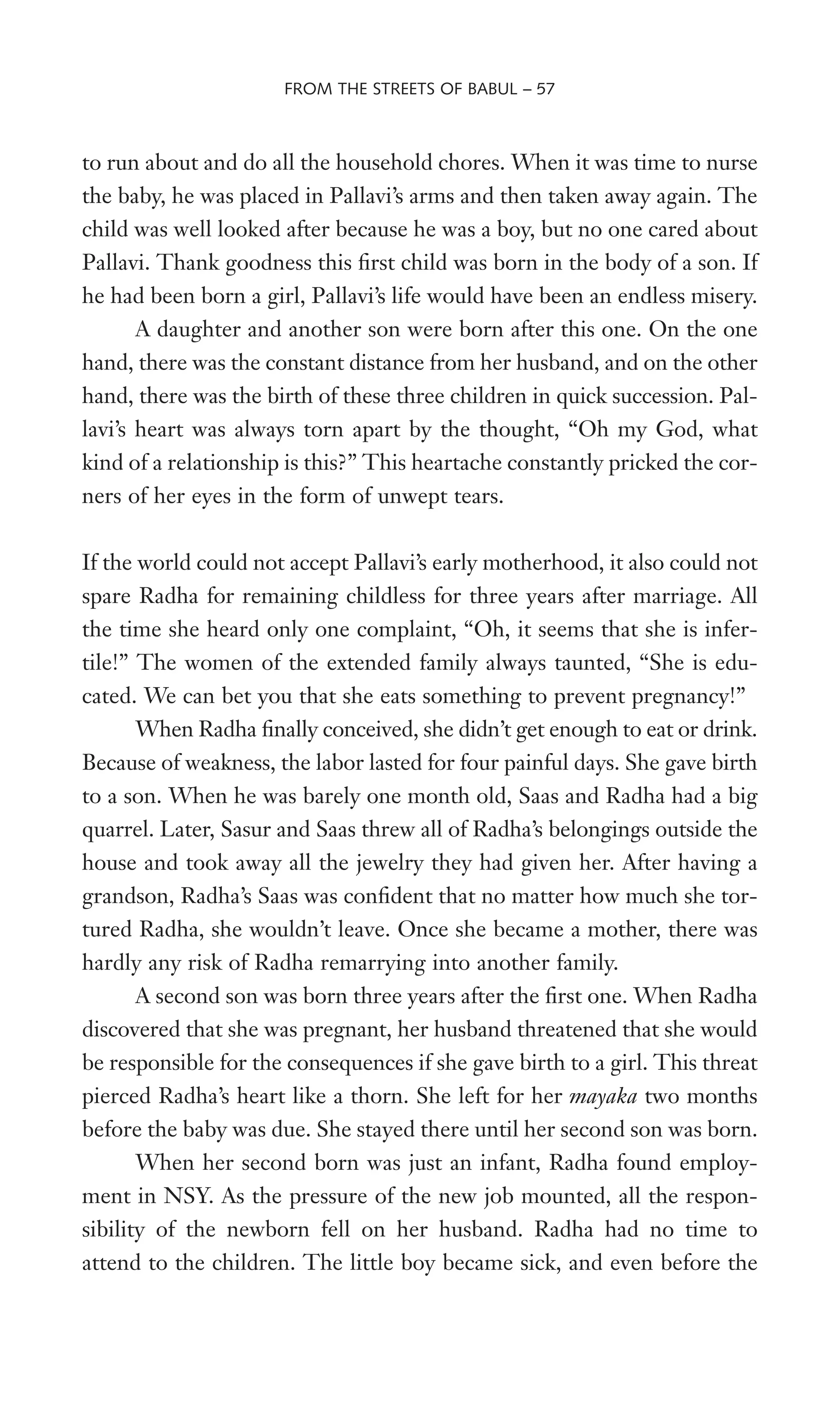
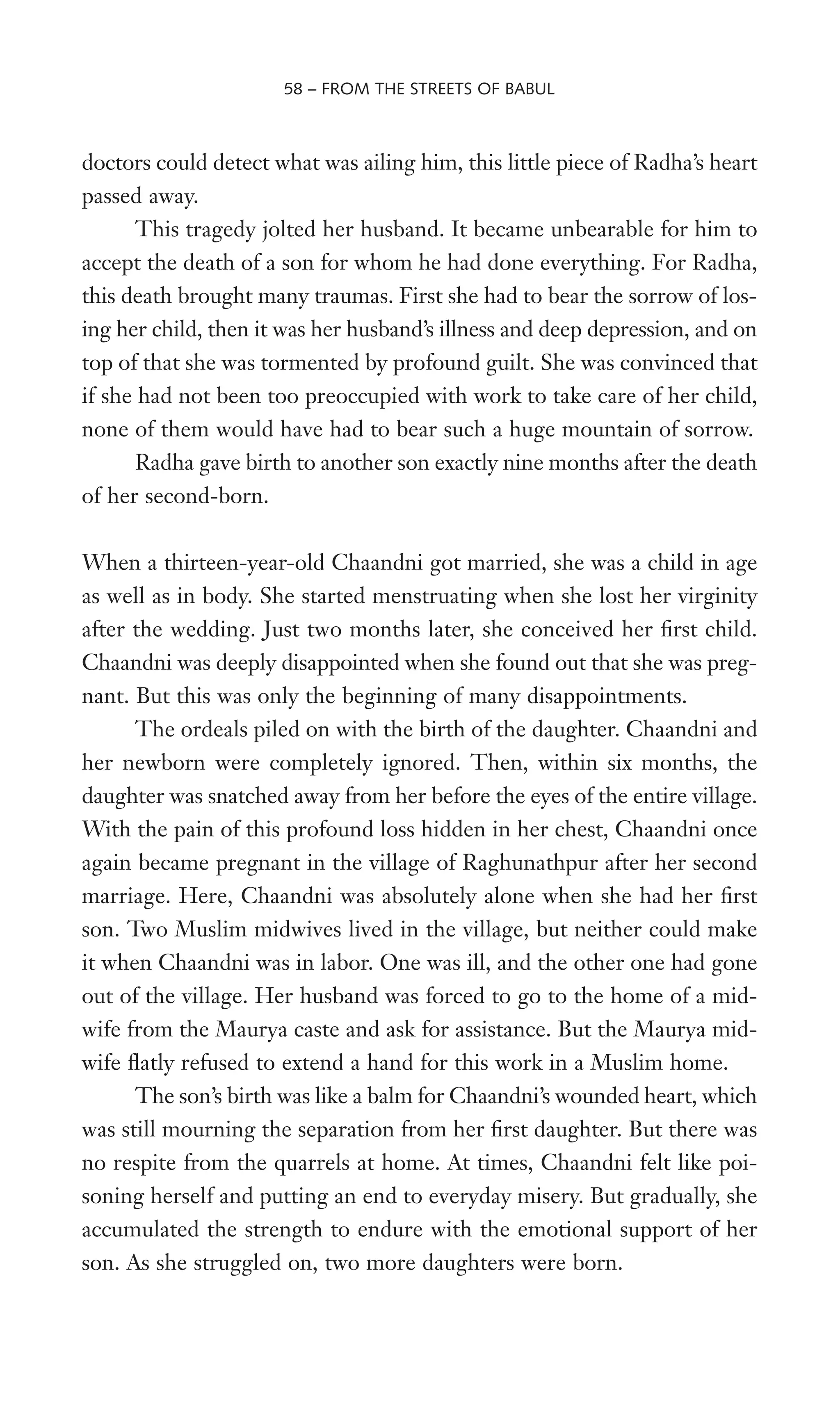
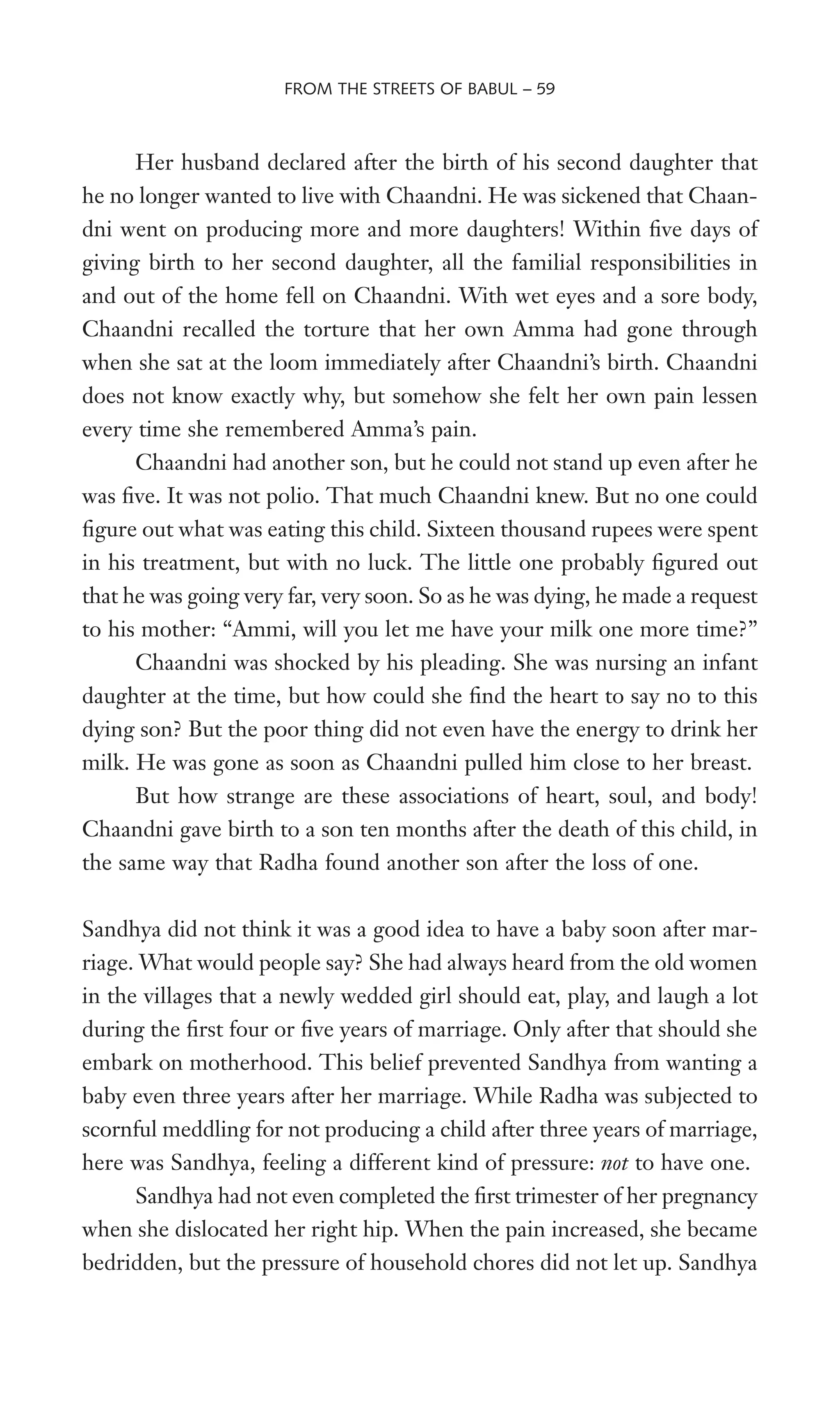

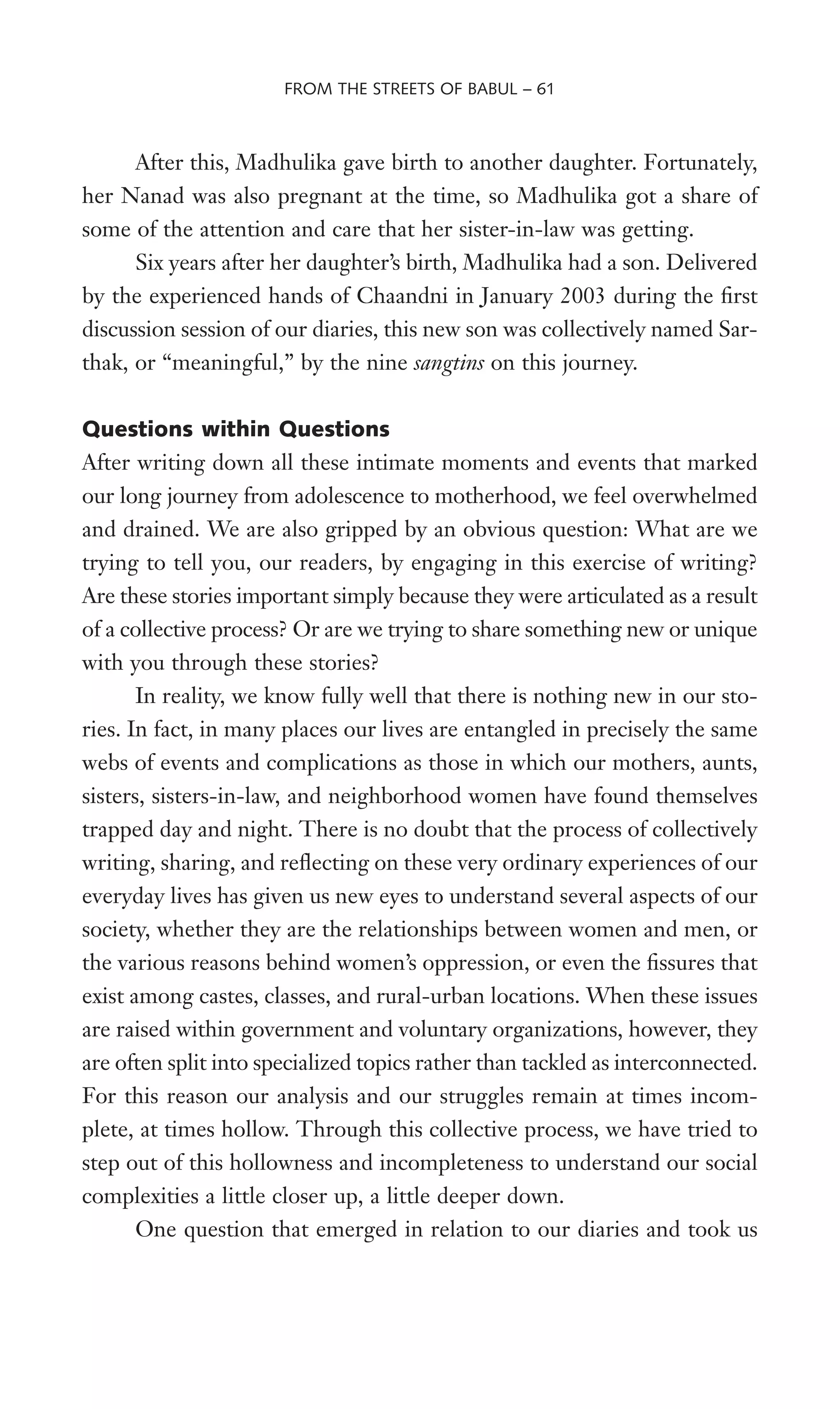

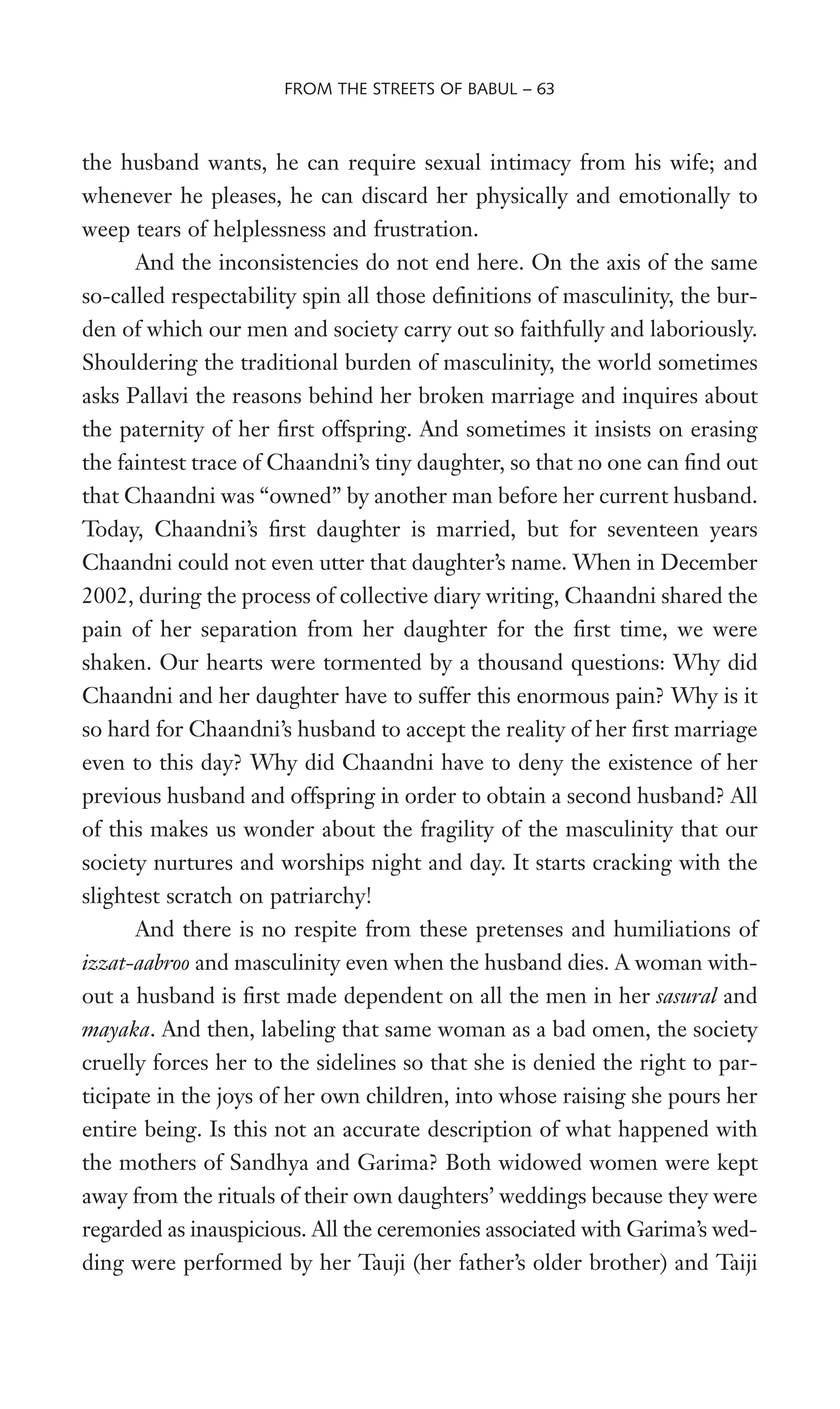
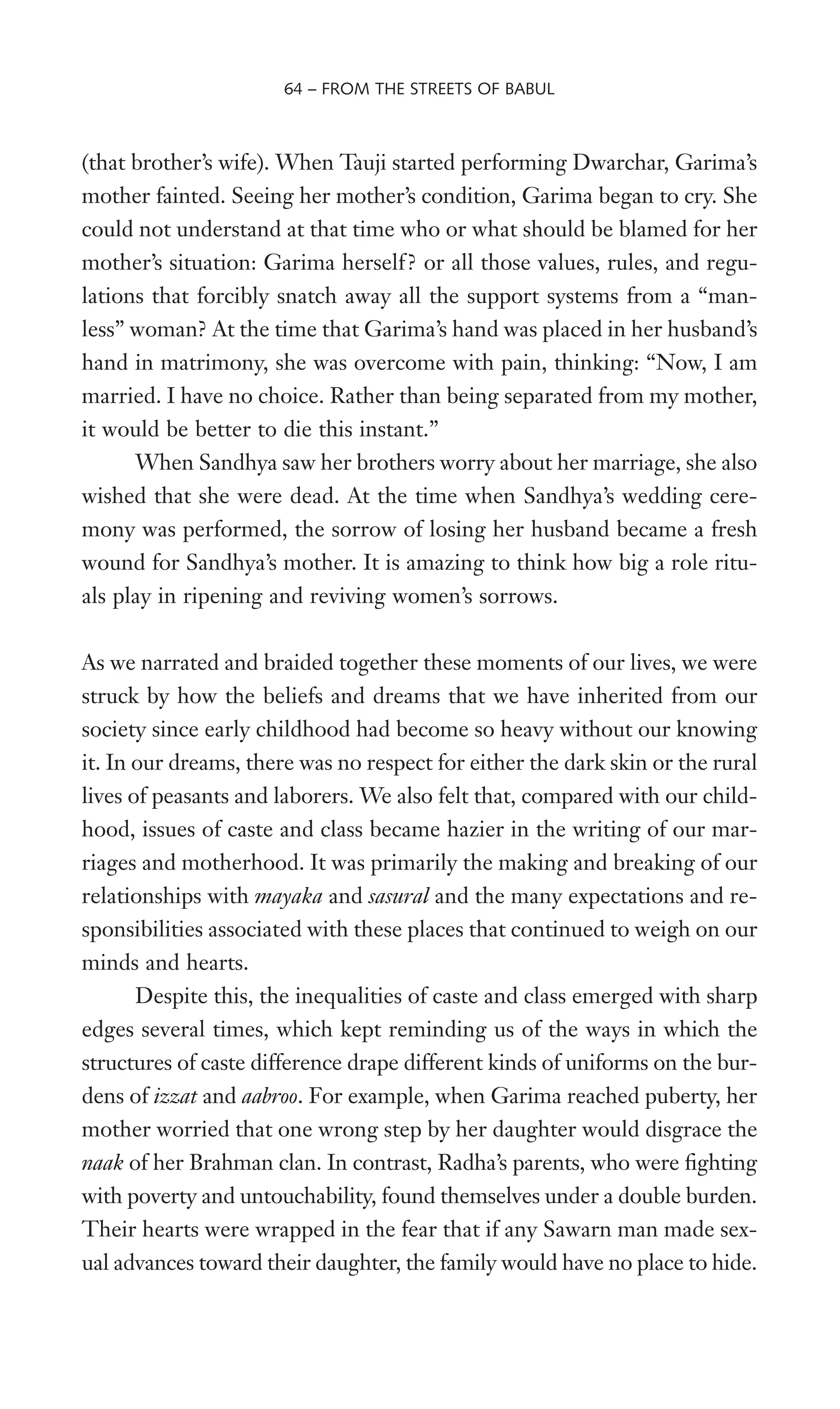
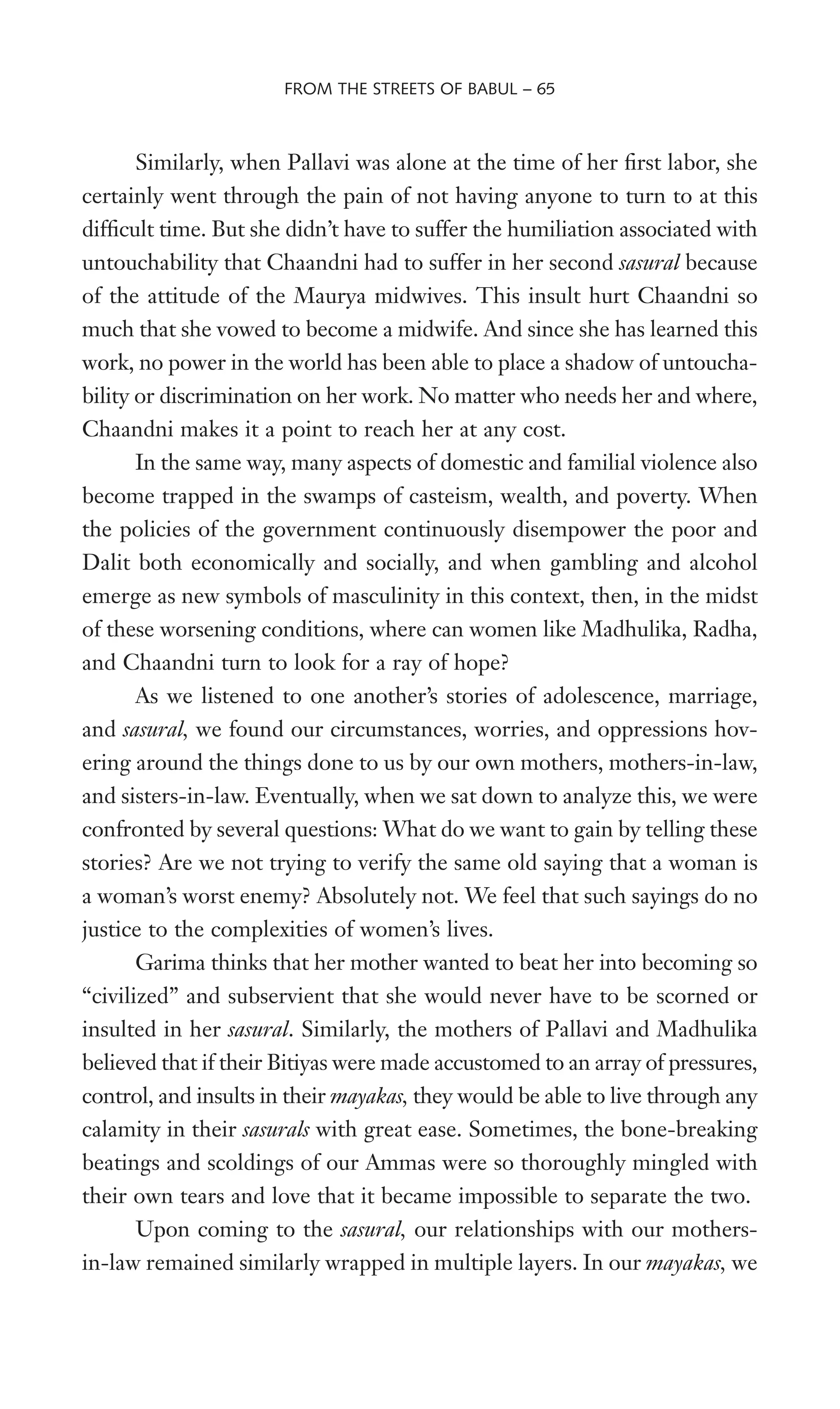
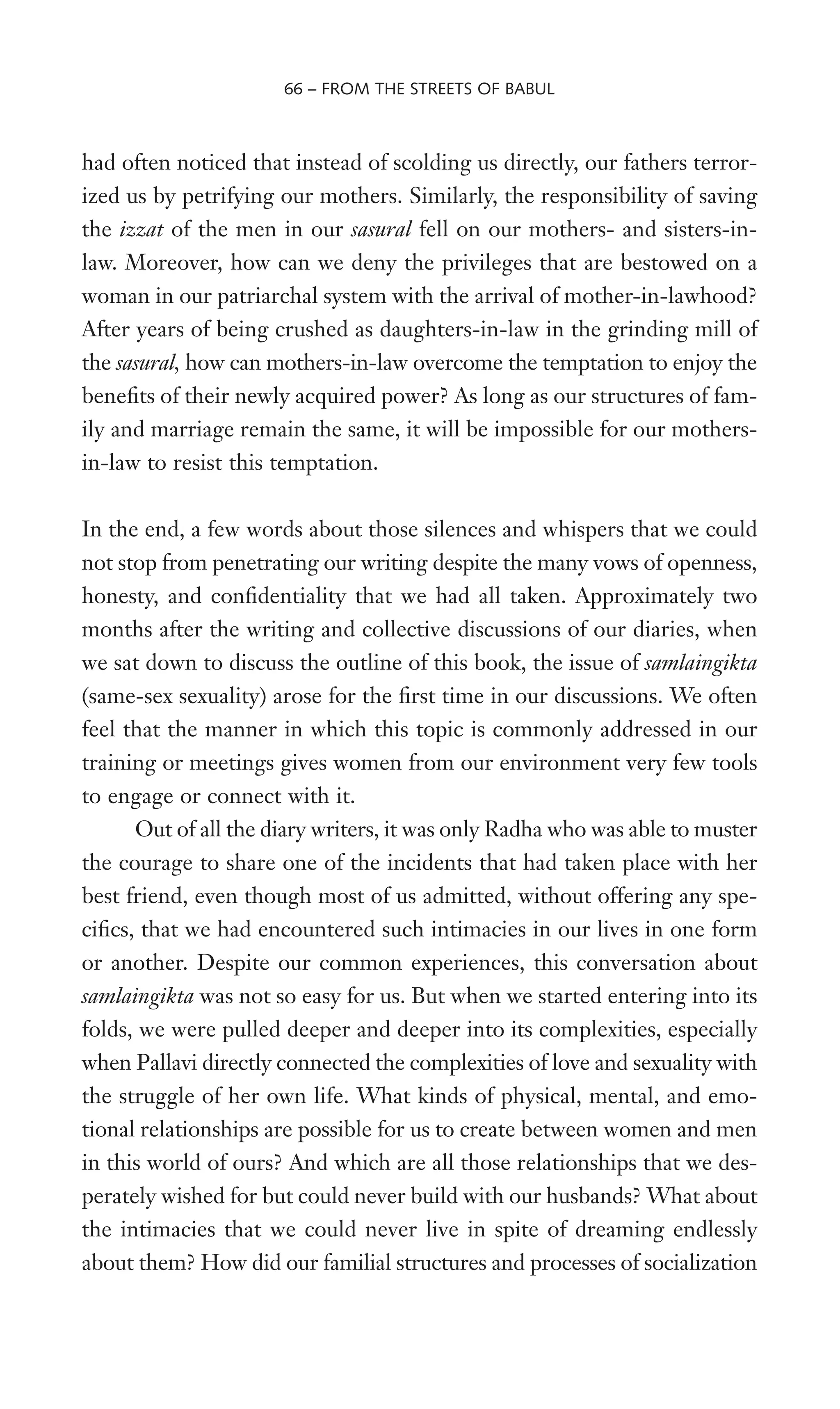
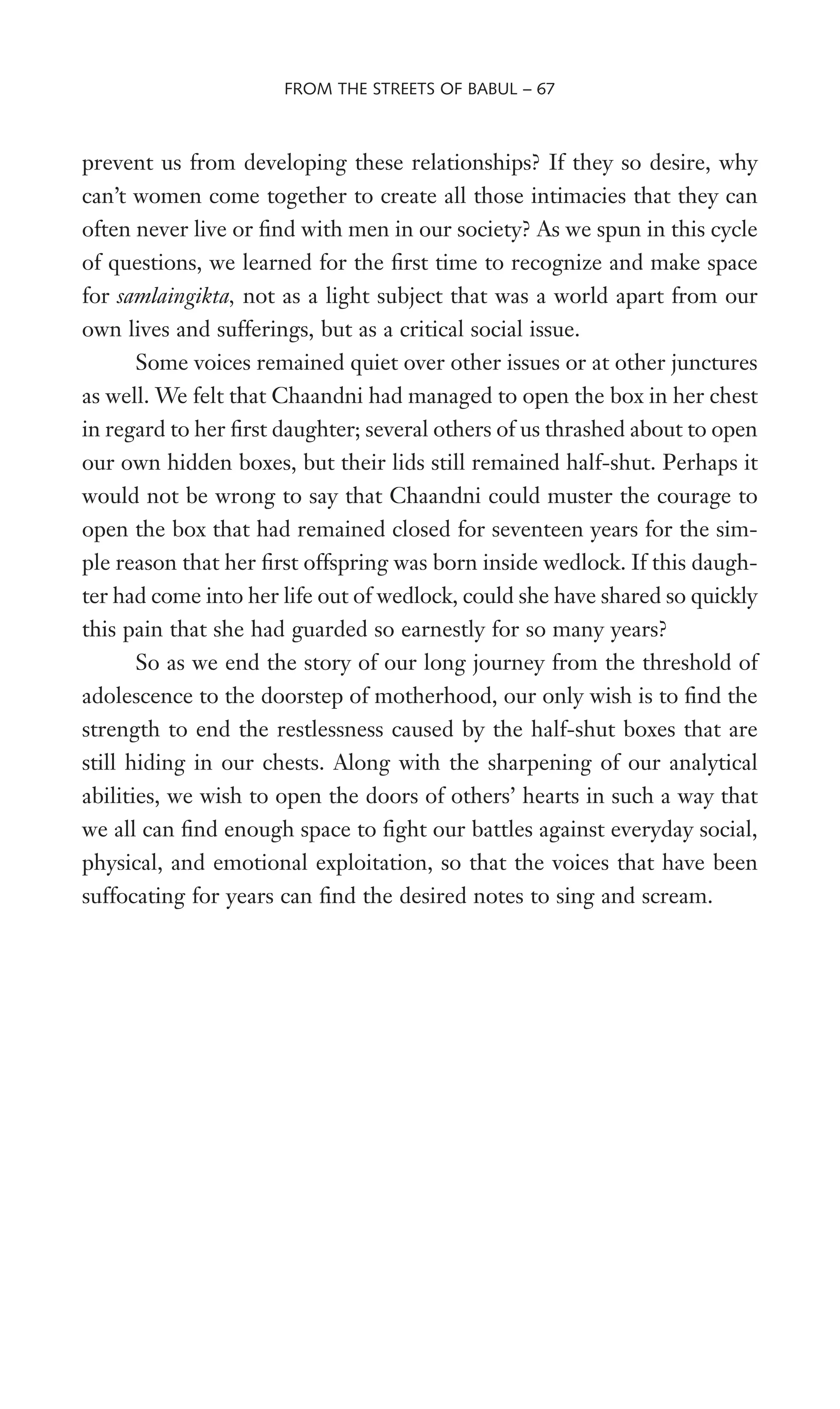
![In my home, when [people] discovered that I was going to take up a job,
my Sasurji began to scream, “If my Bahu works outside the house, I will
hang myself. I have so much. A woman from my house does not need to
work outside.” My husband was also angry. . . . [He] declared one day:
“Do whatever you want. It’s up to you either to keep our honor or to raze
it.” I began to think, Which honor do these people keep invoking, after
all? Where does this mighty honor disappear when my son lives in my
mayaka and my mother bears all his expenses? When I live without soap
or oil, then the honor stays alive, but when I talk about earning two pen-
nies, that same honor makes its way to the cofWn! (from Pallavi’s diary)
Leaping across the boundaries of our homes was not easy for any of us.
Our different circumstances and home environments translated into dif-
ferent kinds of risks and battles for each of us as we stepped into our
work Weld. And once we entered it, so completely were we consumed by
our work that the current of our life changed forever. There was a time
when we did not even have the conWdence that we could get an ordinary
job in a government-run women’s program. But very soon, immersed in
our work, we had traveled so far that the signiWcance of a “job” began to
fade from our minds. Every pore in our body was now intoxicated with
the desire to change our society.
This journey of mind-sets, ideologies, and struggles shook our
68
C H A P T E R 4
Prisons within Prisons
Battles Stretching from the Courtyard to the Mind](https://image.slidesharecdn.com/playing-20with-20fire-20book-140402052849-phpapp01/75/Playing-with-fire-book-117-2048.jpg)
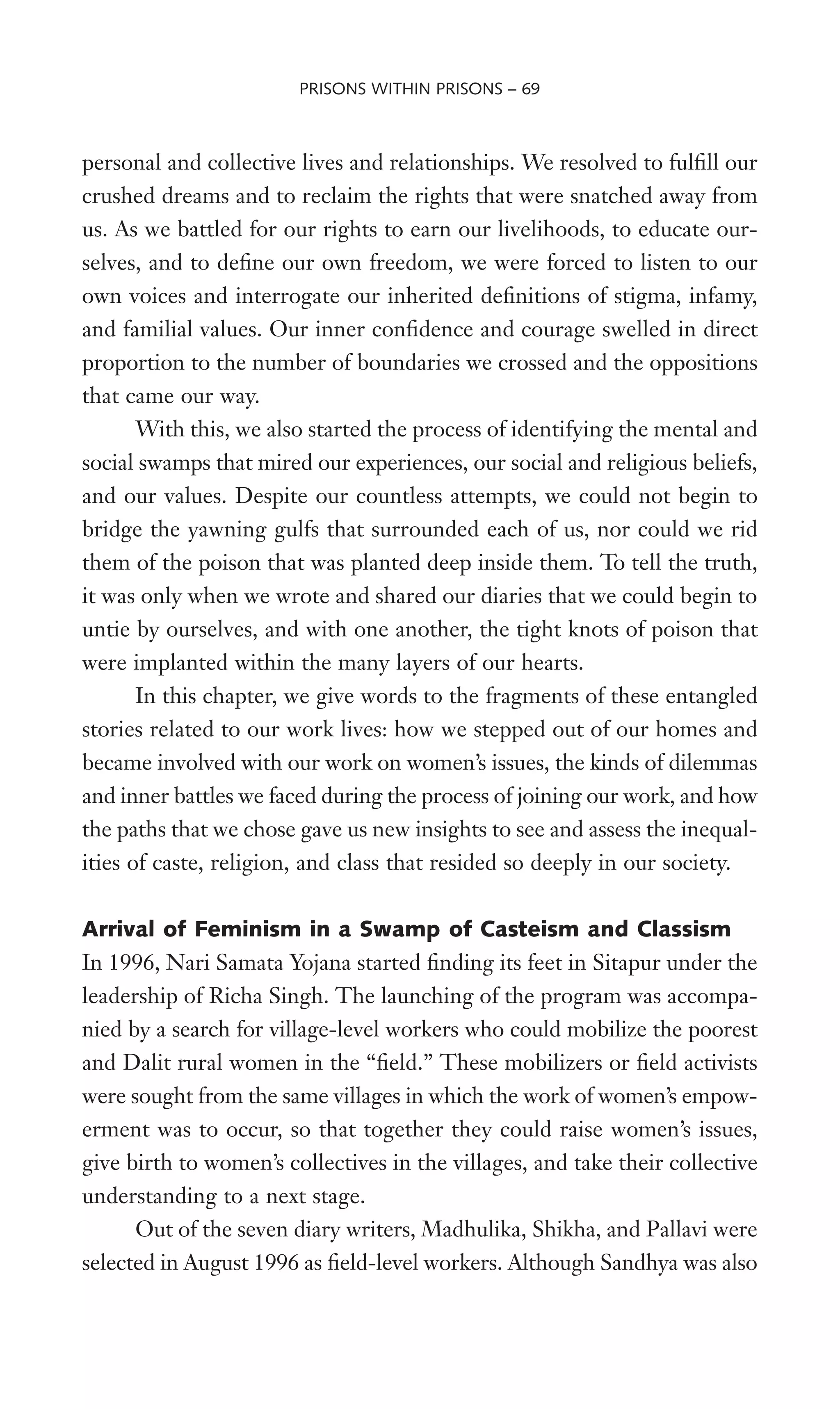
![in the same pool of applicants, she was selected to run a literacy center
in the Wrst phase of NSY’s work. It was only after serving as a teacher in
a literacy center for a year and a half that she assumed the responsibility
of a Weld-level worker. Similarly, Garima Wrst joined NSY as an ofWce
worker on daily wages. She wanted a permanent placement as a member
of the ofWce staff, but when she was not chosen for such a position in an
informal selection process, she was forced to accept the job of a Weld-level
worker. Radha joined as a Weld-level worker in 1998, and later, it was
through Radha that Chaandni entered the organization as a teacher in a
literacy center.
The news that workers were being sought to build grassroots
women’s collectives reached the seven autobiographers in different cir-
cumstances and through different channels of information. Fighting
with her own doubts and fears, each one developed the nerve to take the
next step.
Radha writes: “I had a really hard time meeting my daily expenses.
I used to stay depressed, thinking, ‘How long will things go on like this?’
I was prepared to work outside the home but my husband did not agree.
Defeated, I had to sit at home. . . . Here in [NSY], they were looking for
another Weldworker. Didi [Richa Singh] came to my house to talk with
me and my husband about this. His disapproval persisted. But after talk-
ing to Didi, I felt so conWdent that I stepped out to work despite my hus-
band’s opposition.”
Madhulika, who was working as a volunteer in the village of Man-
pur, was similarly approached by the district-level team of NSY. When
Madhulika got ready to go to the district ofWce of NSY for the Wrst time,
no one from her family was willing to accompany her. This hostility hurt
Madhulika. She cried a lot. Eventually, her husband and sister-in-law
agreed to come to town with her. If Madhulika had nurtured a dream since
she was very little, it was the dream of having a salaried job. But as they
approached the ofWce, Madhulika, an eighth-grade graduate, was grabbed
by worries: What sort of people would greet me there? I have so little
education. Why on earth would anyone want to give me a job there?
For Pallavi, Sandhya, Garima, Shikha, and Chaandni, their Wrst
70 – PRISONS WITHIN PRISONS](https://image.slidesharecdn.com/playing-20with-20fire-20book-140402052849-phpapp01/75/Playing-with-fire-book-119-2048.jpg)
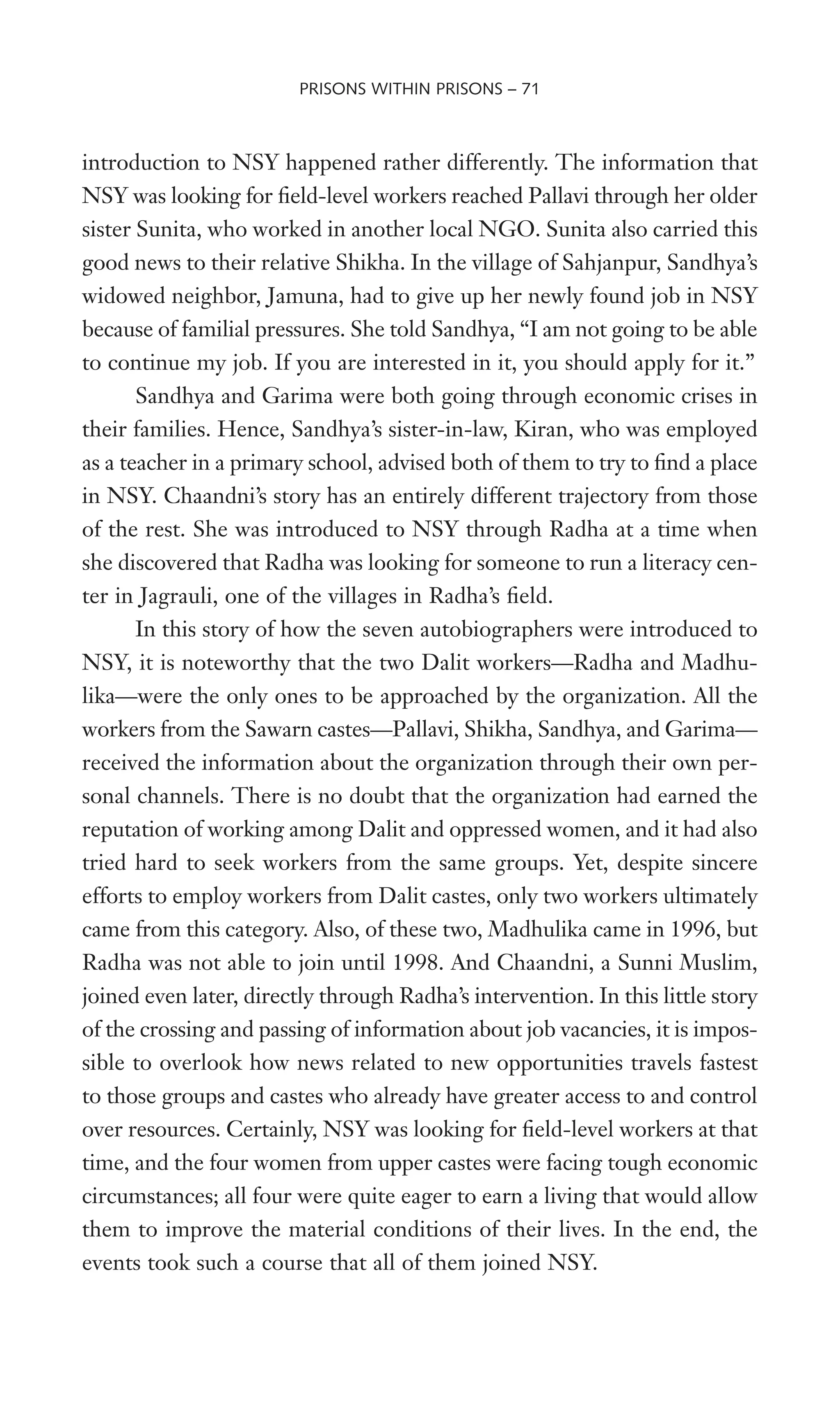
![And Thus We Stepped Out of Our Cages
All of us had long harbored the desire to work outside our homes. Oppor-
tunities also came our way. But so did countless hurdles! The Wrst step
in the journey was to wrench ourselves out of the worry that no one would
give jobs to poor or less-educated women like us. When we untangled
ourselves from this fear, the opposition of our family members was wait-
ing to greet us. In every home, the same logic was used to deter us: What
will people say if you start working outside?
Notwithstanding the enormous distances of caste and religion that
separated us, several of us faced similar strictness of purdah in our homes,
even if the reasons behind the restrictions imposed on us varied radically.
For Chaandni, it was impossible even to imagine that she would get her
family’s permission to run a literacy center in another village. First, it
involved working with Hindus day and night. Second, she would have to
travel alone for miles every day.
Burdened by the hollow values of upper-caste respectability and
familial honor, Shikha was cooped up in such a cursed cage that she could
not even open the windows in her home to look outside. Although her fam-
ily was more prosperous than the other six, the purdah that she faced was
also the most restrictive. She remained in purdah even around the domes-
tic workers. All of this enabled the members of her sasural to proudly boast
that no one could even get a glimpse of their Bahu’s face! Such traps of
respectability and honor continued to stiXe Shikha for ten years after her
marriage, even when she became a mother of three. We can only imagine
how challenging her struggle to break those prison walls must have been.
In our villages, the upper-caste folks often mock the purdah of the
Dalits by saying: “Is their purdah any purdah? Today the doli [bridal palan-
quin] has gone; tomorrow the bride is cutting grass in her rags!” This
proverb captures the irony of many realities, but it is hardly applicable in
all situations. For one, it did not apply to Radha. The purdah in Radha’s
home was so strict that she wasn’t even allowed to sit among women of
her own extended family. Whenever anyone entered the house from the
outside, she had to leave and hide herself inside. The cause of this purdah,
however, was not a false show of respectability but the fear residing in the
72 – PRISONS WITHIN PRISONS](https://image.slidesharecdn.com/playing-20with-20fire-20book-140402052849-phpapp01/75/Playing-with-fire-book-121-2048.jpg)
![hearts of her parents-in-law that if Radha were not prevented from meet-
ing people, she would be tricked by others into leaving her sasural and
return to her mayaka.
In such circumstances, obtaining the consent of our family members
to work outside seemed like an impossible task to some of us. On top of
that, women from our neighborhoods were not making things any easier.
They did not miss a single opportunity to sneer at us: “If our daughter-in-
law had gotten out of control like this, we would have broken her limbs!”
Such comments served to add fuel to the Wre. In Pallavi’s home, her
father-in-law got so enraged about the wounding of his family’s honor that
all hell broke loose. His wife fully supported him. A similar situation
prevailed in Madhulika’s home; her Devar, who was himself unemployed,
could not digest the idea of his Bhabhi having a job. When Madhulika
returned home from her Wrst ofWcial meeting, she was carrying a diary
that she had received from NSY. At that time, some of her Devar’s money
was kept in the house. When the Devar saw her diary, he assumed with-
out asking that Madhulika had given away his money in a bribe to get a
job. This misunderstanding exploded into a big Wght. In the initial phase,
when Madhulika had to travel to faraway villages for her work, her fam-
ily members refused to support her at all.
Despite these familial restrictions and hostilities, it would be inac-
curate to say that each one of us confronted similar kinds of opposition.
Sandhya, Garima, and Shikha faced far fewer restrictions from their hus-
bands and considerably more support for outside employment than did
Pallavi, Radha, and Madhulika, whose husbands openly confronted them.
Chaandni’s circumstances were relatively more complicated. From
the very beginning, Chaandni was in the habit of earning a small income
through her weaving. She writes, “I used to get depressed when I didn’t
have any money in my own hands.” In Chaandni’s sasural, the family relied
on farming instead of weaving, and Chaandni was completely inexperi-
enced in farmwork. Once she had an offer to work as a helper in the Aan-
ganwadi (government-funded preschool) program of her village. When
she sought her husband’s consent, she met an outright refusal: “I cannot
tolerate the idea of you fetching kids [for the Aanganwadi] from the homes
PRISONS WITHIN PRISONS – 73](https://image.slidesharecdn.com/playing-20with-20fire-20book-140402052849-phpapp01/75/Playing-with-fire-book-122-2048.jpg)
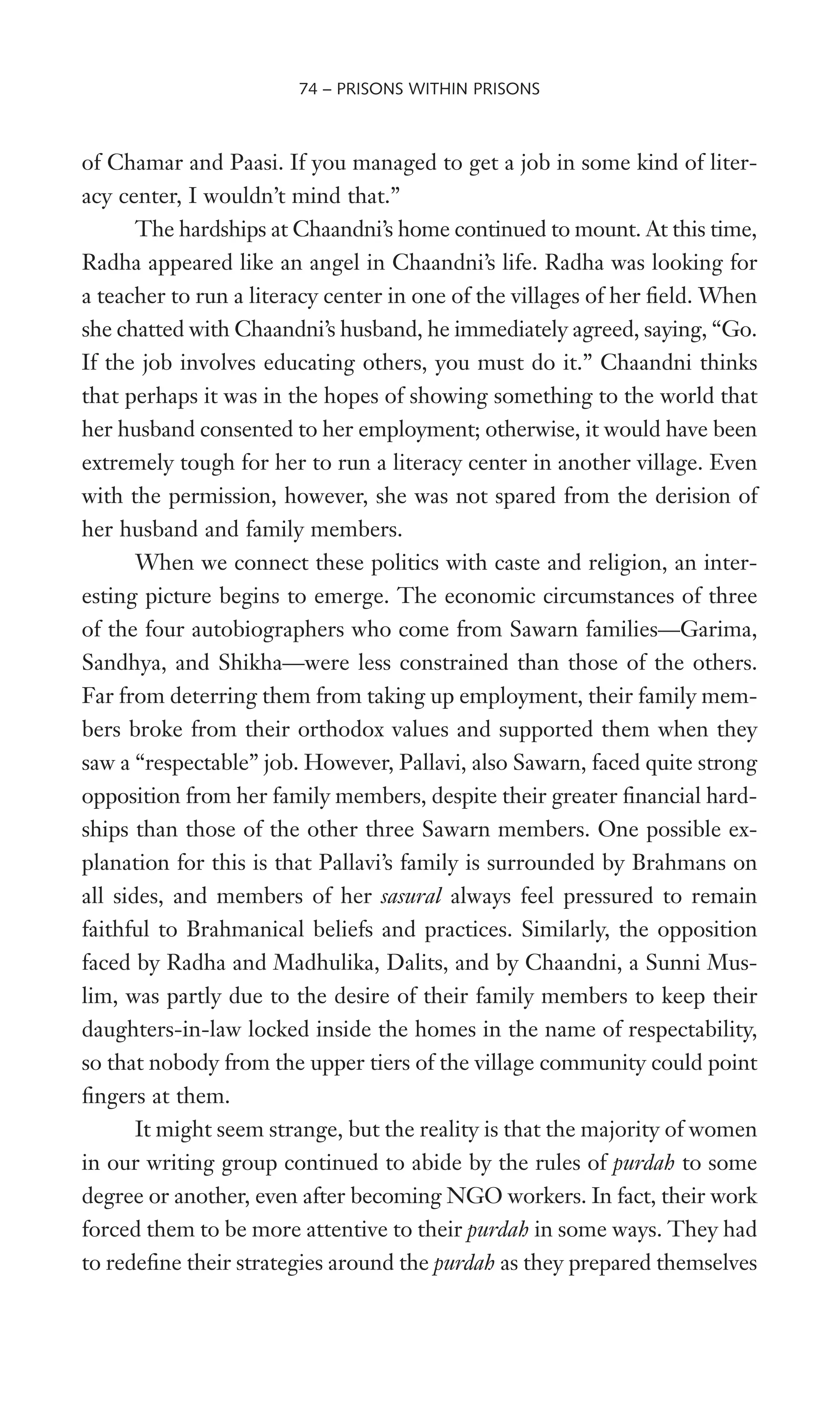

![inspired by the hollowness of government policies and rural development
programs. For instance, after her husband gave his consent to Radha’s
employment, his courage somehow began to slip. He said: “This is an
organization funded by foreigners. They will Wrst win people’s trust here
and then go and sell poor women overseas in the sex trade.” From the
day Radha stepped outside, her home became a war zone. Whenever she
had to go into another village, she became apprehensive: “How will I do
justice to my work here?”
It was simply her faith in Radha that led Chaandni to travel all the
way from her village to the district ofWce. She had heard many stories
about the attitude of the government toward poor Muslim women. When
she had to spend her Wrst night in the ofWce, Chaandni and her husband
were afraid that those who had given her the job would force her to be
sterilized. This fear caused Chaandni to take a neighbor with her. She
writes: “I was repeatedly haunted by the fear, ‘What will happen now?’
I could not sleep the whole night. The fear of losing my honor was all I
could think of.”
As we began to shed these deep-seated fears, another journey began
for us—the journey of identifying the notes of our mufXed voices, the
journey of turning our dreams into reality, the journey to give and take
power with our newly found vision and strength.
Garima, who started her career on daily wages in NSY, vividly re-
members her early days. Someone who was given the title of “dumb like
a cow” in her natal home, Garima cannot forget how difWcult it was for
her to break her silence. She writes: “Making my way through many bar-
riers, I came to Sitapur to start my job. My mother and daughter came
along. One of my uncles lives about a kilometer and a half away from the
ofWce in Roti Godam. We went to stay with him. I could not afford the
fares of the cycle rickshaw, so early in the morning I would walk from
his house to the ofWce. At the end of the day, too, I returned on foot. I
did not know the language of the city folks [Khadi Boli], so I even hes-
itated to speak in my own tongue. But as I walked on my way to and back
from work, I tried to speak with myself in the city tongue so that I could
get into the habit of speaking it.”
If Sandhya was intoxicated with something in the early days of work,
76 – PRISONS WITHIN PRISONS](https://image.slidesharecdn.com/playing-20with-20fire-20book-140402052849-phpapp01/75/Playing-with-fire-book-125-2048.jpg)
![it was with the desire to prove herself. Because Sandhya was not selected
for the position of a Weld-level worker, she tried hard to get just about
any work in NSY. After her continual efforts, she had a chance to over-
see a literacy center. Sandhya felt tremendous satisfaction from this work,
but the salary was so little that she was ashamed of even telling her fam-
ily about it. She was also afraid that she might be removed from her posi-
tion after the one-month trial period was over. How would she show her
face to her family then? In the end, Sandhya focused all her energies on
the literacy center. She decided that no matter what happened, she would
show everyone that she could do good and solid work on the ground.
Once we began our work, it did not take very long for us Wgure out
that what we had started could not be labeled simply as a nine-to-Wve
job that fetched us a monthly salary. It was not a mere job; it was a com-
mitment to drown ourselves in a struggle. At Wrst, Pallavi assumed that
her job as a Weldworker would be similar to the work that others did in
Aanganwadi or in informal literacy programs. But she soon dropped this
illusion. She realized that this was a job that demanded labor and com-
mitment. Madhulika’s attitude also changed quickly. She writes: “When
I Wrst joined this program, I thought it would be just like everyone else’s
job. . . . We will work one day and stay home for the next four. I did not
have the slightest inkling that this was not just a job I had begun; it was
actually ‘community work.’”
The Chains of Casteism: So Cruel, So Poisonous!
I used to think that [NSY] was just for Harijans, but there are people of all
castes here, and most are Pandits. . . . Wherever you see from the ofWce
to the Weld, you will rarely Wnd a Harijan. . . . In our meetings, there were
many discussions about caste difference. . . . But afterward, when we were
“released” from work, people would get angry—“If I come from a high
caste, how is that my fault? They should send all these lower-caste people
to eat in the homes of castes who are even lower than them. Then we will
Wnd out the truth.” All this talk Wlled me with pain. I used to think . . . ,
“If I hadn’t chosen to work here, no one could make me listen to this bit-
terness.” (from Madhulika’s diary)
PRISONS WITHIN PRISONS – 77](https://image.slidesharecdn.com/playing-20with-20fire-20book-140402052849-phpapp01/75/Playing-with-fire-book-126-2048.jpg)
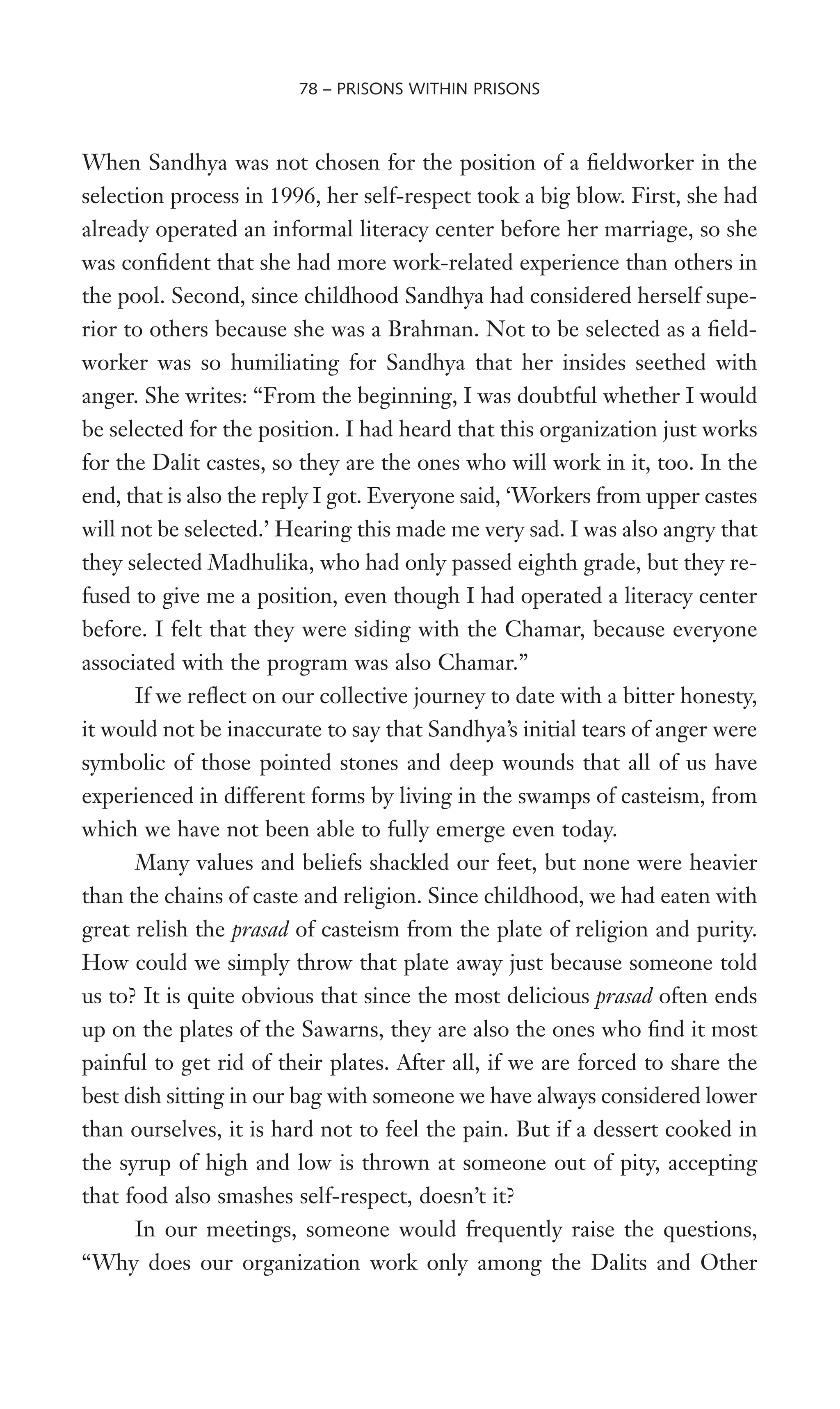
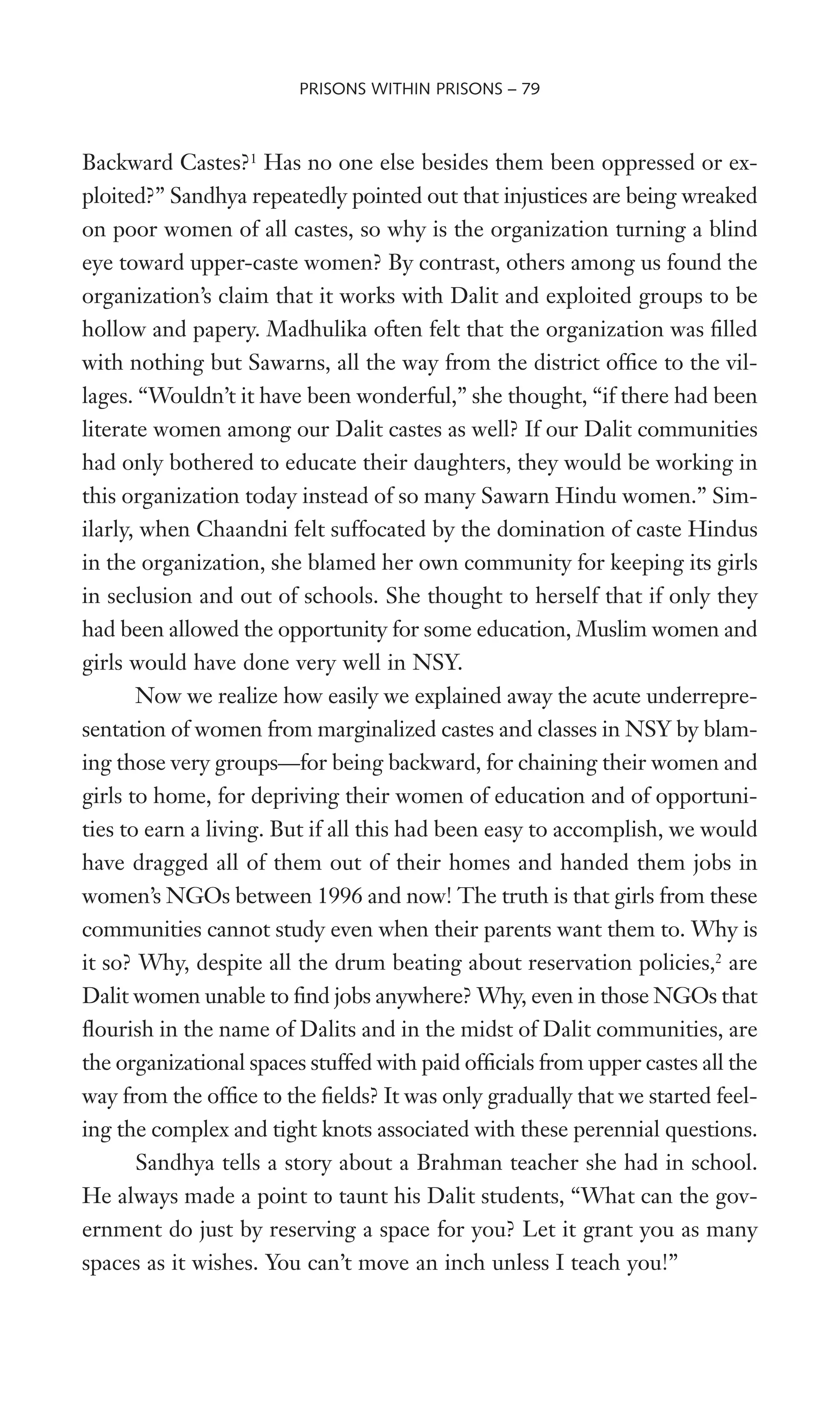

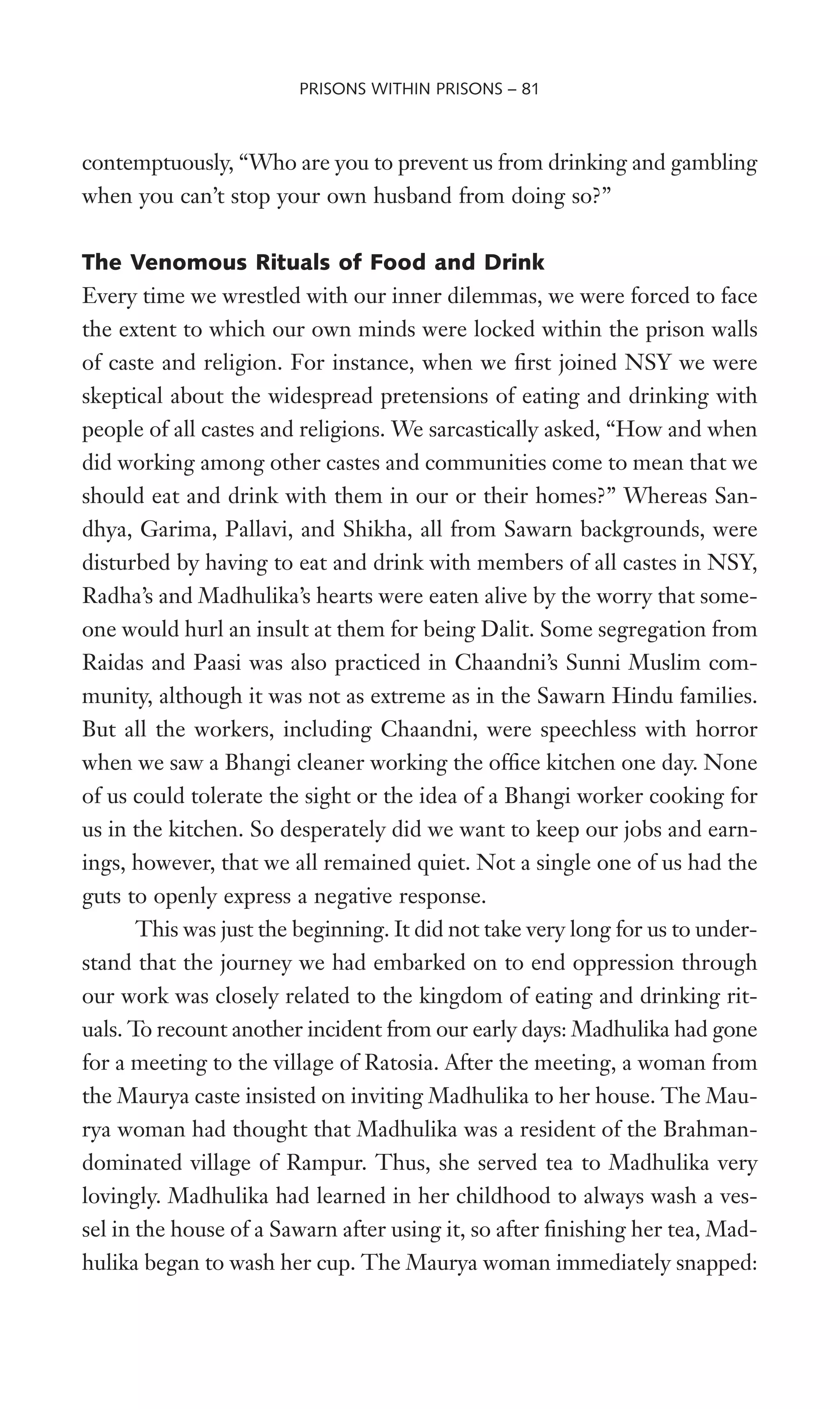
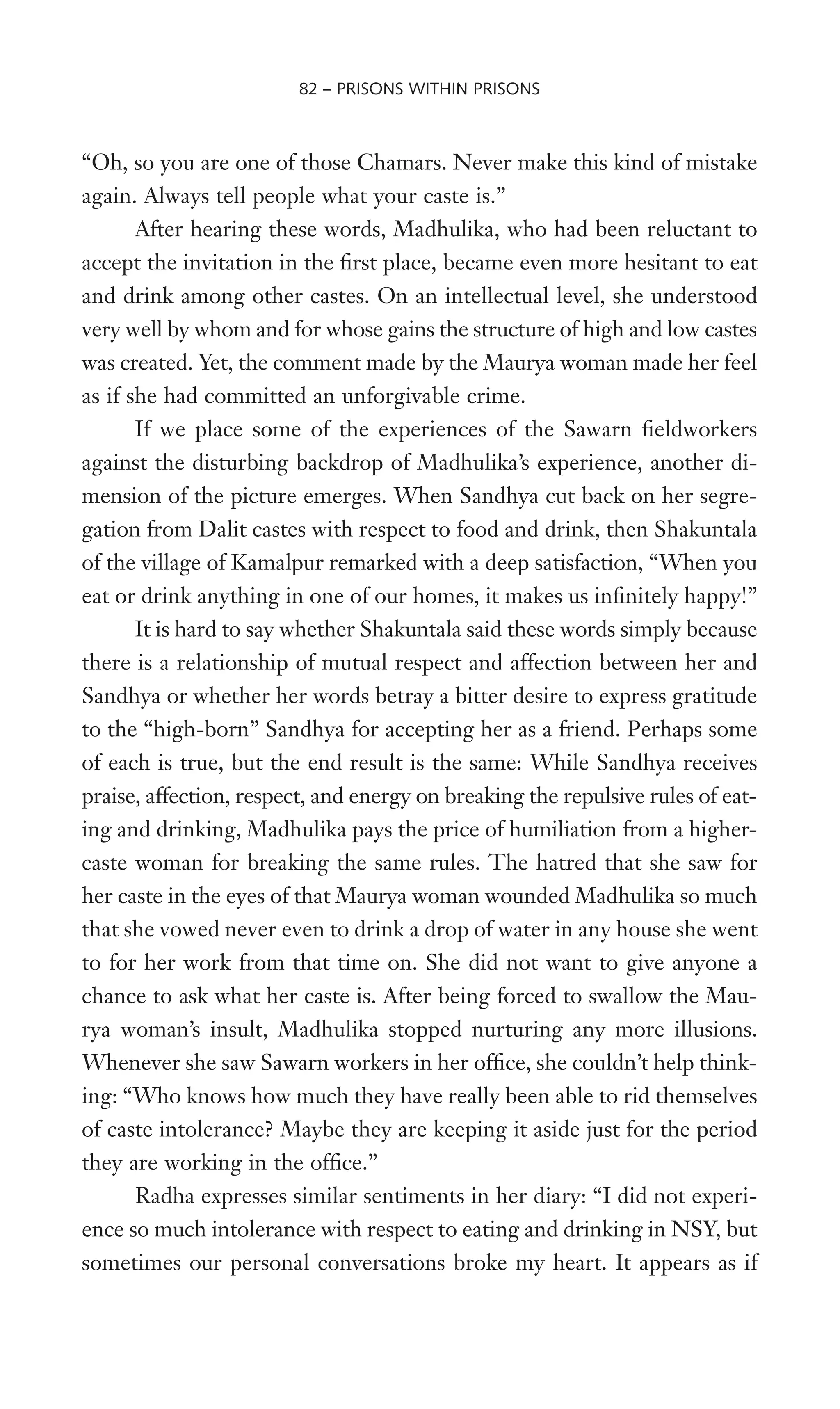


![Even Radha, who had suffered horrible forms of caste discrimina-
tion, could not remain untouched by the hatred against Muslims: “What
I had learned before was that followers of Islam are very harsh people.
They are always united, and they do not have any respect for the Hin-
dus. . . . Whenever I saw a woman covered in a black burqa from head
to toe, I used to tremble at the thought of how these people’s behavior
must be. My heart was Wlled with the idea that Muslims are very Wlthy
people. We should not even drink water in their homes.”
Madhulika writes: “In my home, members of the Muslim commu-
nity visited frequently. We socialized with them but did not eat or drink
with them. We were told, ‘Don’t go inside their homes. Don’t eat or drink
in their places.’ Amma used to say, ‘These people are very dirty. They
use water when they urinate, but when they go for a bowel movement,
they just use toti wala lota [a small pitcher with a spout]. They don’t even
wash their hands.’”
When Madhulika, who was brought up on these ideas, joined the
women’s organization, she became friends with a woman called Noor. In
the initial Wve years Noor was the only Weldworker in the program from
a Muslim community. Madhulika spent a lot of time in Noor’s house.
Noor also visited Madhulika’s home in relation to work. Whenever Noor
was asked to eat in Madhulika’s home, she did. But Madhulika found it
hard to eat in Noor’s home. Noor was familiar with the attitudes of Hin-
dus with respect to her religion, so she never insisted too much on eating.
A couple of times she asked Madhulika to eat, but Madhulika did not feel
like doing so.
Similarly, a man named Abid frequently visited Sandhya’s house
when she was a little girl. She called him Mama (uncle, as in mother’s
brother). He ate and drank in her home, but his vessels were always kept
aside. Once Sandhya went to Abid Mama’s home on the day of Eid. It was
a holiday. How could Mama send back his niece without feeding her some-
thing? With great affection, Mami (Abid’s wife) brought some sweets for
Sandhya to eat. She insisted, “Today, I won’t let you go without eating
something.”
Sandhya started crying. Her heart was seized by just one fear: “These
PRISONS WITHIN PRISONS – 85](https://image.slidesharecdn.com/playing-20with-20fire-20book-140402052849-phpapp01/75/Playing-with-fire-book-134-2048.jpg)
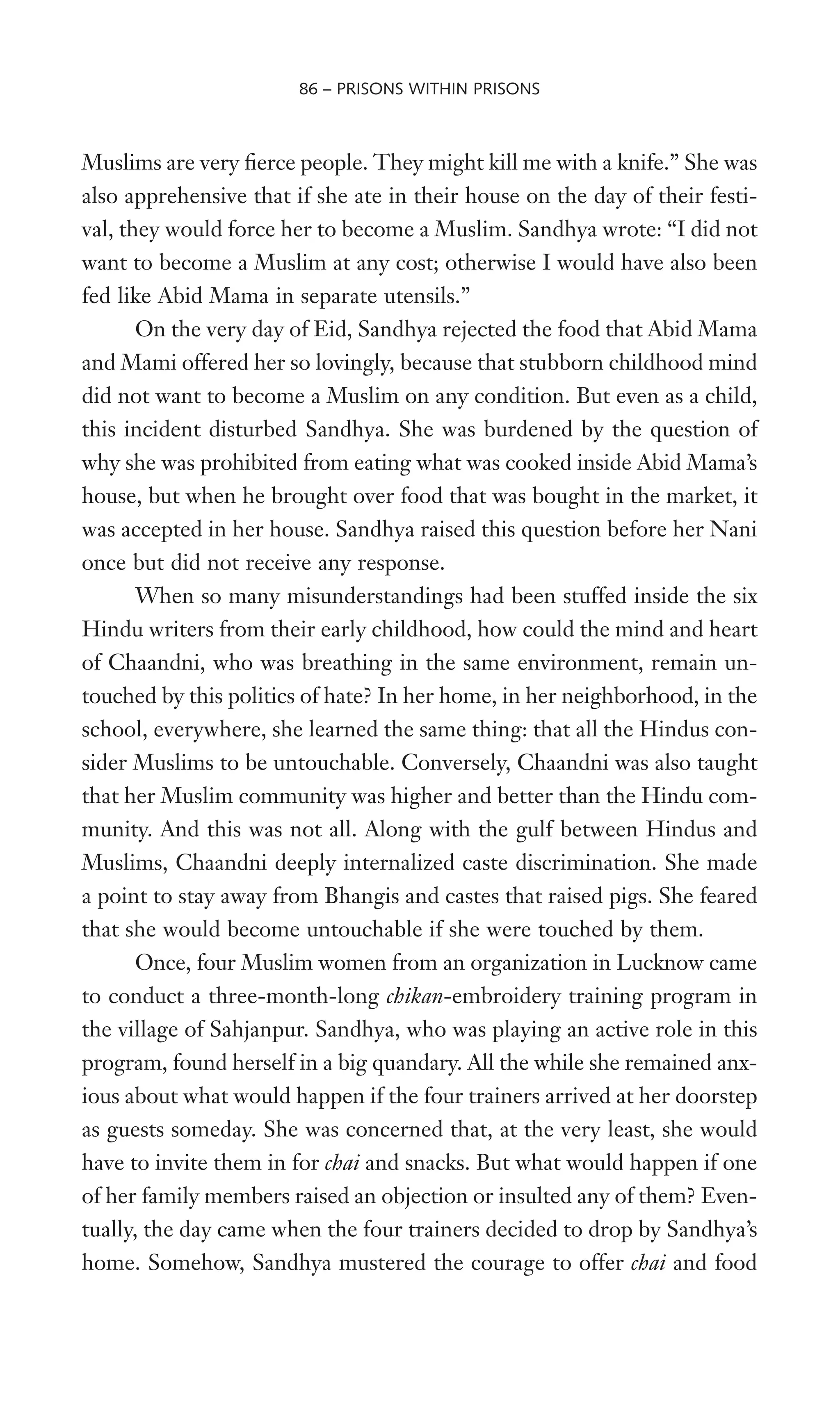
![in her own utensils. Her family members also found it impossible to say
anything against these esteemed visitors from the city, and everything was
over without any untoward incident.
This whole event forced Sandhya to reXect on religious intolerance
and class difference. She wondered whether she could have invited a Mus-
lim woman who was a manual laborer into her house and offered her tea
in her own vessels with the same kind of respect that she was able to
show to the trainers. Absolutely not. And it was here that we felt with an
unprecedented intensity the degree to which the politics of purity asso-
ciated with caste and religion are also inseparable from class discrimina-
tion. If a low-caste person is placed in a high position and is wealthy,
then the importance of his or her caste and religion diminish, and our
society is guided by money and status. Garima laughingly comments: “If
Mayawati were to invite them over for dinner right now, all the Thakurs
and Pandits would rush to her house.”3
But such superWcial egalitarianism
has its limits. For example, if an upper-caste district magistrate behaves
in a down-to-earth and unarrogant manner, everyone praises him for being
a good and simple man. If his position were to be taken by a Raidas,
however, the same people would say, “Oh, that Chamar! He is such a
dumb idiot.”
The Next Phase of the Journey
When I placed myself in the shoes of upper-caste people and thought about
a caste that was way below me [Bhangi], then I understood how, when, and
where others might feel hurt by the things I do. It is amazing how people
such as me, who are at the bottom, are also trapped in this structure. . . .
Will we ever be able to rid ourselves from the term untouchable? . . . Islam
[is] quite special in this respect. Muslims do not have anything like untouch-
ability, although there are many castes. (from Radha’s diary)
“We are opposed to casteism and communalism in every form.” This is
not merely a rule or principle in the women’s organizations with which
we have been associated; it constitutes one of their “nonnegotiable” points.
PRISONS WITHIN PRISONS – 87](https://image.slidesharecdn.com/playing-20with-20fire-20book-140402052849-phpapp01/75/Playing-with-fire-book-136-2048.jpg)


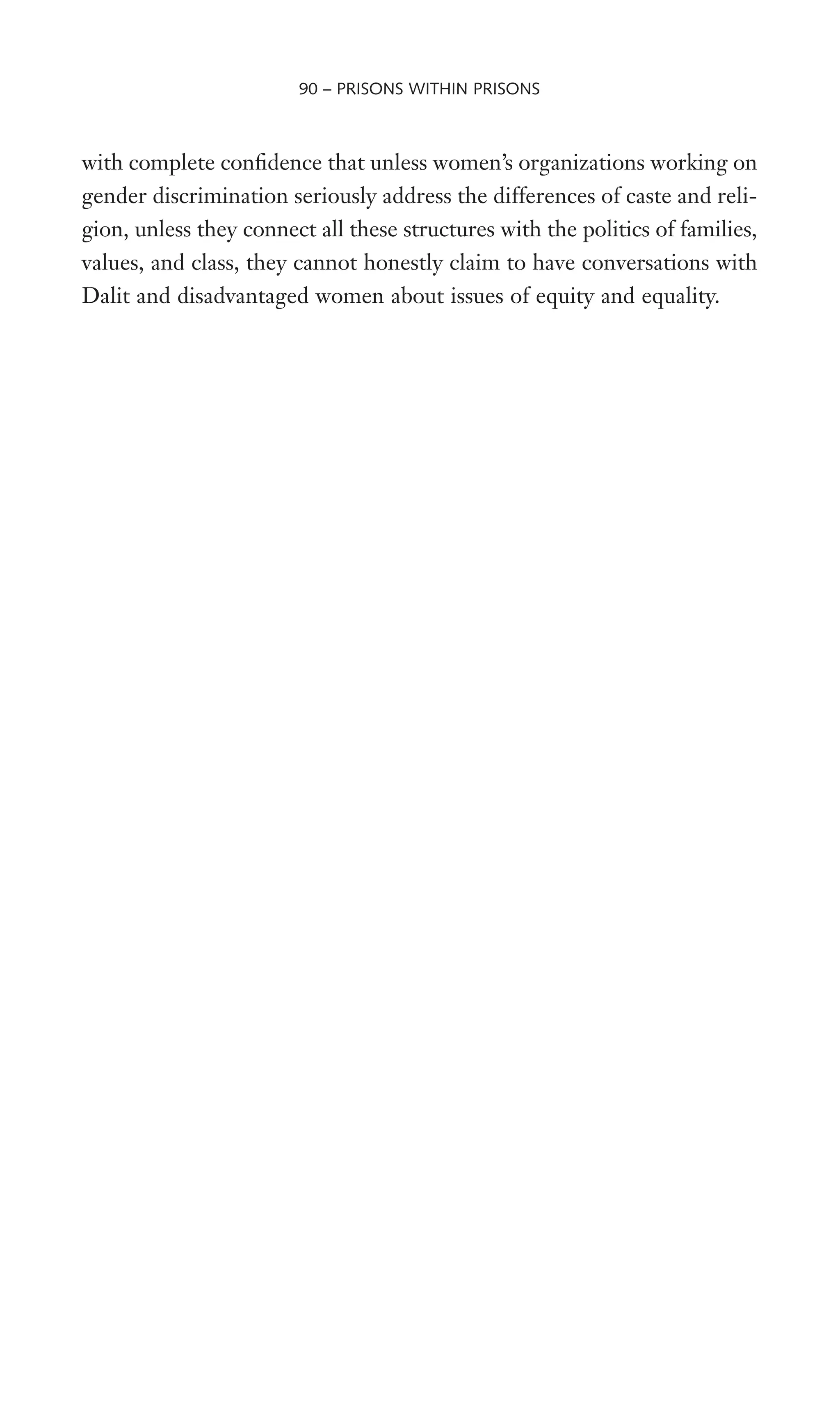
![People of my village often said with pity, “First, she doesn’t have a father;
second, her mind is too slow. In today’s world, [she] cannot survive.” But
there were reasons behind my silence. . . . When I was little, Amma told me
that . . . if Pitaji had remained quiet when he was being attacked . . . , it
would have saved our fate. . . . From that time on . . . , I vowed to remain
silent. . . . But when I started working, I found myself in an entirely differ-
ent environment. Whatever was inside me, I started saying it loudly. I for-
got what Amma had taught me. (from Sandhya’s diary)
From the beginning, I faced a lot of discrimination—do not go outside,
do not laugh, do not eat good food, do not talk back . . . but work like an
animal—whether at home or in the Welds. There were no rules against
working too hard. . . . During my early days at work . . . , I was fearful. I
couldn’t look others straight in the eye. But gradually, I left the fear behind.
Now, I am afraid of nothing. No matter who is before me, I cannot remain
silent. (from Madhulika’s diary)
Since I began working, I have traveled in approximately twenty districts.
I found opportunities to learn and teach. . . . My understanding of the
world grew—I learned about the kinds of social injustices that women are
subjected to . . . about the legal rights that ordinary people have or don’t
have. . . . As I learned . . . , I found strength and courage inside me—the
C H A P T E R 5
Cracking Cages, New Skies
91](https://image.slidesharecdn.com/playing-20with-20fire-20book-140402052849-phpapp01/75/Playing-with-fire-book-140-2048.jpg)
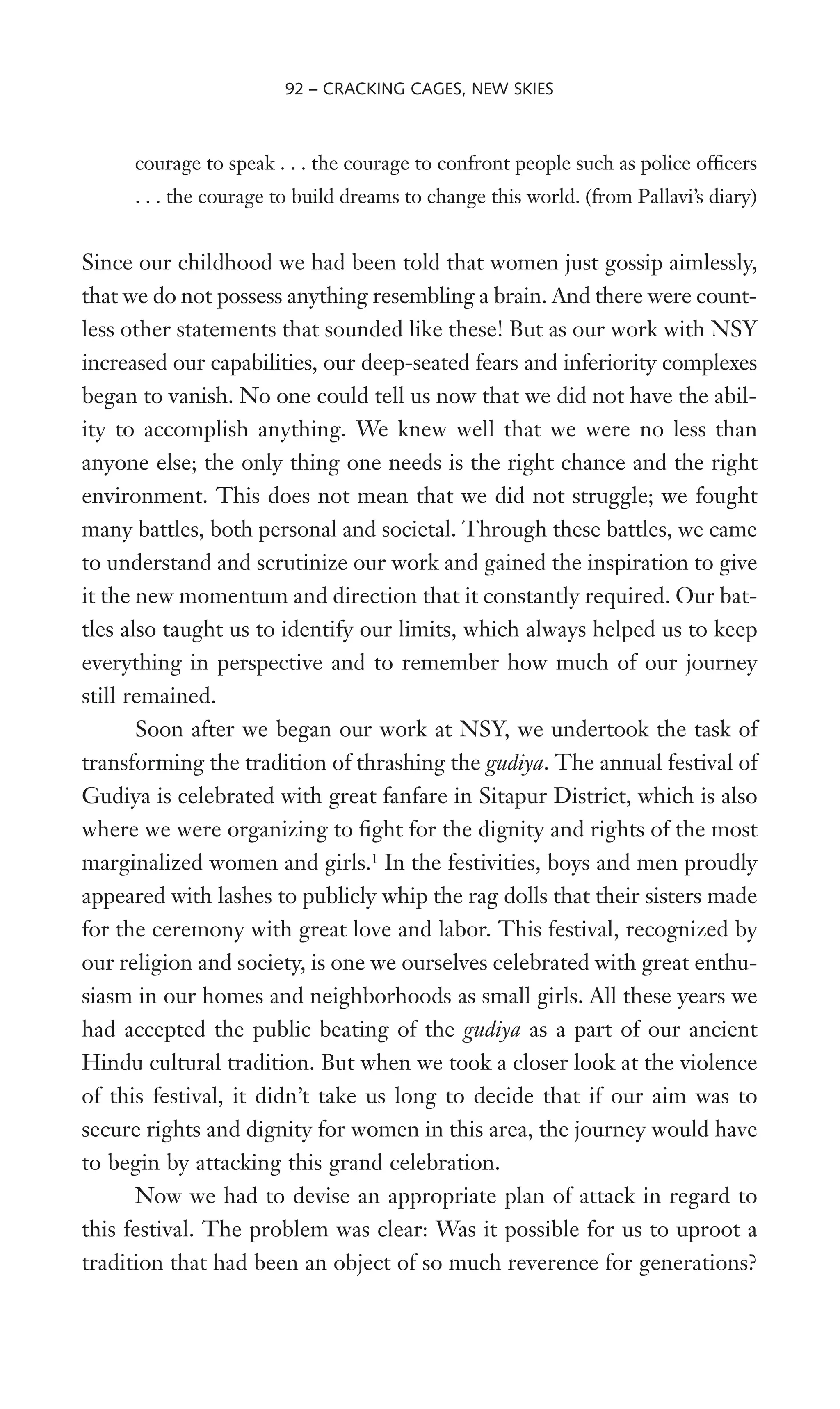
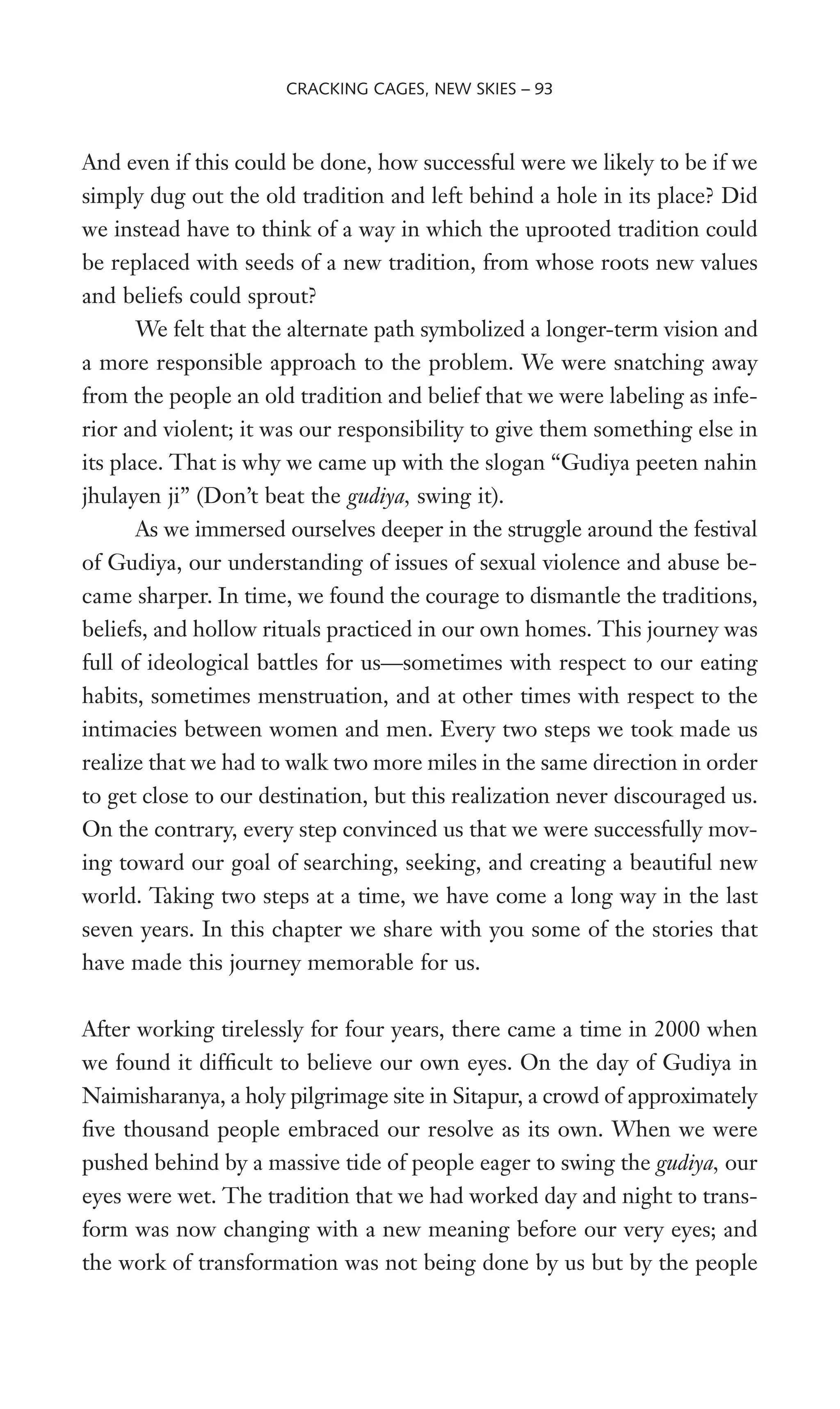
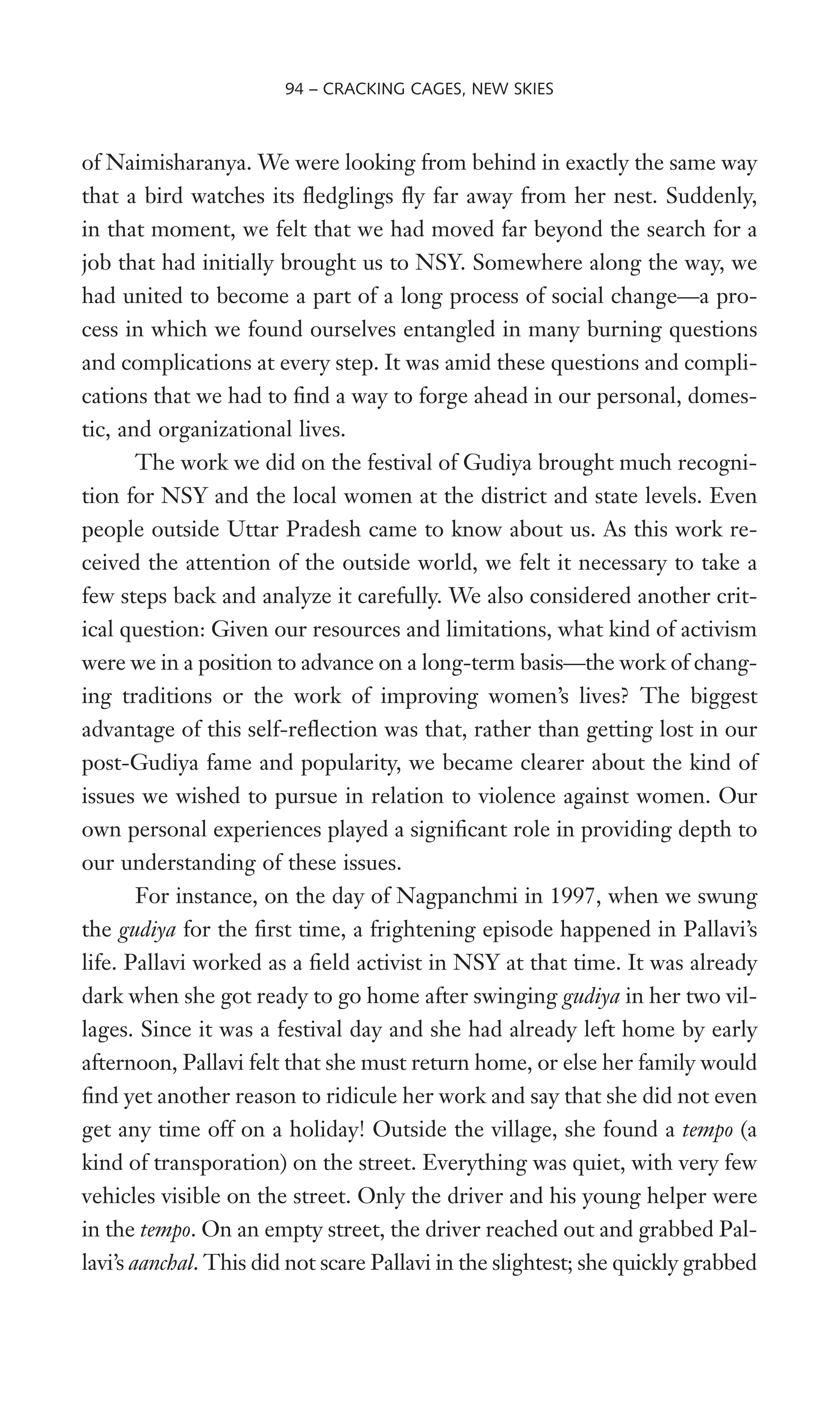
![the driver’s neck to hold him at bay and did not ease her grip until they
reached her village. Fortunately, the vehicle of the organization also passed
through the same place at that time, and Pallavi was saved from becom-
ing a victim of any serious crime. But she was constantly haunted by the
fear that if her family found out about this incident, they would prevent
her from working outside, and all the old problems of her life would start
all over again.
Whereas Pallavi hid this episode from her family because they would
have accused her of shaming their name and honor, the tempo driver nar-
rated it before his friends with great exaggeration and pride. In a Xash,
the whole community came to know that Pallavi was a victim of sexual
abuse. When this news reached us, we were enraged. After all, so many
girls and women remain imprisoned in their homes because of the same
fears of becoming victims of abuse and shaming their families as a result.
At that point, no one could stop us. Together, we located that tempo dri-
ver, and when we confronted him, one of us could not resist hitting him.
Ideologically, we are against physical violence as a way to address
our problems, but this kind of strong emotional response made it clear to
the community that, although we might be able tolerate other things, our
women’s organization had no room for sexual harassment of any kind.
Despite all our efforts to hide these events, Pallavi’s name became a sub-
ject of community gossip. Only a year had passed since Pallavi had started
working for NSY, and now this event shook her up and reminded her of
all that Wlth and horror that she had seen so closely as a child.
Pallavi writes in her diary: “I don’t know why I couldn’t gather the
strength to look anyone in the eye. . . . I was worried about what was to
come. What would I do if my husband threw me out of his house? Per-
haps I was thinking all this because I had taken up my job by going
against my family’s wishes. . . . My fear was that I would be ridiculed, and
on top of that, my name would be blackened for the rest of my life. My
husband refused to listen to me at any cost. Eventually, Didi [Richa Singh]
met and spoke with my family members, which saved me from a warlike
situation at home. . . . After Didi’s visit, no one in my household men-
tioned this episode again. This was the second big turn in my life.” What
CRACKING CAGES, NEW SKIES – 95](https://image.slidesharecdn.com/playing-20with-20fire-20book-140402052849-phpapp01/75/Playing-with-fire-book-144-2048.jpg)
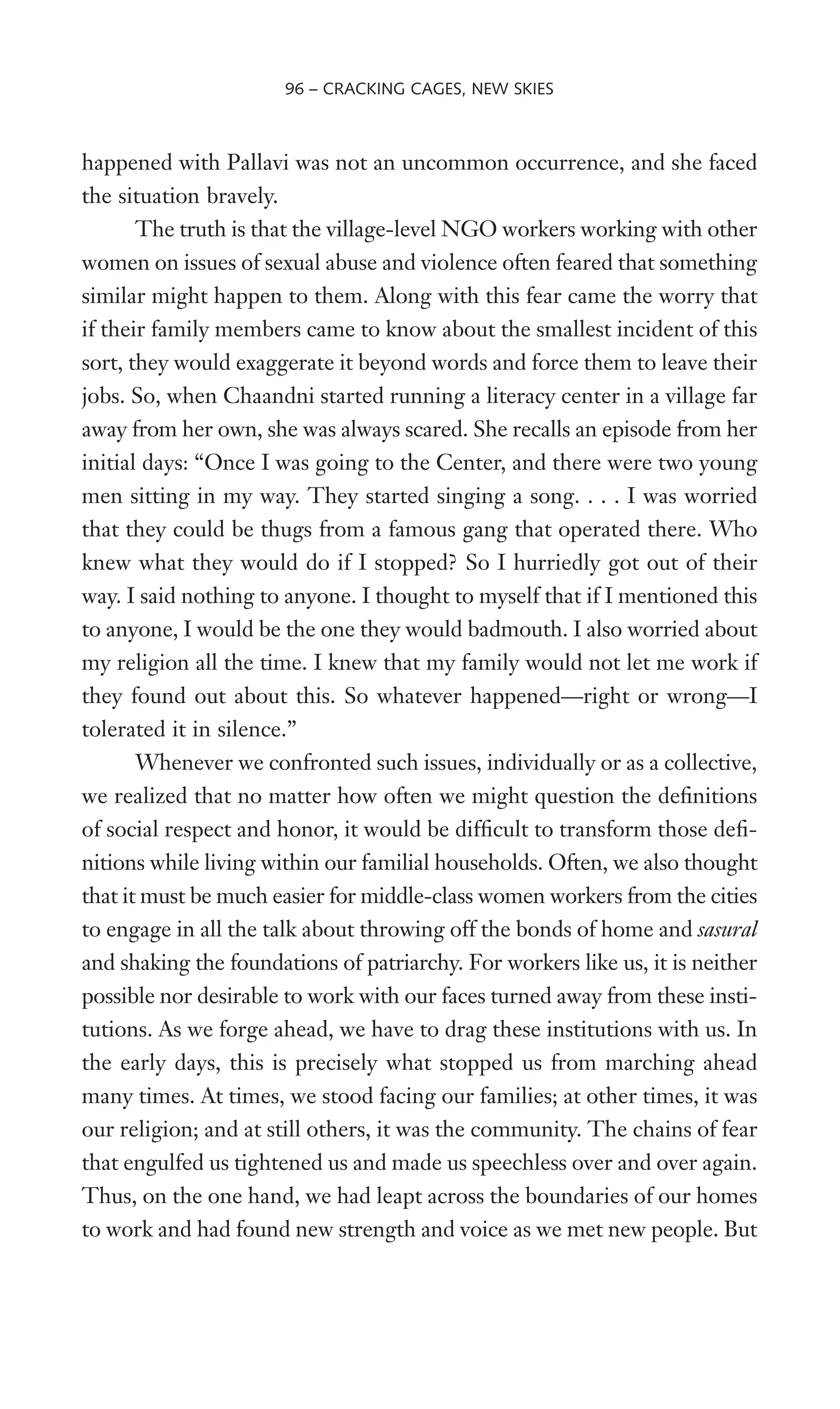
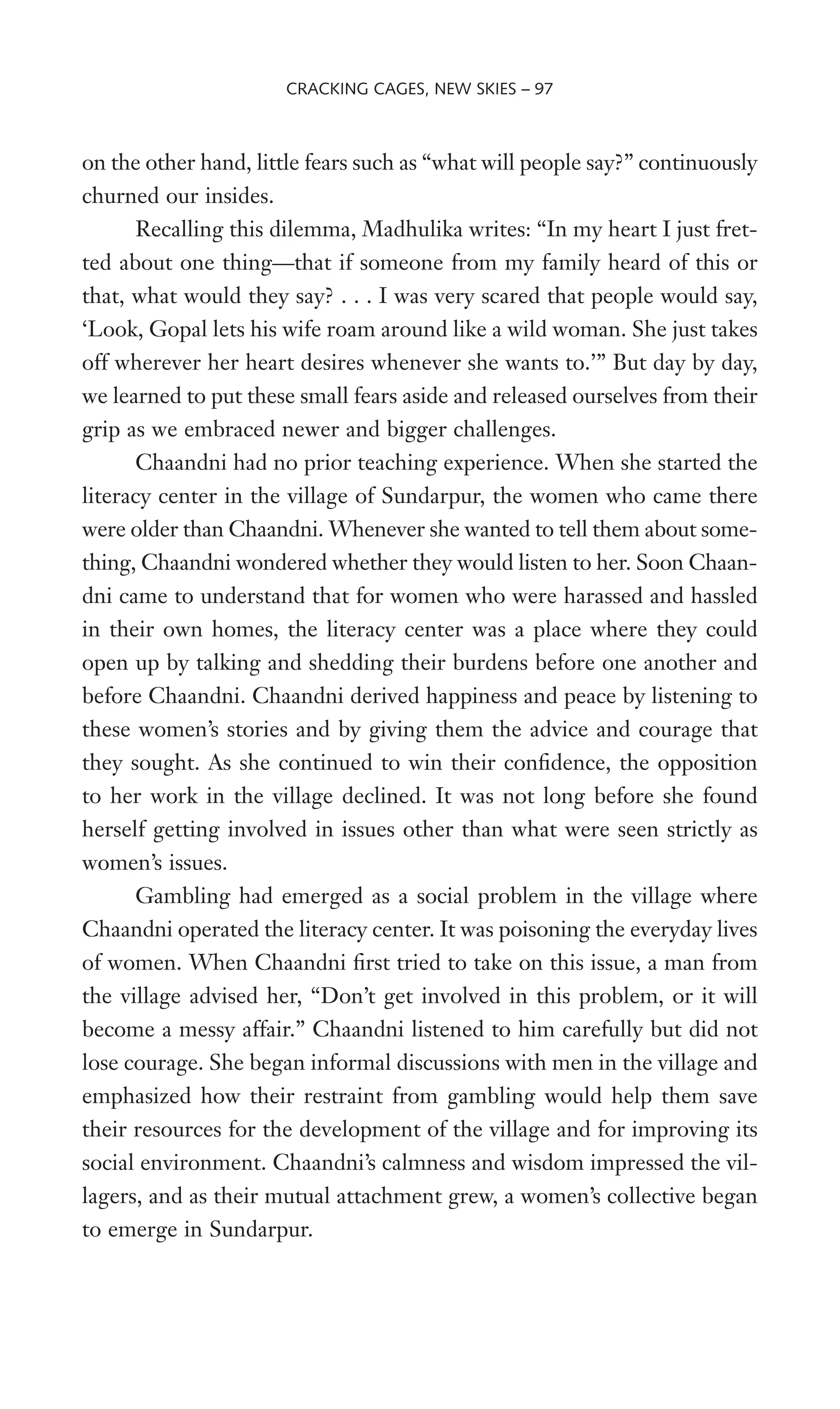

![they were not able to establish an identity outside their own villages. Gam-
bling and alcohol were two issues that affected the women of the entire
block. So with gambling and alcoholism as our focus, NSY organized its
very Wrst rally in Mishrikh. Village women were frequently used as objects
of decoration in the events organized by various political parties, but this
was the Wrst opportunity that women had ever had to organize their own
rally. It was a huge moment for us! There was a day not very long ago
when we were too shy even to say “namaste” to people we met in the vil-
lages we entered for the Wrst time. But here we were; to seize our rights
and to give birth to a transformed world, we had jumped into the lanes
and streets of Mishrikh to deliver our message with our voices raised.
Garima, who was known as a tongueless girl in her mayaka, writes
her memories of the excitement and adventure of the early days of work:
“Earlier, I used to bow my head when I talked to someone standing before
me . . . whether that person was a woman or man. Especially when it was
a man, I could never raise my head to speak. From my childhood, I had
felt pressures. I was taught never to talk back, never to answer back to
anyone. . . . But this did not continue. I changed; my attitude and behav-
ior changed. Working [with women], I found a new self-conWdence. I
came to believe that the work we were doing was good and important
work, and other people also respected it as such. This belief gave me the
courage to speak openly and clearly. I did not even notice when my fear
and hesitation vanished. While walking on the streets, too, I became fear-
less. Proudly, I began to walk everywhere at all times . . . speaking loudly
against violence and oppression at every step.”
Advancing amid Compromises
When I started working, my economic situation improved. . . . With it, I
also found within myself a new strength that I will never lose. I discovered
an amazing energy that propelled me to reXect further and further about
women’s conditions and circumstances. . . . This kind of thinking does
trigger conXicts between me and my husband, but it is no longer possible
for me to feel weak at heart. (from Radha’s diary)
CRACKING CAGES, NEW SKIES – 99](https://image.slidesharecdn.com/playing-20with-20fire-20book-140402052849-phpapp01/75/Playing-with-fire-book-148-2048.jpg)
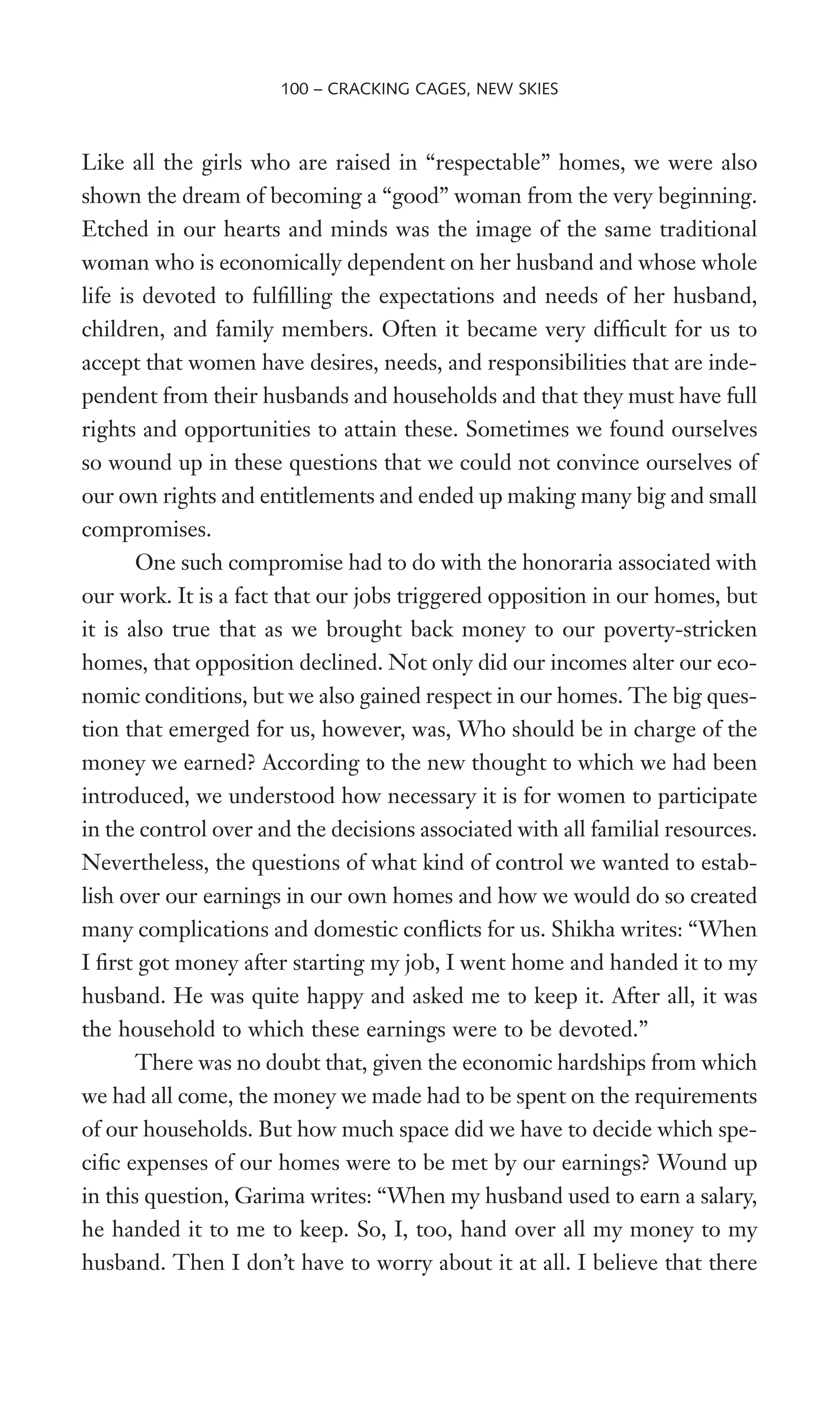
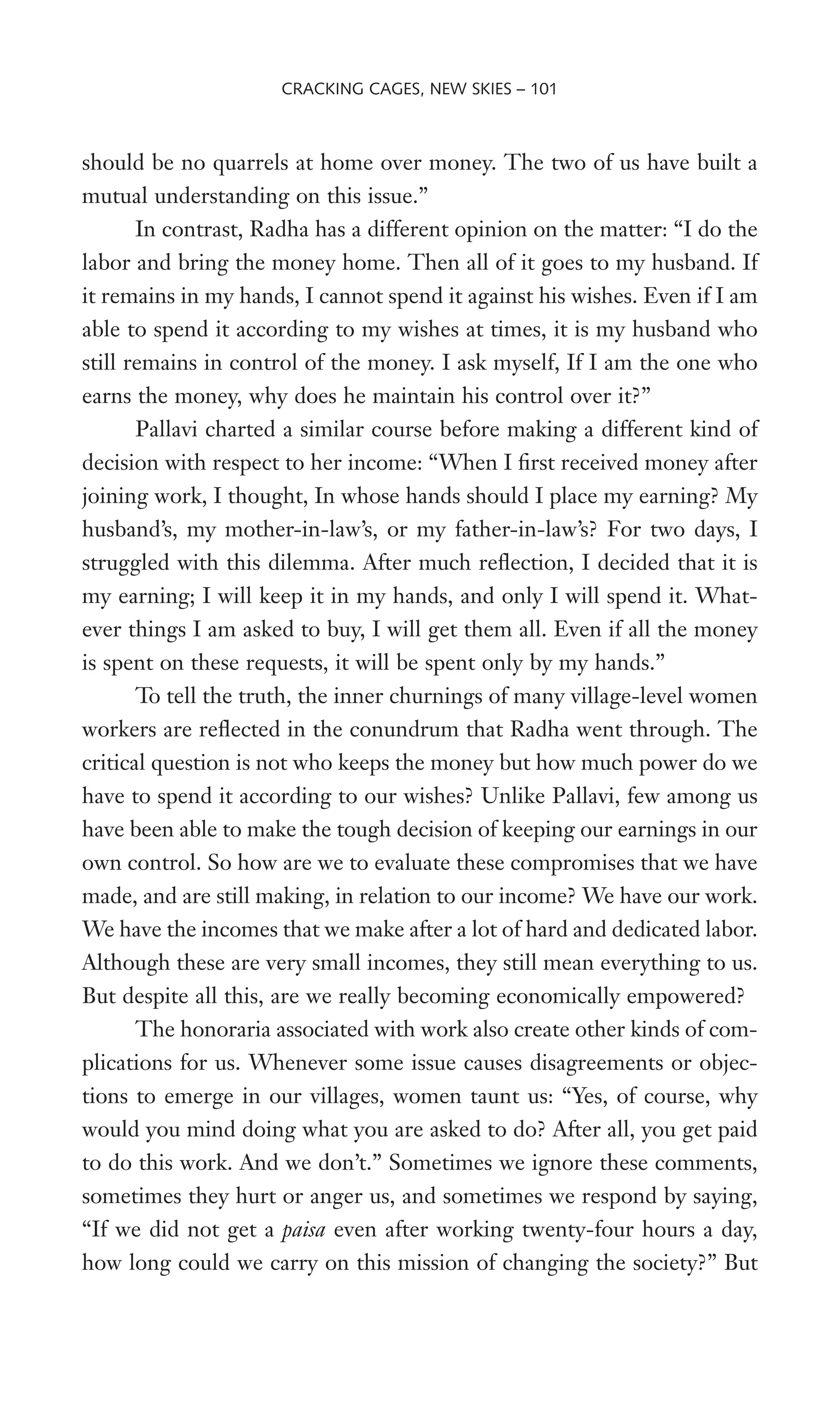
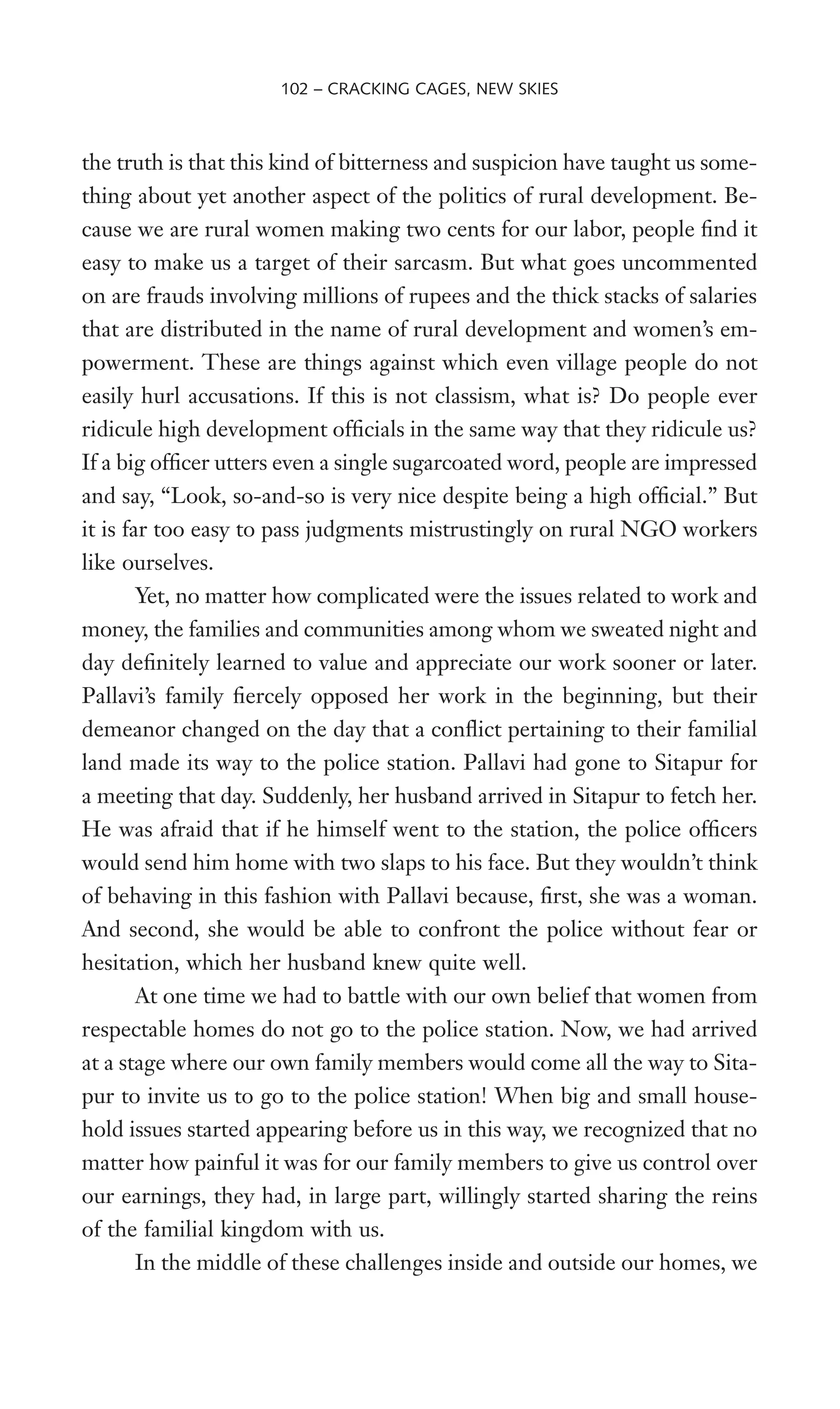
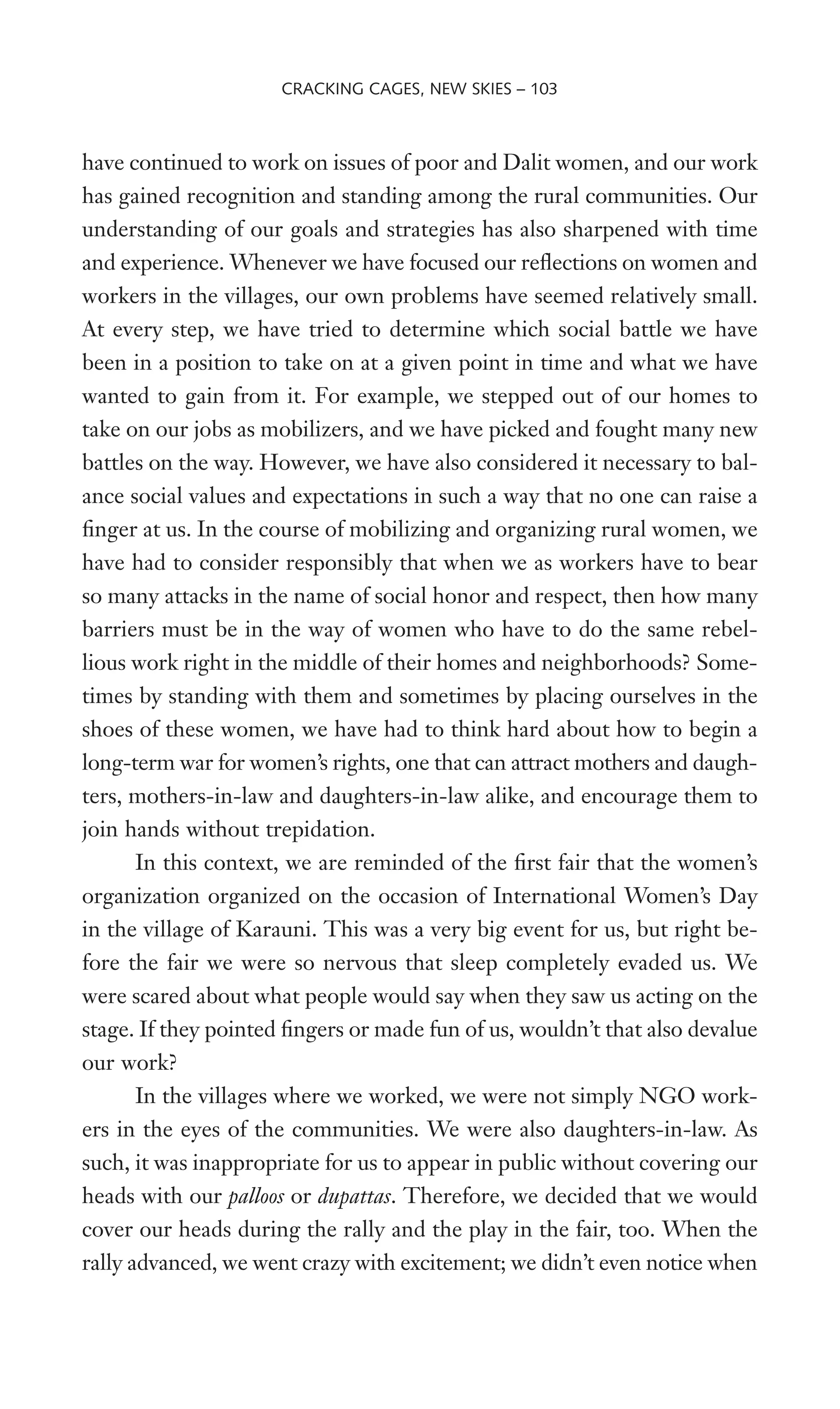
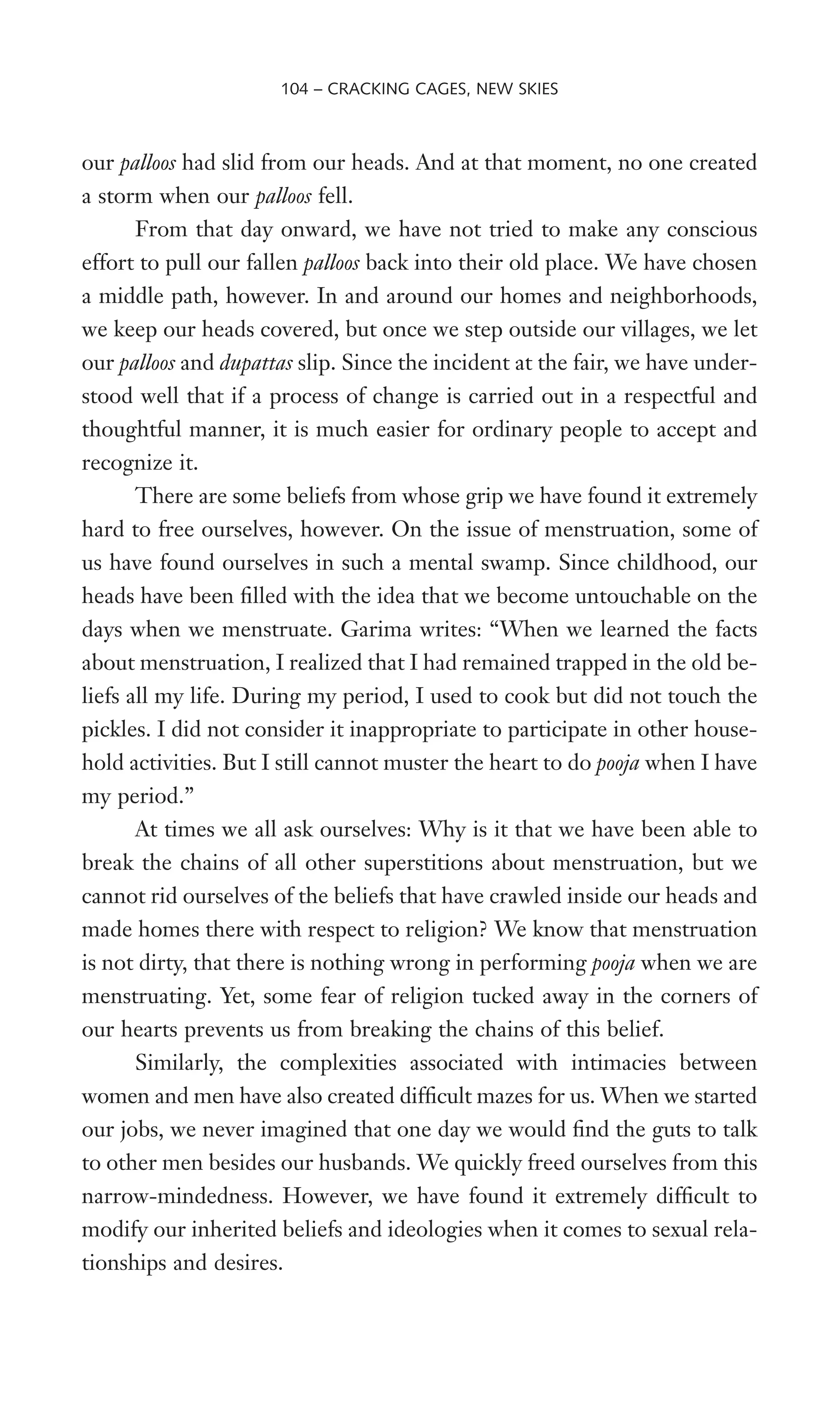
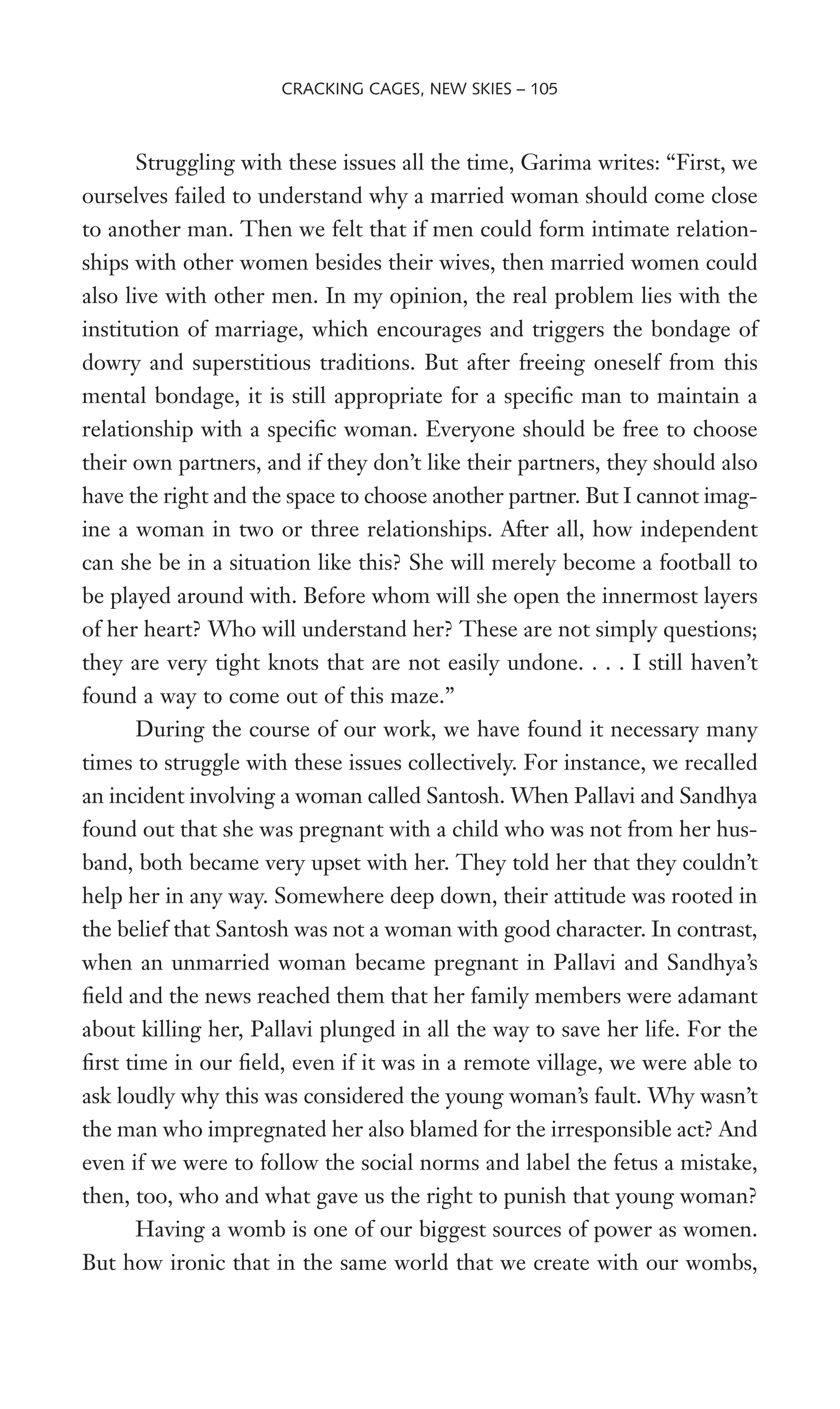
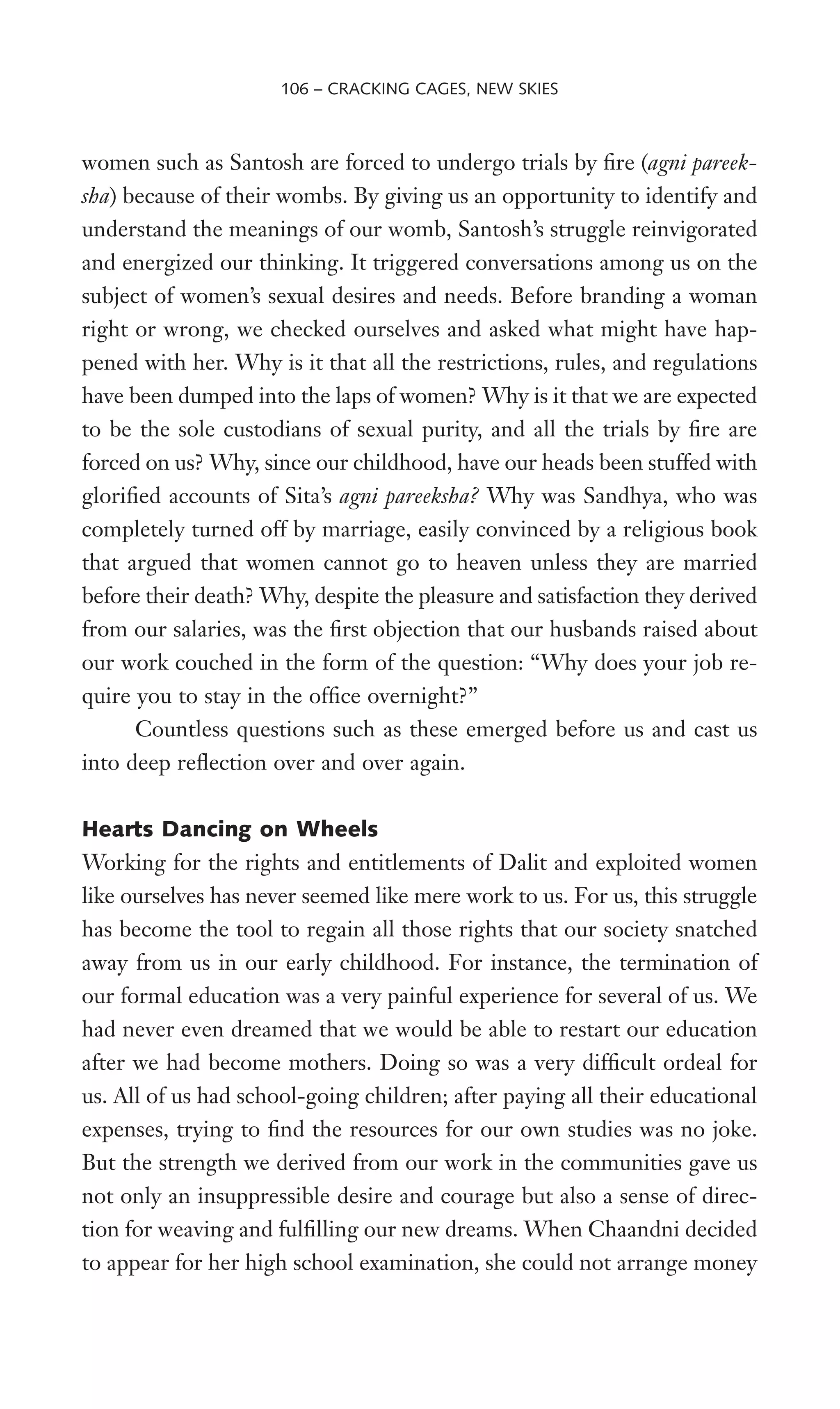
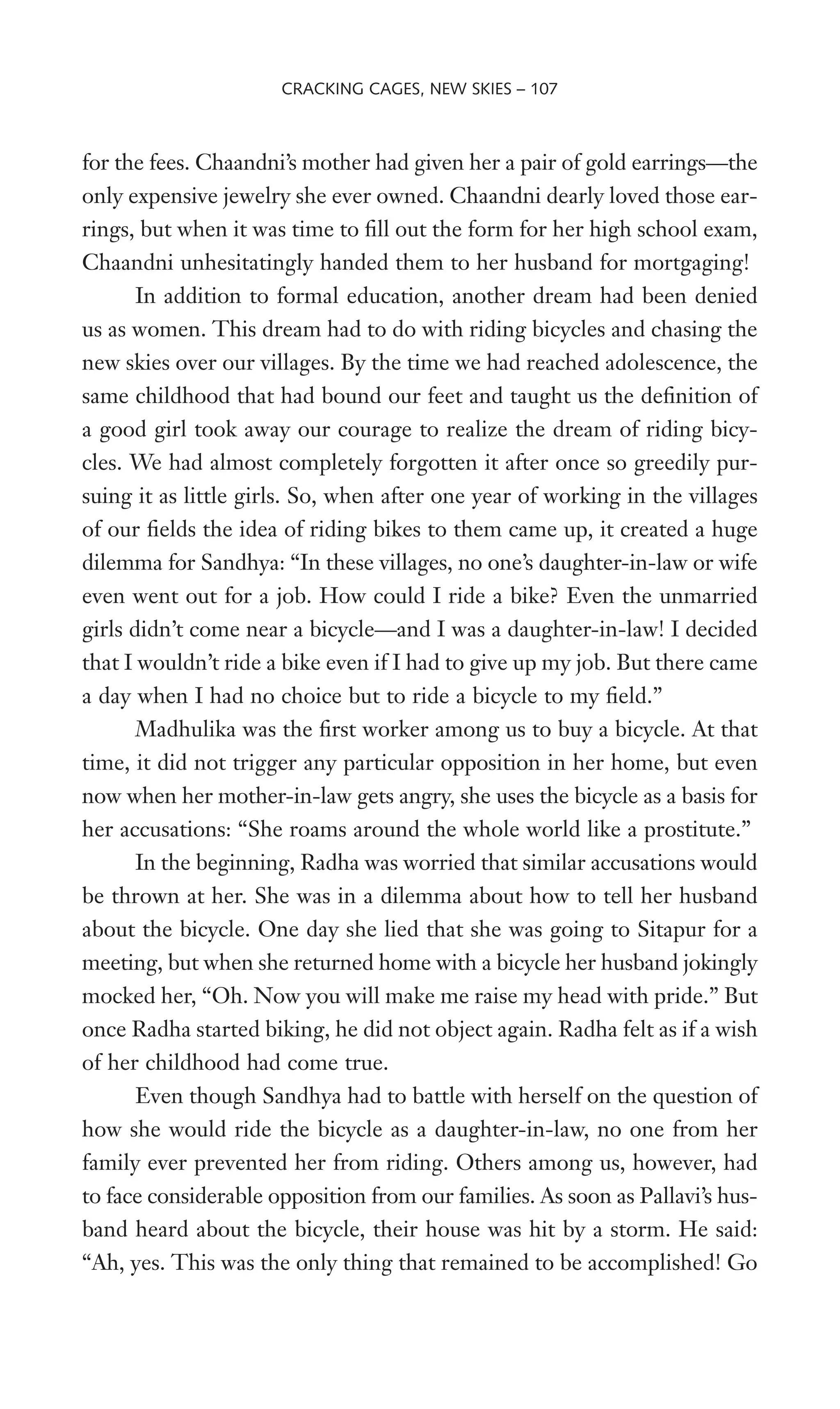
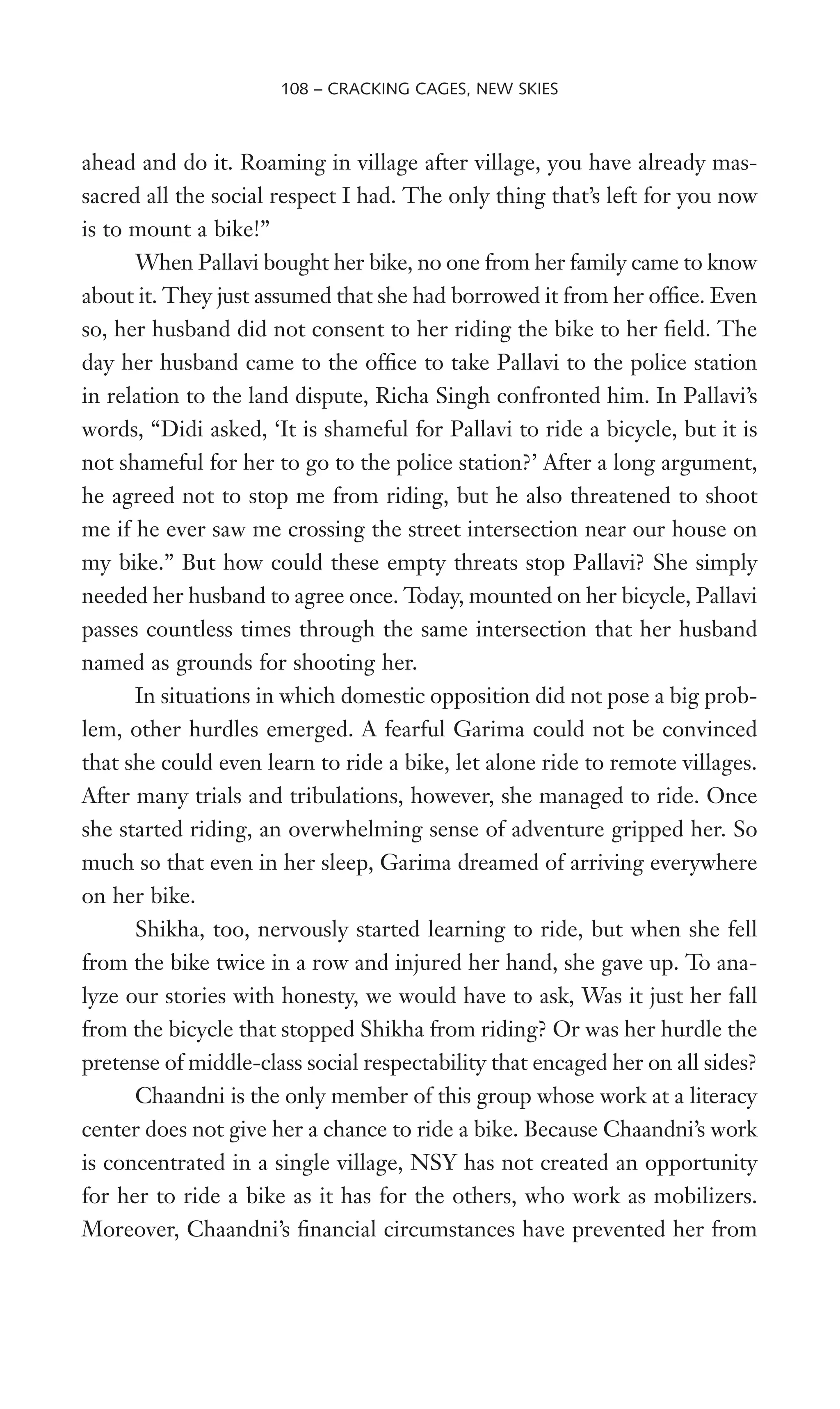
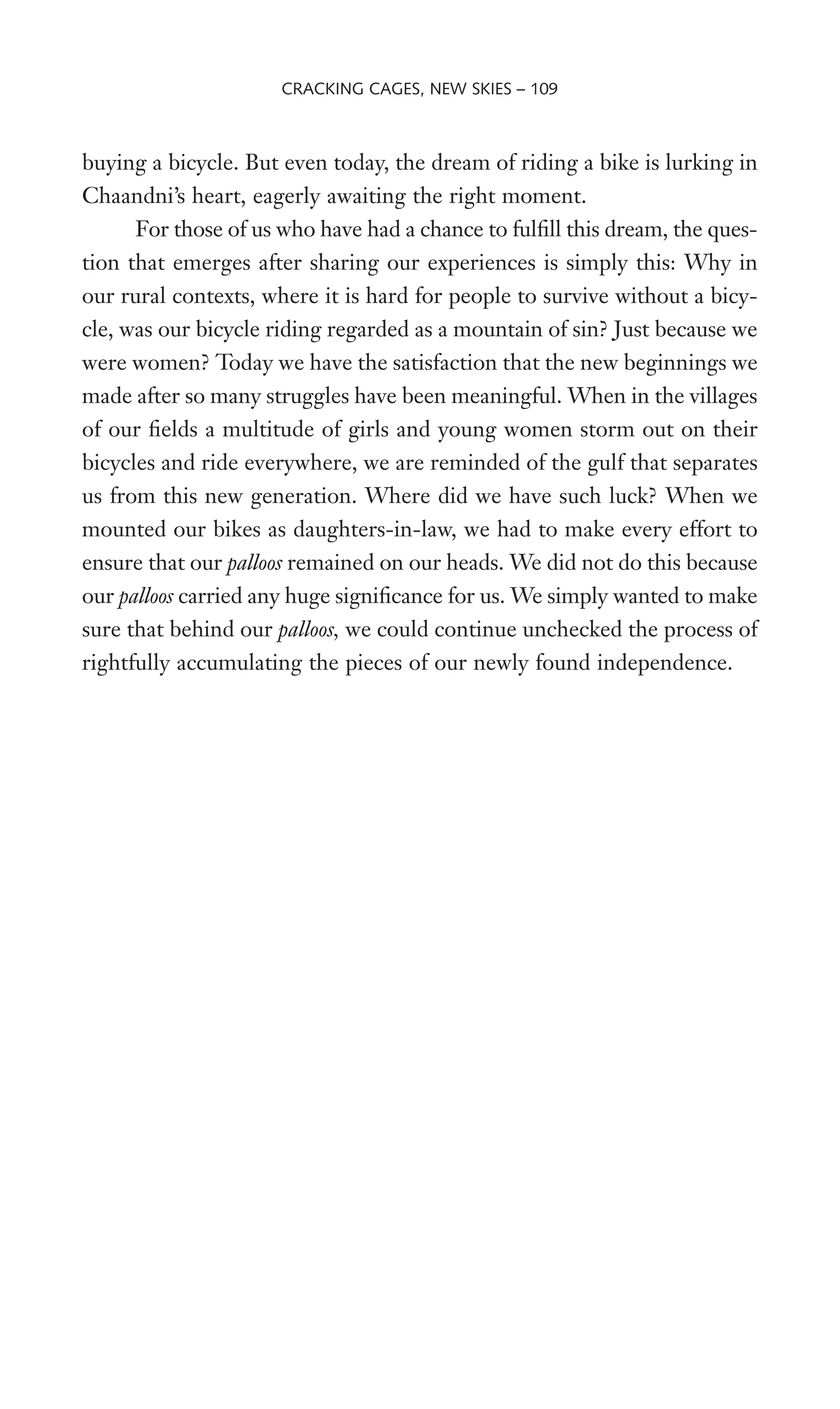
![After getting involved with this work, I have opened every tiny box tucked
away in my chest. All that I was never able to say before my mother, I have
said before this group. Now, my prayer to God is simply this:
O God, just do me this little favor: Make this work bigger than my
faith. (from Chaandni’s diary)
In the early days of starting work, I noticed that Didi also sat with us on
the dari. I wondered, “What kind of an ofWcer is she? In every other orga-
nization, there is always a separate seat for the ofWcer, but there is no such
thing here. In this program, every worker receives equal respect irrespec-
tive of the position she holds.” . . . But one day, I was forced to think dif-
ferently. I happened to sit in Didi’s seat while writing some notes, and
someone immediately asked me to get up. I was worried, “What will hap-
pen now? Will Didi scold me?” No such thing happened. But it became
clear to me that day that Didi has a special place that workers like myself
can never acquire in this structure. . . . In this program, everyone from the
top to the bottom has a different position in the hierarchy. Even when we
sit among women in the villages [supposedly as equals], we begin to look
and act according to our positions. (from Radha’s diary)
Hasn’t it been only six years since we Wrst learned to ride our bikes and
stormed the neighborhoods, streets, and villages of Sitapur? Who among
C H A P T E R 6
Challenges of NGOization and
Dreams of Sangtin
110](https://image.slidesharecdn.com/playing-20with-20fire-20book-140402052849-phpapp01/75/Playing-with-fire-book-159-2048.jpg)

![There was a time when our whole lives were imprisoned in our own
homes. But our new vision altered our world. As we stepped outside our
homes, we started speaking with conWdence. We encouraged the women
with whom we worked to Wnd the same strength and force inside them-
selves. But the shocks came when we began to recognize from up close the
inequalities of rank and class that were embedded in our organizational
structures; sometimes these inequalities were related to us, sometimes to
the ordinary village women, and sometimes to the big and small organiza-
tions trapped in the complex web of NGOs. At times, these inequalities
make us so confused and bitter that we lose the conWdence to tread our
future paths independently and on our own terms and conditions. Through
Sangtin Yatra, we have made a Wrst attempt to systematically analyze the
dilemmas and complexities of hierarchization and NGOization, so that
this process can guide our vision and thought for the next phase of our
journey. In this chapter, we share some fragments of the battles we have
had with these difWcult questions in our journey thus far.
Mazes of Rank, Hierarchy, and Classism
An educated city woman who teaches in my literacy center knocked on my
door this morning. She was surprised to see me looking like an ordinary
village woman: “Look at you! Who will say that you are an NGO worker?
Why don’t you maintain the same appearance here that you do at work?”
I replied, “How can I forget the immediate realities of my home and sur-
roundings?” (from Radha’s diary)
When I Wrst arrived in one of the villages of my Weld, I met Sunanda. She
said: “Come, I will take you to Ishwarlalji’s house. All important people
who come to the village visit him Wrst. . . . He is wealthy. He has a gov-
ernment job—that’s why!” (from Sandhya’s diary)
A big campaign against violence toward women was to be inaugurated [in
the city]. I was in an inside room when everyone piled into a car and left
for the event. Suddenly, someone realized that I was missing and returned
to get me. . . . As we sat in an auto-rickshaw to leave, one of the two young
112 – CHALLENGES OF NGOIZATION](https://image.slidesharecdn.com/playing-20with-20fire-20book-140402052849-phpapp01/75/Playing-with-fire-book-161-2048.jpg)
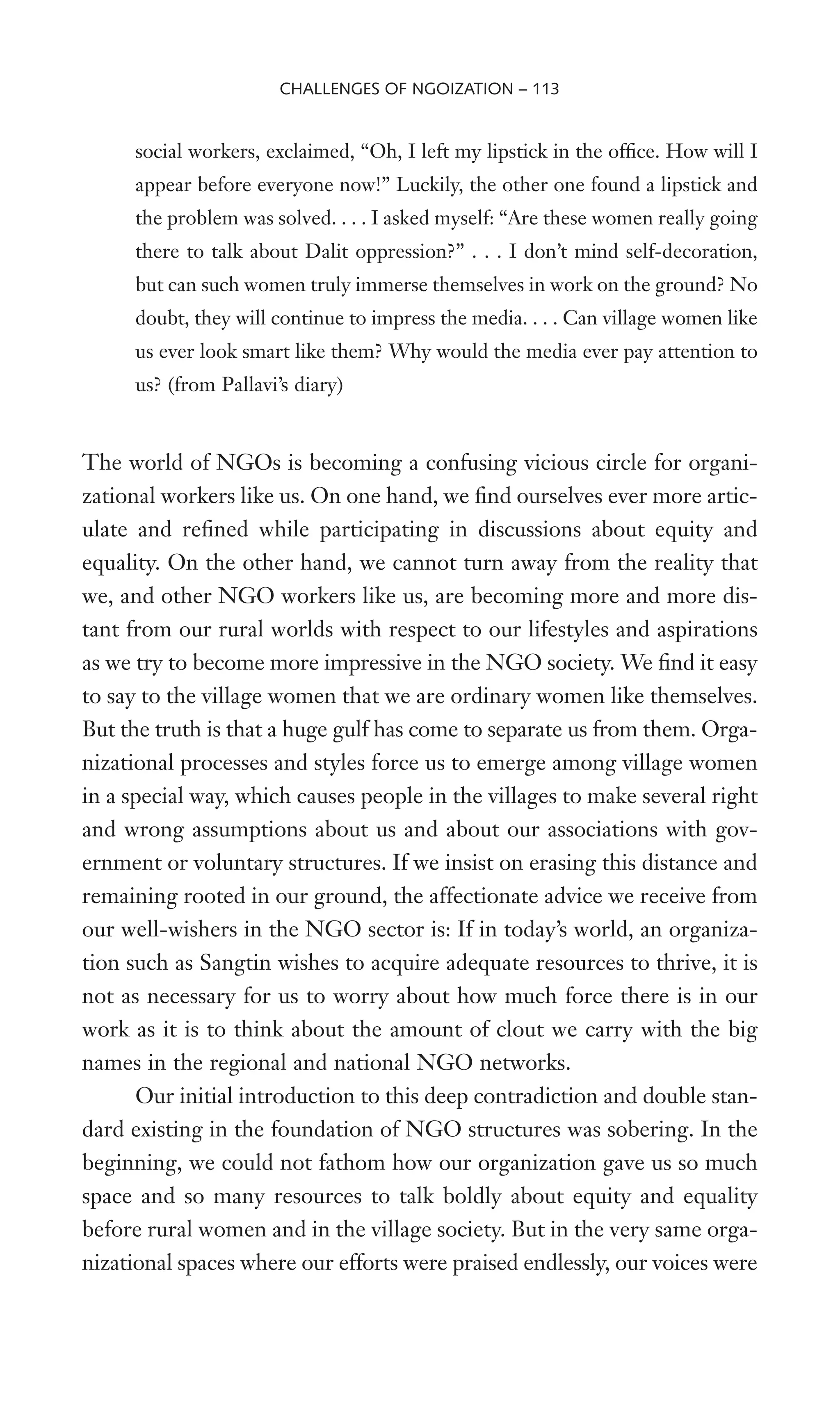
![mufXed in the presence of higher ofWcials, and all the slogans and talk of
equity and equality were pushed aside. When we deliberately tried to open
our mouths in opposition to this, we were informed that the issues we
wanted to raise were not meant to be discussed before the ofWcers, even
though in the villages, we had always learned to state our opinions openly
and impartially and had taught others to do so. We are not claiming that
whatever we tried to say in our organizational spaces was always correct.
We are pointing out our disappointment at being discouraged from artic-
ulating our opinions about class differences in an environment where
there was constant talk about equity and equality.
For example, inequalities associated with salaries and food and travel
allowances have been a subject of much debate among us. In theory, the
NGO worker at the Weld level is deemed very important, yet an ofWce
worker at the lowest rank in the organization often draws a bigger salary
than the Weldworker. Some women’s organizations refuse to collapse edu-
cation with formal literacy from the outset and consider ground experi-
ence on a par with formal education. But this policy has proved hard to
implement when it comes to determining monthly salaries and honoraria
in NSY. For example, the teachers who teach adolescent girls and women
in the literacy centers receive increments in their honoraria on the basis
of formal educational qualiWcations; that is, a teacher who has completed
eighth grade receives less money than the one who has passed Interme-
diate, even if the one with the eighth grade qualiWcation has to work much
harder and longer than the one with the higher educational status. It is
easier for workers to express their pride in words, “We are not educated;
we are made.” But in practice, where is the equal status for the less edu-
cated ones? There are many other examples of this kind.
For instance, Sandhya writes: “We raised a small issue that the big
ofWcer goes in the air-conditioned train compartment and the small one
in the second-class sleeper. All we had to do is utter these words, and the
ofWcers started feeling very offended. [Seeing this,] a village woman sit-
ting next to me grabbed my hand and said, ‘Don’t talk like this. . . .’ I
thought to myself that raising something as small as this upsets these top
ofWcials so much! So when we question patriarchy and men’s power in
114 – CHALLENGES OF NGOIZATION](https://image.slidesharecdn.com/playing-20with-20fire-20book-140402052849-phpapp01/75/Playing-with-fire-book-163-2048.jpg)

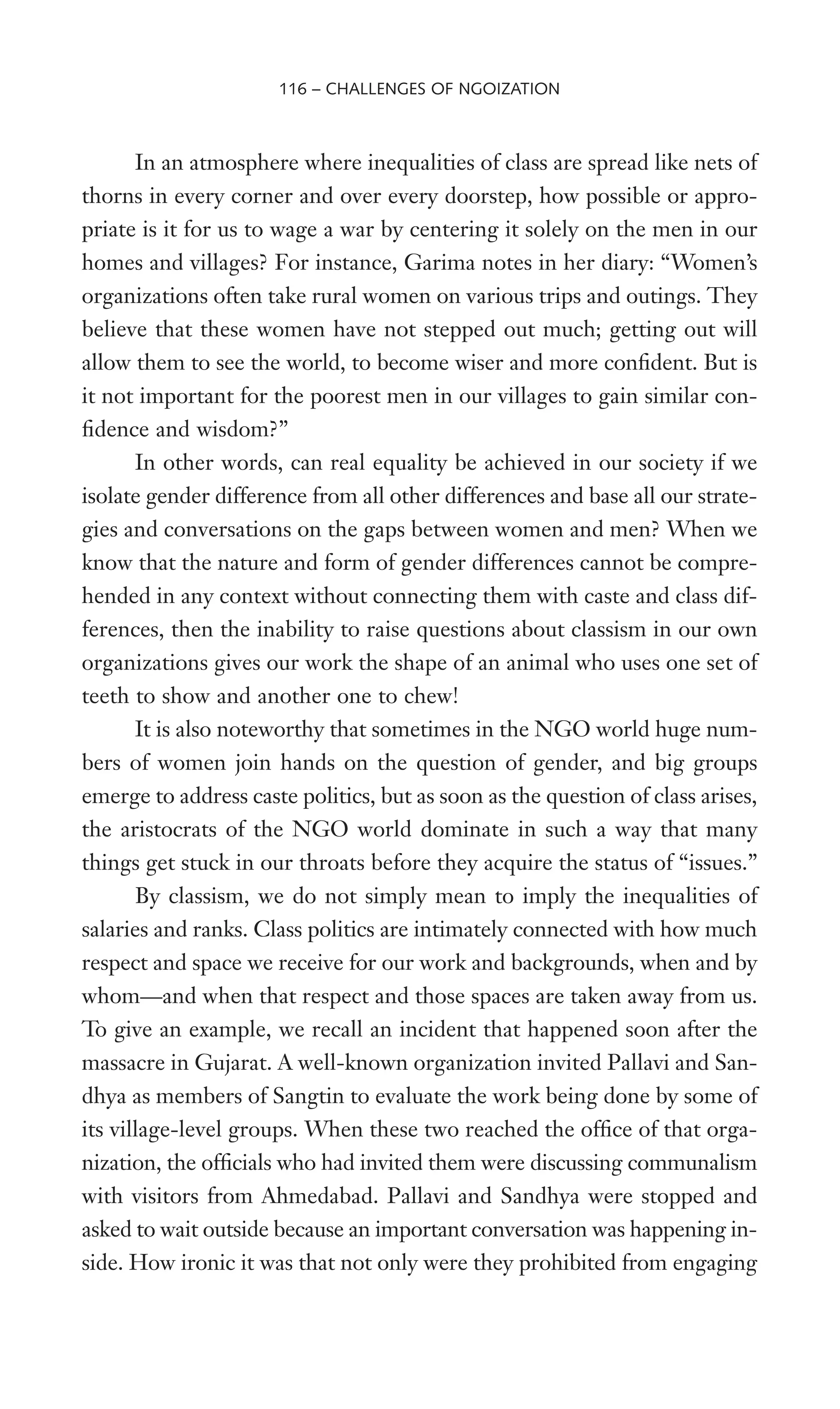
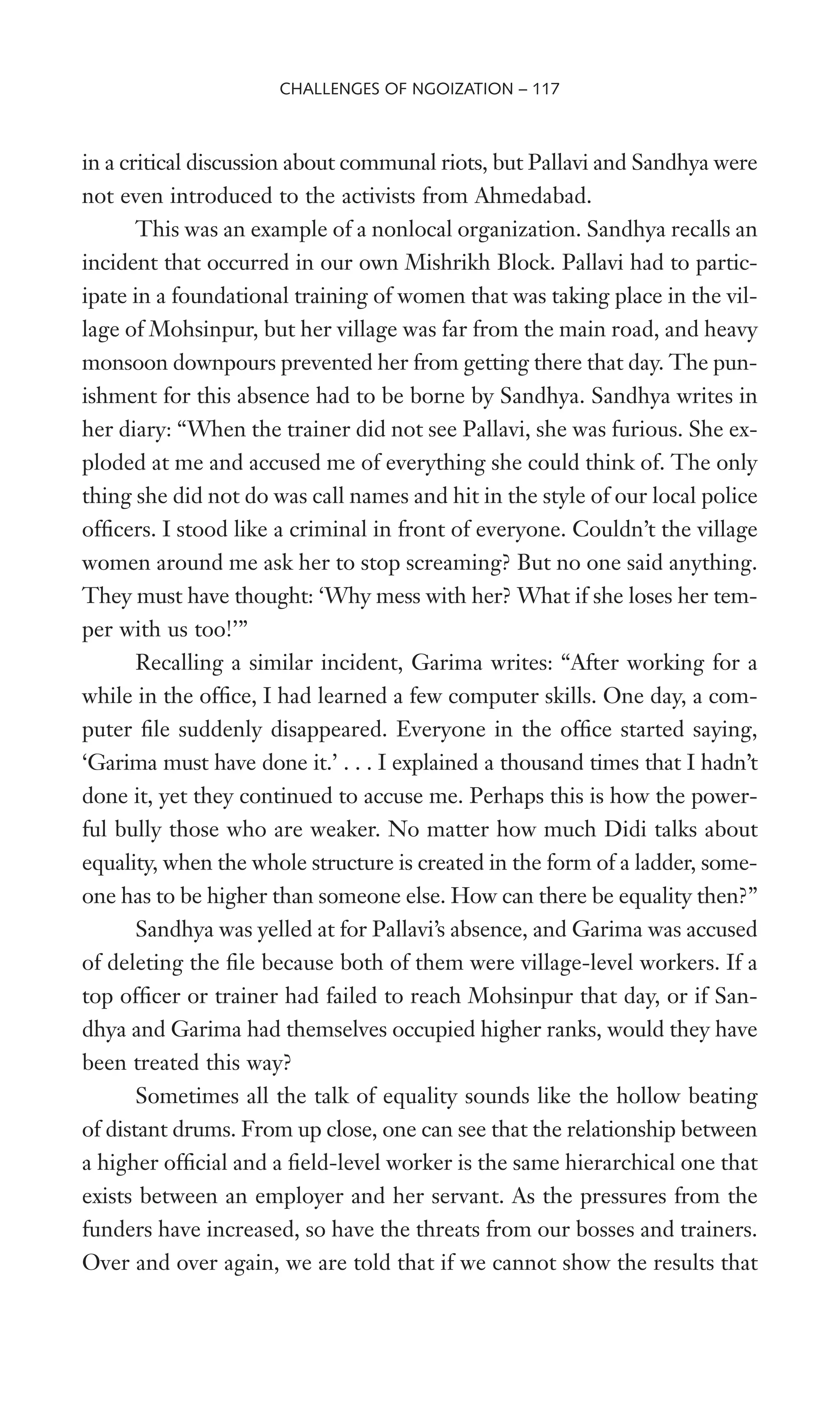

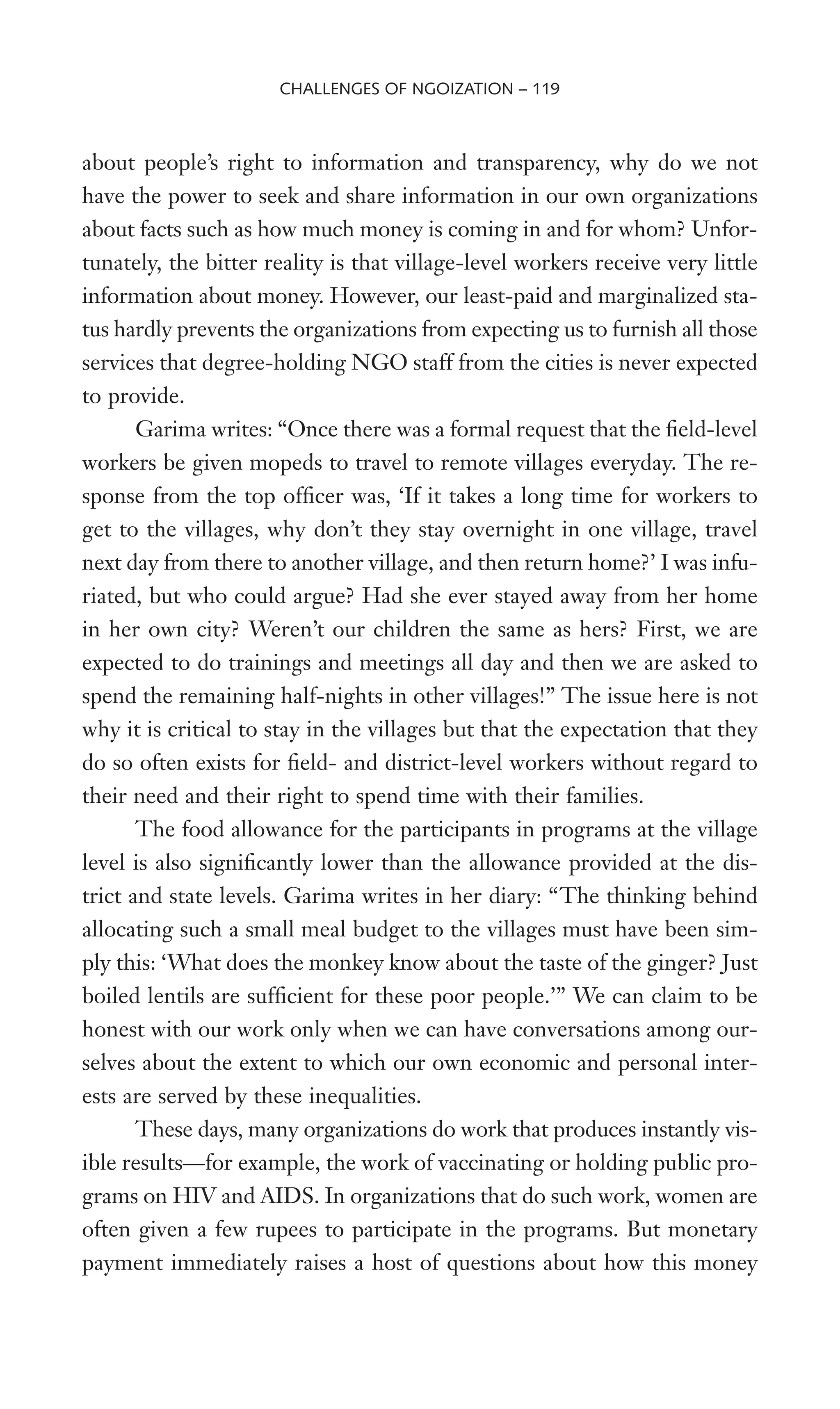

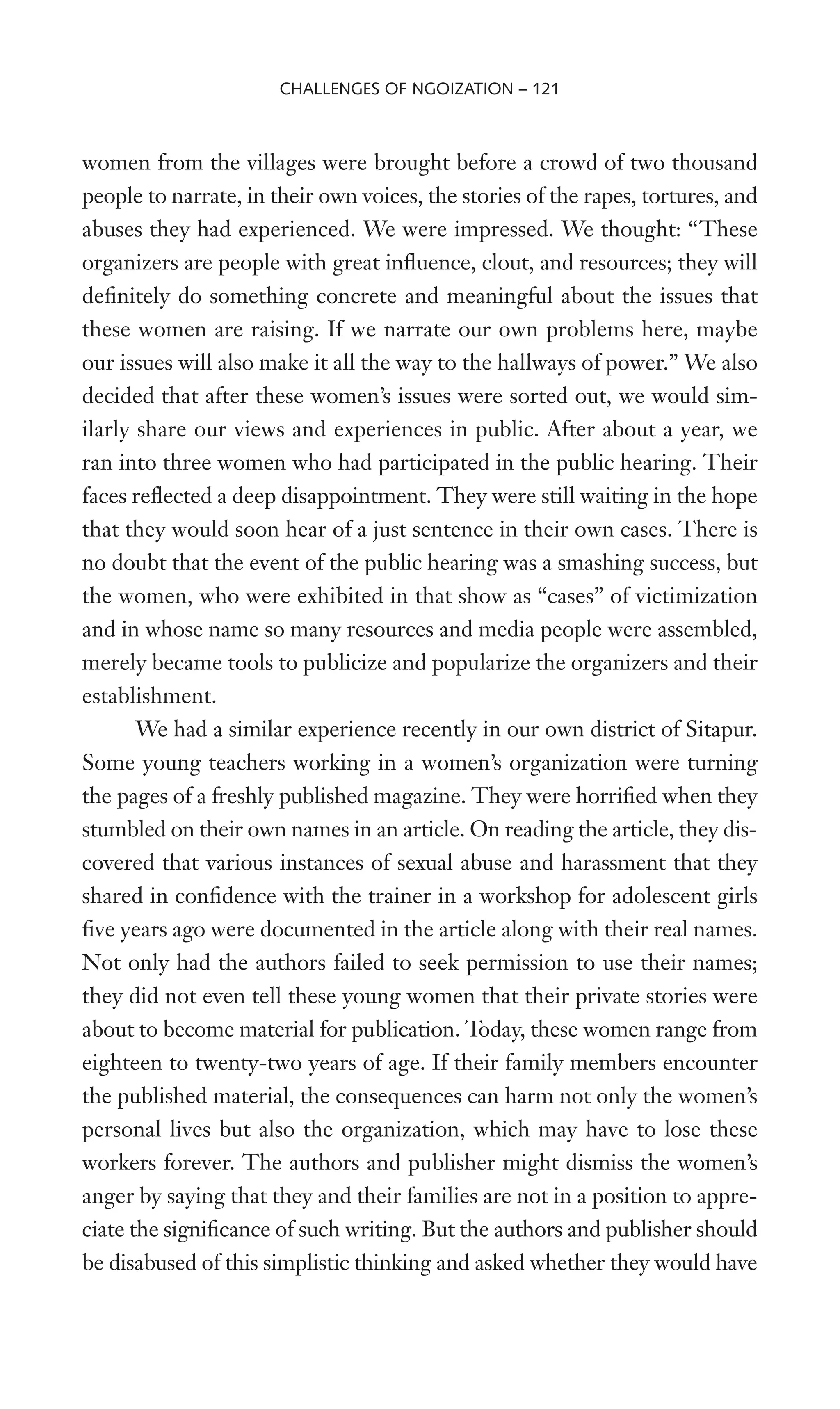
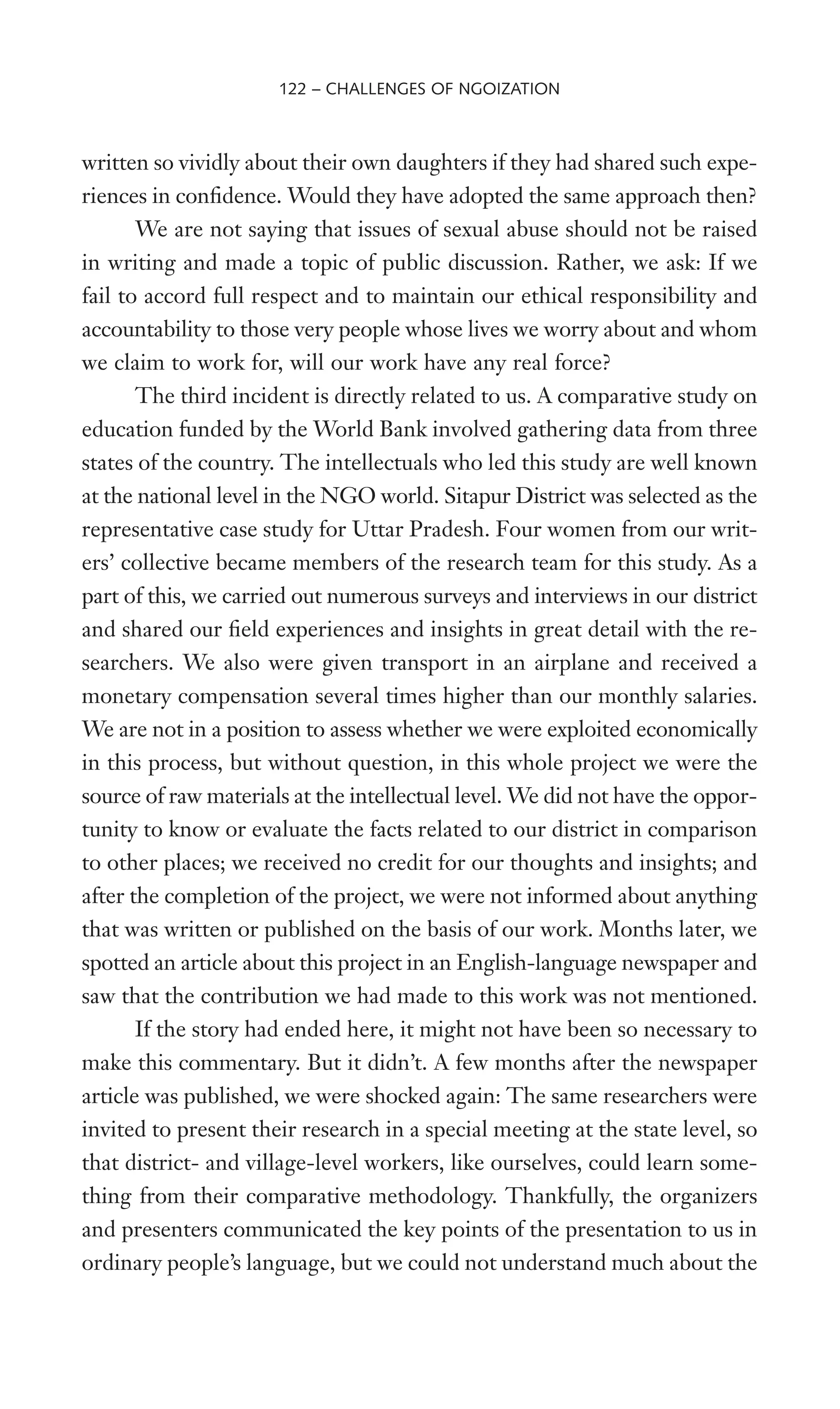
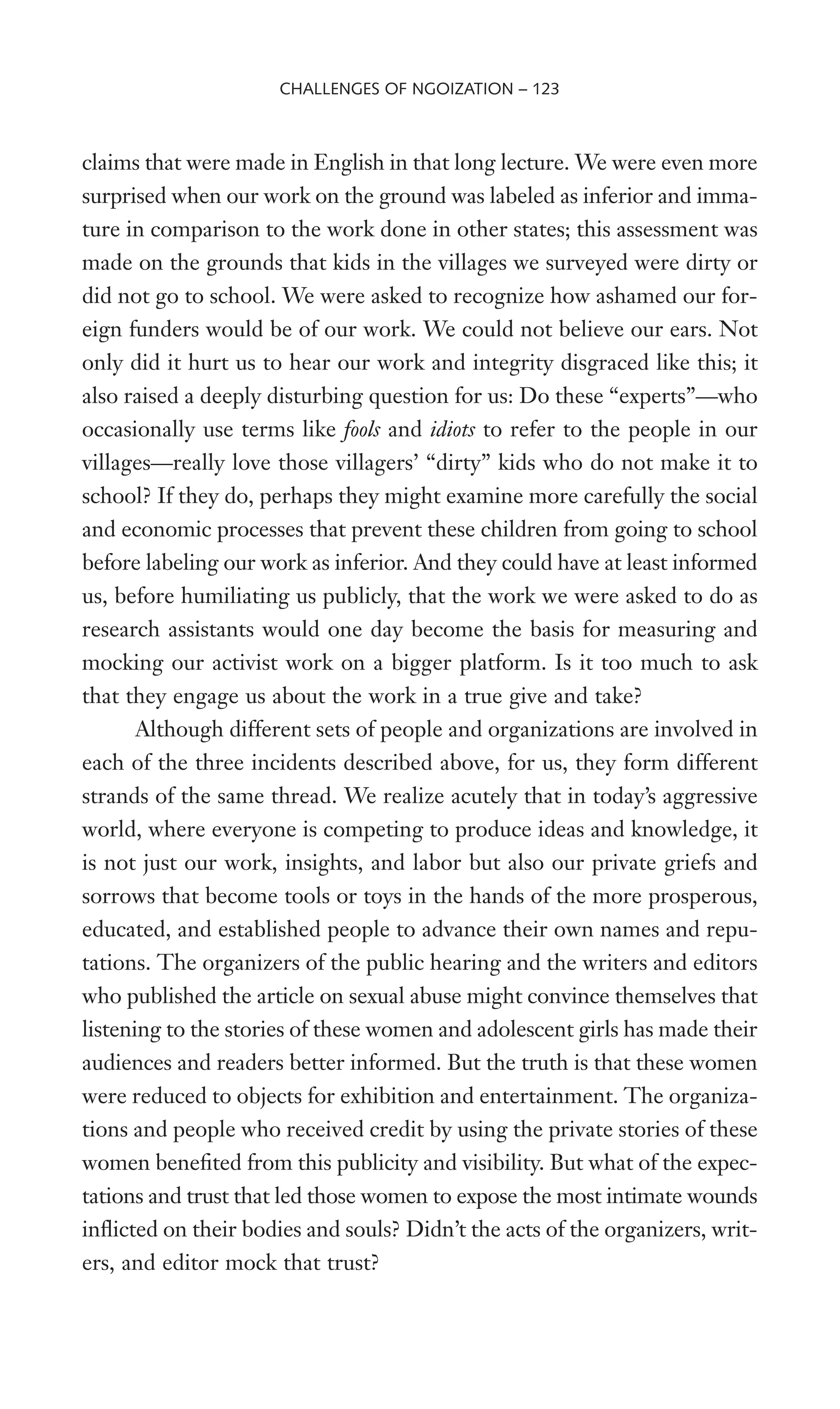
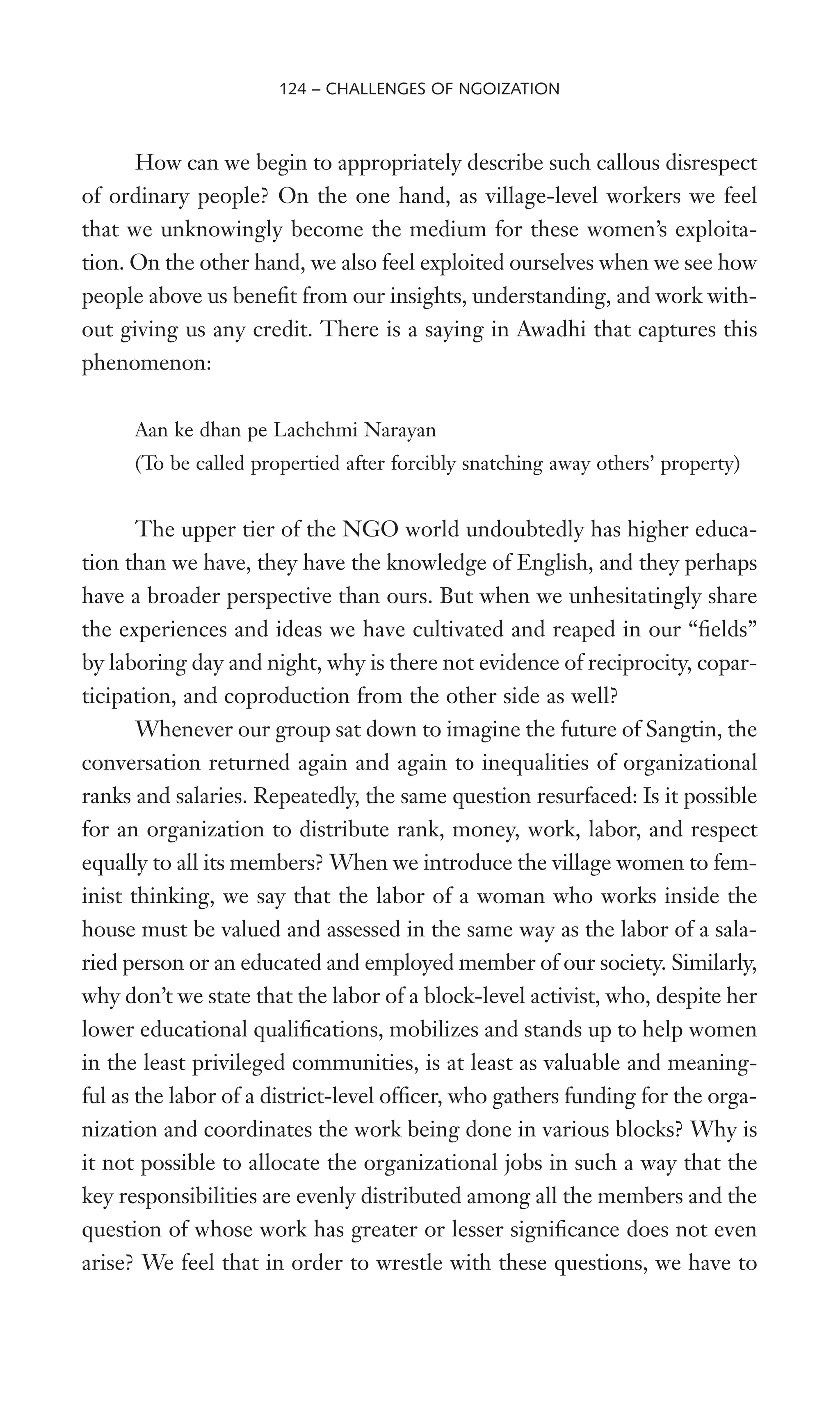


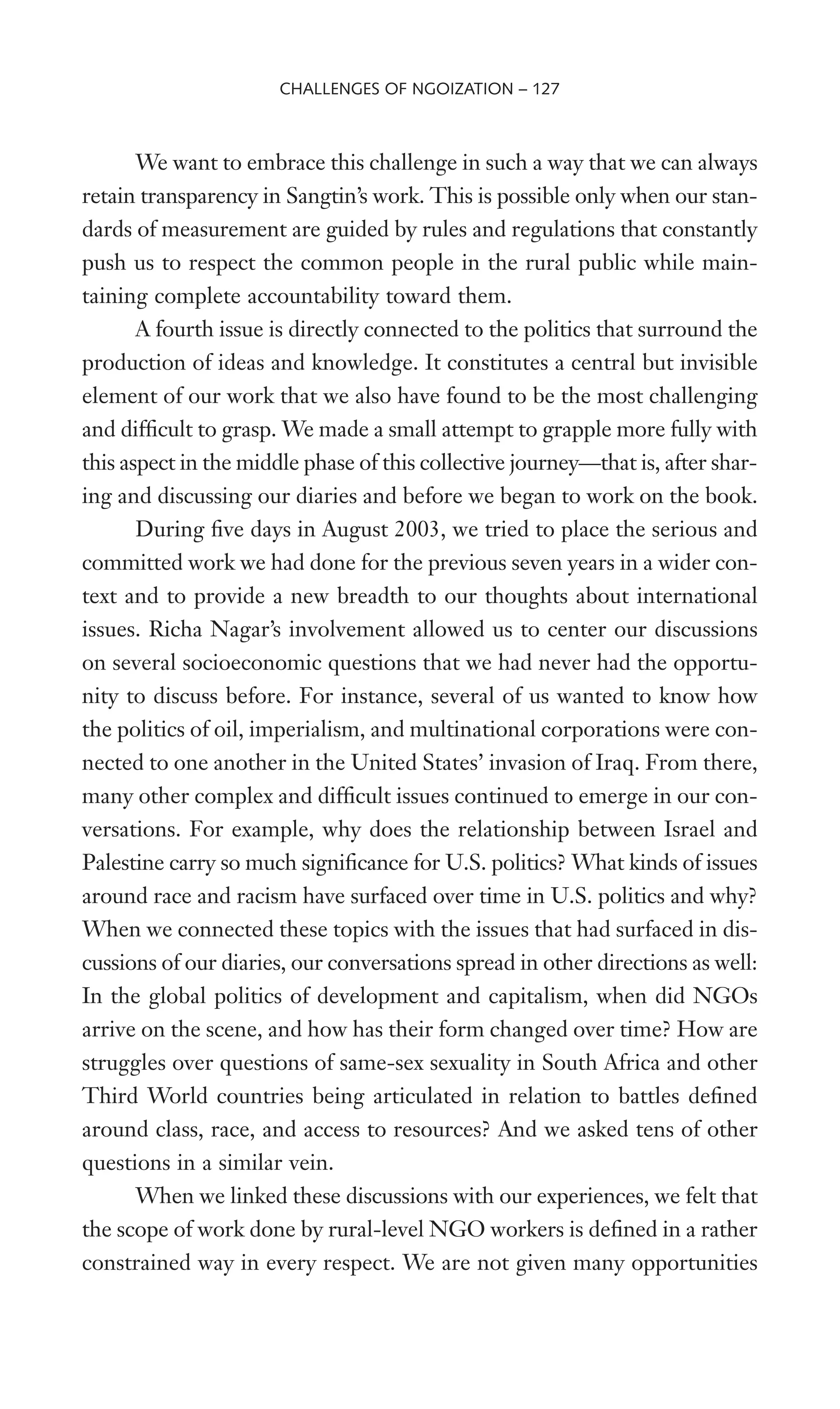

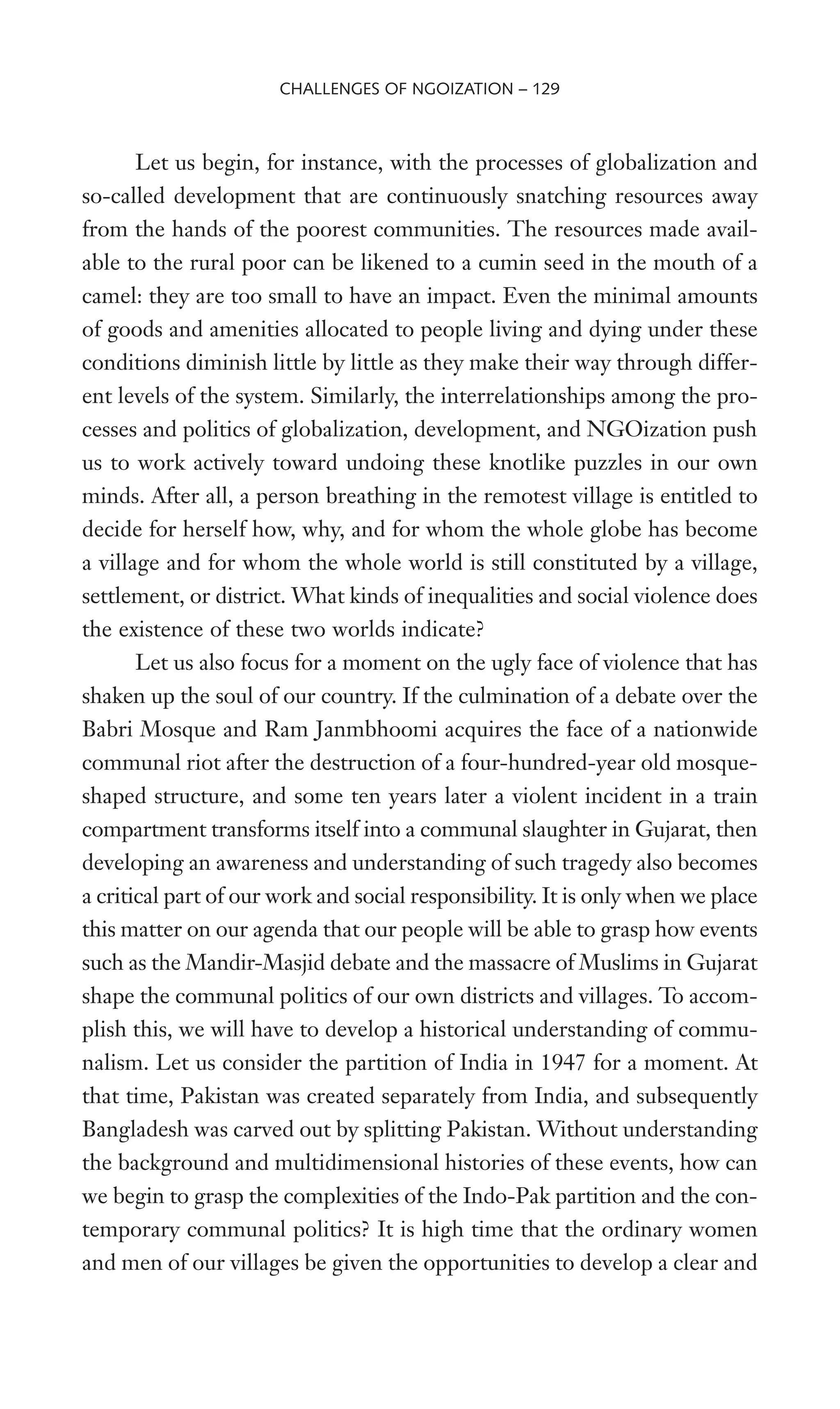
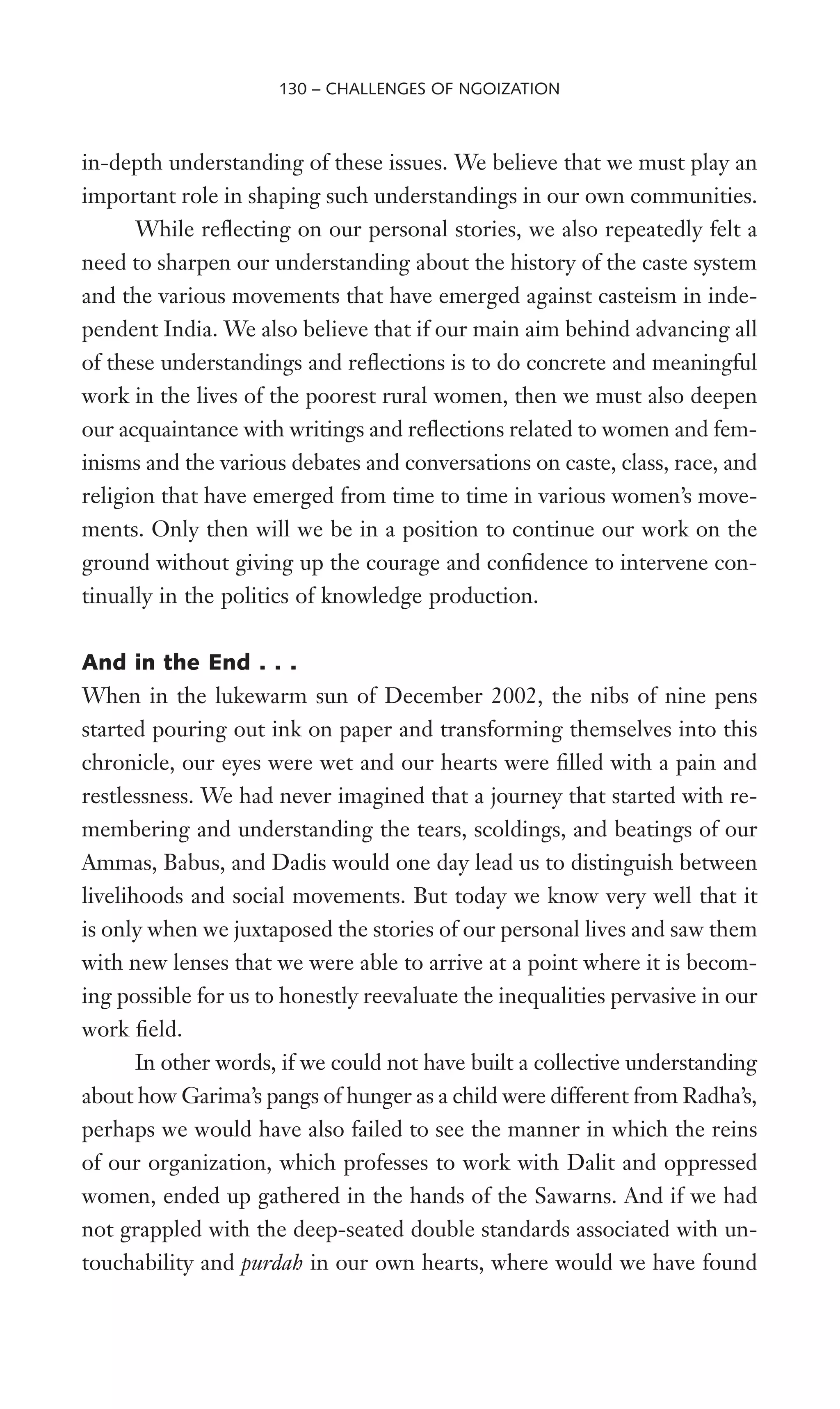

![P O S T S C R I P T
NGOs, Global Feminisms, and
Collaborative Border Crossings
Richa Nagar
The release of Sangtin Yatra provoked a furious public response from the
NSY, Uttar Pradesh, in the form of verbal attacks, letters, transfer orders,
and threats to take disciplinary action against the authors.1
This backlash
was countered by letters, articles, and book reviews in the Hindi media
and a petition sent from Minnesota that created political pressure to stop
NSY from issuing further threats to the authors.2
Here I present two
documents that highlight the arguments and stakes of this controversy.
Letter from the State Programme Director of NSY, Uttar
Pradesh, to the Chair of Women’s Studies, University of
Minnesota (original document in English)
June 2, 2004
Sir,
This is to bring to your notice a research conducted by Dr. Richa Nagar, a
faculty member of your department. She did some work in Sitapur district
of Uttar Pradesh State in India. She wrote a book based on her work. The
book contains personal and work experiences of seven grassroot level work-
ers narrated by themselves. All the writers of the book, except Dr. Richa
Nagar herself, are employees of [NSY], an internationally famous program
of integrated empowerment of women belonging to the most marginalised
sections of the society. [NSY] is a government programme functional in
132](https://image.slidesharecdn.com/playing-20with-20fire-20book-140402052849-phpapp01/75/Playing-with-fire-book-181-2048.jpg)
![Sitapur district since 1996. All the workers who are also the writers of the
book are community-based workers who were identiWed by [NSY] coor-
dinators and got associated with the programme since then. The workers
have evolved as strong feminists after intensive capacity building exercises
and exposure given to them as a critical process of the programme.
These village workers have also established an NGO of their own
by the name of Sangatin [sic]. Although Sangatin was established in 1998
yet it did not do much of grassroot work as all the members were full time
employed with [NSY]. On publication of the book we are all shocked and
disturbed to see that all the experience that these employees had of work-
ing with [NSY] has been credited into the account of Sangatin. We are in
the process of taking action against this behaviour of our employees. We
are writing to you to bring it to your attention that Dr. Richa Nagar has
published this piece of work without herself checking the authen[ti]city
and genuineness of information. Although she is familiar with the pro-
gramme of [NSY] and has already worked in the districts of Chitrakoot and
Tehri and has documented the work of [NSY]. As per my understanding
she knew very well that [NSY] is working in Sitapur and the employees
belong to the programme. Yet she neither contacted me nor ever informed
me about her association with [NSY] employees on this research work. A
number of news clippings appeared in the dailies and the work of [NSY]
was reported as the work of Sangatin. In spite of Dr. Richa Nagar’s aware-
ness of the reality she did not deny the report and send any note for cor-
rigendum. In fact, it appears, that the two main authors Ms. Richa Singh
and Dr. Richa Nagar planned it well in advance to strategically project
[NSY’s] work as work of Sangatin. Ms. Richa Singh, during our conversa-
tion with her, accepted this fact.3
I take this as unethical and against the spirit of genuine research. It
is also a breach of faith and commitment to social work. Such kind of work
and researches are strongly condemned and should not be encouraged.
I would appreciate if you take appropriate action in this regard and
inform me about it. . . .
Yours sincerely,
State Programme Director4
POSTSCRIPT – 133](https://image.slidesharecdn.com/playing-20with-20fire-20book-140402052849-phpapp01/75/Playing-with-fire-book-182-2048.jpg)
![Background to Petition: Prepared by the Sangtin Writers
Collective with Help from Supporters in Varanasi, Lucknow,
Minneapolis, New Jersey, New York, Pune, Sitapur, and
Washington, DC (original document in English)
June 11, 2004
Dear Friends,
We are writing to seek your urgent support on an issue that is Xaring up in
the Sitapur district of Uttar Pradesh. The issue has to do with [Nari Samata
Yojana]-Uttar Pradesh’s harassment of the nine authors of a book, seven of
whom are [NSY]-Uttar Pradesh employees against whom the State Project
Director of [NSY]-Uttar Pradesh is taking punitive action. The main rea-
son behind the punitive action is that these authors have openly reXected
on issues of elitism and casteism in women’s NGOs in Uttar Pradesh.
The book in Hindi is called Sangtin Yatra: Saat Zindgiyon Mein Lipta
Nari Vimarsh (A Journey of Sangtins: Feminist Thought Wrapped in Seven
Lives) and was published by Sangtin, Sitapur in March, 2004. In this book,
seven village level grassroots workers—Anupamlata, Ramsheela, Reshma
Ansari, Shashibala, Shashi Vaish, Surbala and Vibha Bajpayee—have re-
leased their voices and words to reXect on their lives, on pre-given deWni-
tions of honor and respectability, and on casteism, communalism, class and
gender politics as it has operated in their own lives as girls, as women and
as village-level NGO workers. These seven women have undertaken this
writing as members of a small women’s organization called Sangtin, in col-
laboration with Richa Singh (a co-founder of Sangtin) and Richa Nagar,
who teaches at the University of Minnesota.
A few words about Sangtin: In every district where [NSY] operates,
it encourages the village-level workers to register their own organization
under another name so that the work of women’s empowerment may con-
tinue after the time-bound funded program of [NSY] withdraws from the
district. Thus, NSY-Sitapur is the parent organization from which Sangtin
has emerged. The writers’ collective published Sangtin Yatra under the ban-
ner of Sangtin, under whose name they want to continue the work of com-
bining radical activism, rigorous research and creative writing.
134 – POSTSCRIPT](https://image.slidesharecdn.com/playing-20with-20fire-20book-140402052849-phpapp01/75/Playing-with-fire-book-183-2048.jpg)
![A product of two years of labor, Sangtin Yatra has emerged from a col-
lectively produced collaborative methodology, where the NGO workers
grapple for the Wrst time with processes of NGOization and the politics of
knowledge production. One of the major objectives of the book has been to
understand through collective writing and reXection, the ways in which em-
powerment of poorest and dalit women in the rural areas of Uttar Pradesh
is shaped by structures of caste, class and religion; to critically reXect on the
seven rural workers’ own accomplishments and limitations as actors located
in the hierarchical structures of family, village, and NGOs, and the ways in
which they want to advance their work on the ground by envisioning their
dreams for the future. It is important to note that no NGO in Uttar Pra-
desh (except Sangtin) was mentioned by name in the main text of the book.
The book was released on March 25, 2004 in a public function in
Lucknow by the Hindi novelist, Maitreyi Pushpa, and received signiWcant
media attention in the Hindi press in the Wrst half of April.
In mid-April, Richa Nagar left Lucknow and returned to Minne-
sota. Soon after her departure, the State Project Director of [NSY]-Uttar
Pradesh, where seven out of nine authors of this book are still working in
the capacity of mobilizers, literacy center instructor and district coordina-
tor, began to launch an attack on the authors of the book. Her main charge
was that (a) the book did not give credit to [NSY] for the encouragement
and opportunities that it had given to them as [NSY] workers; (b) the
authors’ reXections on the organizational hierarchy, elitism and casteism in
NGO structures undermined the work of women’s organizations; and (c)
the “truth” of what the women were saying was not veriWed by [NSY] before
the book was published. The authors believe that all these charges are base-
less because (a) they do thank [NSY] in their Preface, (b) the objective and
spirit underlying the book are entirely opposite to what the SPD of [NSY]-
UP accuses it of doing, and (c) the goal of the book is not to present a
monolithic truth that requires veriWcation by [NSY]-UP’s top leadership,
but the analyses, reXection and “soul-searching” of the authors’ own lives
and experiences as rural women and NGO workers.
On April 22nd, the State Project Director of [NSY]-UP issued let-
ters to Richa Singh and Richa Nagar in which she condemned the book and
POSTSCRIPT – 135](https://image.slidesharecdn.com/playing-20with-20fire-20book-140402052849-phpapp01/75/Playing-with-fire-book-184-2048.jpg)
![called it an example of irresponsible writing which “shows that all the efforts
undertaken by women’s organizations have been deceitful and dishonest,
they have promoted inequality, and are false.” The seven authors who are
currently employed in the organization were subsequently called for two
meetings of over two hours where they were asked to publicly apologize for
the contents of the book by issuing letters of apology to all the newspapers
that had written about the book. When the authors refused to write such
a letter, they were asked to resign. Again, the seven employees of [NSY]-
UP refused to resign on the grounds that they had done nothing to violate
their loyalty to [NSY]-UP. The organization then transferred Richa Singh
from Sitapur to Saharanpur, and verbally deWned the transfer as a “pun-
ishment transfer.” Dismissal of the book and ad homonym attacks continue,
along with verbal and written harassment of the authors in the form of
“charge-sheets,” and outright threats and verbal abuse. A meeting of an
“advisory committee” is being called in where the “issue of Sangtin Yatra”
appears as an agenda item. The authors are convinced that this meeting will
result in further disciplinary action against them.
We are asking you to sign the attached petition because as the women
afWliated with this work put it, “It is not so much a question of whether we
get our honoraria from [NSY] every month. We will get by. But if they win
this unfair war, no grameen karyakarta (village level NGO worker) in UP will
be able to accumulate the strength to speak her version of the truth again.”
I quote these two documents at length, partly because their differ-
ent logics and representative strategies make them useful comparative
texts by themselves, and partly because they capture the central features
of the attacks launched against the authors of Sangtin Yatra. Not only is
the controversy surrounding NSY’s response to Sangtin Yatra closely en-
twined with the issues and critiques that the authors raised in the book;
it also helps to advance those discussions in crucial ways.
Sangtin Yatra and the Problem of “Truth” and Evidence
The prominent emergence of seven village-level NGO workers in the
regional and national Hindi media as political thinkers charting their own
136 – POSTSCRIPT](https://image.slidesharecdn.com/playing-20with-20fire-20book-140402052849-phpapp01/75/Playing-with-fire-book-185-2048.jpg)
![future came to be constructed by the director of NSY, Uttar Pradesh, as
the uncontrolled behavior of NSY’s employees under a strategic plan de-
vised by Richa Singh and Richa Nagar. The work that the eight activists
had done in their own communities, each author was told in a separate
letter, was in fact owned by the employer organization, which had dis-
covered them and taught them how to do feminism. Accordingly, the expe-
riences of the activists as women and grassroots workers had to be claimed
by the organization that was in the business of empowering them. The
“authen[ti]city and genuineness of information” that village-level NGO
workers were providing as writers of their own past, present, and future
lives had to be checked with the authorities who had trained them to be-
come feminists. Furthermore, the person guilty of not verifying the seven
autobiographers’ “truth” was me, since out of the nine authors, only my
status was deserving enough to be the sole custodian of the “spirit of gen-
uine research.” And Wnally, because both the NGO workers and I had
committed a breach of faith by acting against an internationally acclaimed
government institution that was ofWcially in charge of the “empowerment
of women belonging to the most marginalised sections of the society,” it
was the duty of our employers and bosses to discipline us.
The backlash was guided by an impulse on the part of the NSY
leadership to claim ownership of the experiences and ideas of the grass-
roots activists: NSY wanted to take pride in their accomplishments and
also retain the right to dismiss their critique. In identical letters issued
to the seven employees of NSY (i.e., all the authors except Surbala and
me), the director wrote:
You will agree that it is only because of your work in [NSY] that you were
able to step out of the boundaries of your home. [NSY] has tirelessly worked
to build your expertise and skills and has given you support and encour-
agement in every way so that you could reach a level at which you can pow-
erfully connect with issues and struggles of rural women and make your
voice heard on every platform. Thus, your . . . behavior is an act of betrayal
and a gruesome criminal act against the organization. Clarify as to why a
disciplinary action should not be taken against you.5
POSTSCRIPT – 137](https://image.slidesharecdn.com/playing-20with-20fire-20book-140402052849-phpapp01/75/Playing-with-fire-book-186-2048.jpg)
![A month earlier, Richa Singh and I had already been told (in identical let-
ters and in a more temperate tone) by the director,
we are disappointed that in this book the credit has been attributed to Sang-
tin for all the positive change and programs that have been carried out by
[NSY] in Mishrikh and Pisawan blocks of Sitapur and it has been shown that
all the efforts undertaken by women’s organizations are fake, dishonest, pro-
moters of inequality, and pretentious. . . . Highlighting only the negative
and suppressing the positive is not a sign of responsible writing. [NSY]
expected you to verify the truth of what you were writing and to explore
multiple dimensions. And along with it, [we expected you] to highlight the
experiences of these women writers with reference to [NSY]’s efforts.6
This desire of NSY to establish ownership over not only the words
and work but also “the truth” of the rural activists was marked by a deep
contradiction. On the one hand, the director wanted to own the authors’
labor as activists and thinkers by saying that the village-level NGO work-
ers could not have written what they wrote in Sangtin Yatra if the orga-
nization had not raised their consciousness. On the other hand, she wanted
the power to certify or discredit their truths and to establish her organi-
zation’s singular and monolithic truth, especially when it came to the
authors’ critiques of elitism and casteism in the hierarchical structures of
women’s NGOs.
In order to achieve the latter goal, it was necessary to undermine
our alliance by splitting the group discursively into the two Richas ver-
sus seven rural workers and by using this argument to try to drive a wedge
between the Richas and the remaining authors. The ofWcial letters of
complaint against Sangtin Yatra constructed the seven village-level acti-
vists as empowered women who could not have become so if the orga-
nization had not taught them how to stand up and speak for themselves.
At the same time, the same women were also constructed as manipulated
“subjects” of a “research project” that was forced on them by Richa Singh
and Richa Nagar. Although the director could not resist the temptation
138 – POSTSCRIPT](https://image.slidesharecdn.com/playing-20with-20fire-20book-140402052849-phpapp01/75/Playing-with-fire-book-187-2048.jpg)

![undermining the stated objectives of her own organization. As Krishna
Kumar wrote:
The charge against the sangtins is that [they dared to] write their experiences
emerging from this program without permission and reference. In reality,
the issue is not so much of experience as it is of opportunity and ability. In
essence, this book is evidence of the success of the [NSY] program, but it
also symbolizes a rebellion against the formalities of constituting evidence.
The role of rebellion is performed by the words themselves.
Accepting those words, deriving happiness from their sculpting re-
quires a generosity that, if present in a governmental program, can make it
revolutionary.8
In his assessment of positive trends in education in Uttar Pradesh,
Krishna Kumar observed that while Sangtin Yatra proves how Uttar Pra-
desh’s “civil society is beginning to register new kinds of voices,” the back-
lash and punitive transfer of Richa Singh demonstrate “how vulnerable U.P.
continues to be to its own older personality as a state which resists inno-
vation.”9
While Uttar Pradesh’s personality as a state may partly explain
NSY’s response, the backlash against Sangtin Yatra still raises a critical ques-
tion: Why did the coming together of nine women to reXect on the lives,
work, and future directions of seven activists create such a furor over the
claiming of names and truths? In a large measure, Sangtin Yatra was able to
gain resonance in the speciWc context of Sitapur and Uttar Pradesh because
it forcefully intervened in the discursive spaces of Hindi and Awadhi. At the
same time, the transnational nature of our alliance as well as the sociopolit-
ical, geographical, and institutional locations of the nine sangtins made it
difWcult for powerful state-level actors either to ignore Sangtin Yatra or
to prevent the yatra from continuing. In the remaining sections of this
Postscript, I explore these dimensions by Wrst summarizing the unveriWed
“truths” of Sangtin Yatra and then placing them in relation to the politics of
NGO work and ongoing conversations on “globalization from below”
and “global feminisms.” The Wnal section situates Sangtin Yatra/Playing
with Fire in the larger context of transnational feminist border crossings.
140 – POSTSCRIPT](https://image.slidesharecdn.com/playing-20with-20fire-20book-140402052849-phpapp01/75/Playing-with-fire-book-189-2048.jpg)
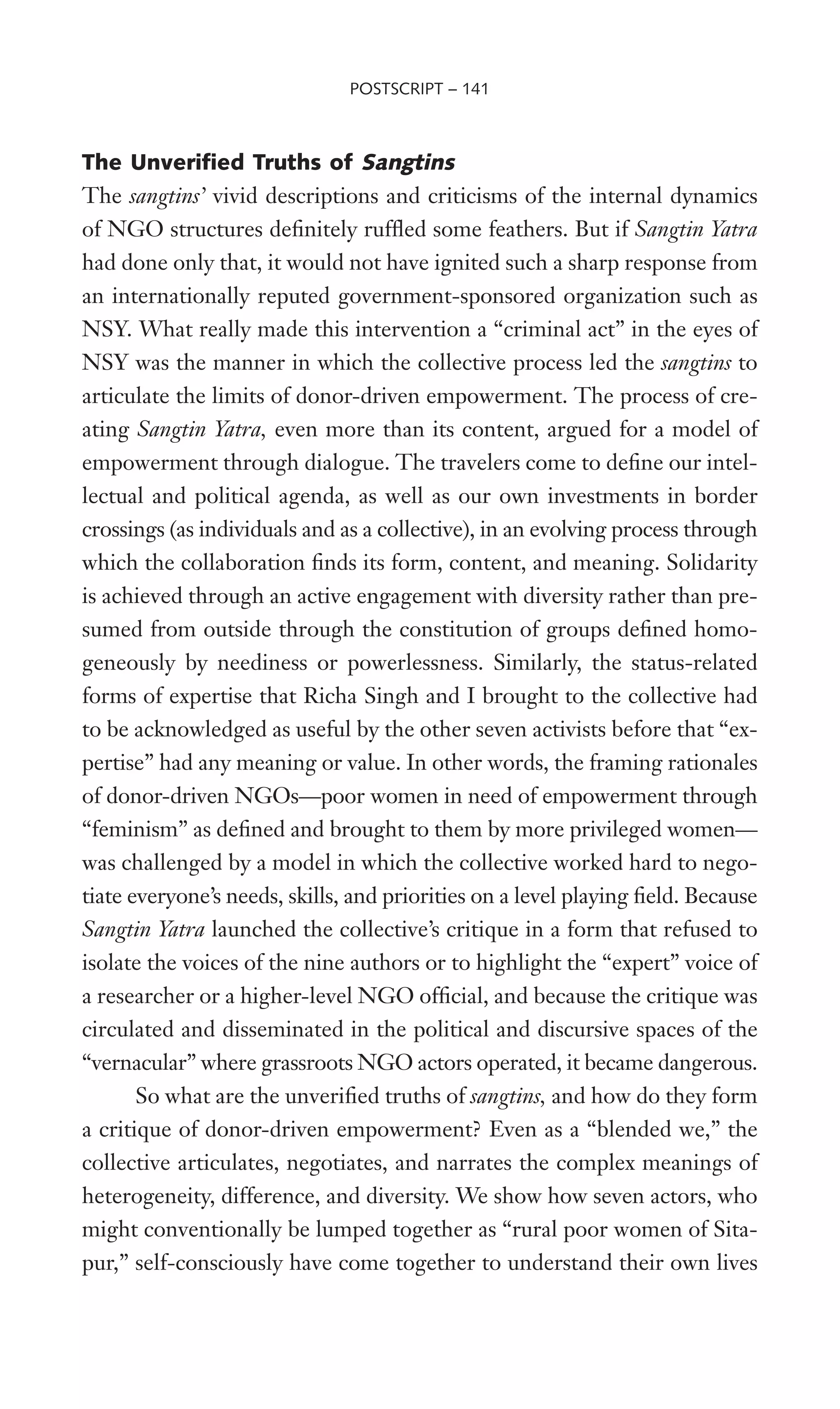


![on a long-term basis—the work of changing traditions or the work of
improving women’s lives?” (from chapter 5).
On the question of NGOization, the analytical process for us begins
from articulating in concrete terms the manner in which elitism and hier-
archies within the NGO structures parallel and reproduce the very hier-
archies that they are ostensibly interested in dismantling: rural-based,
less formally educated, Dalit workers Wnd themselves at the margins
of institutional spaces in every way, even as these same workers carry out
the labor of transforming the organizational dreams into reality. We rec-
ognize how class differences work to make the “rural woman’s voice de-
pendent on the business people of international funding. [Her voice] is
heard only when it is translated by licensed middle-people. On rare occa-
sions when it does emerge on its own, it is declared unruly and, there-
fore, intolerable.”13
In the process of imagining what forms an alternative organiza-
tional space might take, the collective observes how professionalization
of organizational structures and processes makes many women’s organi-
zations accountable primarily to their funders, who seek certain kinds of
reports and statistics and whose insistence on seeing “evidence of empow-
erment” often results in standardization and homogenization of grassroots
strategies. We also identify the ways in which the idea of empowerment
is visualized as a concrete thing that can be measured, quantiWed, and
replicated and how each piece of “empowerment” can be reduced to its
component parts. The activists express frustration with how their past
work foreclosed opportunities for them to engage with questions of com-
munalism and violence, struggles over land and water, development and
displacement, war and imperialism. We recognize how a separation of
gender-based violence from other forms of violence pigeonholes the acti-
vists into a narrow political vision; it perpetuates the problems of depen-
dence on and, in turn, accountability to donors (and more immediately,
to their NGO supervisors and administrators) instead of bringing about
broader social changes in the communities of their Welds. We also see
how the nature of the organizational hierarchies constitutes the activists
as “experts” of their local “Weld sites” and, in so doing, denies them an
144 – POSTSCRIPT](https://image.slidesharecdn.com/playing-20with-20fire-20book-140402052849-phpapp01/75/Playing-with-fire-book-193-2048.jpg)
![opportunity to acquire knowledge of what is happening at geographical
scales beyond their villages.
The collective’s insights are Wrmly rooted in the activists’ own place-
speciWc realities, yet they deeply resonate with debates over NGOs that
are raging throughout the world. The next section places Sangtin Yatra
in relation to this wider debate.
NGOs and Globalization from Below: Lessons from
Sangtin Yatra
What role have NGOs been playing in history? They have acted as “safety
valves,” by channeling the popular discontent along constitutional, peace-
ful and harmless ways. . . . They have sought to divide the exploited and
oppressed into sections and identities . . . in the process, obliterating and
obfuscating class divisions nationally and internationally. . . . They further
instill . . . the belief that it is possible to humanize the existing system; and
this is done by outwardly taking an anti-state stance. . . . Thus while the
IFIs [international Wnancial institutions] and international capital strip off
the role of the state in regulating the economy . . . , the NGOs agitate for
self-help, community development, entrepreneurship, etc., . . . absolving
[the state] from all social responsibilities towards the people. . . . [With]
the massive funds at their disposal, . . . NGOs have been able to fund . . .
conferences, four-wheel drive vehicles and even establish institutes for
research and policy analysis. Many radicals have found themselves in such
institutes as policy formulators and advisors or lobbyists and advocates. . . .
In the Wnal analysis, NGOs play the same role that the missionaries and
the royal geographical societies played during the prelude to colonization
and the period of colonialism.14
Chachage’s polemic provides one of the most succinct summaries of the
many critiques of NGOs that are circulating in much of the so-called
Third World.15
The popular perception that NGOs are potential agents
for diffusing “development” and enabling empowerment has increasingly
been subjected to critical scrutiny. One set of concerns, paralleling
Chachage’s, has focused on the implications of donor-driven NGOs for
POSTSCRIPT – 145](https://image.slidesharecdn.com/playing-20with-20fire-20book-140402052849-phpapp01/75/Playing-with-fire-book-194-2048.jpg)

![central place in the complex politics of state and international civil soci-
ety that have accompanied the full-scale expansion of globalized capital-
ism since 1989. International platforms such as the United Nations have
come to be dominated by a global “feminist” agenda in which the “sub-
altern” is “no longer cut off from lines of access to the centre.”19
“Gender
mainstreaming” and “poor women’s empowerment” have redeWned not
only the terminologies and terrains of women’s politics but also the sites
and meanings of knowledge production. The funding agencies’ popular-
ization of “gender” (instead of “women”), of a focus on violence against
women and HIV/AIDS (instead of infant mortality or price inXation of
basic foods), and of microcredit programs (instead of women’s unions or
land reforms) have enabled new political agendas to emerge. However,
these shifts have also had the serious consequence of compromising rad-
ical politics. Not surprisingly, the interventions made by powerful NGOs
have often ended up serving the interests of global capital, despite being
largely “feminist in [their] professed interest in gender.”20
The collective insights of nine sangtins not only echo and ground
all the above critiques, they also bring a fresh perspective to these dis-
cussions as the activists confront the challenges of NGOization and begin
to articulate their vision of empowerment and feminist politics. The col-
lective’s analysis conWrms that the compromising of radical political agen-
das and the domination of local priorities by the agendas of funding
agencies have been among the heaviest costs that many local activists have
had to pay for the NGOization of grassroots politics. It also reXects the
activists’ growing impatience with an imposed “feminist” agenda that seeks
to empower the poorest and most oppressed women while refusing to
engage with the increasing marginalization of men in the same commu-
nities and neighborhoods. We resist articulations of feminism that focus
singularly on violence against women in their homes or on cultural prac-
tices such as purdah without simultaneously translating those feminist pol-
itics to the communities. In other words, we believe that a feminist vision
that the activists cannot operationalize in their own communities is not
a usable feminism for the collective.
In articulating these critiques, this yatra of sangtins connects with
POSTSCRIPT – 147](https://image.slidesharecdn.com/playing-20with-20fire-20book-140402052849-phpapp01/75/Playing-with-fire-book-196-2048.jpg)
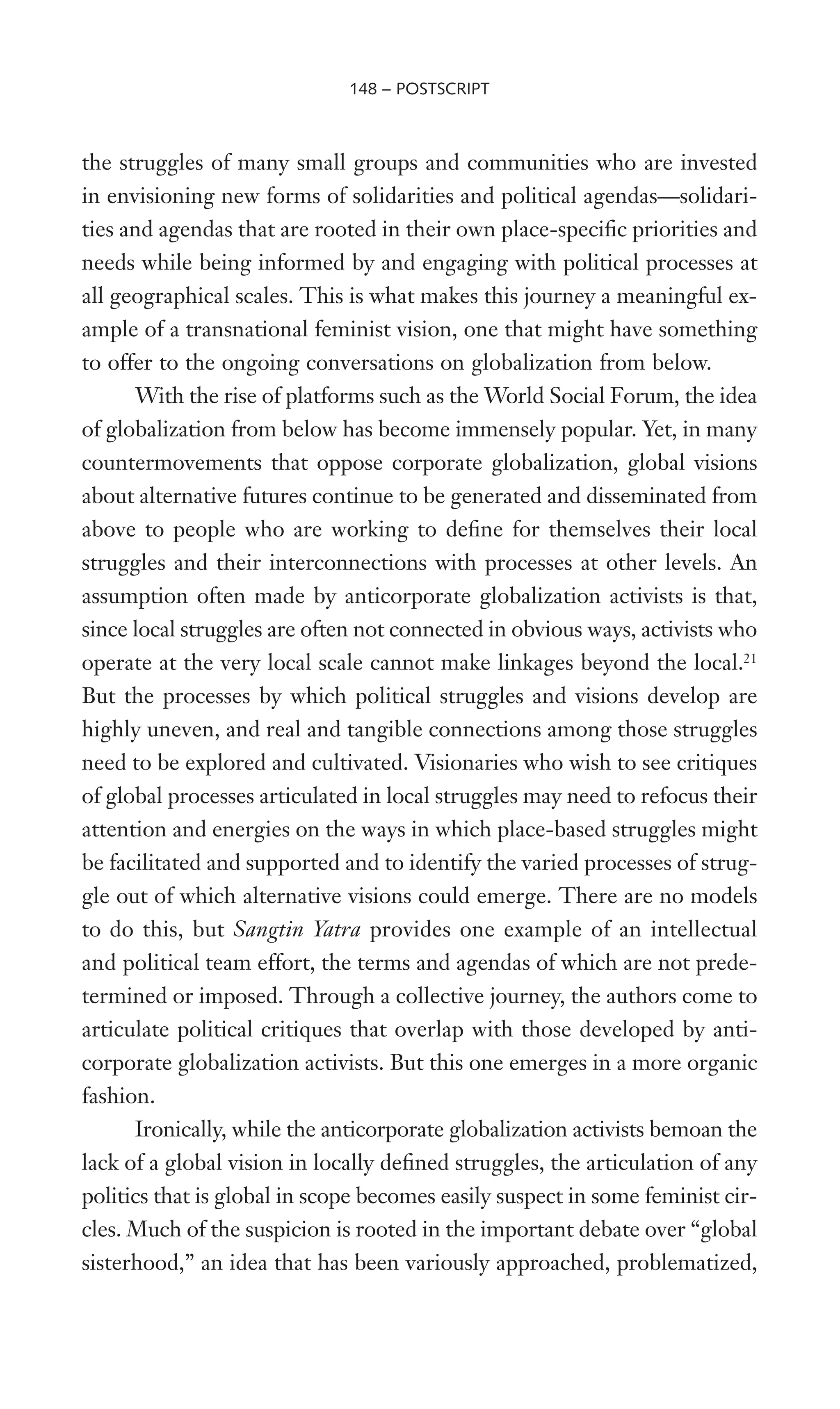
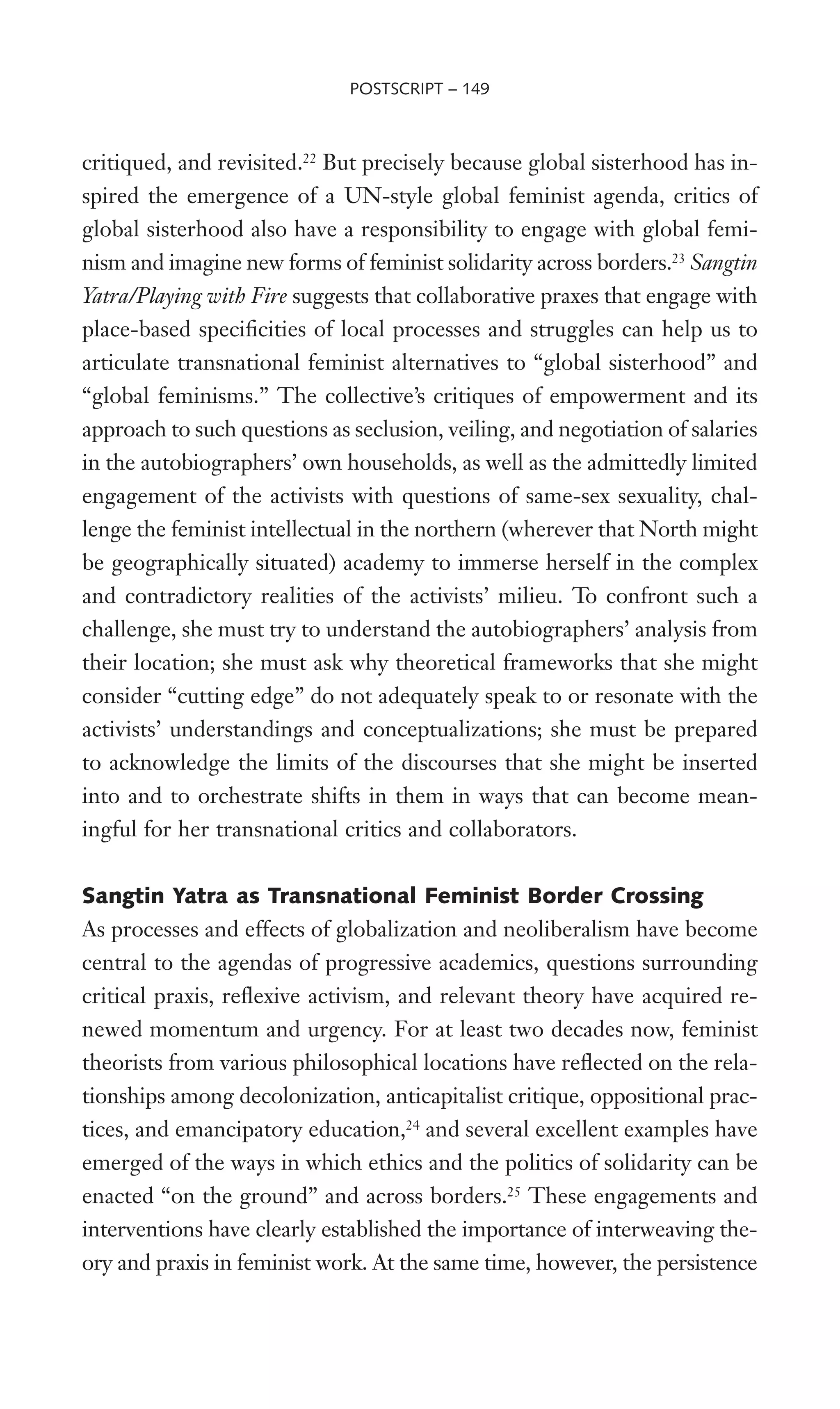
![of the traditional compartmentalization of theory and methodology has
often prevented academics working across borders from engaging more
centrally with theory as praxis and from focusing more explicitly on the
questions of sociopolitical relevance in knowledge production.26
Peake and
Trotz explicitly pose the question of how Third World and First World
women can work together “in ways that are authorized by dialogue with
[Third World subjects] and not just First World audiences.” ReXexive
questioning of ourselves and of the techniques we use to develop mul-
tivocality, they remind us, must be accompanied by a continued inter-
rogation of how our supposedly “improved” representational strategies
might be constituting new silences.27
Such an interrogation requires that
we tap into the tremendous potential of activism and produce critical
analyses based on local feminist praxis and the ways that such praxis con-
nects with broader relations of domination and subordination.28
This journey of sangtins suggests that our engagements with local
feminist praxis hinge, in important ways, on our ability to imagine new
forms of border crossings and “translations” through which transnational
collaborators can enact shifts in prevailing practices of knowledge pro-
duction—that is, shifts in dominant expectations about (a) which actors
can produce knowledge, (b) the methodology and content of knowledges
produced, (c) the languages, genres, and forms in which knowledges are
produced, and (d) the manner in which new knowledges gain relevance
as they reach different audiences and enable new kinds of sociopolitical
interventions. Below, I consider some of the ways in which Sangtin Yatra/
Playing with Fire makes a conscious attempt to enact these four shifts.
As gender politics becomes increasingly professionalized and con-
trolled by formally educated and urban-based “gender experts” and “train-
ers,” terms such as Weld site, research project, case studies, and life histories no
longer remain conWned primarily to the domain(s) of elite northern aca-
demics who temporarily relocate themselves to southern locations. Actors
located at multiple scales in the NGO hierarchy (e.g., national-level super-
visors, state-level program directors, district-level project coordinators,
village-level mobilizers, etc.) have come to play signiWcant roles in the
contested realm of formal knowledge production. Questions of voice,
150 – POSTSCRIPT](https://image.slidesharecdn.com/playing-20with-20fire-20book-140402052849-phpapp01/75/Playing-with-fire-book-199-2048.jpg)

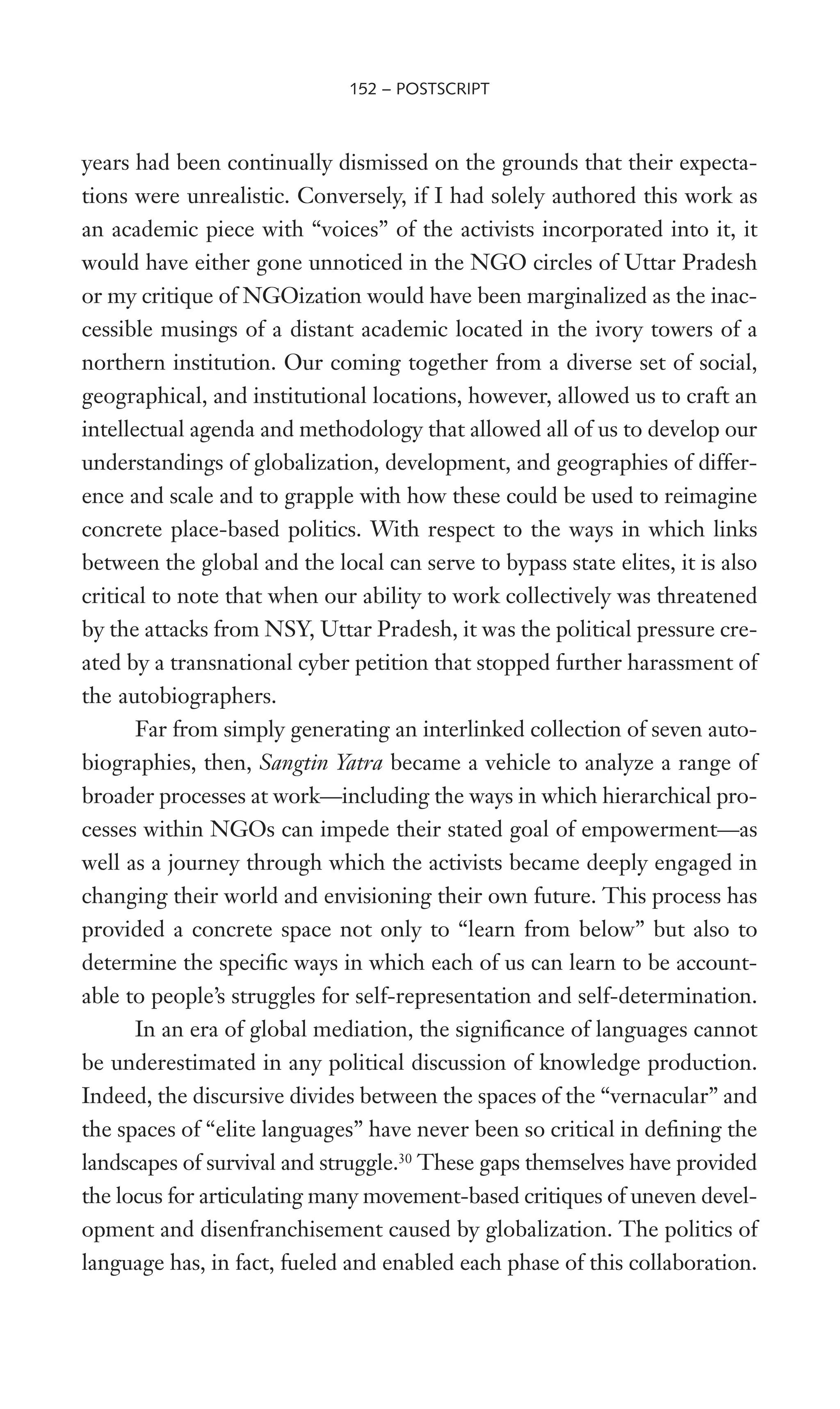

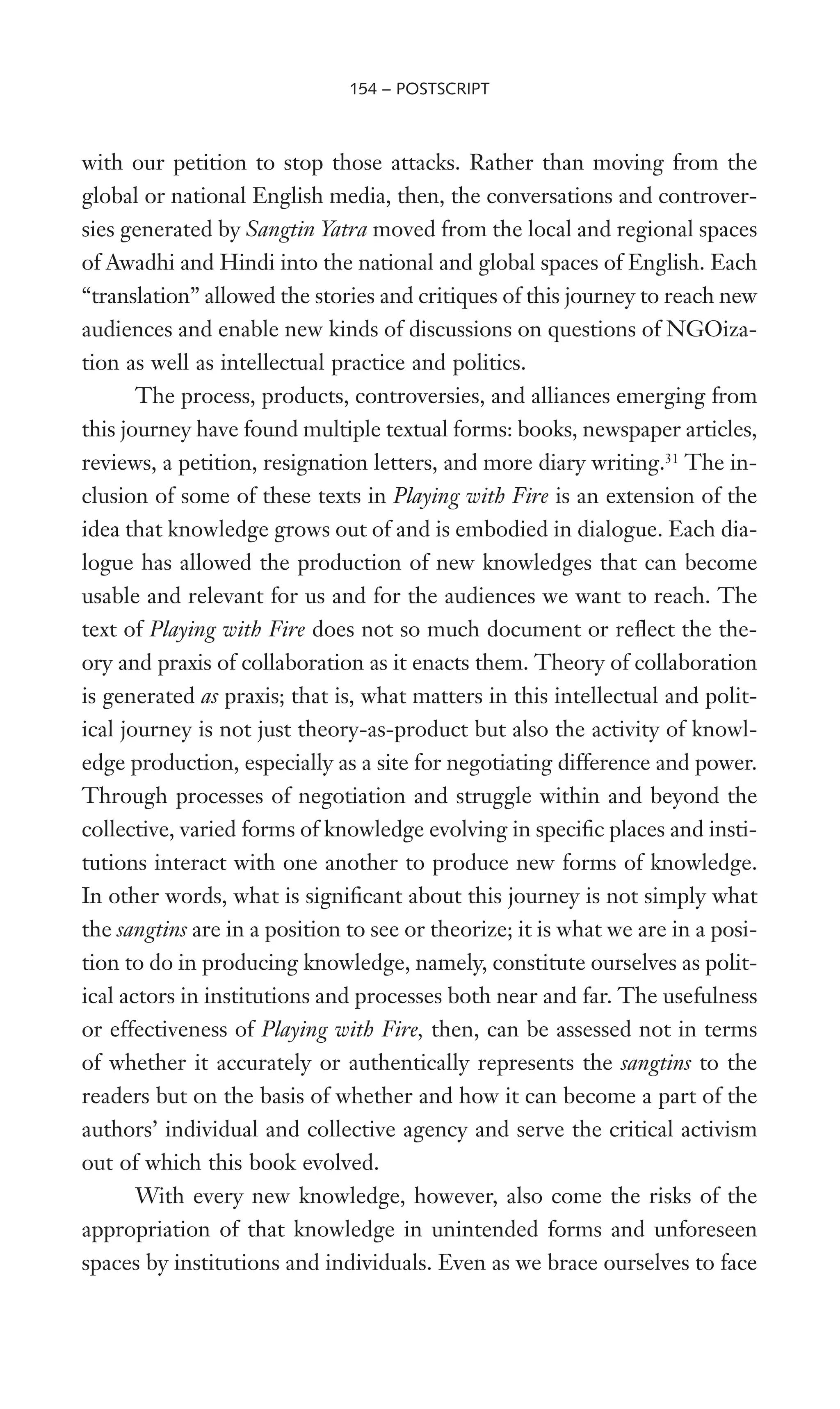
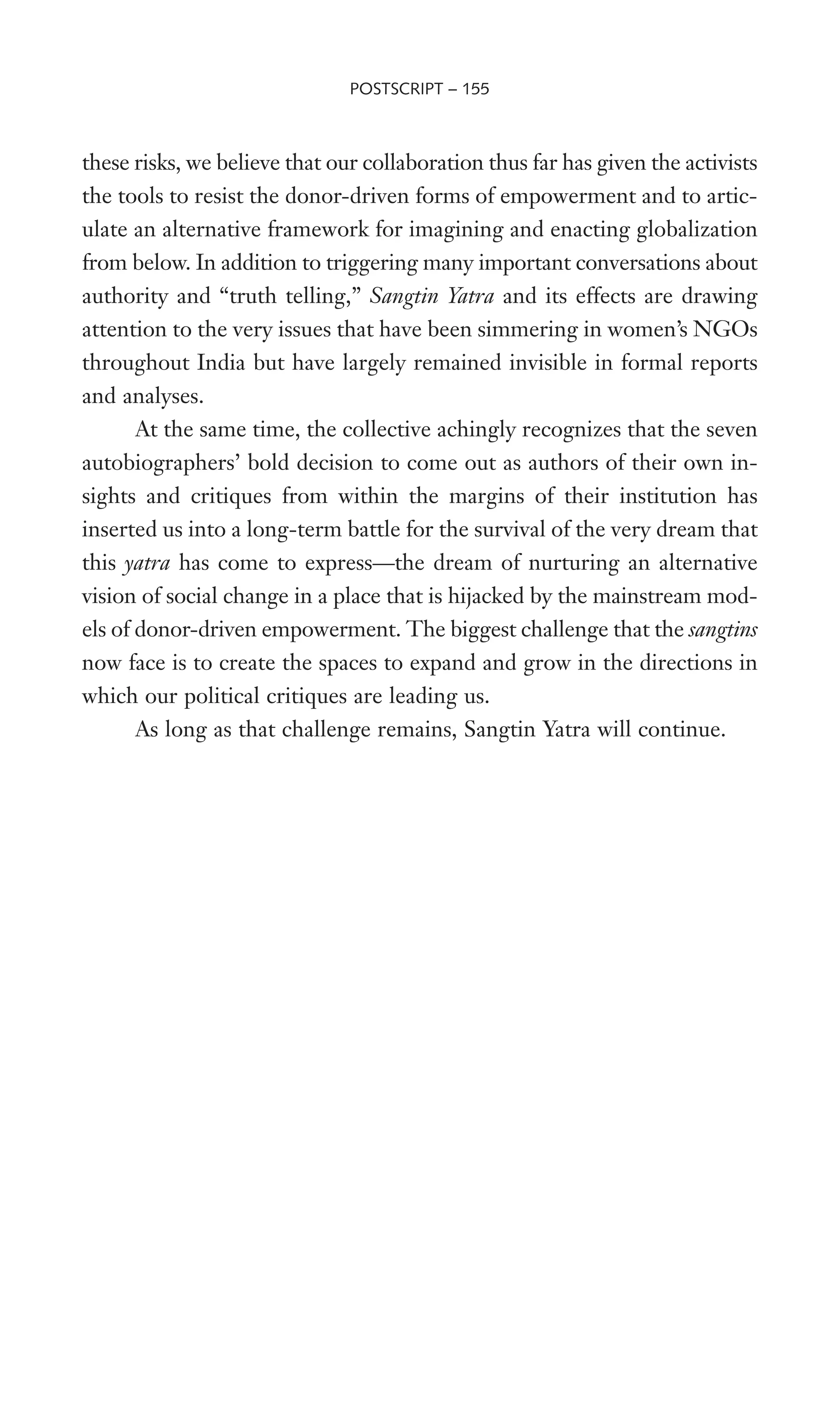

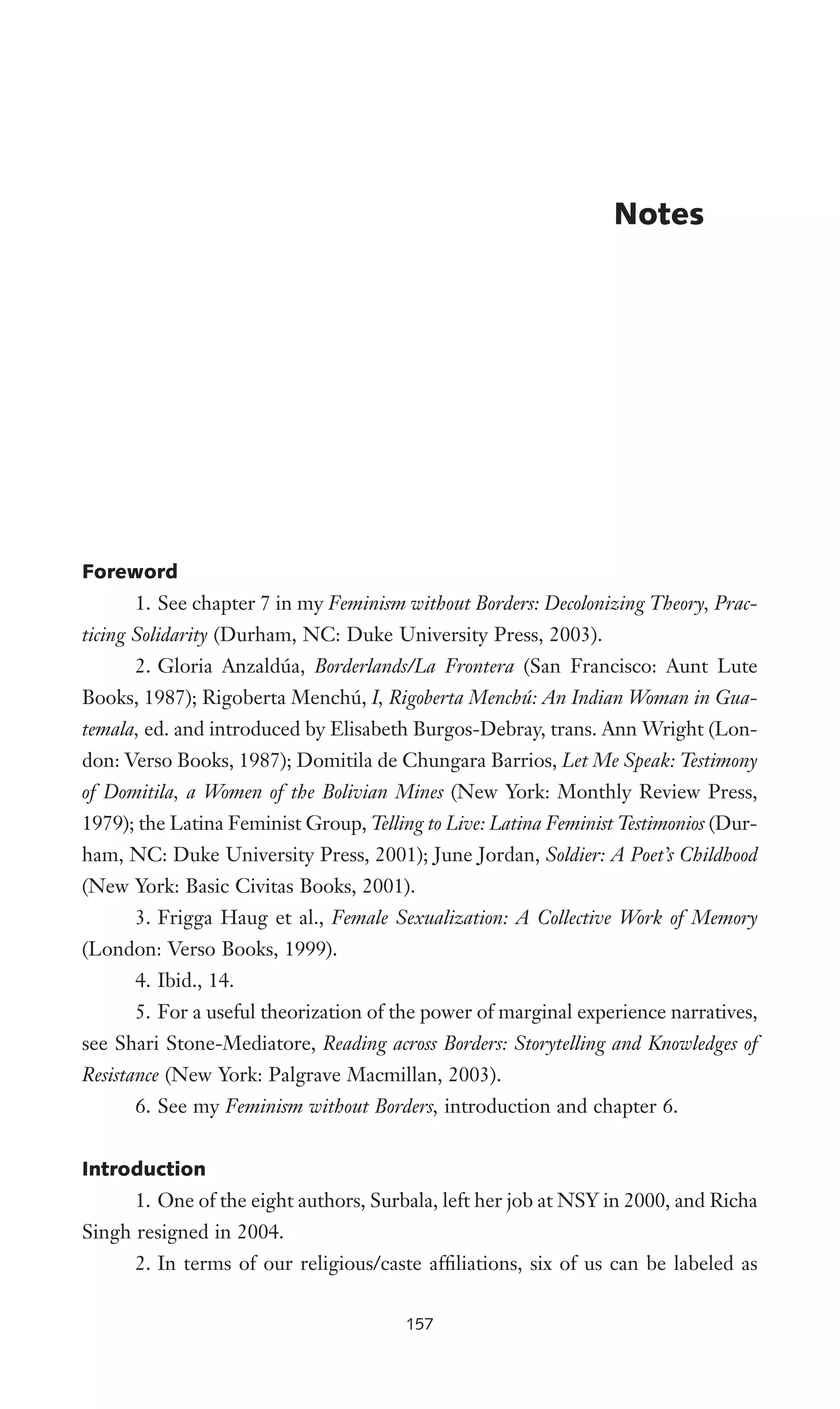

![‘marginals,’ are not people living ‘outside’ society. They have always been ‘inside’—
inside the structure which made them ‘beings for others.’ The solution is not to
‘integrate’ them into the structure of oppression, but to transform that structure
so that they can become ‘beings for themselves’” (55).
7. In the six chapters that form this book’s main text, titled “A Journey of
Sangtins,” we refers mainly (but not always) to the seven autobiographers. Some-
times, when the authors speak as members of Sangtin or as community-based
workers who have grown together in the context of their activist work, Richa
Singh is very much part of the “we.” And sometimes, when the nine authors write
about their process of learning and growing together as a collective, the “we”
includes Richa Singh and Richa Nagar.
8. Gillian Rose, “Situating Knowledge: Positionality, ReXexivities, and
Other Tactics,” Progress in Human Geography 21, no. 3 (1997): 305–20; Richa
Nagar, “Footloose Researchers, Traveling Theories, and the Politics of Transna-
tional Feminist Praxis,” Gender, Place, and Culture 9, no. 2 (2002): 179–86.
9. “NGOization” is now increasingly recognized as a worldwide phenom-
enon, both in academic work and in the public intellectual and community spaces
of Uttar Pradesh, where this project emerged. In all cases, the usage of this term
often involves an implicit or explicit critique that NGOs and their ties with the
state are signiWcantly reshaping, even replacing, community-based activism. See,
for example, Arundhati Roy, “Tide? Or Ivory Snow? Public Power in the Age of
Empire,” speech given in San Francisco, California, on August 16, 2004. Roy calls
this phenomenon “the NGO-ization of politics [that] threatens to turn resistance
into a well-mannered, reasonable, salaried, 9-to-5 job. With a few perks thrown in.”
Downloaded August 18, 2004, from www.democracynow.org/static/Arundhati_
Trans.shtml.
NGOization is by no means conWned to the “Third World.” For example,
Sabine Lang notes in the context of Germany: “German women’s movements
have metamorphosed from overarching movements into small scale profession-
alized organizations. . . . The transition from movement to NGO brought with
it a structural emphasis on professionalized but decentralized small-scale orga-
nizations and a turn from anti-hierarchical to more hierarchical structures. Ide-
ologically, there is a tendency to translate the ‘traditionally’ complex feminist
agenda of emancipation and equality into speciWc single issues and a form of poli-
tics with a predominantly state-oriented focus. While feminist movement building
was once about the establishment of new democratic counterculture, feminist
NOTES TO INTRODUCTION – 159](https://image.slidesharecdn.com/playing-20with-20fire-20book-140402052849-phpapp01/75/Playing-with-fire-book-208-2048.jpg)
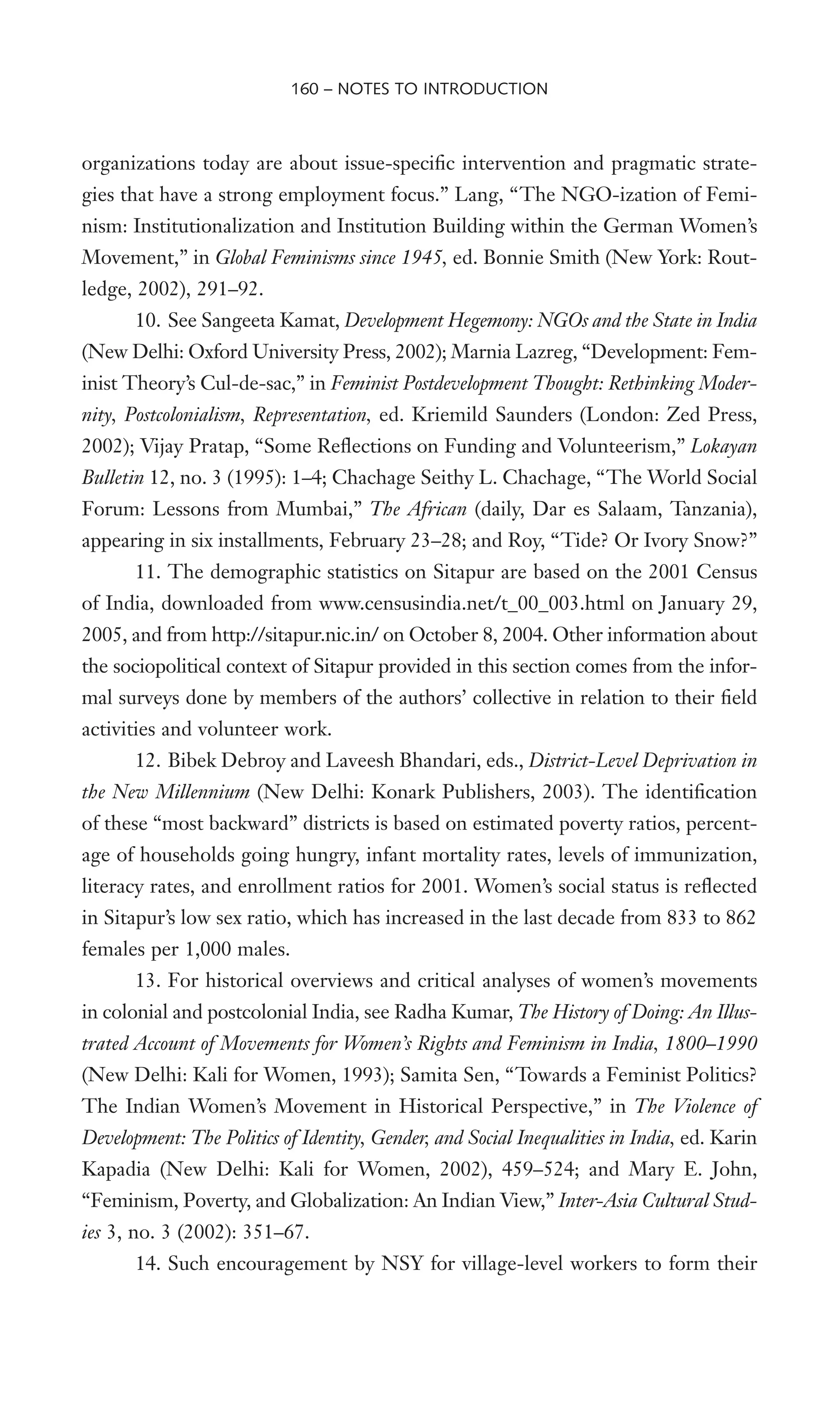
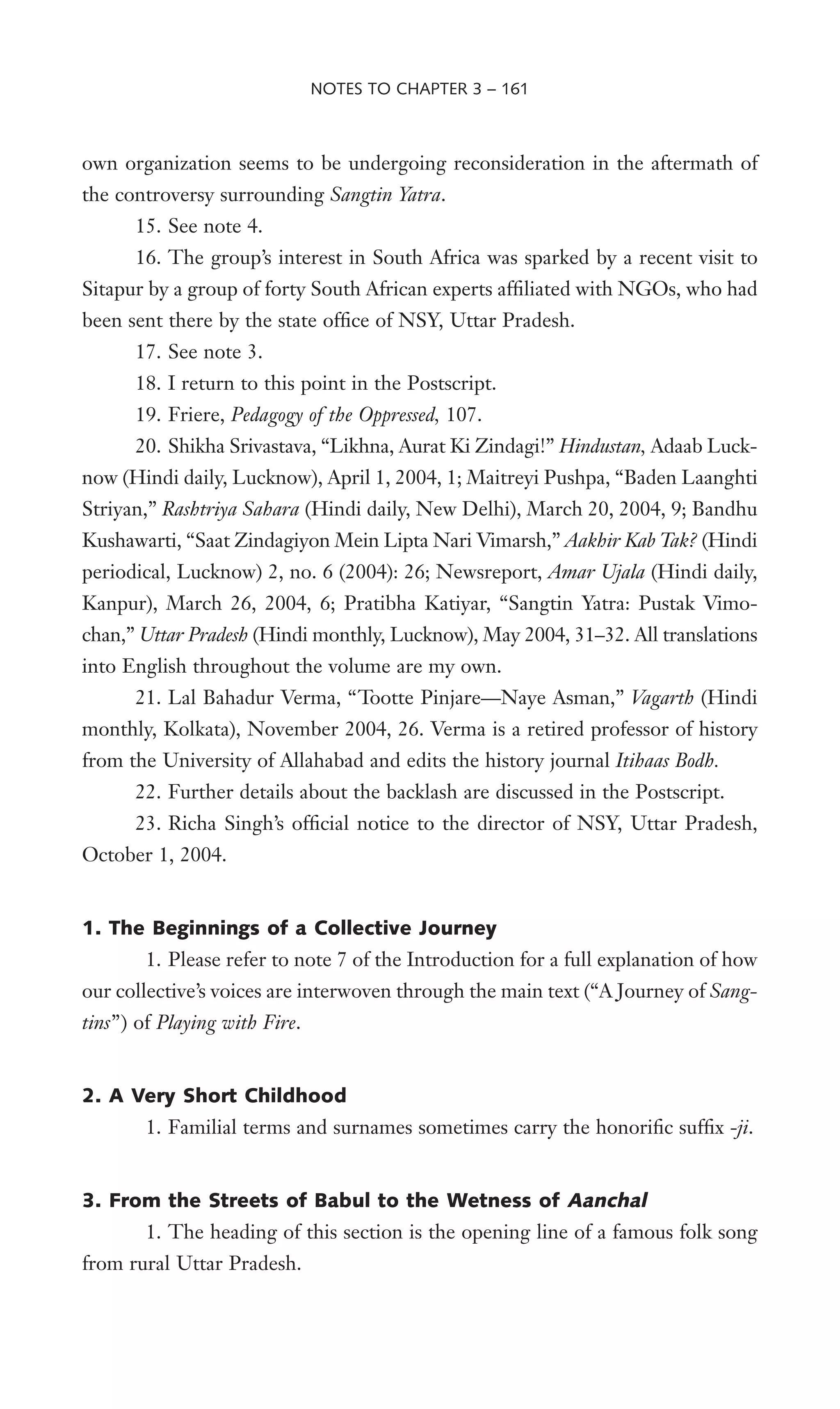
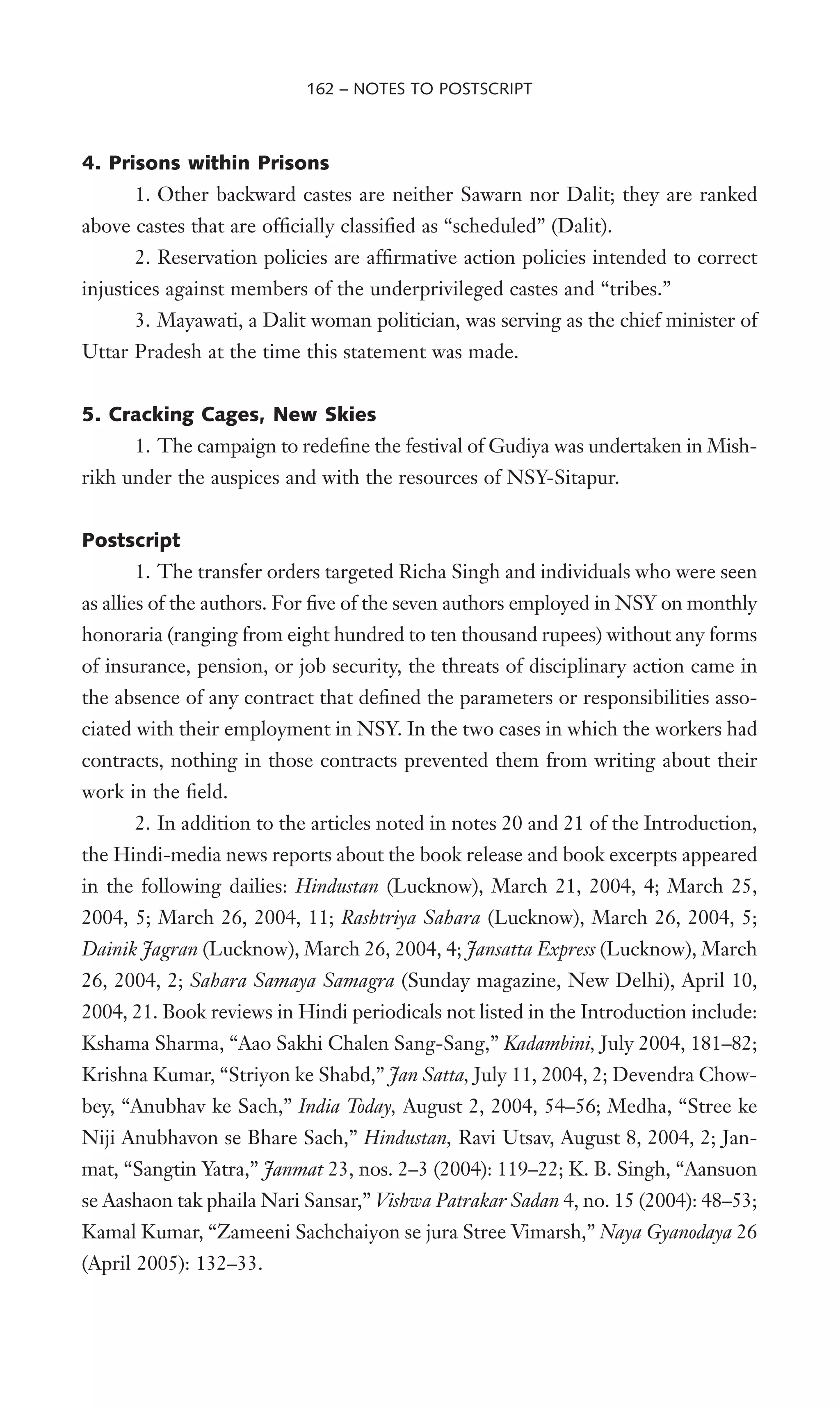
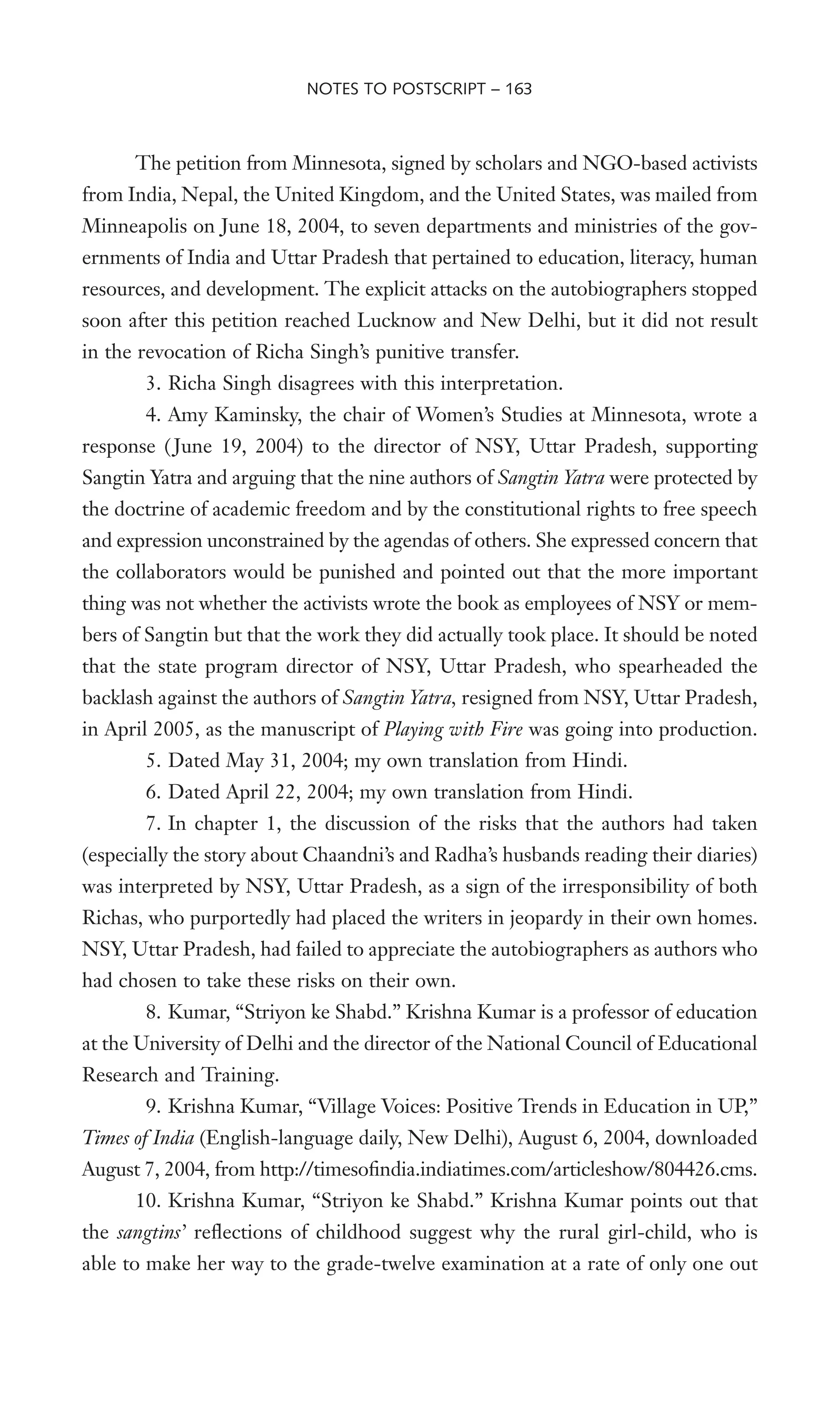
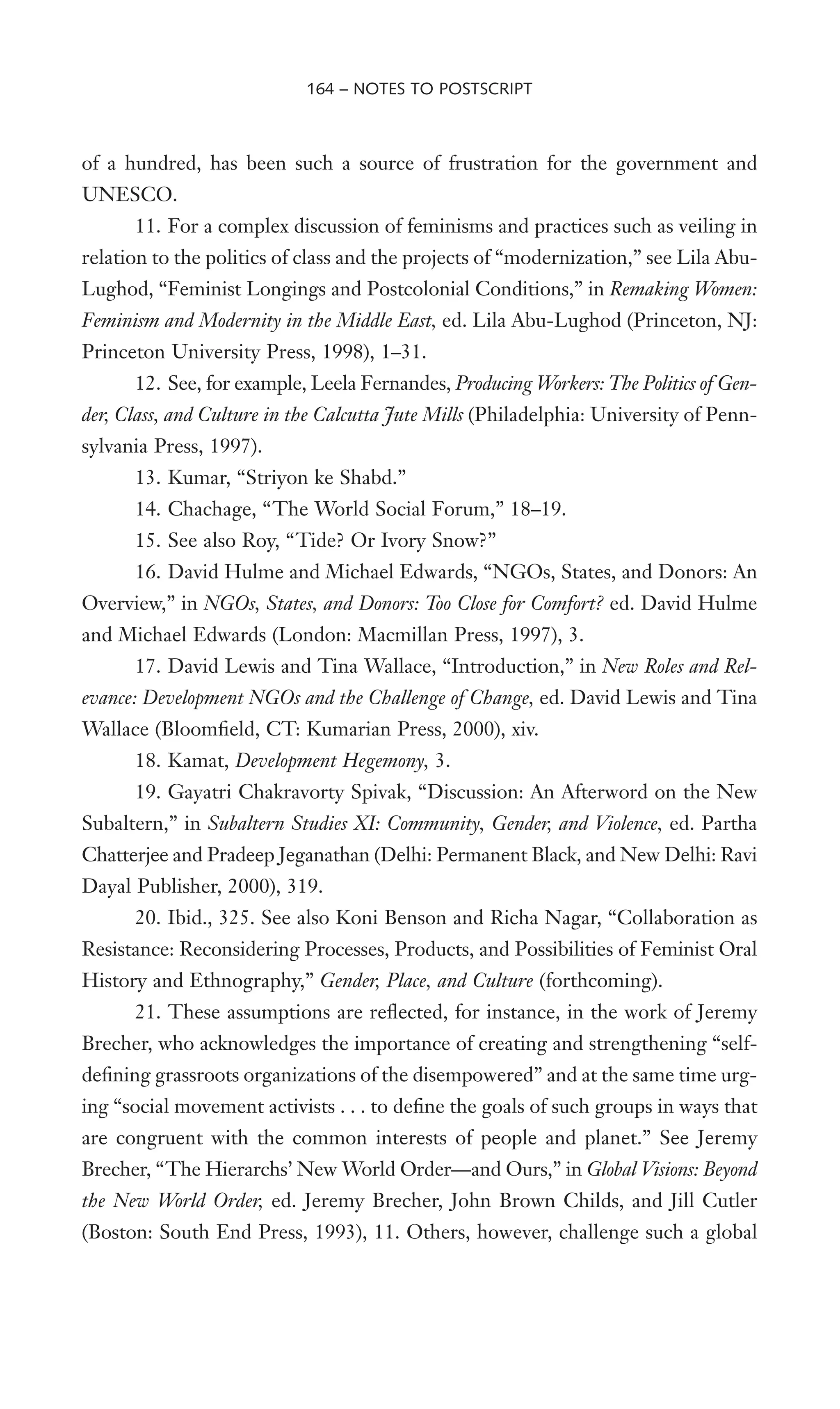
![vision. For example, Notes from Nowhere, We Are Everywhere: The Irresistible Rise
of Global Anticapitalism (London: Verso, 2003), 506, argues against “a new ideology
to impose from above, to ‘replace’ capitalism, but evolving a new, radically par-
ticipatory methodology from below.” This group of authors, “rather than seek-
ing a map to tomorrow,” emphasizes “developing our own journeys, individually
and collectively, as we travel” (506). For a nuanced analysis of the complexities
involved in processes by which local groups “jump scales” in their efforts to con-
test the power of global capital, see Jim Glassman, “From Seattle (and Ubon) to
Bangkok: The Scales of Resistance to Corporate Globalization,” Environment and
Planning D: Society and Space (2001): 513–33. Also see Michael Hardt, “Today’s
Bandung?” New Left Review 14 (March–April 2002): 112–18.
22. Chandra Talpade Mohanty provides an excellent critique of Robin Mor-
gan’s (1984) Sisterhood Is Global in her essay, “Sisterhood, Coalition, and the Pol-
itics of Experience,” in Chandra Talpade Mohanty, Feminism without Borders:
Decolonizing Theory, Practicing Solidarity (Durham, NC: Duke University Press,
2003), 106–23. Also see Amrita Basu’s “Introduction,” in The Challenge of Local
Feminisms: Women’s Movements in Global Perspective, ed. Amrita Basu (Boulder, CO:
Westview Press, 1995), 1–21.
23. See Chandra Talpade Mohanty, “Under Western Eyes Revisited: Sol-
idarity through Anti-capitalist Struggles,” in Feminism without Borders, 221–51.
24. See, for example, M. Jacqui Alexander and Chandra Talpade Mohanty,
eds., Feminist Genealogies, Colonial Legacies, Democratic Futures (New York: Rout-
ledge, 1997); Mohanty, Feminism without Borders; and Torres, Chicana without Apol-
ogy. Gibson-Graham approaches such issues in terms of “post-modern feminist
social research” (see J. K. Gibson-Graham, “Stuffed If I Know! ReXections on
Post-modern Feminist Social Research,” Gender, Place, and Culture 1, no. 2 [1994]:
205–24), whereas Grewal and Kaplan approach them in terms of problematizing
feminist theory (see Inderpal Grewal and Caren Kaplan, “Introduction: Trans-
national Feminist Practices and Questions of Postmodernity,” in Scattered Hege-
monies: Postmodernity and Transnational Feminist Practices, ed. Inderpal Grewal and
Caren Kaplan [Minneapolis: University of Minnesota Press, 1994], 1–33).
25. Rigoberta Menchú, I, Rigoberta Menchú: An Indian Woman in Guate-
mala, ed. and introduced by Elisabeth Burgos-Debray, trans. Ann Wright (Lon-
don: Verso, 1984); Stree Shakti Sanghatana, We Were Making History: Women and
the Telangana Uprising (New Delhi: Kali for Women, 1989); Women’s Research
NOTES TO POSTSCRIPT – 165](https://image.slidesharecdn.com/playing-20with-20fire-20book-140402052849-phpapp01/75/Playing-with-fire-book-214-2048.jpg)
